An International Tour organised in conjunction with our friends at Oriole Birding. We saw a total of 428 bird species, plus another 8 heard only, including some of the rarest waders in the world, as well as exciting mammals like black Leopard and Asian Elephant in two and a half weeks just in north & central Thailand. If you like what you read, we already have dates for next year – 3rd-21st February 2025 – you would be very welcome to join us!
Tuesday 16th January
A very cold clear and frosty morning in the UK was to be very different from what we would experience over the next couple of weeks. We met at the Thai Airways counter in Heathrow Terminal 2 at 8.50am. Our flight to Bangkok was due to leave at 11.50 and departed on time. With a +7 hour time difference and a scheduled 11 hour flight time, we settled in for the rest of the day.
Wednesday 17th January
We arrived in Bangkok Airport at 5.10am, over an hour earlier than scheduled. We were heading straight on to Chiang Mai this morning and our bags were booked through, so we just had to walk over to the domestic transfers area and pass through customs. Our onward flight to Chiang Mai wasn’t scheduled until 10.15am, so we had a longer than anticipated wait at the gate. Always better to be early rather than late! Fortunately, as the sun rose over the runway, there were some birds around the terminal to get our trip list started, with several Common and a pair of Great Mynas, and Red Collared Doves around the buildings, lots of Asian Red-rumped and a couple of Barn Swallows swooping around the roofs and Germain’s Swiftlets and one or two House Swifts hawking overhead. The Tree Sparrows and House Sparrows had actually found a way inside the terminal! As it started to warm up, several Painted Storks began to circle up beyond the airport.
Unfortunately our onward connection was late – we were meant to board at 9.45am but our plane only just taxied up to the terminal as we were meant to get on, so it was over half an hour before we finally departed. We landed at Chiang Mai just after 12pm, where thankfully our bags were already waiting at the international arrivals carousel and we met Nick Upton, our local guide for the first half of the trip, outside. After a quick change of money, we had a short drove to our hotel for the night, where we checked in and had some time to get organised. For those who didn’t take the opportunity to catch up on some sleep, there was some birding to be had around the hotel, with Spotted Doves, Red-whiskered and Streak-eared Bulbuls, Ornate and Purple Sunbirds and Ashy Drongo in the trees behind, and Ashy Woodswallows and Wire-tailed Swallows hawking around the buildings. A Yellow-browed Warbler called several times.
We met Nick again at 3.40pm. As we waited outside, we added Black-collared Starling on the wires with the Mynas and a small group of Black-eared Kites which circled over. Mae Hia Agricultural College was only a few hundred metres away, but a little further by bus as we had to negotiate the dual carriageway, but it was not long before we were stopped and disembarked overlooking the fields. There were birds everywhere – a large flock of Scaly-breasted and White-rumped Munias was feeding in the rice crop with lots of Baya Weavers in the hedge nearby. A Rufous-winged Buzzard flew through causing chaos and stopped on a nearby telegraph pole to devour what it had caught, allowing us some great scope views.
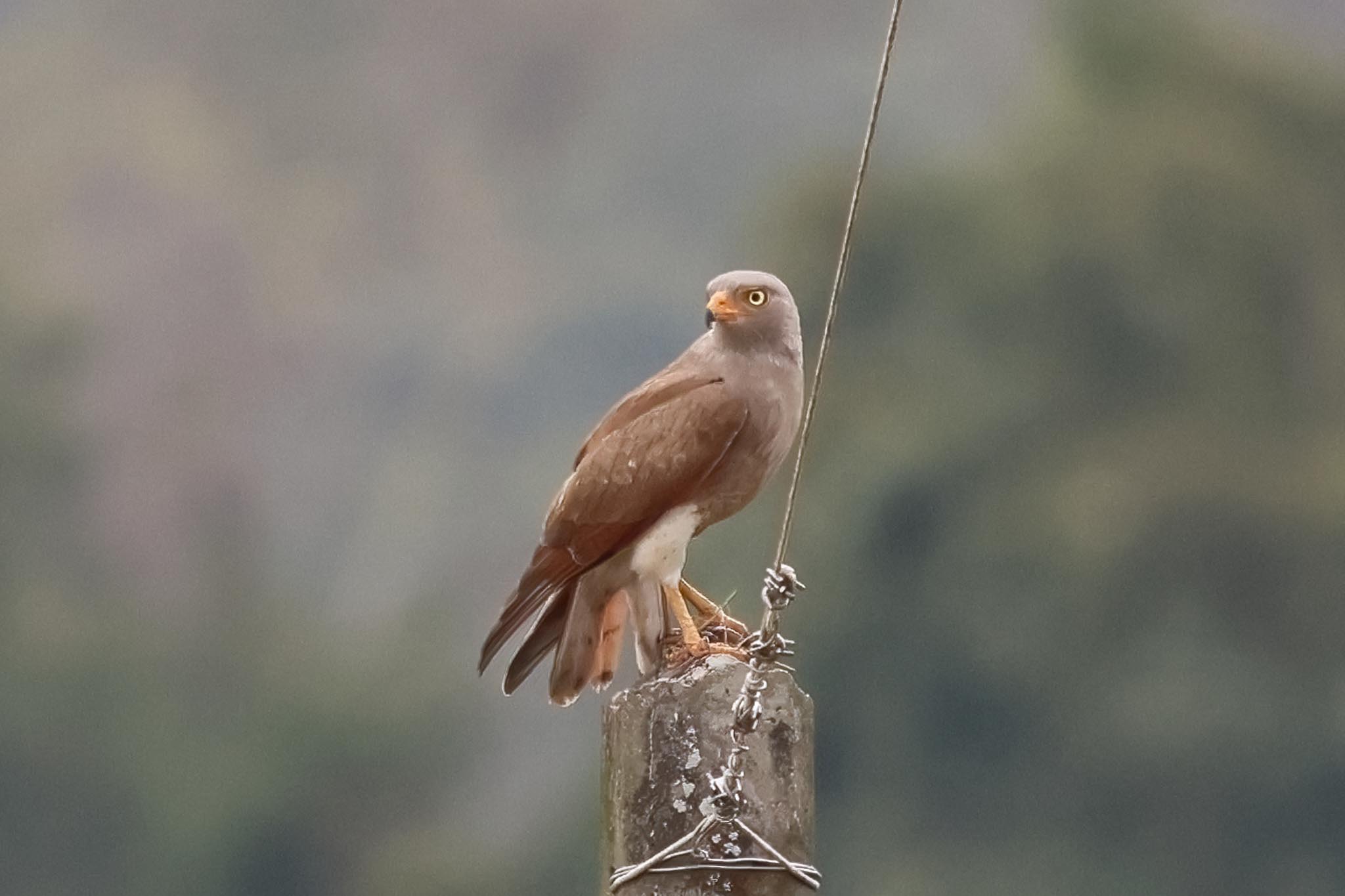
There were Asian Green Bee-eaters zipping in and out from the low wall in front of us and around the radio masts, Hoopoe feeding on the grass beside with a couple of Oriental Magpie Robins, Spotted and Zebra Doves, Brown Shrike and Long-tailed Shrike perched up, several Amur Stonechats, Asian Pied Starlings, and two White-throated Kingfishers around the fields beyond. Three Black-headed Bulbuls perched up in the top of a dead tree behind us. A couple of Alexandrine Parakeets shot past, a rare bird here, then thankfully the same or some more flew back past for those who missed them the first time.
We walked on to a small pool a little further up the road, where a few swallows and swiftlets were coming down to drink. The swiftlets are a difficult group to separate, but they appeared to be mostly Himalayan Swiftlet, with a smaller number of Germain’s. Several Striated Swallows had been hawking over the fields but now landed on the radio mast where we could see the heavy streaking on their underparts in the scopes, and one or two Wire-tailed Swallows were hawking over the pool. A Coppersmith Barbet was perched in the top of a tree the other side of the road, a Shikra flashed through and a couple of Chinese Pond Herons flew up, flashing their white wings.
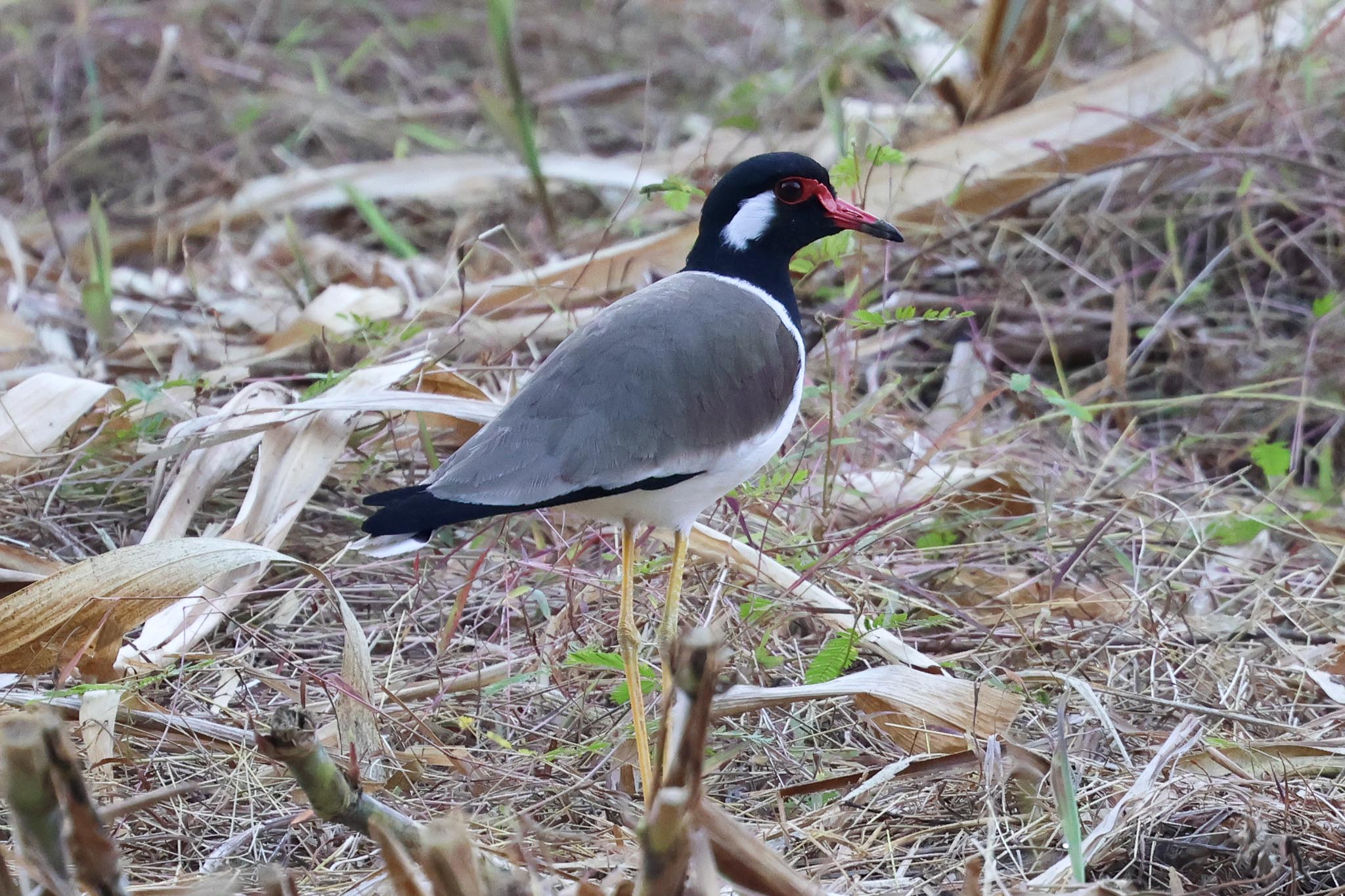
Back in the minibus, we drove on a short distance to an area with more trees. A couple of Red-wattled Lapwings were in the field next to where we pulled up and one showed nicely as we got out. Walking further along the road slowly we added Lineated Barbet and a couple of Black-naped Monarchs in the trees. An Asian Barred Owlet called close to the road and we had nice views of it up in the branches in the scopes. A couple of Green-billed Malkohas flew across the road and landed briefly the other side and a noisy flock of White-crested Laughingthrushes came through the trees. A pair of Racket-tailed Treepies and a Greater Racket-tailed Drongo put in a brief appearance too.
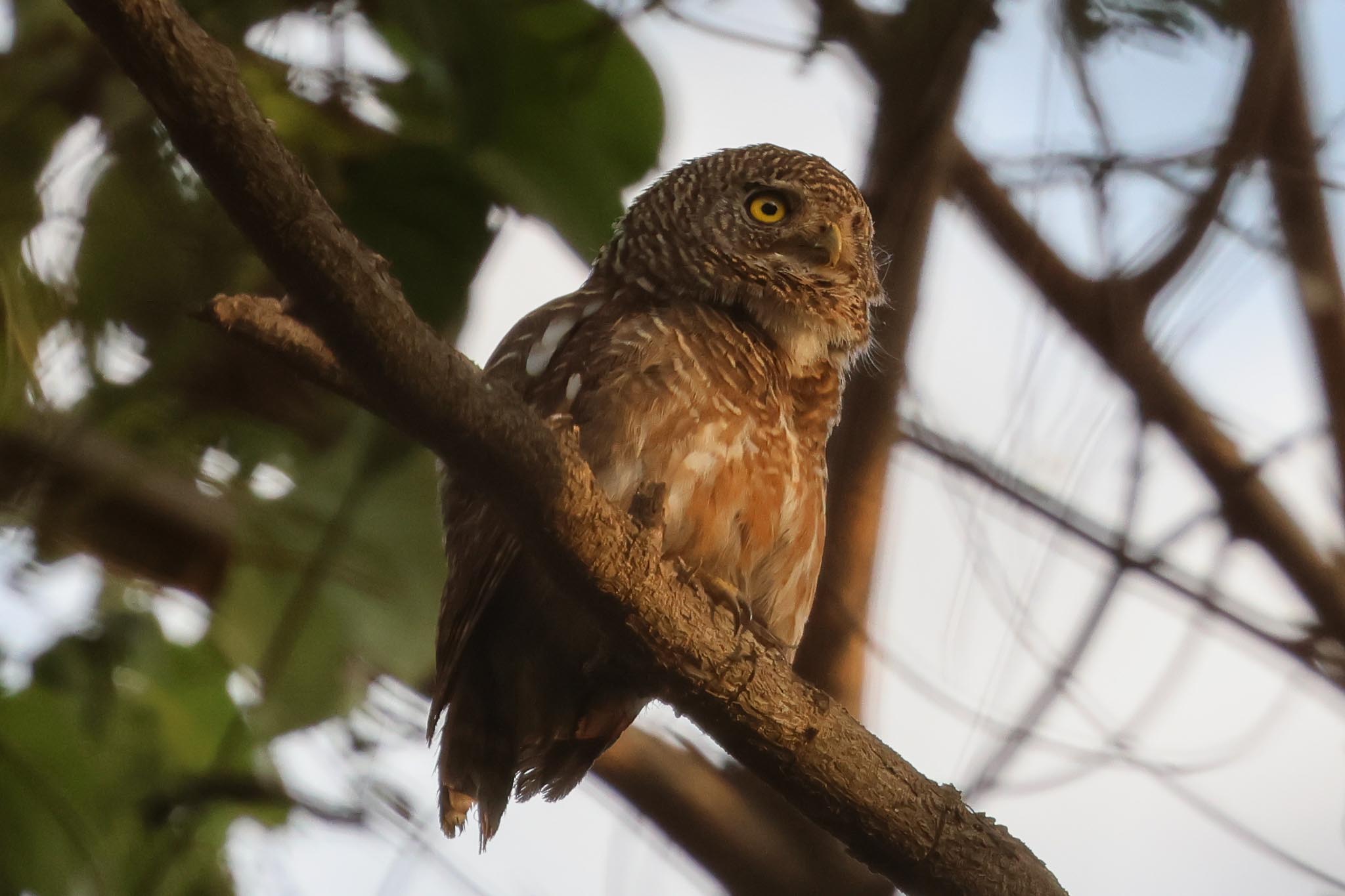
On our way back to the road, we cut in along a track which skirted some more pools, but unfortunately all the grass around the surrounding banks had recently been mown and there were fewer birds here. As we pulled up, several Plain Prinias flicked in and out of a pile of branches nearby and a succession of Black Drongos flew over, presumably heading off to roost. It had been a nice few hours to start our birding here, but the sun was setting now and it was time to head back. Everyone was tired after the long journey, so after a short break to freshen up, we headed out to a local restaurant for a delicious dinner, then back to the hotel for an early night.
Thursday 18th January
The original plan was to head straight up into the hills on the border to the north today, but after recent fighting between the Thai army and Burmese drug smugglers, one of the sites we had intended to visit, Doi Lang East, had apparently been closed. So instead, we were going to make our way south to Mae Ping nature reserve for the first couple of days, which with its dry dipterocarp forest would be a different habitat with some different and more localised species. It is important to make the most of the cooler mornings and evenings, so it was an early start for the 45 minute drive down to our first stop at Doi Lo. As the sun rose on the way, a few flocks of Eastern Cattle Egrets and our first Asian Openbill storks flew over the road.
We pulled off the road onto a track along the edge of the river just above the dam. There were lots of Barn Swallows feeding low out over the water and we had added a Greater Coucal in the bushes and Pied Bushchat in front of the minibus as we pulled up. A couple of Dusky Warblers and a Thick-billed Warbler were calling in the bushes by the track and we could hear several Pallas’s Grasshopper Warblers in the floating vegetation along the edges of the river – the latter proved typically skulking and very hard to see, with mostly flight views obtained. An Oriental Reed Warbler flew across and a Black-browed Reed Warbler started calling on the bank below us.
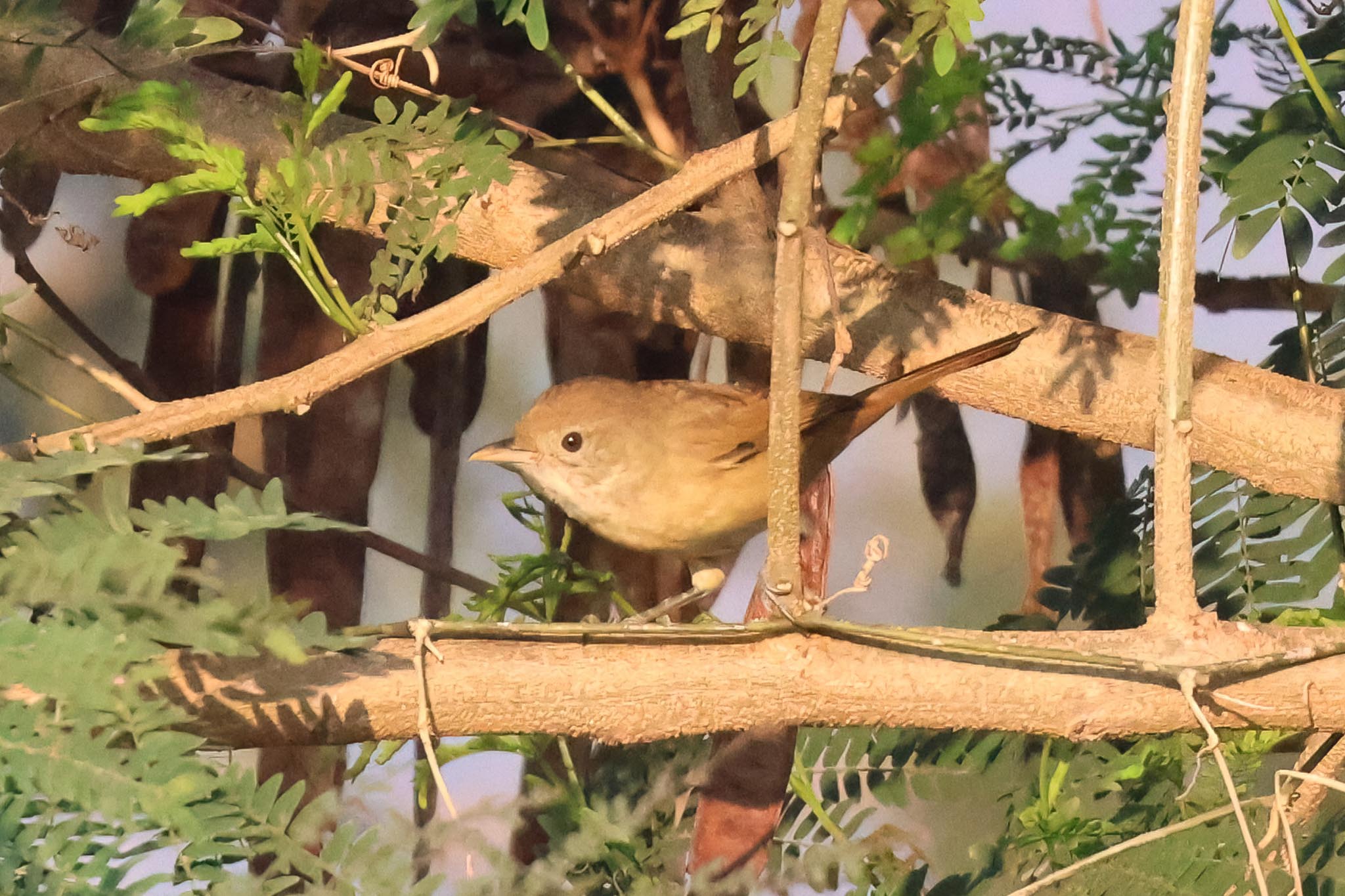
There were more birds down along the edge of the river – a couple of White-throated Kingfishers, a Brown Shrike, a Pheasant-tailed Jacana which flew over and dropped down on far side out of view and a male Plaintive Cuckoo which landed in the damp vegetation on our side of the river where we could get it in the scopes. Turning to check around the margins of the irrigation pool behind us, we found two White-breasted Waterhens on the track, along with a couple more Greater Coucals and a Paddyfield Pipit and a large roost of Grey Herons in a tree further down. The bushes on the corner where we had parked produced Purple and Ornate Sunbirds and the Thick-billed Warbler eventually gave itself up here. Several Black-eared Kites, an Eastern Marsh Harrier and a succession of Asian Openbills flew over.
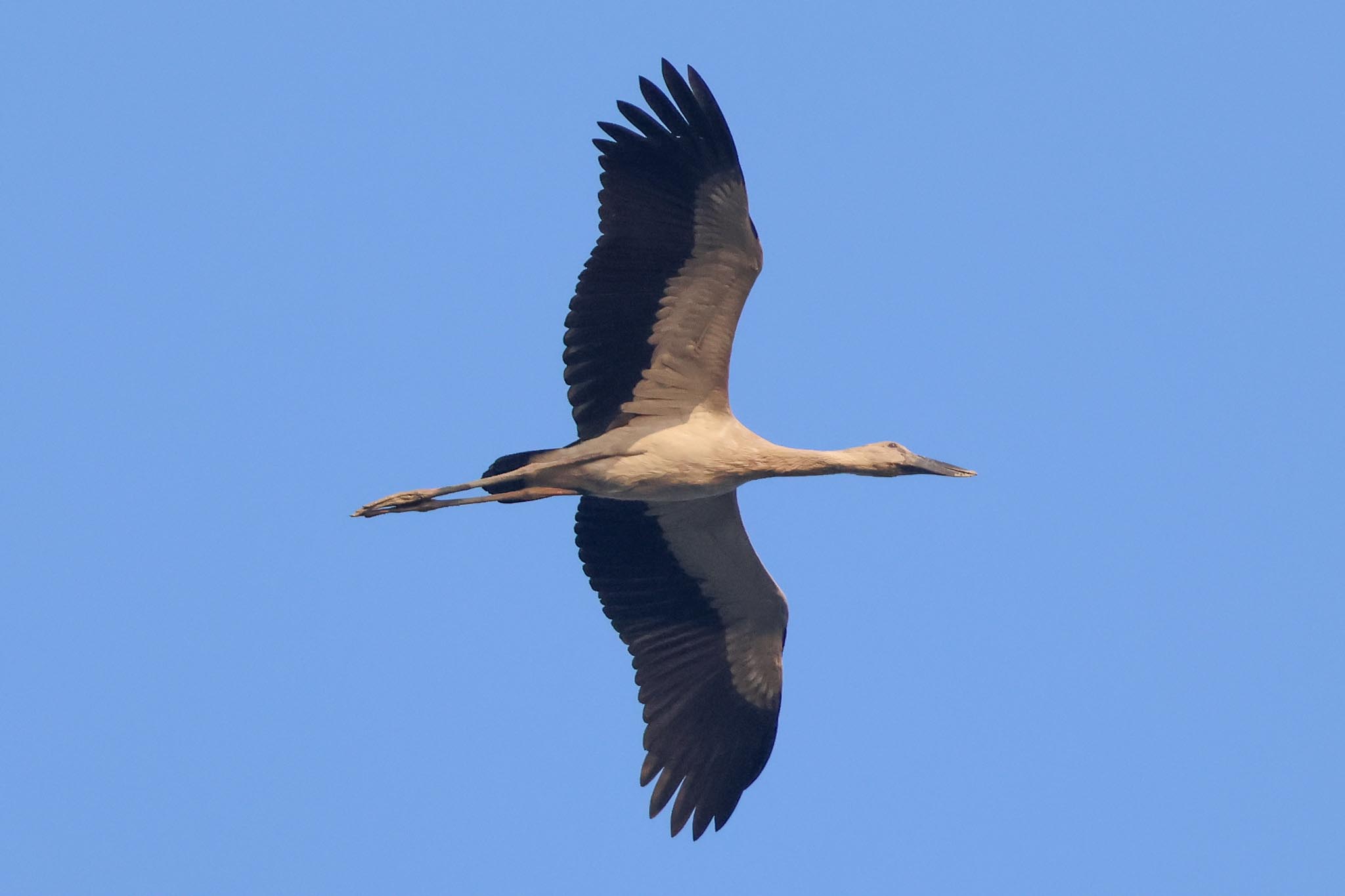
A couple of Little Grebes surfaced out on the water and scanning the far bank of the pool, we located a large roost of Black-winged Stilts together with a few Little Ringed Plovers. We walked a short way up the track. A Common Iora flew out of a tree ahead of us and landed in some bare branches in the distance, perched up in the sunshine where we could get it in the scopes. A Wryneck was sunning itself too, a bit nearer. A pair of Coppersmith Barbets appeared in the tree and we all managed to get eyes on a Dusky Warbler up in the branches above us. A pair of Plain-backed Sparrows flew in and landed in the top of some bushes back behind us.
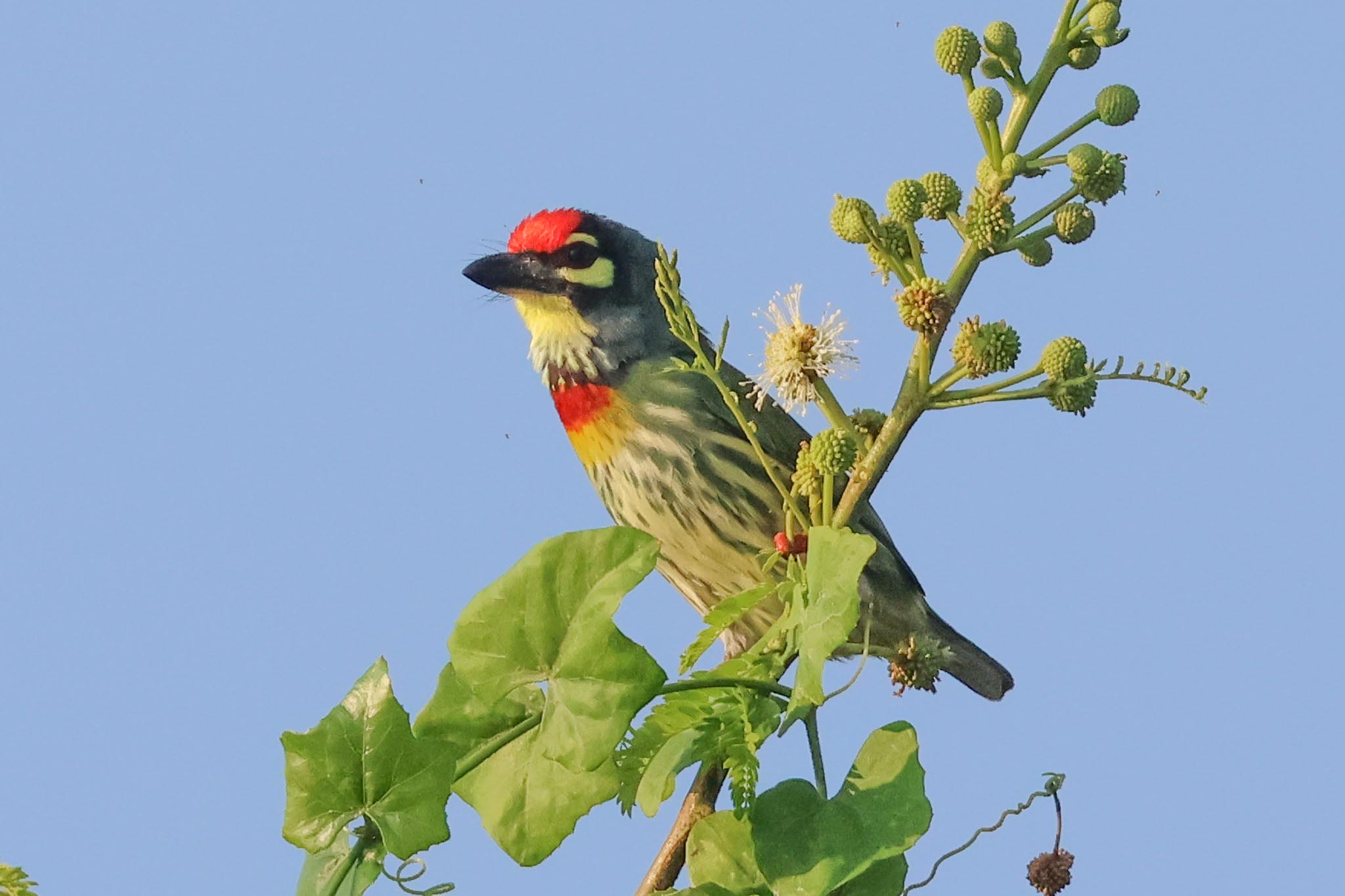
Several Small Pratincoles were hawking now low over the water and watching them it became clear that there were lots of them on the bank back in the far corner, over by the river. We were looking into the sun from here, so we walked back to the corner and on past the café and round to the other side for a better look. We had lovely views of them from here, sunning themselves on the bare earth and not particularly concerned by our presence. Several Intermediate Egrets flew over.
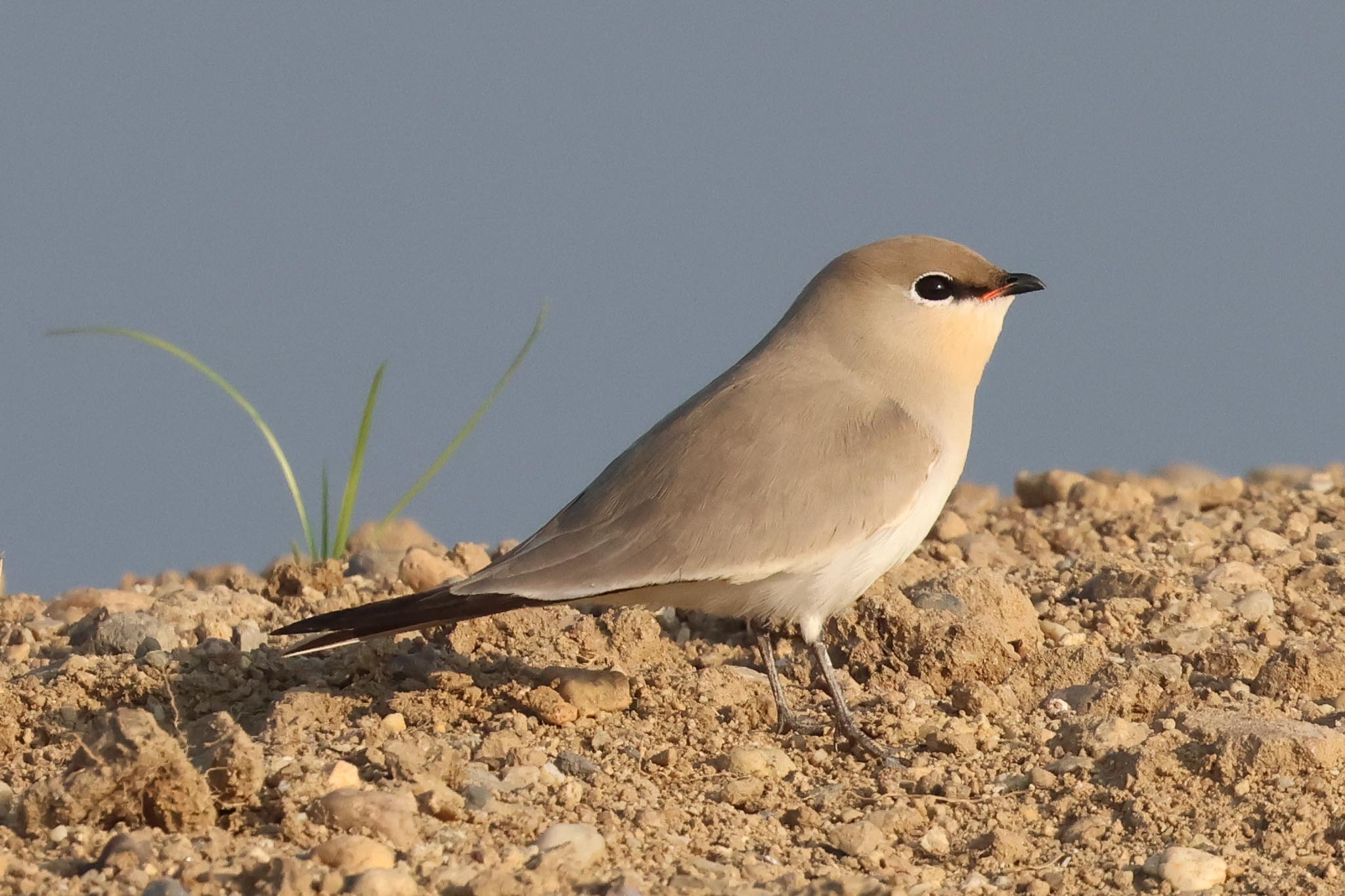
Back to the minibus, we turned along the track we had walked down earlier and continued on further. Lots of Zebra Doves flew up off the bank ahead of us and when Nick heard Chestnut-capped Babblers calling, we stopped and got out to check them out. Unfortunately, they proved strangely elusive, and the most we had were some brief flight views with them mostly remaining hidden in the vegetation, where we could still here them calling. While we were looking for them, we did flush a Pintail Snipe and a couple of Common Snipe out of a wet grassy field. A Long-tailed Shrike was perched in the taller vegetation behind and a Zitting Cisticola came up out of the wet ditch along one side.
An Indochinese Bushlark started singing from the ricefields beyond the ditch. As we scanned across, we noticed a couple of Wrynecks in a bare tree and while we were looking at them, the Bushlark flew up and landed too. There seemed to be lots of birds in the ricefields so we walked round for a closer look. Several more Pintail Snipe flew up from the grass, giving us some brief nice flight views where we could see the lack of a clean white trailing edge to the wing as they landed quickly again.
We found lots of Little Egrets in the flooded paddies, along with Greenshank and Long-toed Stint and several Eastern Yellow Wagtails and White Wagtails of the leucopsis subspecies. A Richards Pipit landed on a narrow bund between the paddies. Back to the minibus, we drove on round and out of the ricefields. As we got back to the tarmac, we had a quick stop to look at a Booted Eagle circling over the fields beyond, as several Wood Sandpipers flew up calling. A Brown Shrike was perched on the wires.
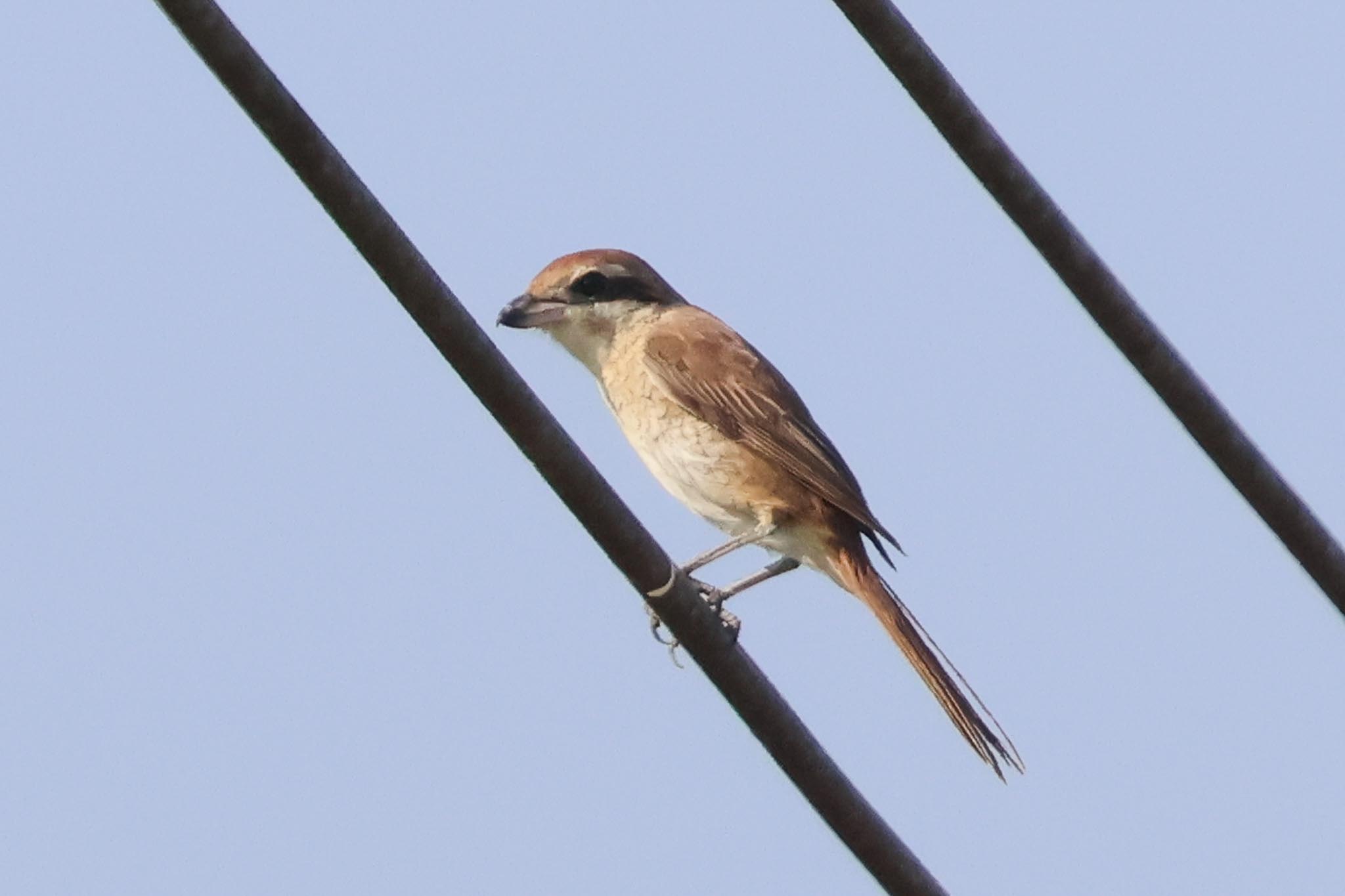
We called in briefly next at a nearby site to see if we could find Savanna Nightjar. They normally roost in a gully in some overgrown farmland, but despite searching all around we couldn’t find any sign of them today. It was hot now, and it was good for butterflies but there were not many other birds here, so we decided to move on. Our first Oriental Honey Buzzard flew over as we walked back to the minibus.
There had been some Spot-winged Starlings feeding in some flowering trees on the edge of a nearby town in recent days, so we called in to see if we could find them now. An Eastern Buzzard circled up as we parked and got out. There was no sign of any starlings in the first flowering tree we came to but walking on down the road, we found a much larger one and this tree was full of Chestnut-tailed Starlings. Looking through them carefully, sure enough we found several Spot-winged Starlings in with them and had some nice views of them in the scopes, a scarce winter visitor here in variable numbers, there have been a few about in recent days. On the way back to the minibus, a couple of Asian Palm Swifts scythed through the trees.
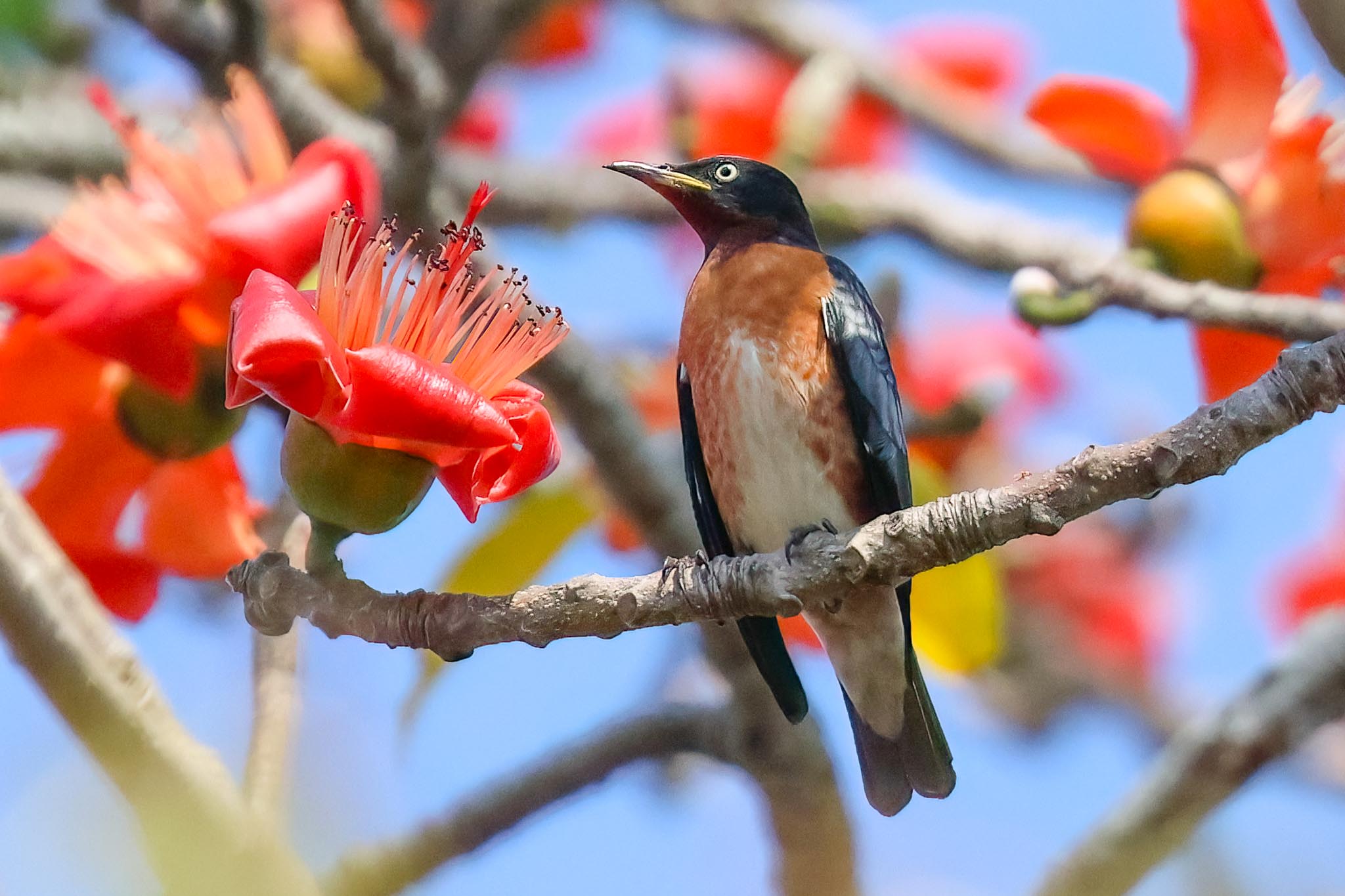
It was a longer drive now down to the village of Li, where we would spend the night. It was time for lunch when we arrived there so we stopped first on the main street at a restaurant for lunch – freshly cooked rice or noodles with chicken or prawns and vegetables. After lunch, as we checked into our motel nearby, there were lots of Chestnut-tailed Starlings and mynas in a fruiting tree by the entrance but nothing rarer with them this time. After a short break to get settled in, it was already time to head out again for our first visit to Mae Ping National Park.
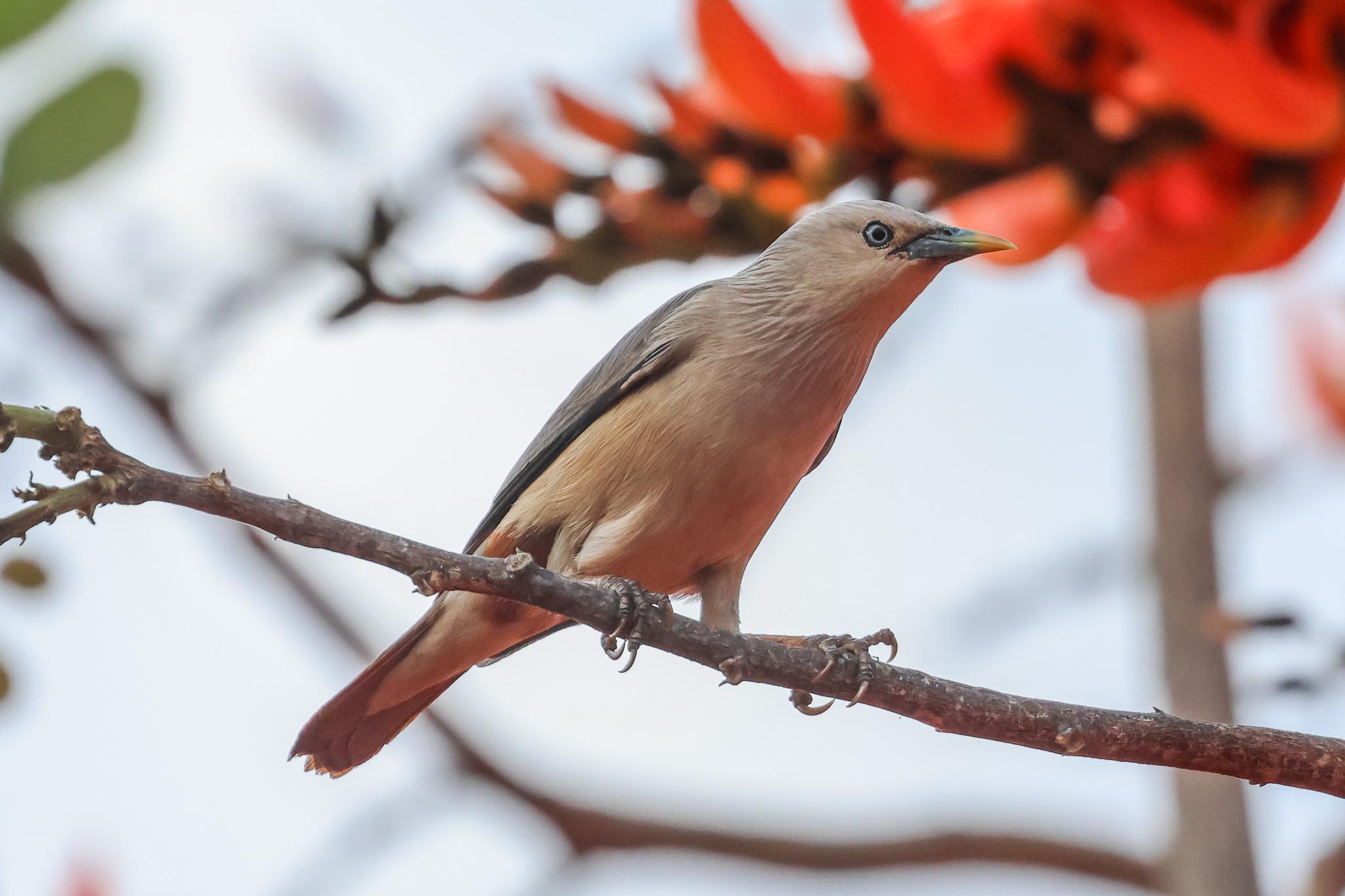
As we got to the National Park gate and Nick got out to get permits, a flock of Crested Treeswifts flew high over the trees and as we drove on deeper into the forest, a Greater Flameback flew up from the side of the road. We pulled up in a small parking area just beyond and walked slowly up the tarmac. It was mid-afternoon and quiet in the trees at first – a Large Cuckooshrike flew in and landed in the trees behind us, and we heard several Grey-headed Parakeets but they were always just too deep in the forest to be able to see them.
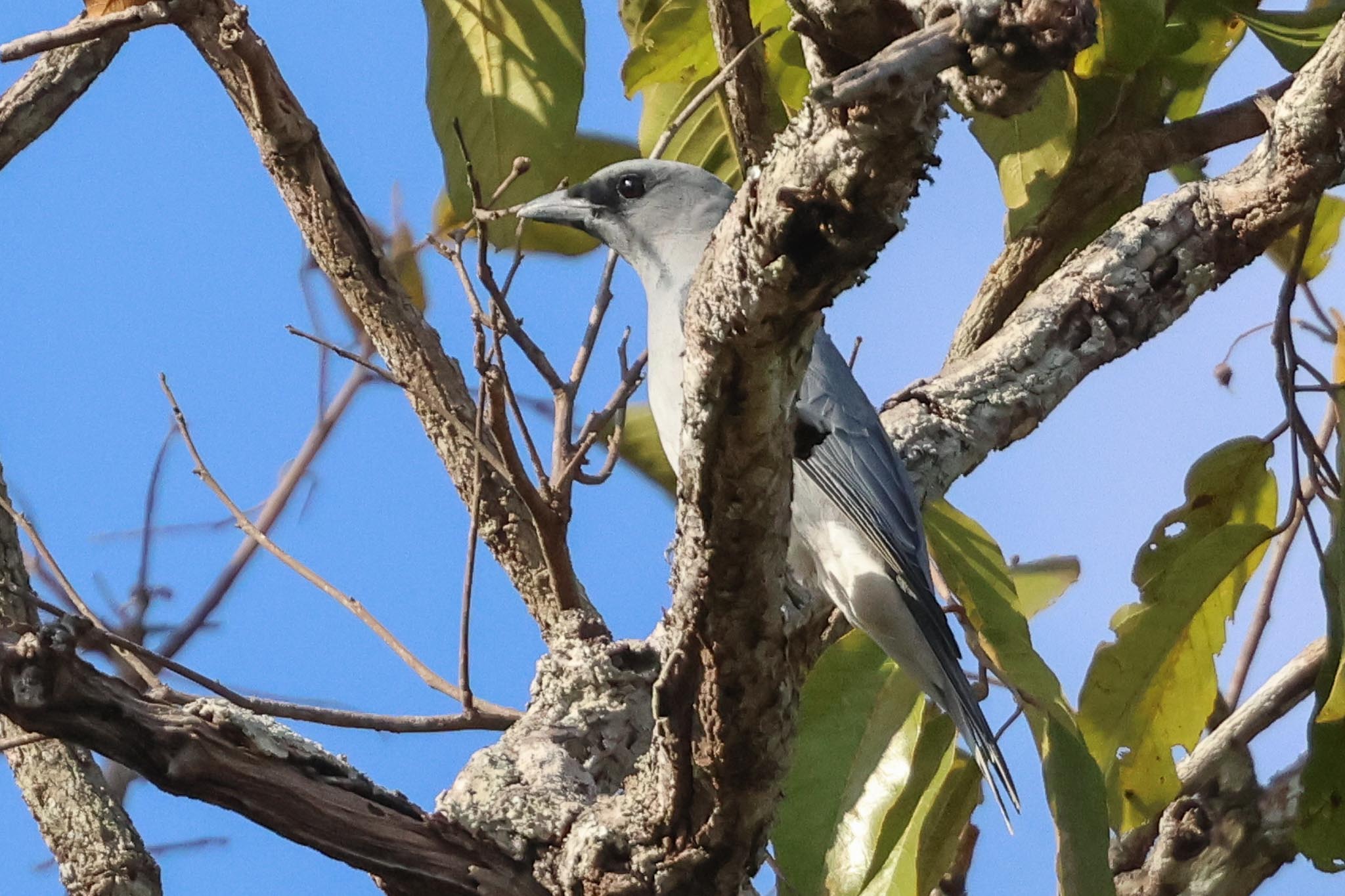
We were looking for woodpeckers and after nothing at first, frustratingly three flew over above the trees in quick succession without stopping. Then Nick heard Black-headed Woodpeckers and eventually a noisy group flew in and landed in tree by the road, one of the species we were hoping to find here. A couple of Rufous Treepies appeared briefly in the trees too. As we walked on, a colourful Variable Squirrel clambered through the branches, a couple of Black-hooded Orioles fluted and we heard a White-bellied Woodpecker calling ahead of us but it had gone quiet by the time we got up there. As we walked back to the minibus, a brief Common Hill Myna landed in the trees.
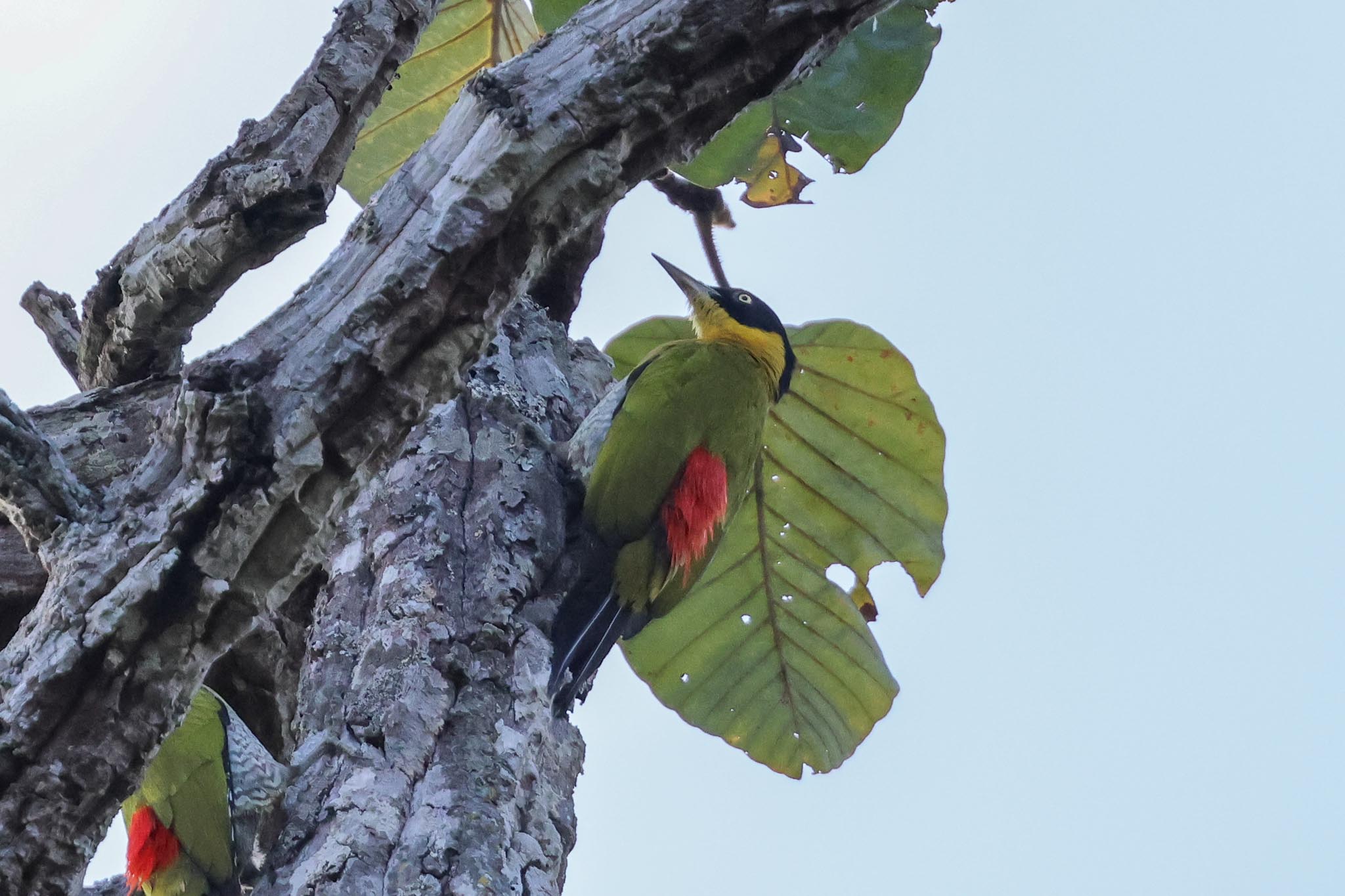
We drove on to the campsite and as we pulled in we could see lots of Red-wattled Lapwings out on the grass, and a couple of Chinese Pond Herons which looked slightly out of place with no ponds in sight. Our main targets here were Burmese Shrike and Collared Falconet – we quickly located a Burmese Shrike, and despite its best efforts at trying to hide in one of the trees in the campsite, we eventually found an angle from where we could see it and all had good views. There were a few Ashy and Black Drongos in tree tops beyond, and then a Collared Falconet appeared further back. Only brief views, but at least everyone got to see it before it flew.
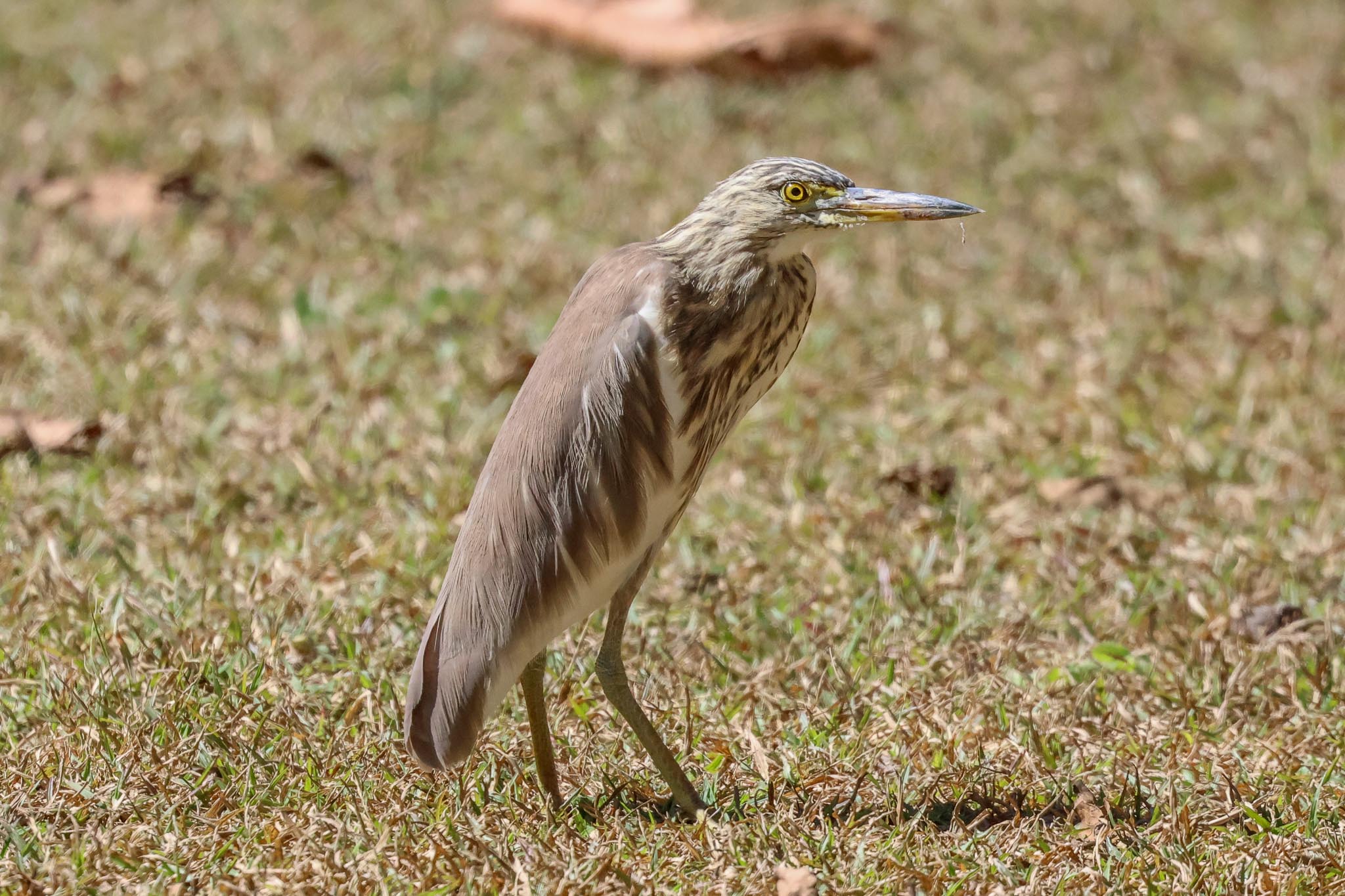
We walked over to the far side of the grass but there was no further sign of it – just a group of Sooty-headed Bulbuls moving through the trees, and a couple of Eld’s Deer, a doe and fawn, which walked off into the undergrowth. Working our way round the back edge of the campsite, someone called over to Nick to point out another Collared Falconet which now flew in and landed much closer, much better views as it stayed put and surveyed the ground below from its high perch. The light starting was starting to fade as we walked back round to where we had parked, and a couple of Taiga Flycatchers were now calling in the trees beyond.

We drove back slowly through the park. A male Red Junglefowl appeared briefly on the side of the road, but disappeared in before we pulled up, and what was most likely a Large-tailed Nightjar was glimpsed above the trees ahead. Back at the hotel, we had a break to freshen up, and then walked back out to the road and the short distance along to the street restaurant where we had been for lunch earlier. Nick ordered a selection of local dishes for us all to try and got the owner to switch the music from the western songs she had put on for us to some Thai pop music instead, much to the amusement of the staff. After dinner, we went through the day’s bird list at the restaurant quickly, before heading back to the hotel. It had been a long and exciting first day, and everyone was ready for an early night.
Friday 19th January
Another early start, we met again at 6.20am, although it took a while for Nick to find someone to check us all out in the neighbouring Viennoiserie (a rather incongruous business to find here!) and collect the croissants they had prepared for us. We were heading back in to Mae Ping, and on our way a Black-winged Kite was hunting over one of the fields beside the road. Into the park, we took the same turn towards the campsite but this time drove beyond where we had walked yesterday and stopped where the sun was already catching the tops of the trees.
There were more birds than yesterday, with a mixed flock high in the trees above the parking area, including a couple of Black-naped Monarchs and a Burmese Nuthatch, which gave brief views before the flock moved deeper in. We heard a White-bellied Woodpecker calling now, and after slowly coming closer it flew across the road just behind us. It was a nice flight view catching the sunshine, but it carried on deeper in and now we could hear it calling again further back than it had been. It would continue to taunt us on and off!
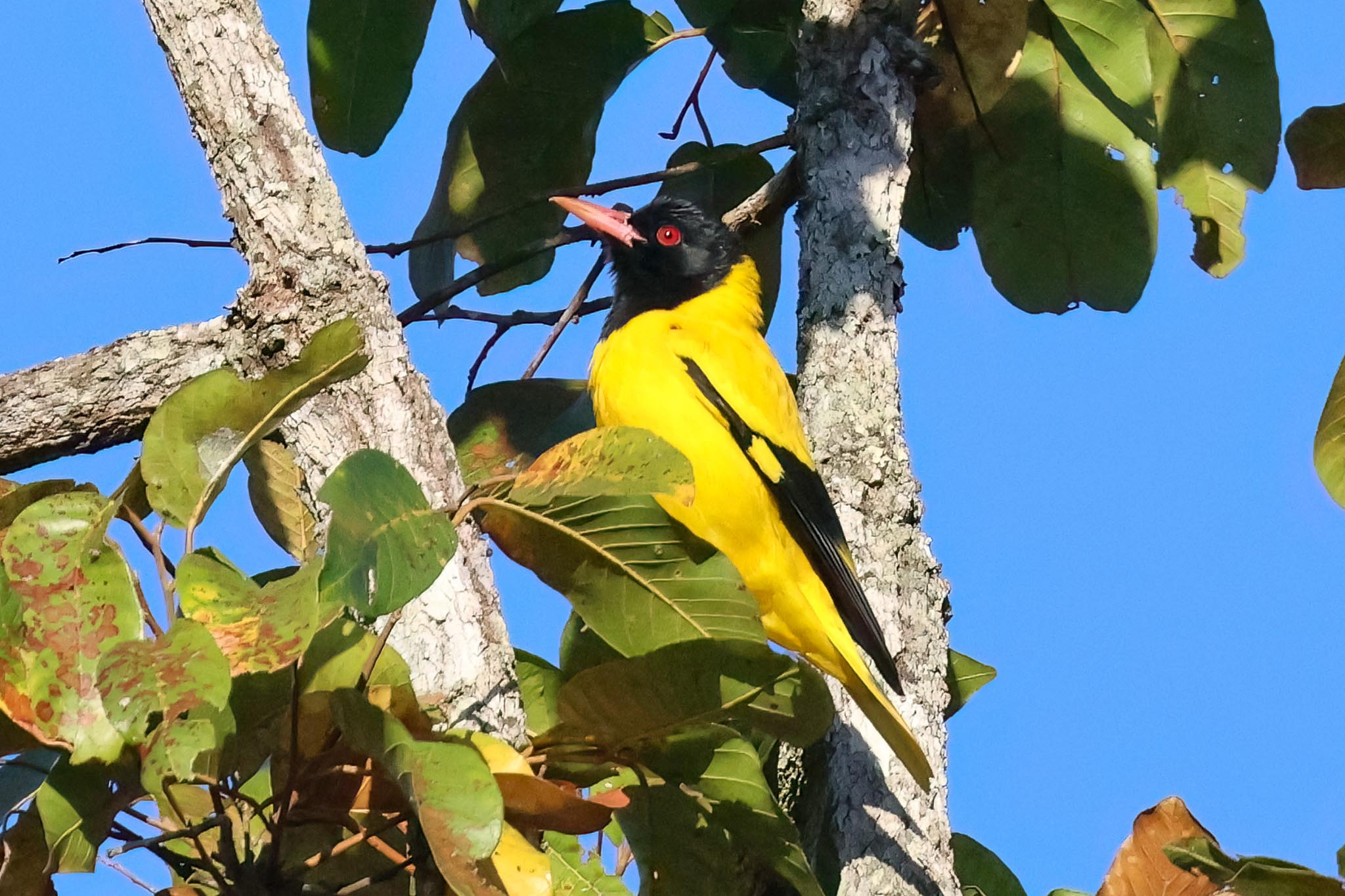
We walked up the road a short distance – there were lots of Black-hooded Orioles in the trees, and we had some lovely views in sunshine, along with a couple of Velvet-fronted Nuthatches. Then it was back to the minibus for breakfast – along with the croissants, Nick had picked up rice crackers and a selection of fruit from the 7-11 for us. There were Yellow-footed Pigeons calling deep in the trees now, but they were frustratingly just too far in to see, and we could hear Grey-headed Parakeets calling from further up the road too, so we walked over to try to see them.
At first we just found lots of Lineated Barbets, then we got the scopes on a couple of Grey-headed Parakeets and had nice views of them distantly in the trees. Further up, it seemed to be a bit quieter, although there were several Rufescent Prinias in the undergrowth and a Wild Boar ran across the road behind us, so we turned back to the minibus. A juvenile Ultramarine Flycatcher was calling in the trees now, and we could just see it flicking around in the canopy. Like buses, there were Grey-headed Parakeets everywhere now, perched up in the sun by the minibus, and flying round calling. A pair of Greater Yellownapes flew in. They were hard to see at first, and very mobile through the trees, before eventually one landed in view and we got it in the scope, and now it seemed like it was nailed to the branch, not moving at all.
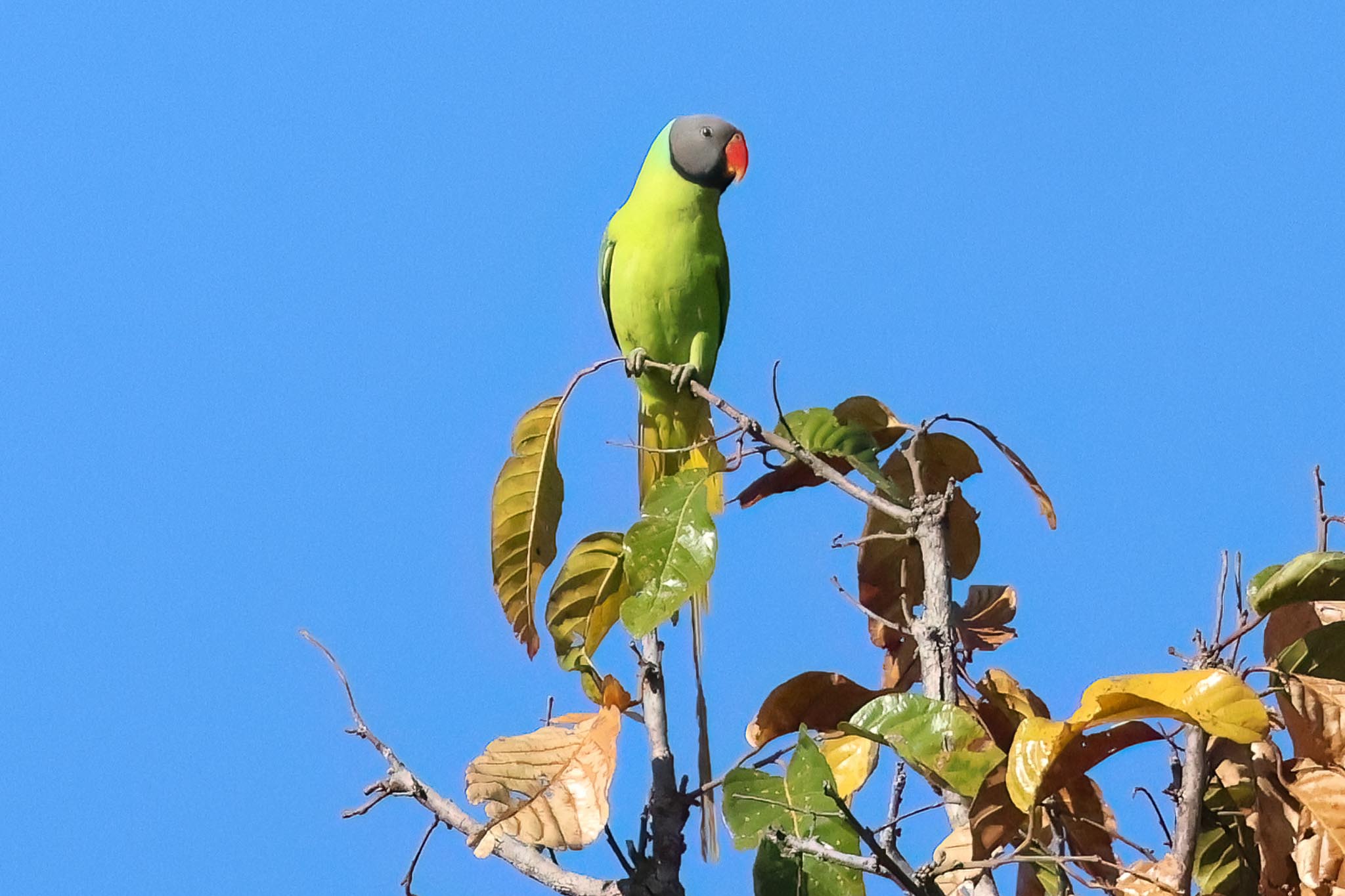
The White-bellied Woodpecker was calling again, further down the road now, so we walked a short way to see if we could locate it. We found a pair of Greater Flamebacks in the trees, but again they were very mobile, and the White-bellied Woodpecker had gone quiet. We found the mixed flock we had seen when we first arrived again – the Monarchs were flitting around low in the trees, and better views of the pair of Burmese Nuthatches now, plus Grey-capped Woodpecker and a Yellow-browed Warbler. We followed the flock back to the minibus, where we found a Verditer Flycatcher.
We drove on to the campsite now. A Taiga Flycatcher was calling again by the parking area, and we found it perched low in the undergrowth beneath the trees where we could see its blacker uppertail coverts. As we walked round the edge of the forest towards the access road, it was rather quiet apart from a couple more Taiga Flycatchers calling, until we got to the entrance road and found a couple of Red-billed Blue Magpies hopping around on the ground behind one of the buildings and a Great Cuckooshrike in the trees. We decided to move on and after a quick stop to use the facilities in the campsite, we drove down to Li for an early lunch. We were a bit too early, and they had to open the restaurant up for us!
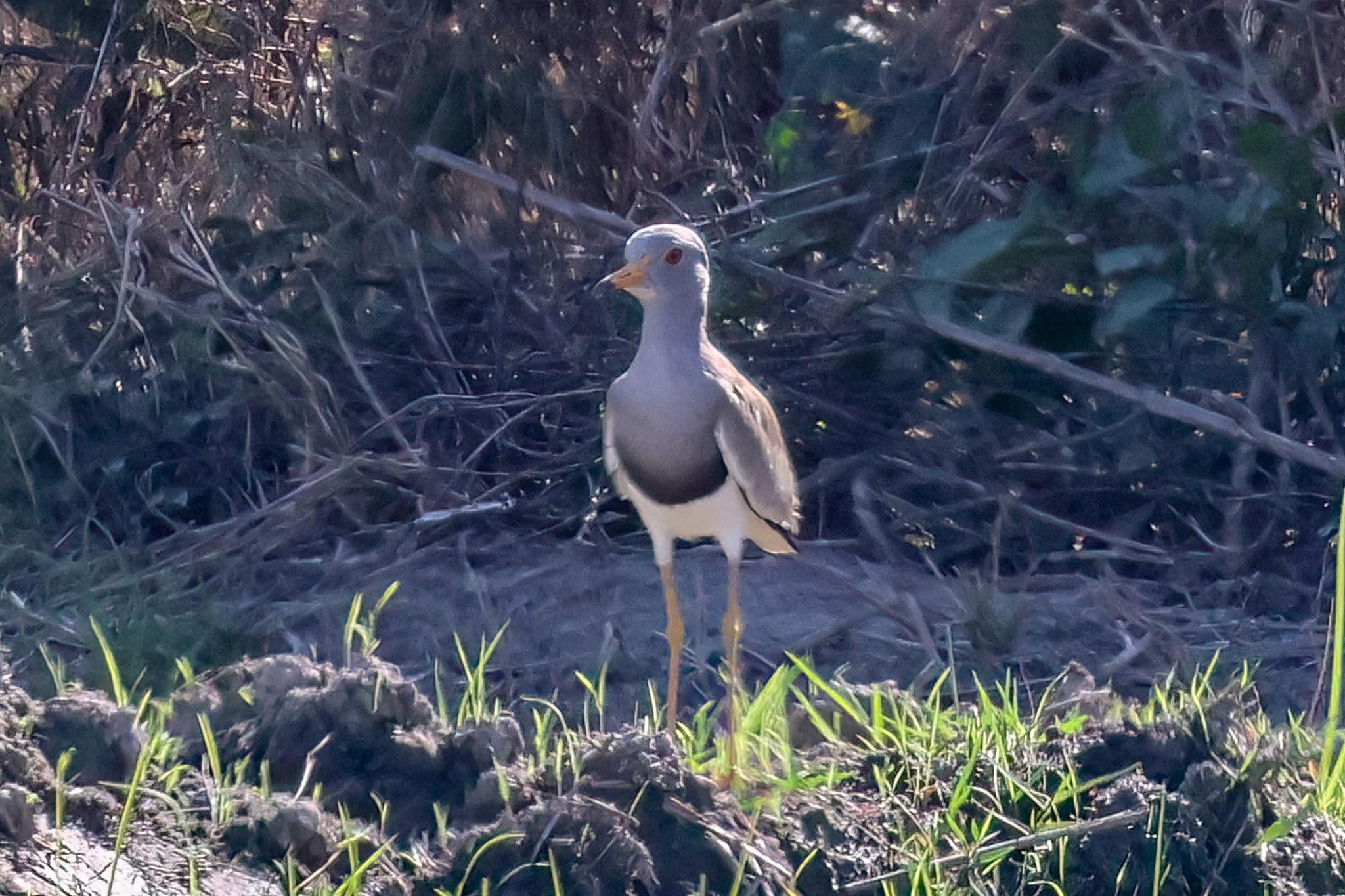
We were heading back to Chiang Mai this evening, but on our way we stopped off to explore some ricefields this afternoon. In one of the paddies by the road we could see a large flock of waders and as we pulled up we confirmed they were Grey-headed Lapwings, about 45-50 of them. We managed to pull off onto the verge and they initially seemed settled as we got out, but then they spooked and flew up, dropping down behind some bushes into the field beyond. There were a few still left, so we got those in the scopes and there were lots of Wood Sandpipers still in the young rice too. A shrill call alerted us to a Citrine Wagtail which landed in the rice, a female, grey with a yellow face, and we had good views of several White Wagtails as well.
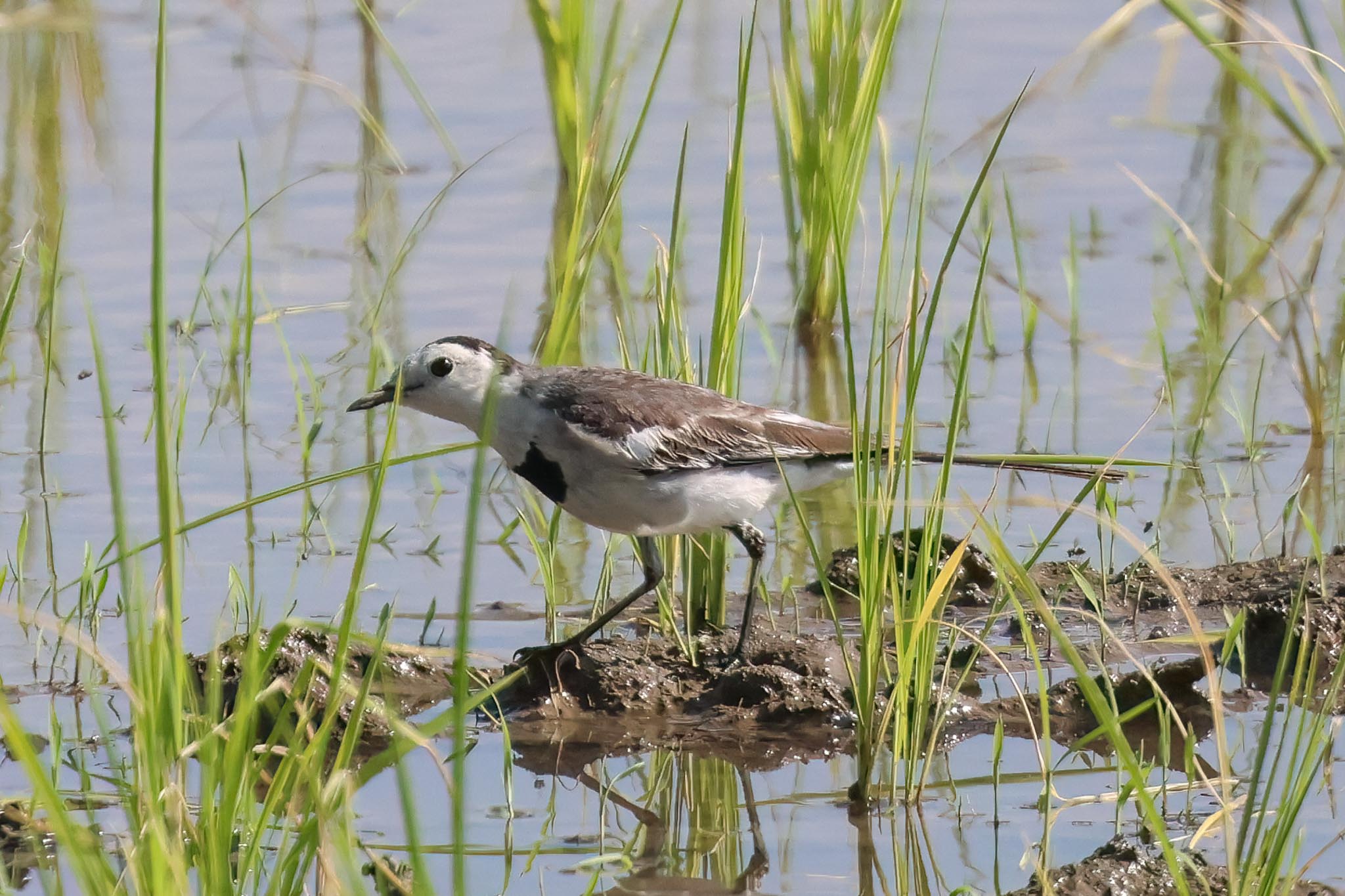
There were a couple of routes into the ricefields, but the track which Google maps decided to take us down turned out to be very rough – at one point, a couple of us had to walk ahead and remove branches and lumps of rock so the minibus didn’t get stuck! Some of the wet fields here were being worked, turned over with small tractors, and bangers were being let off to scare off the vast flocks of thousands of Feral Pigeons which kept descending. There were high mist nets erected along the edge of one recently sown paddy too.
When we got out onto one of the bigger (and better!) tracks, we noticed a large flock of Pacific Golden Plovers out in the rice, so we parked in the shade of some trees and got out to scan. There were lots of egrets in the next field back, mainly Intermediate, with a couple of Great White and a few Cattle Egrets too. Looking over at the field being worked back beyond the junction it was full of mainly Cattle Egrets walking in the mud behind the cultivators, as well as a large flock of farmyard ducks and a single ‘Chinese Goose’. Lots of Asian Openbills were flying over and circling in front of the hills beyond, along with clouds of Feral Pigeons.

We worked our way through the waders – as well as the Pacific Golden Plovers, there were lots of Wood Sandpipers and Common Snipe. One or two Temminck’s Stints flew up and circled round, but disappeared when they landed, and later a flock of at least a dozen came up from out of view in the rice. A single Common Sandpiper appeared on one of the bunds.
A smart Long-tailed Shrike perched up in the sun at the back of the nearest paddy and there were lots of Amur Stonechats perched on various bushes. Starlings and Mynas flew back and forth, including a large flock of Chestnut-tailed Starlings which landed in a nearby tree, an Indochinese Roller flew over too and a couple of White-breasted Waterhens walked across the track back by the minibus. There was an amazing amount of life here in what is an actively farmed landscape, very different from the barren fields back home.
We were hoping for raptors here and slowly they started to appear now. A distant Booted Eagle, a Shikra, a Kestrel on some wires. An eagle drifted in high overhead before dropping quickly down into the paddies behind the trees, causing some discussion as to its size and identity, particularly as there had been a Steppe Eagle in the area – looking more closely at the photos later confirmed our initial suspicions that it was a subadult Greater Spotted Eagle. There were harriers too, first a female Eastern Marsh Harrier, then our first Pied Harrier, distant and a juvenile (we were hoping for a male!), followed by two more Eastern Marsh Harriers, a young male and then adult male, very different from the Western Marsh Harrier we get at home. The Pied Harrier reappeared over the rice field further back in front of us, but flew up and over the trees at the back and disappeared.

It was time to head back to Chiang Mai, where we stayed in the same hotel as we had on our first night and went out to dinner at the same restaurant. One of the group had tried the speciality northern Thai pork belly curry (Gaeng Hung Lay) on the first night, and after his glowing review several of us took the opportunity this time. Highly recommended!
Saturday 20th January
Another early start, we checked out and left Chiang Mai at 6am as we were heading north today. It was on the way, so we stopped first at the Mae Taeng Irrigation Project – there had been three Long-billed Plovers here recently and it can be a good place for other birds too. We parked and walked over to the dam, from where we could scan the open gravelly areas below. A Green Sandpiper circled round calling, and several Common Sandpipers and Common Snipe were around the pool just below the dam. A Common Kingfisher flew off upriver as we arrived, and a small flock of Small Pratincoles whirled round and landed on the muddy bank above the dam.
A Thai photographer was lurking on the bottom of the bank the other side of the gravel and we could only find a few Little Ringed Plovers there at first but we didn’t have to wait too long before the three Long-billed Plovers flew in. They landed on the gravel over on our side of the channel, but we were looking into the sun from here. We managed to get them in the scopes, and everyone at least had a look, before they flew again and disappeared off downstream. We figured we could have another look later, to see if we could find them again.

Now we drove round to a small agricultural area on the other side of the project, on the edge of the river. There were some nice overgrown patches of bamboo beside where we parked, and we could hear Chestnut-capped Babblers calling. As we set off down along the track through the bamboo, they came out and showed very well ahead of us. Further on, there were a few people working in the small fields, with some nice aubergines growing next to the path. A couple of Asian Pied Starlings, a White-breasted Waterhen, several White Wagtails and a Common Sandpiper were feeding in the far corner of one field which was being irrigated and where a small pool had formed. A Paddyfield Pipit dropped in. There were Amur Stonechats and Baya Weavers in the vegetation and a couple of Asian Palm Swifts overhead too.

We climbed up onto the bank to scan across the river and a Siberian Rubythroat started calling from a patch of overgrown tangle next to us. As we scanned, we found a nice Wryneck perched in the sun preening at first instead. When the Rubythroat eventually appeared, it was a female – a nice start but much duller than a male, without the red throat. Several Dusky Warblers were calling too, and one eventually showed nicely in some thinner bamboo on the riverbank. A Yellow-bellied Prinia then appeared in the vegetation behind us.
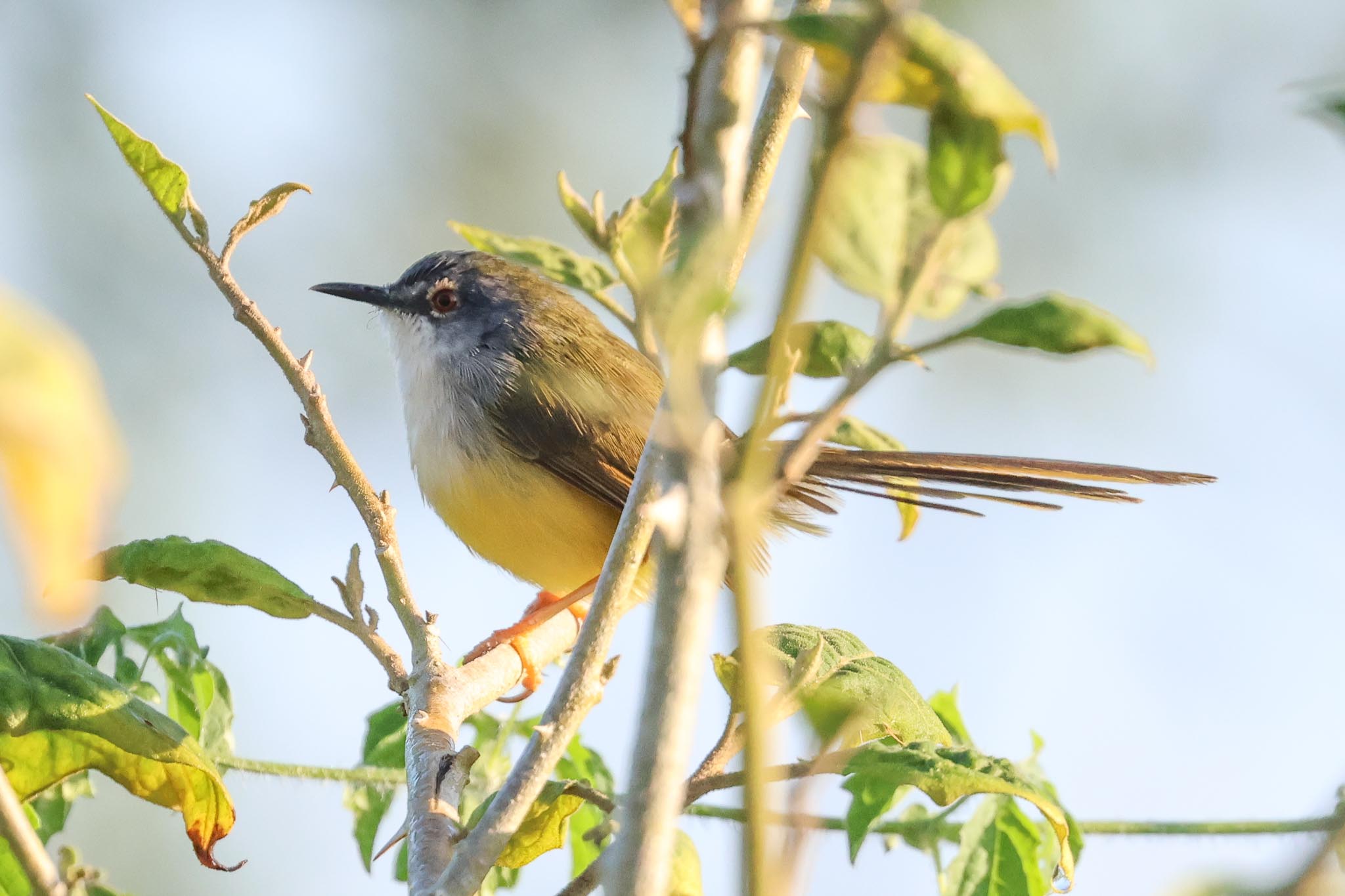
We walked on a little further along the track through the fields and up onto the bank again. Here we found a couple of Yellow-vented Bulbuls flitting around and one perched in the sun on a small post. A female Asian Koel was perched in the trees on the other side of the river – we would hear them constantly but see far fewer. We realised there were some small seedlings planted in the grass on the bank, so we picked our way back and onto the track again.
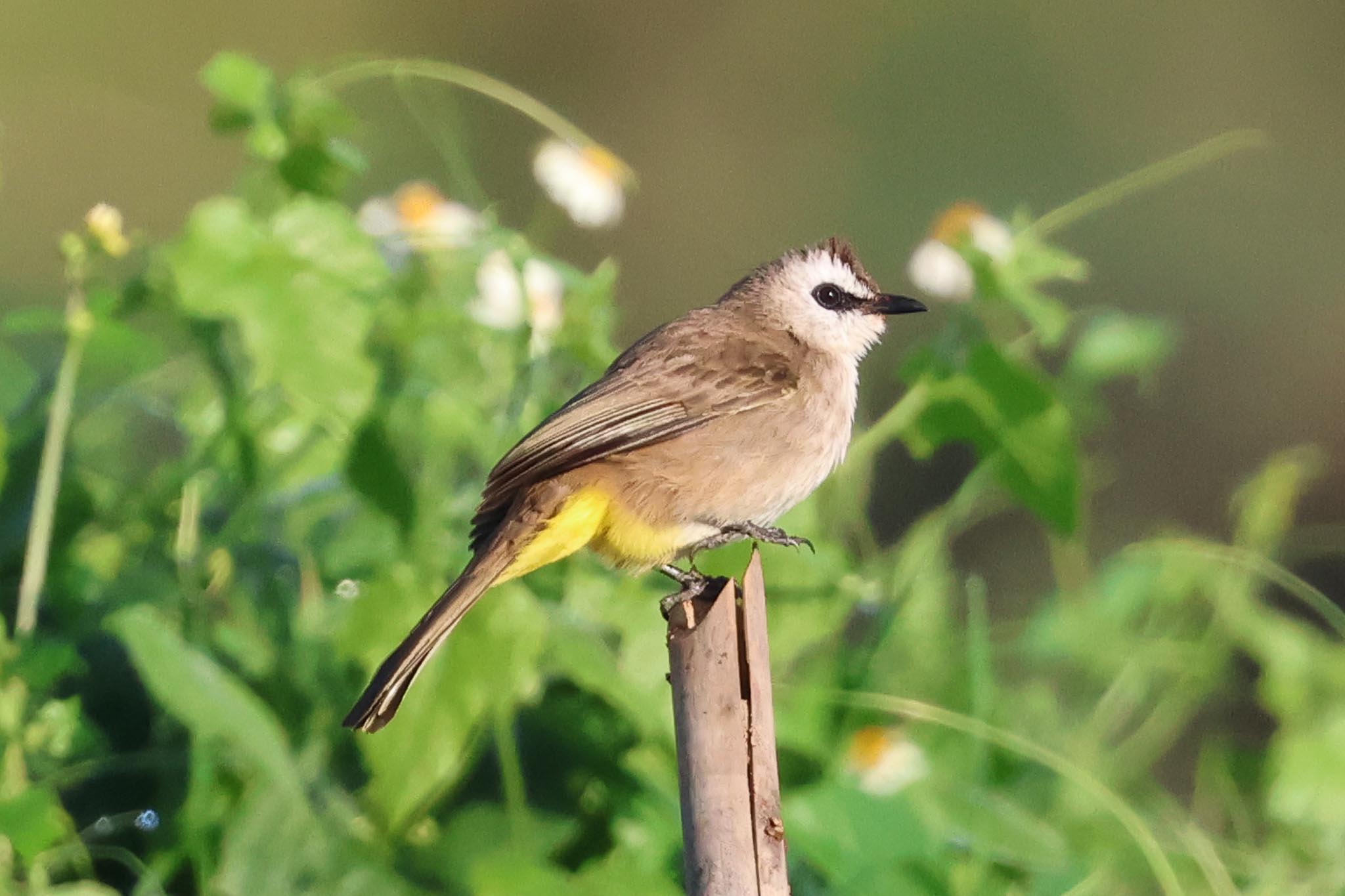
As we started to walk back, there was a burst of song from a male Siberian Rubythroat from the back edge of the bamboo clumps. We stood and waited and eventually had some good views of its striking ruby-red throat. A couple of Baikal Bush Warblers were calling too, but they were typically skulking and we couldn’t see them. Back at the minibus, several Asian Red-rumped Swallows and House Swifts were hawking overhead now.
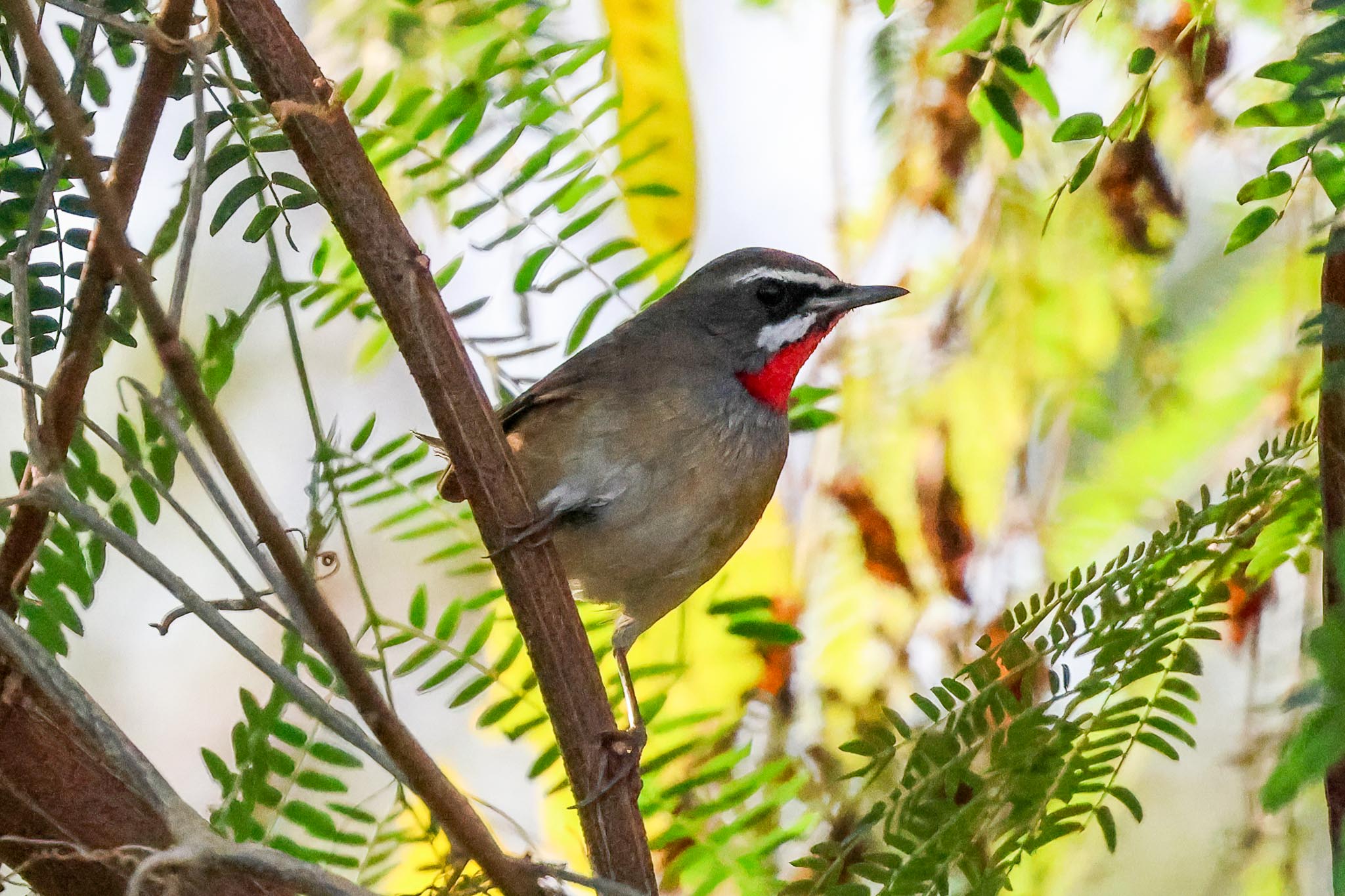
We drove round to the other side of the river to see if we could find the Long-billed Plovers again and get a better view with the sun behind us. An Indochinese Roller was perched on the wires over one of the canals as we passed. We parked on the side of the road and walked down to check the area below the dam first. Several Thai photographers were now camped out in two hides set up in the middle of the gravel, and perhaps unsurprisingly there was no sign of the plovers, so we walked on down the road to check the river lower down, in the direction the birds had flown earlier. The area between the road and the river had been cleared, but the steep riverbank beyond was still mostly thickly vegetated, so we had to find a gap from where we could see down to the riverbed. Several Paddyfield Pipits and Red-wattled Lapwings flew up from the bare ground ahead of us.
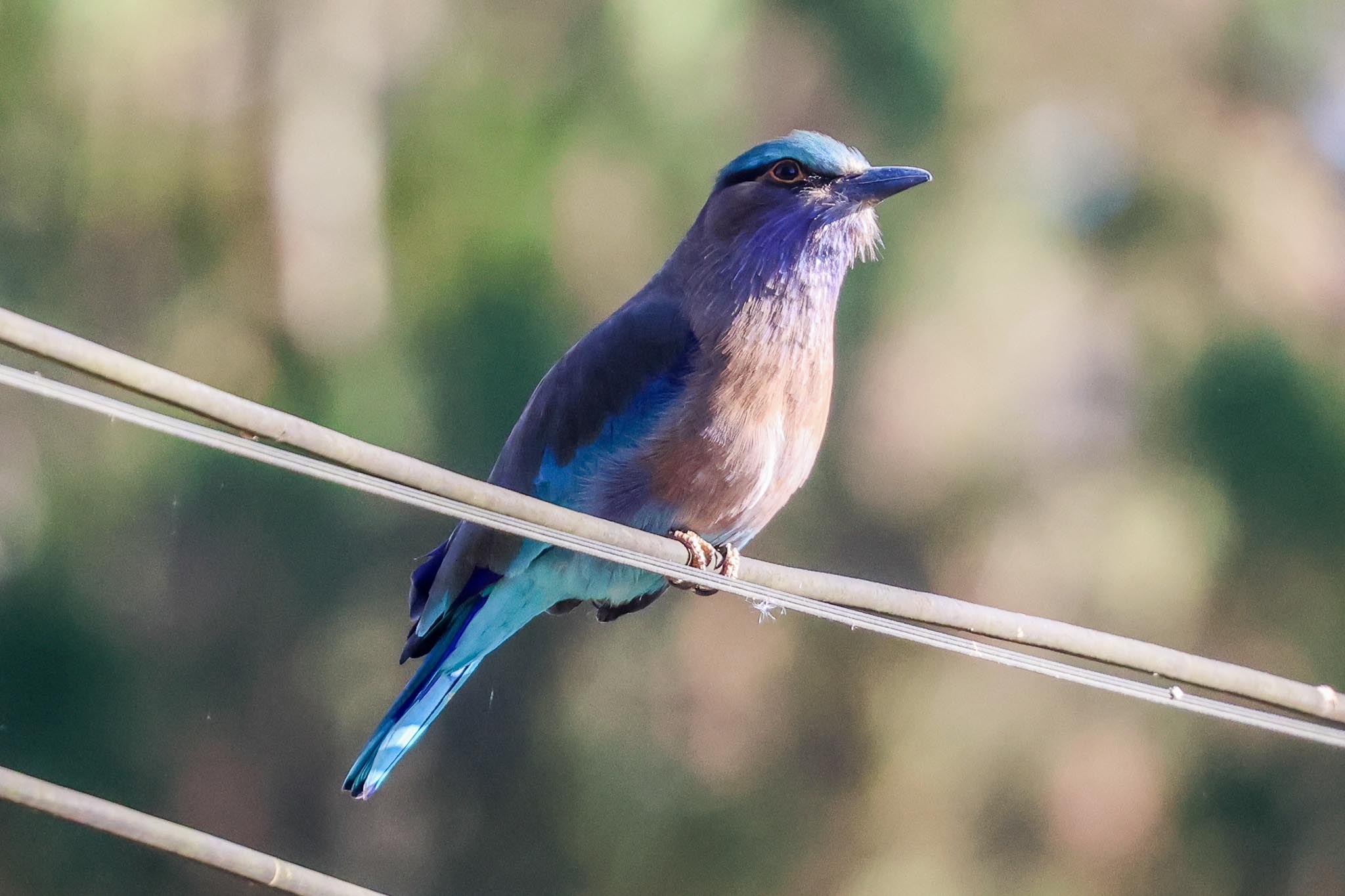
When we found a point from where we could view, we scanned the area of stones and gravel patches in the river, but at first all we could find was just a couple of Common Sandpipers and Little Ringed Plovers again. As we tried to find an angle to scan further up- and downstream, a Long-billed Plover flew in and landed on the stones below us. We had a much better view now through the scopes than we did earlier, with the sun behind us. It quickly became apparent that the reason the plover had flown back into view was because the Thai photographer we had seen first thing was now walking up the riverbed. He was speaking on a radio and appeared to be attempting to flush the plovers back upstream towards the hides on the gravel by the dam. Nick called down and he stopped and waited for us to finish looking.

Back in the minibus, it was a long drive up to Fang on a rather winding road. Thankfully, because it was Saturday there were not many lorries, and we could sit back and enjoy the views of the surrounding hills. We made it in good time and arrived at the Tangerine Ville hotel, where we would be staying for next four nights, just before 12pm. We were too early to get into our rooms, so we went into the restaurant for a break for lunch first. Afterwards, we had some time to check in and drop off our bags before we met again downstairs.
We made our first visit up to Doi Lang West this afternoon. After a steep drive up to the top of the ridge, we parked at the top in a shadier area of forest and got out to walk along the road. There were lots of birds to see – a pair of Golden-throated Barbets were lurking in a nearby clump of bamboo, a Slaty-backed Flycatcher appeared above our heads, a Puff-throated Babbler was feeding on the ground on the bank above the road, a pair of Blyth’s Shrike-Babblers were in the trees and a Bronzed Drongo was hawking over the road. There were lots of leaf warblers high in the canopy too, but they are hard to ID from below and not calling, so we would have to wait for better views.
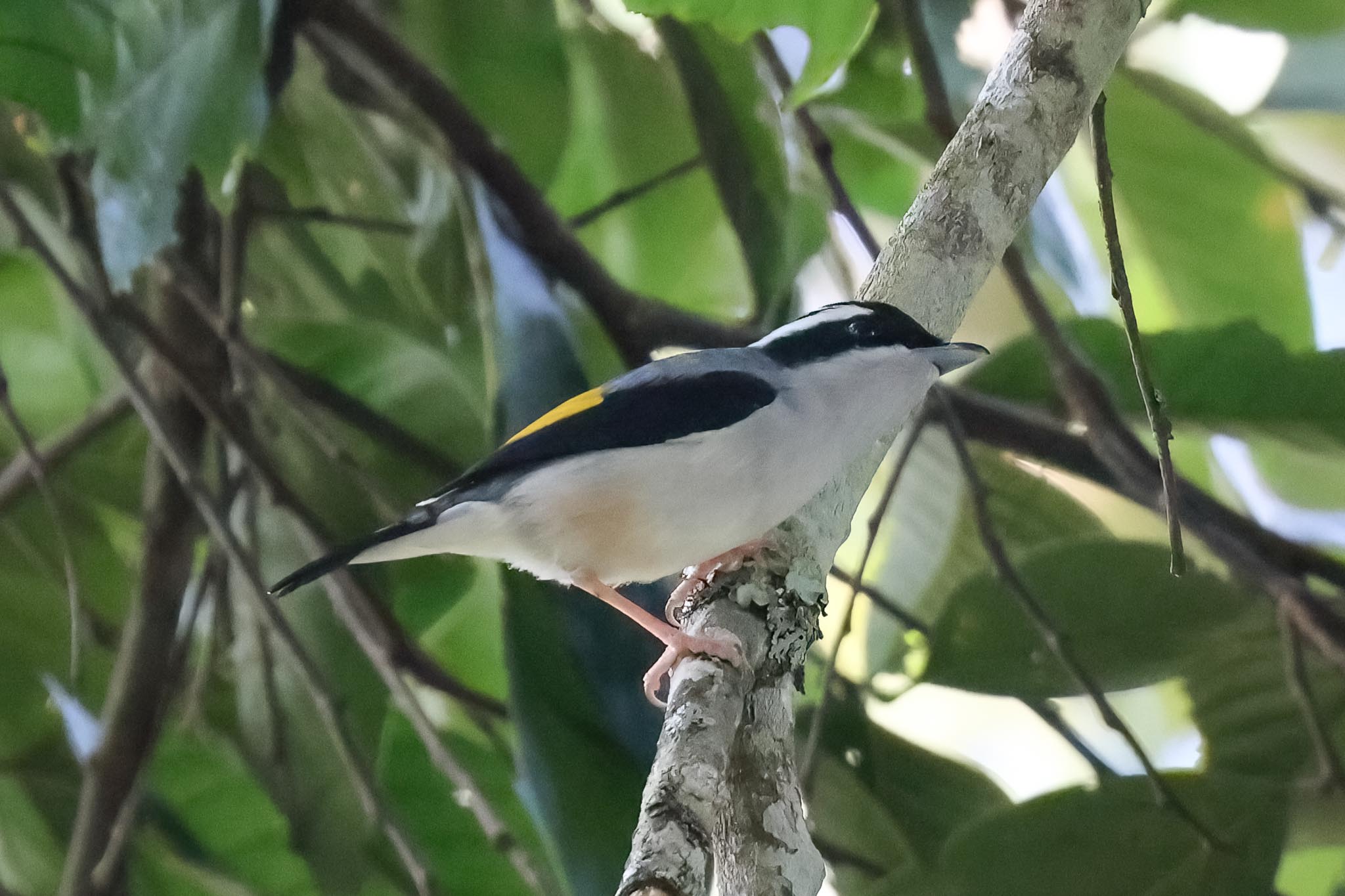
As we started to walk down along the road, another car pulled up and three more birders got out. One was having trouble with his camera and they asked if we had a small screwdriver to fix it, so one of the group walked back to the minibus with them to get something out. On the way, they spotted a Eurasian (White-faced) Jay in the trees above the road, so most of the group walked back to see it. Already split as a separate species by some authorities, it looks very different from our Eurasian Jays back home. A few of the group had stayed put further up the road and were rewarded with a brief male Rufous-bellied Niltava but it dropped down the slope before everyone else could get back to them. Thankfully we would see it regularly. A Pale Blue Flycatcher and a young male Sapphire Flycatcher were now flitting around in the trees above us.
We continued on along the road. A couple of Scarlet Minivets appeared in the trees along with Velvet-fronted Nuthatch and Grey-capped Woodpecker. Nick could hear Himalayan Cutias calling up in the canopy behind us but we couldn’t see them before they went quiet. We turned our attention to a Stripe-breasted Woodpecker which had now appeared on a dead branch in front, and then the Cutias called again and had crossed to the same side of the road. We could see them now, a little further up, in the top of a tree, climbing up a branch. Unfortunately they quickly disappeared into the leaves and then flew deeper in.

They can be a hard bird to connect with and not everyone in the group had seen them, so Nick led us quickly in on a small path through the trees and up to an open area on the top of the ridge, where we had a good view looking down into some of the large trees below. A Giant Nuthatch flew in, climbed up to the top of one of the trees and perched in the open calling. Then the Cutias appeared too, and we had nice views of them as they climbed round the trunks and along the branches.
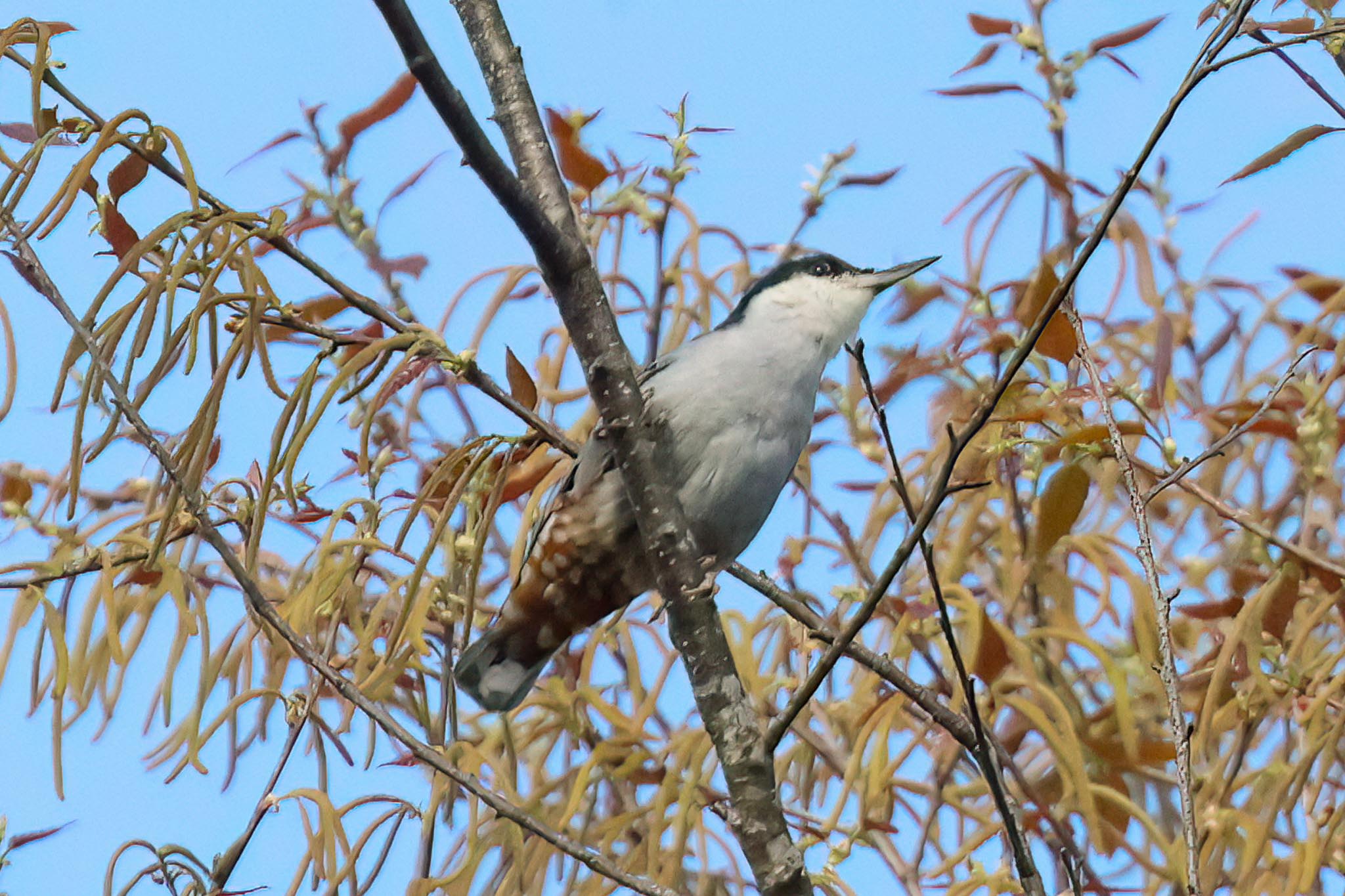
We had better views of some of the leaf warblers here, looking down on where it was more open, with a brief Pallas’s Warbler, Hume’s Warbler and nice views of Claudia’s Leaf Warbler all in a small tree in the sunshine below us. A Blue-winged Minla joined them briefly too and then a pair of Grey-chinned Minivets flew in and started flycatching above our heads.
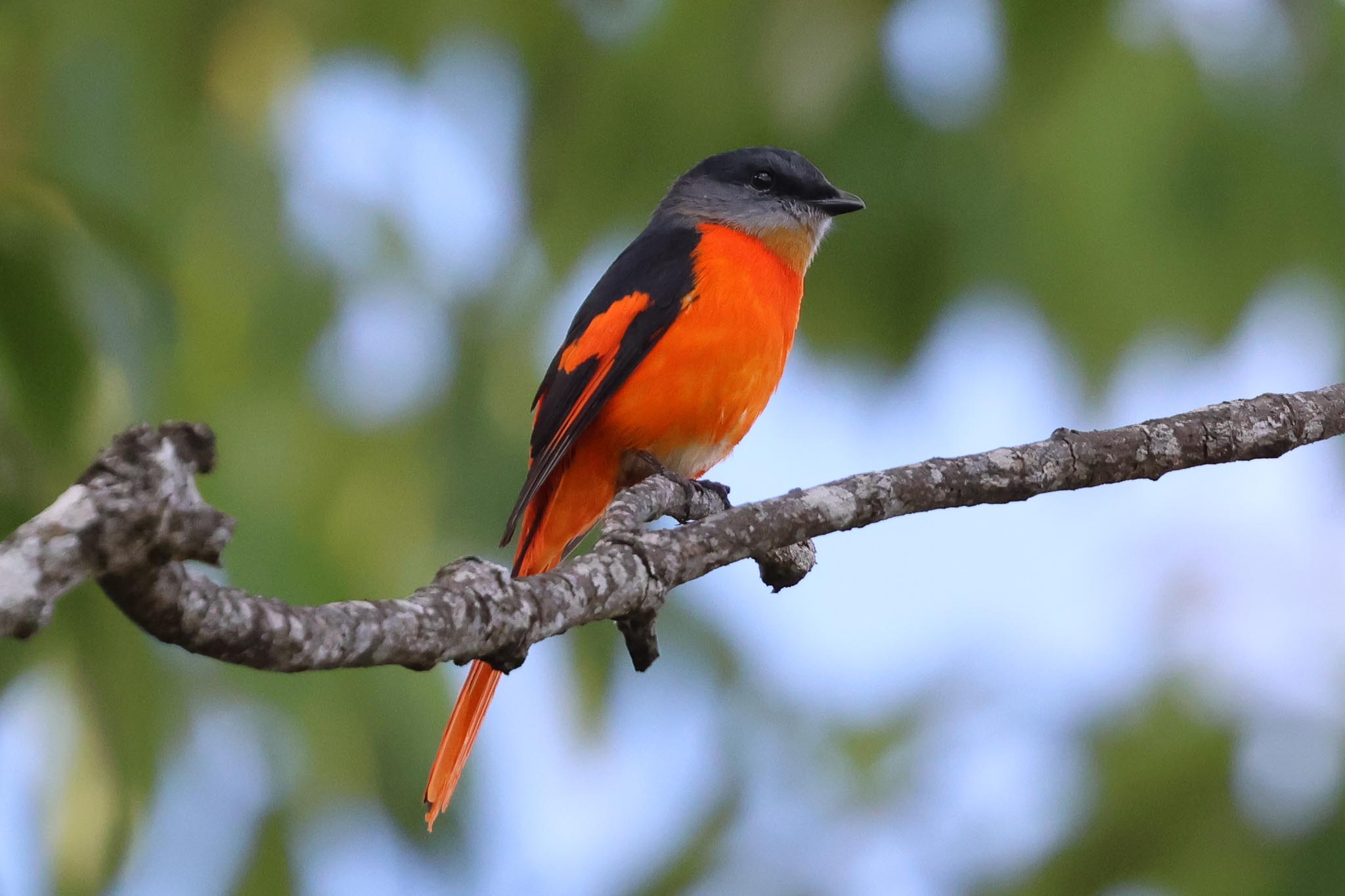
Back out onto the road, we walked further down. A Grey Wagtail perched in a bush looked rather out of place. An increasing number of Cook’s Swifts were hawking over the trees above us but they were hard to focus on as they shot over the gap in the canopy. Nick whistled the call of Collared Owlet and several Gould’s Sunbirds appeared in the bushes nearby, mostly immature males but two smart males and one female, and more Hume’s Warblers flew in to the trees above. The Hume’s Warblers here are a distinctive subspecies, mandellii, with a very different call to the nominate form we get occasionally in the UK.
The hillside beyond was more open and we could hear birds calling in the bracken but they were hard to see. Another Golden-throated Barbet was feeding on the berries in a bush, and our first Flavescent Bulbul was down below the trees beyond. There were Hill Prinias calling too but they remained stubbornly out of view. Walking back along the road and into the shade of the trees again, a Rufous-gorgeted Flycatcher was showing very well in the vegetation next to the road now and a Chinese Leaf Warbler appeared in the trees beyond.
It was time to start heading back down, so we returned to the minibus. There is an open area on the side of the road where seed is put out by photographers for Mrs Hume’s Pheasant but they are predominantly seen early in the morning here. As we approached, a flock of at least 15 Oriental Turtle Doves flew up and landed in the trees behind so we pulled forward slowly and could see one still on the verge through the windscreen, with a second which flew down to join it. When they flew up, we edged forward again and had better views of several perched in the trees.

Pressing on, we stopped again further down on a steep slope through the pines. Hundreds of Cook’s Swifts were now gathering above, and we had good views of their narrow white rump patches as they twisted and turned, at times quite low over our heads. Nick whistled Collared Owlet again, and a young male Ultramarine Flycatcher appeared in the tree in front of us, joined by several Hume’s Warblers. An Olive-backed Pipit flew over calling.

As we continued down, we made one last stop on a bridge over a small river. We could see a Striated Heron and a Little Egret feeding downstream and more Grey Wagtails and several White Wagtails. A brief White-rumped Munia appeared in a clump of bamboo by the road. Then it was time to head back to the hotel. It had been another busy day but we had some time to get settled in now before we met again for dinner. There was a large party of Thais in the restaurant this evening, singing and dancing, so we ate in a private room next door. After dinner, we walked back into the hotel and quickly went through the extensive day’s list in the seating area in reception where it was a bit quieter, before we turned in for the night.
Sunday 21st January
After another early breakfast, we set off up to Doi Ang Khang. At the top of the twisty road, we stopped first at the checkpoint, where the sun was just catching the tops of trees. Several Long-tailed and Short-billed Minivets appeared, along with a pair of Chestnut-vented Nuthatches and a couple of Japanese Tits. The sun was on the garden below the checkpoint too, so we walked a short distance down the road – all we could find were a few Sooty-headed and Flavescent Bulbuls, not much else.
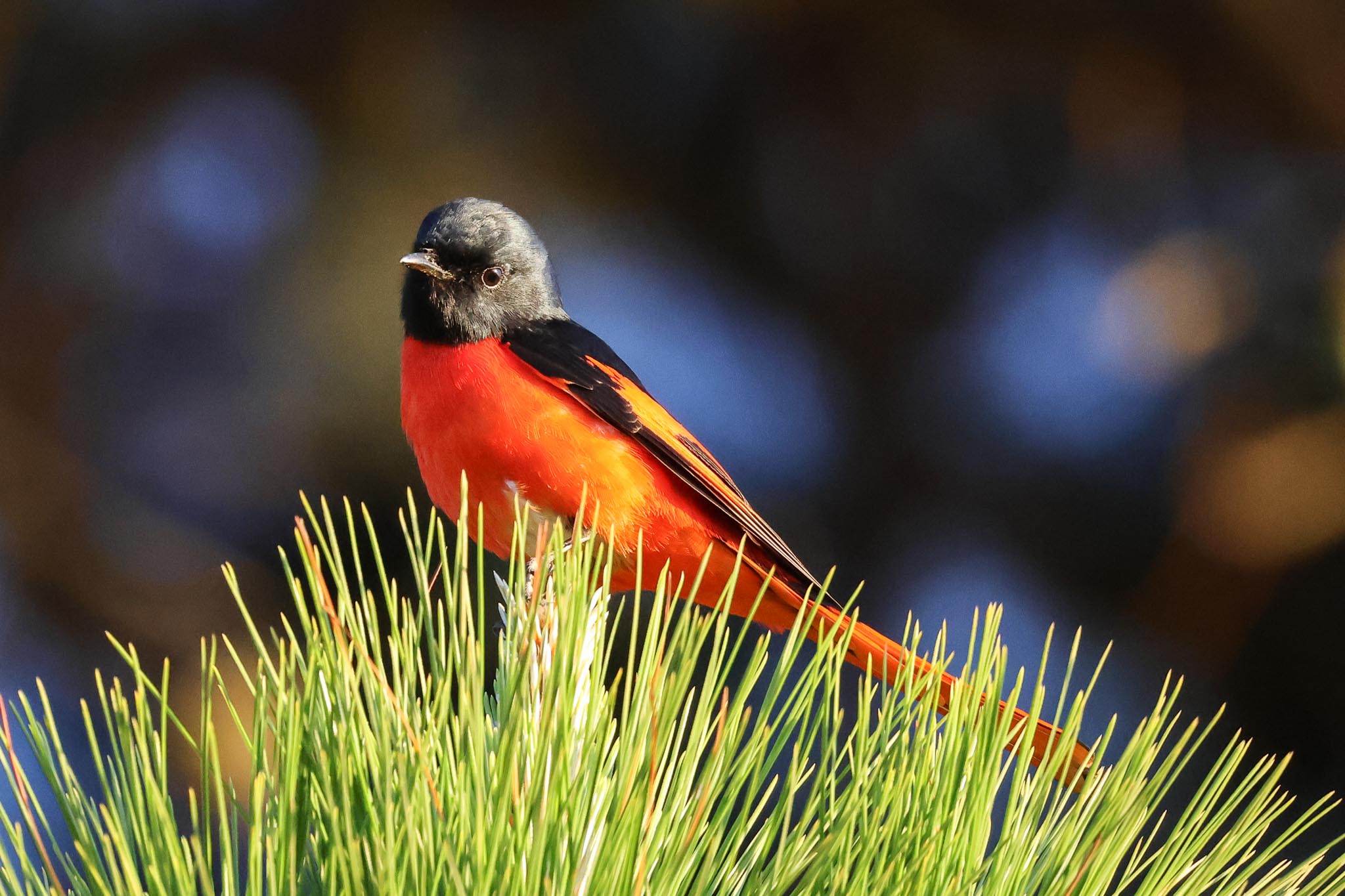
We started to walk further up the road instead and a Davison’s Leaf Warbler began singing nearby. We found two or three in the bushes here – also known as White-tailed Leaf Warbler, we could see the distinctive white undertails. Further up along the road it seemed very quiet, just a few bulbuls including a Black-crested Bulbul, but very skulking. We decided to try elsewhere.
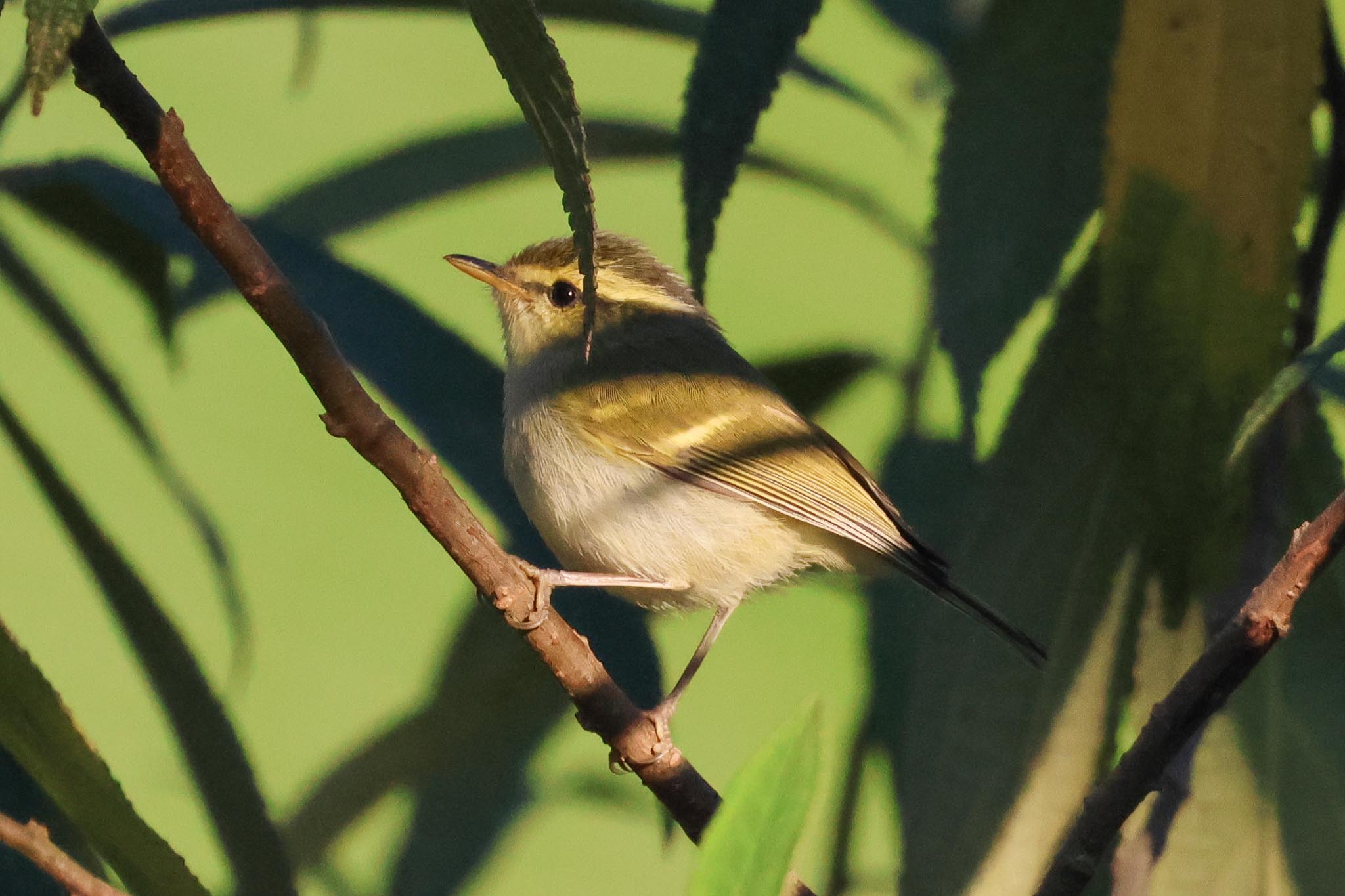
Back in the minibus, we dropped down along the low road and stopped again. There were more bulbuls in the bushes here and as we walked back along the road to where the sunshine was falling, we found several Black-backed Sibias too. The cherry trees are in full bloom now and there were lots of birds feeding in the blossom mainly Gould’s Sunbirds and one or two Black-throated Sunbirds too, and an Indian (formerly Oriental) White-eye briefly.
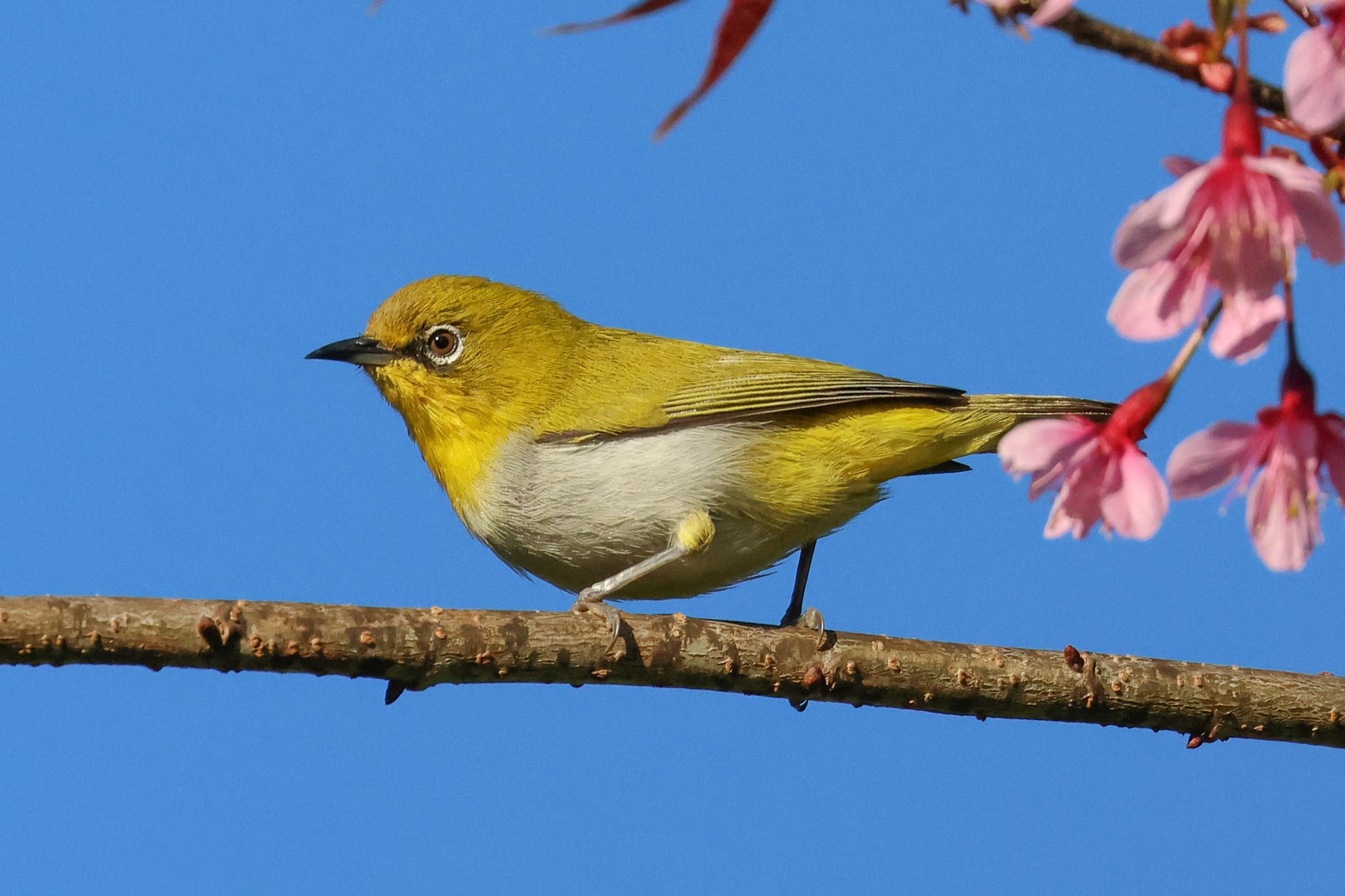
A small track off the road led down to where people had been dumping rubbish. There were more bulbuls, including a couple of Brown-chested Bulbuls which perched up nicely in the sun, and two Hill Prinias which we could now see down in the bushes beyond. A Grey Treepie was calling in the distance and eventually flew past. A Daurian Redstart flew out but disappeared into the thick bamboo behind us and unfortunately wouldn’t show itself again, and a Streaked Spiderhunter flew past. We could now hear a genuine Collared Owlet (not Nick!) calling from deep in the trees across the road behind us.
As walked back along the road, we had better views of the Black-crested Bulbuls now. The area where we had parked the minibus was in the sunshine now, so we walked in to a small clearing opposite where there seemed to be a lot more activity now, with several Black-backed Sibias and bulbuls in the trees above. A Bianchi’s Warbler was flitting around in the undergrowth and called as it flew across at one point. When a second similar warbler appeared nearby, it gave a different call, a Martens’s Warbler. Several species are almost identical and can only really by separated by call, having formerly all been lumped together as ‘Golden-spectacled Warbler’.
Moving on, we continued round along the low road, through the Chinese village where a big wedding celebration was underway. Beyond, Nick could hear Silver-eared Mesias calling through the open window so we stopped and got out and found a large flock in the trees above the road. There were a couple of Mountain Bulbuls with them and a brief Orange-bellied Leafbird.
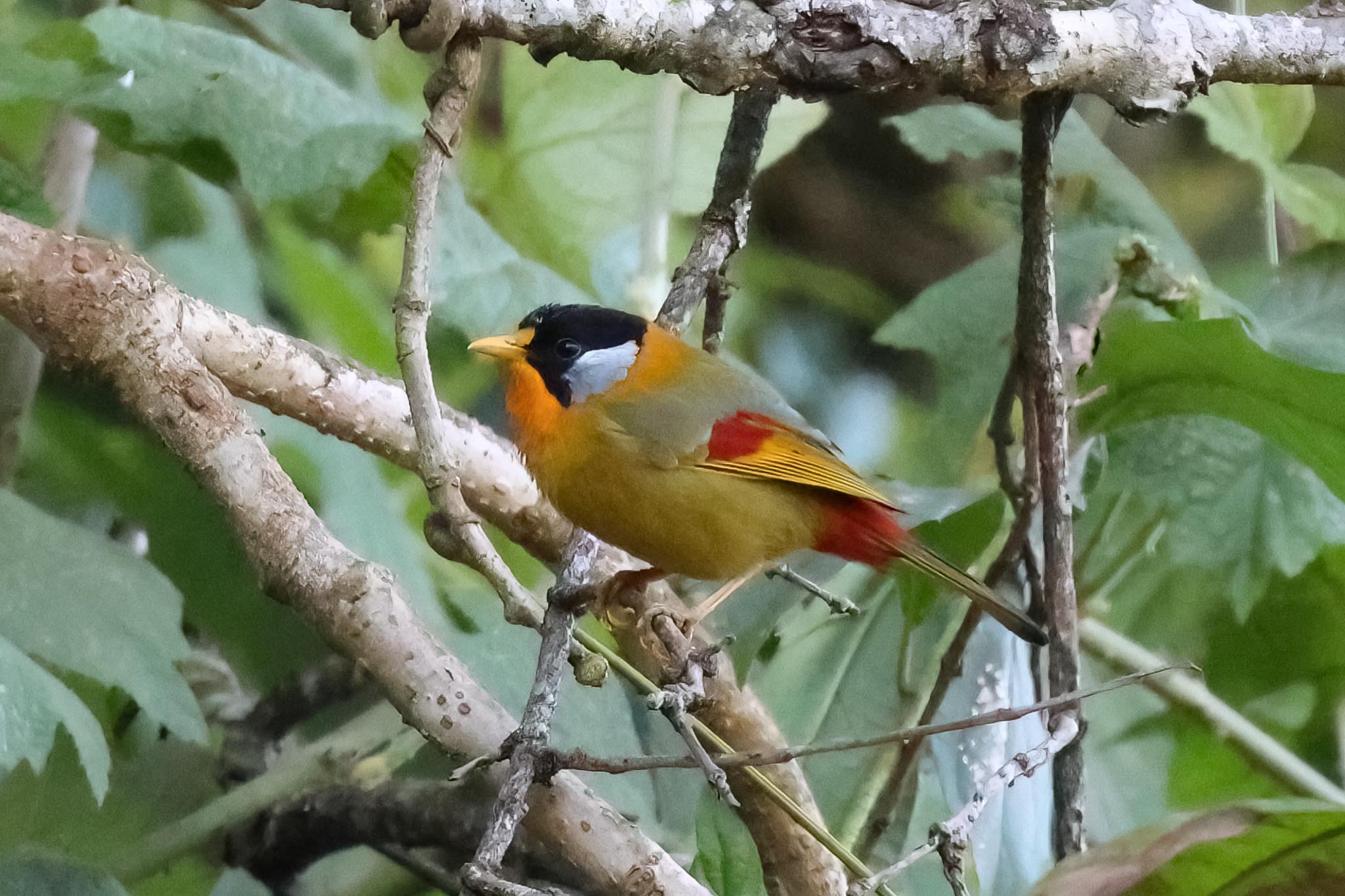
Further on, we stopped again where there were more birds in the pines. A male Chestnut-bellied Rock Thrush eventually showed well in the scopes in the trees opposite. Overhead, a mixed flock included another pair of Chestnut-vented Nuthatches, Blyth’s Shrike-Babblers, several Hume’s Warblers and a small group of Blue-tailed Minlas.
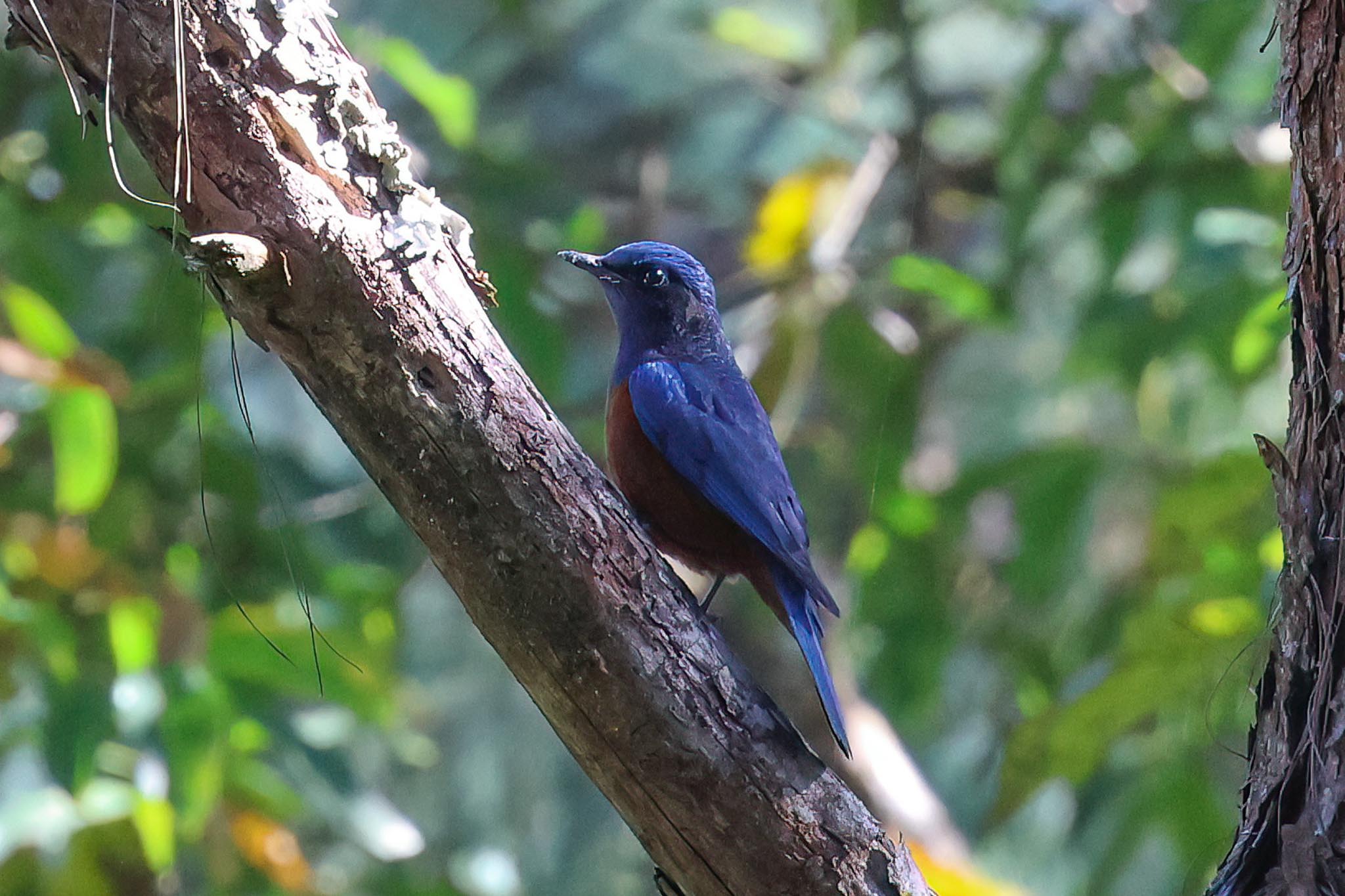
On to the King’s Project, it was very busy today – lots of Thai people were coming up to enjoy the sight of all the cherry trees in full flower and take selfies, including the party from the hotel last night. We found somewhere quieter to park, out of the way behind some buildings. There was tall bamboo growing behind the parking area, where several Common Rosefinches were perched, including some nice pinky-red males.
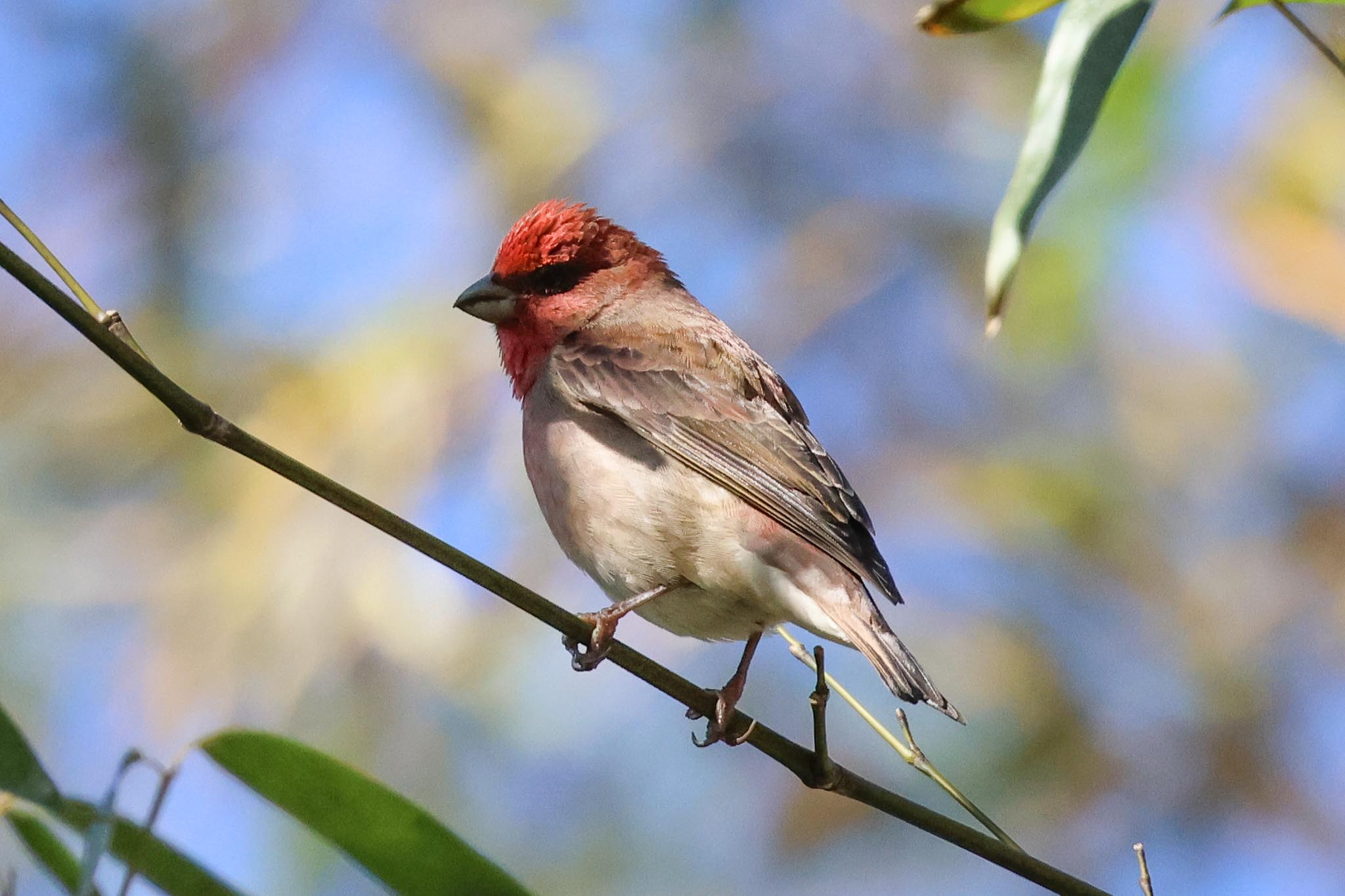
Along a short path from the back corner of the car park, there was a feeding area cleared on the ground on the edge of a thicker stand of bamboo. A very tame White-rumped Shama was hanging around looking for food and a Grey-headed Canary Flycatcher was flitting around above. As we stood and waited, more birds appeared – a male Hill Blue Flycatcher came in, followed by a female Rufus-bellied Niltava, a Siberian Blue Robin was hopping around deeper in the leaves under the bamboo, shivering its tail – although unfortunately not an adult male, and a pair of Yellow-bellied Warblers appeared up in the bamboo.
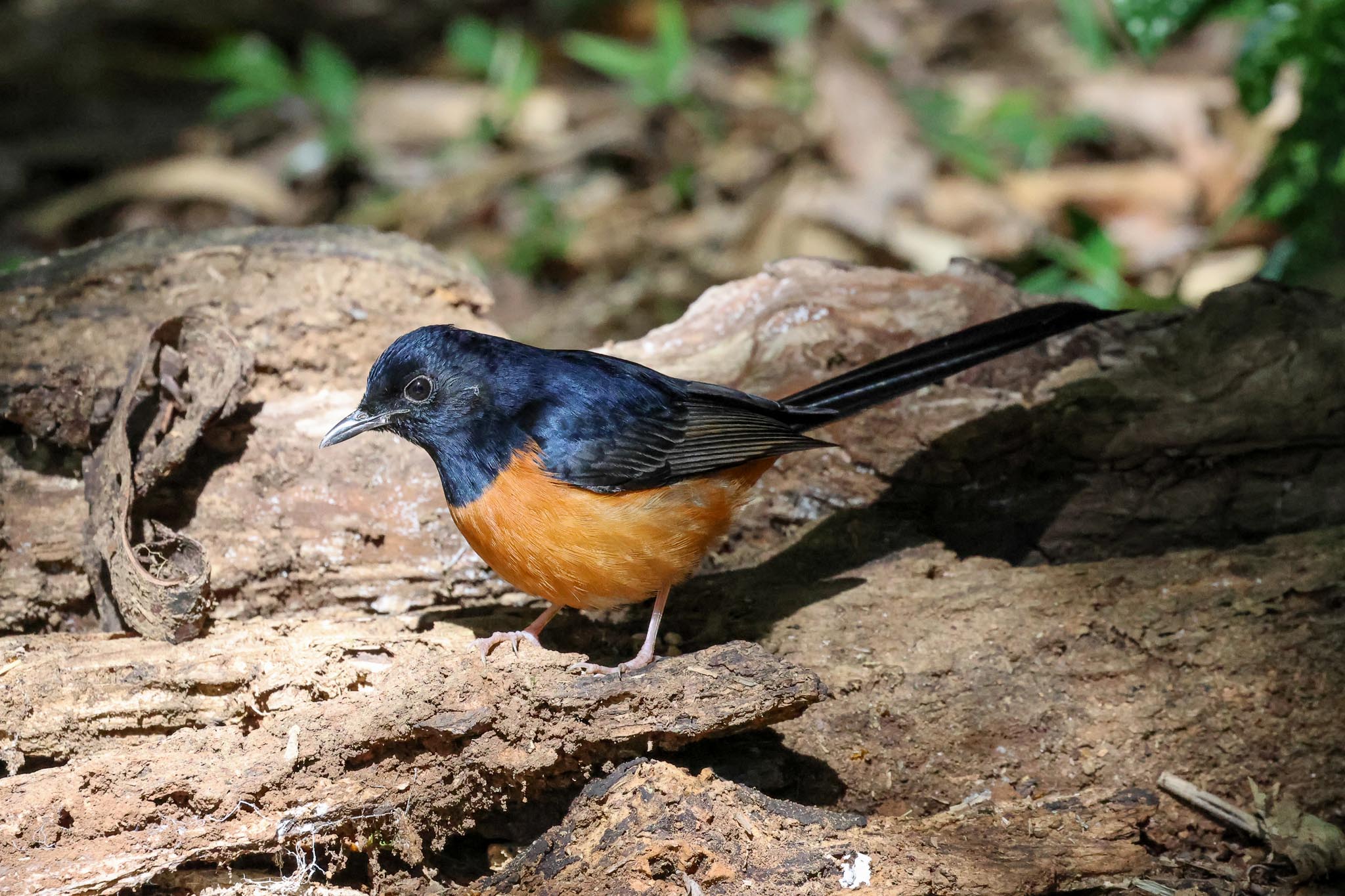
Our main target here was White-tailed Robin and we didn’t have to wait too long before the male appeared behind the feeding area. It wouldn’t come out into the open though, and we didn’t have any mealworms, but we did have good views as it flicked between the stems low down, and worked its way up the hillside through the trees the other side. As we turned to go, a couple of Bar-winged Flycatcher-Shrikes appeared in the more open bamboo on the way back to the car park.
We walked back out onto the main road and down past the ornamental gardens, where lots of the locals were having their photos taken. The back of the café, with the rubbish dump behind, was rather less attractive and consequently it was quieter here, and we found at least six Black-breasted Thrushes feeding around the rubbish.

Back up to the minibus, we still had a little time before lunch so we drove back out of the King’s Project and back along the low road, stopping again close to where we saw the Mesias earlier. In the flowering cherry trees on the verge, there were more sunbirds and a Chestnut-flanked White-eye appeared above us. Lots of Yunnan Fulvettas were hiding in the thicker vegetation on the steep bank below the road but eventually gave good views, as did a couple of Golden Babblers, a female Little Pied Flycatcher flicked around and after a bit of effort we all got on to a Speckled Piculet in the trees below us. A Black-throated Sunbird was feeding in the cherry trees.

We stopped for lunch now in the village outside the King’s Project, where most of us opted to try the wild boar red curry, a speciality of the Yunnanese café where we ate. Afterwards, we had time for a bit of shopping, with several of the group particularly enjoying the dried strawberries in the dried fruits emporium next door, and having looked round the market stalls we tried some local fresh ginger and honey tea.
The Thai army camp on the Myanmar border close to here is a bit of a local tourist attraction, and it was slightly incongruous as we drove in with stalls selling local goods lined up past the entrance and lots of cars parked in the car park beyond. Walking down through the camp, a Burmese Shrike was perched in the shade in the trees above an area of lawn, occasionally dropping down to the ground, unconcerned by all the people passing by. There is a viewpoint here looking out over into Myanmar, the razor wire of the border fence right in front. Several Cook’s Swifts were hawking low back and forth, another Burmese Shrike was (appropriately!) in the bushes beyond the fence, along with a couple of Ashy Drongos. We managed to add a few species here to our Myanmar bird lists!

We still hadn’t come across a Crested Finchbill, so we drove on now to another site to see if we could find one. We walked in along a track between some houses, with another Hill Prinia and a Northern Treeshrew in the undergrowth, and out into the open farming area beyond, where there were lots of flowering cherry trees, with lots of Red-whiskered and Sooty-headed Bulbuls and small flocks of Common Rosefinches feeding in the blossom. A Common Tiger butterfly was nectaring on the flowers right in front of us. Nick heard Crested Finchbills calling, and scanning round we found them on some distant bare trees right on the top of the hill. Through the scopes we could see their crests, and distinctive short pale bills. A Maroon Oriole was calling but refused to show itself.
It was time for a change of scene, so back down to Fang, we dropped off those who preferred a couple of hours to rest and relax at the hotel, and then continued on to some nearby ricefields. We could hear Oriental Skylark singing as we walked down to the edge and picked up a couple flying round over the middle of the dry paddies off to one side. There were several Amur Stonechats too, plus a Long-tailed Shrike, a Wryneck perched on a bund, and a Dusky Warbler tsking by a ditch. We could see lots of Black-winged Stilts in the wet ricefields beyond.
As we walked out along a bund, one or two Little Ringed Plovers, a Green Sandpiper and a Common Snipe flew up ahead of us, along with a couple of Paddyfield Pipits. Several Striated Swallows were hawking back and forth low over the fields. We got closer views of the Oriental Skylarks now as several flew round in front of us or fluttered up singing. Several Scaly-breasted Munias were perched in a small area of taller reeds in the middle of the dry fields, and then a female or immature male Black-headed Bunting appeared in the same clump looking rather plain and washed out. Further on, we flushed another small bird from the ground which flew off ahead of us and looked longish tailed as it dropped back in. When it flew up again we could confirm it was a Chestnut-eared Bunting, and unusually it landed in full view further back (they normally tend to drop into cover) and we could all see it in the scopes.

A male Pied Harrier flew in now, quartering over the further wet paddies but working its way gradually in towards us. When it got to the back of drier fields where we were standing it suddenly dropped down and came up again with a Ricefield Rat in its talons. It landed again to feed, so we started to walk a little closer, trying to get in position for when it came up again. We were distracted by more Chestnut-eared Buntings though, getting more good views now in the scope, and several closer Oriental Skylarks. When we looked up, the Pied Harrier was already flying, and we watched as it flew round over the dry fields before it flew up and over a building behind. Stunning bird! A Common Kestrel flew in and landed on the roof.

We scanned the wet paddies beyond now. As we as the huge group of Stilts, now mostly busy bathing, we found a White-throated Kingfisher and a Brown Shrike on different posts, and a couple of Wood Sandpipers flew round calling. There is a pool behind a high bank over in the corner, so we cut back across the dry fields to look at that. We had glimpsed a Bluethroat here earlier, before we got distracted by the Chestnut-eared Buntings and Pied Harrier, so we walked back round to where it had seemed to land. We flushed a couple more Chestnut-eared Buntings first, then the Bluethroat, a female. As we walked up onto the top of the bank now, a small flock of Lesser Whistling Ducks flew up and landed again further back. There were quite a few Eurasian Teal and Garganey around the edges of the pool, plus several Moorhens and a single Coot, and a couple of Little Grebes.
It was time to head back. As we walked back across the ricefields, we flushed a Pintail Snipe this time. An Asian Koel was calling in the bushes back over by the minibus, which we got in the scope, the first male we had actually had a good look at. After a quick stop at a filling station on the way to refuel, and for one of the group to stock up on Pepsi, it was back to the hotel.
Monday 22nd January
We were heading up to Doi Lang West again this morning to try to see Mrs Hume’s Pheasant, which required an even earlier start than normal. Coffee was served in the restaurant at the hotel from 5.30am, and we picked up a packed breakfast to take with us, as well as our packed lunch. When we got to the top, we found there were already four Thai photographers’ hides set up in a semicircle close in around the area where the Mrs Hume’s Pheasants normally come out to feed and three cars parked ahead of us, potentially limiting our view somewhat. We had to park behind them, but we got into position and waited.
There were a few other birds dropping down in front of the hides – starting with a couple of Grey Bushchats, followed by at least nine Olive-backed Pipits and a pair of Japanese Tits. Four Oriental Turtle Doves flew down and landed at the far end of the grass but seemed to be reluctant to come in closer to where the seed was strewn. A very smart male Ultramarine Flycatcher and a Rufous-gorgeted Flycatcher were flitting around in the trees above the road and a pair of Giant Nuthatches even thought about coming down too before changing their minds. A Yellow-streaked Warbler appeared briefly in the bushes in the gully by the road.
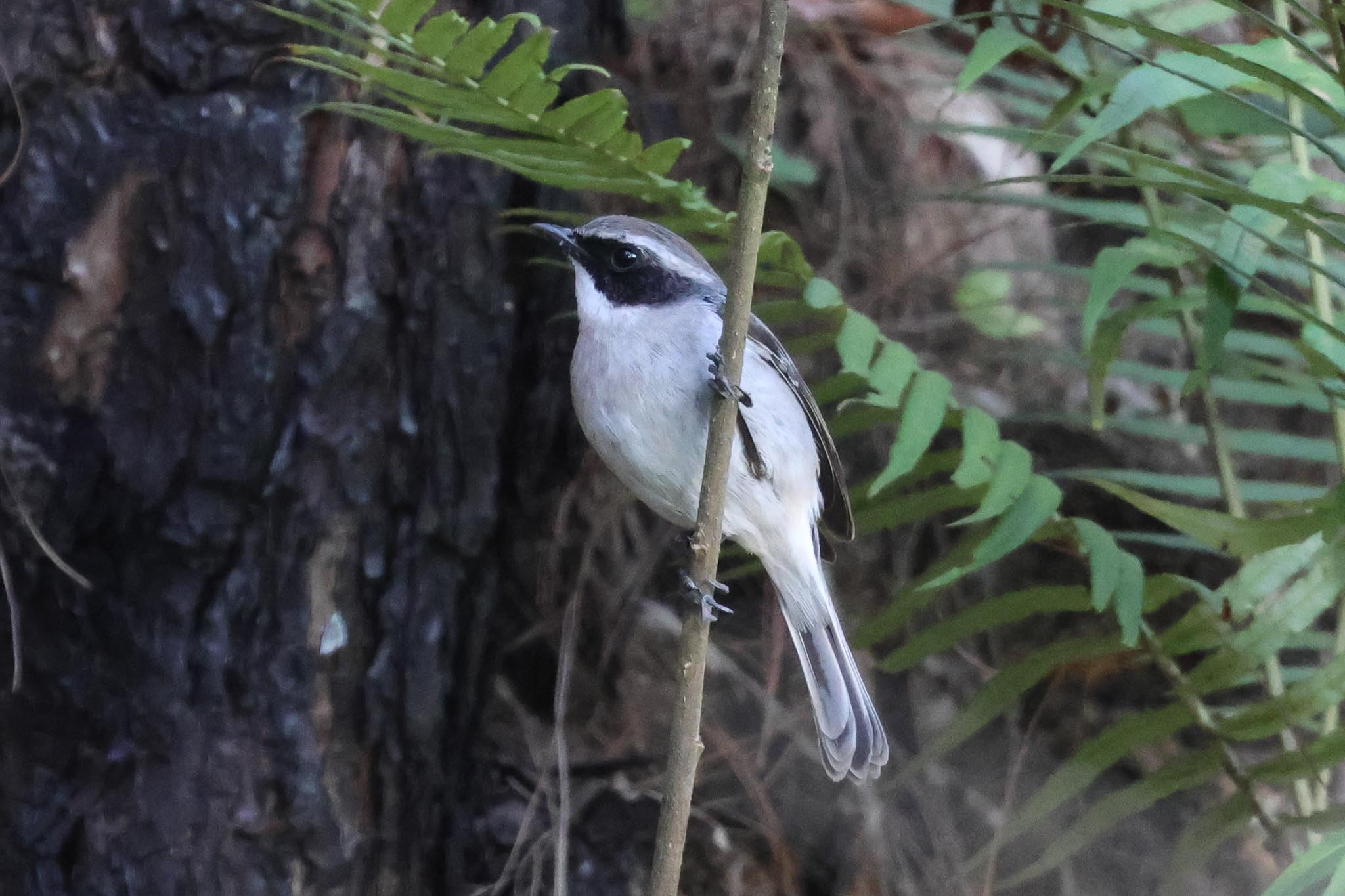
Several other cars had pulled up behind us now too, but the prime time for the pheasants came and went and there was still no sign. We heard Rusty-cheeked Scimitar-babblers approaching, and they came right past us through the bushes and along to where the hides were set up, but unusually they didn’t come out onto the grass at first. They continued further on and went quiet for some time before eventually working up the courage to come in briefly. Gradually it became clear that the pheasants were not coming today, and the photographers came out of their hides. We walked down, and the male Ultramarine Flycatcher was still perched on a stick right in front of the hides, at least it was not affected by their presence. They did seem to be placed very close to the area where the pheasants feed – it didn’t seem like the photographers had actually brought the wide angle lenses they would have needed! Mrs Hume’s Pheasant is not as easy to see anywhere else in the world as here, so it was one we really wanted to see – we would have to have another go. We ate our packed breakfasts, then decided to move on.
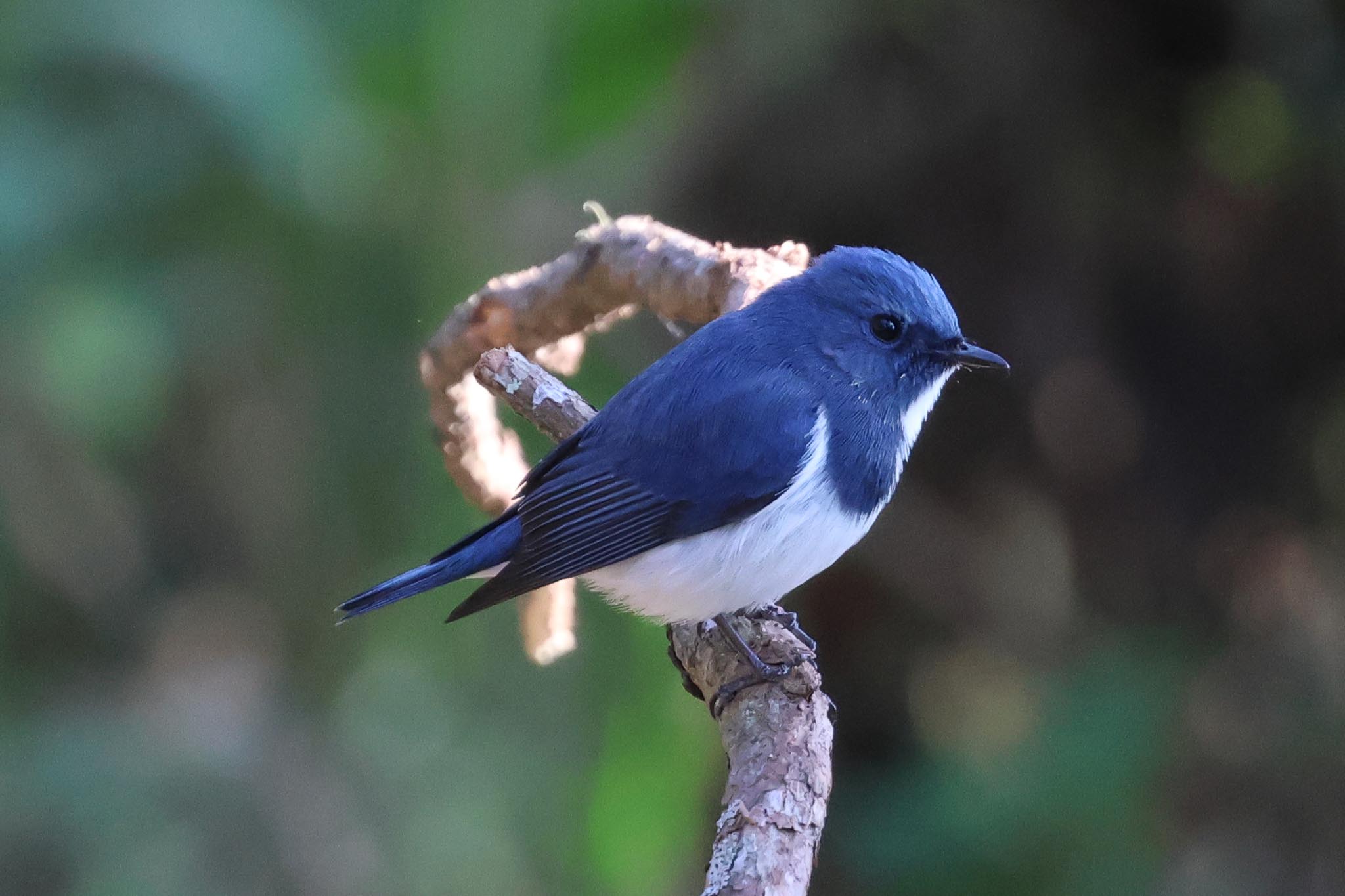
Two Yellow-throated Martens ran out into the road in front of us briefly before we stopped again further along in a slightly more open area. We were later getting here than we had hoped and it was already starting to warm up. There were several Gould’s Sunbirds and a Hume’s Warbler in the bushes by the road, and a brief Siberian Rubythroat. We stopped to scan the trees beyond, but they were mostly quiet, just a distant oriole calling.
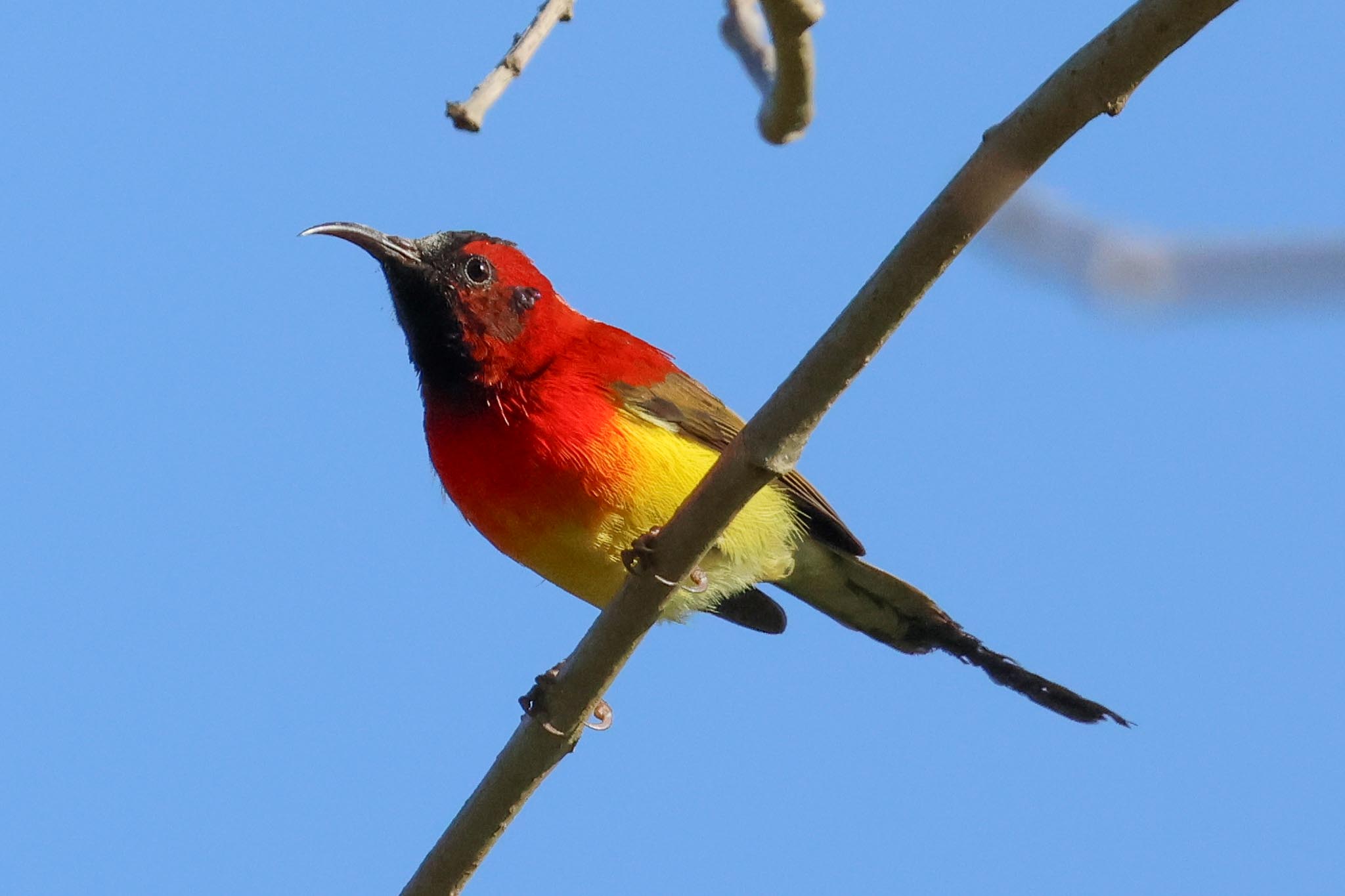
We were hoping to find Spot-breasted Parrotbill here, and Nick heard one calling now which gradually started to work its way towards us. It was keeping tucked down in the undergrowth out of sight though and we had only managed a couple of quick glimpses before a motorbike went past and it disappeared back in. We managed to follow it and could still hear it calling, getting brief views of it in a low tree before it dropped back over the ridge behind. Thankfully, when we got to the edge and looked over, we found it perched in a small dead tree just beyond and finally everyone could get a good look.

Back out on the road, a Crested Goshawk circled over the clearing, its white undertail coverts spread out, then started to give a series of bursts of quivering wingbeat display. Walking back to the minibus a Crested Serpent Eagle circled over calling, then started displaying too. It was a good morning for raptors.
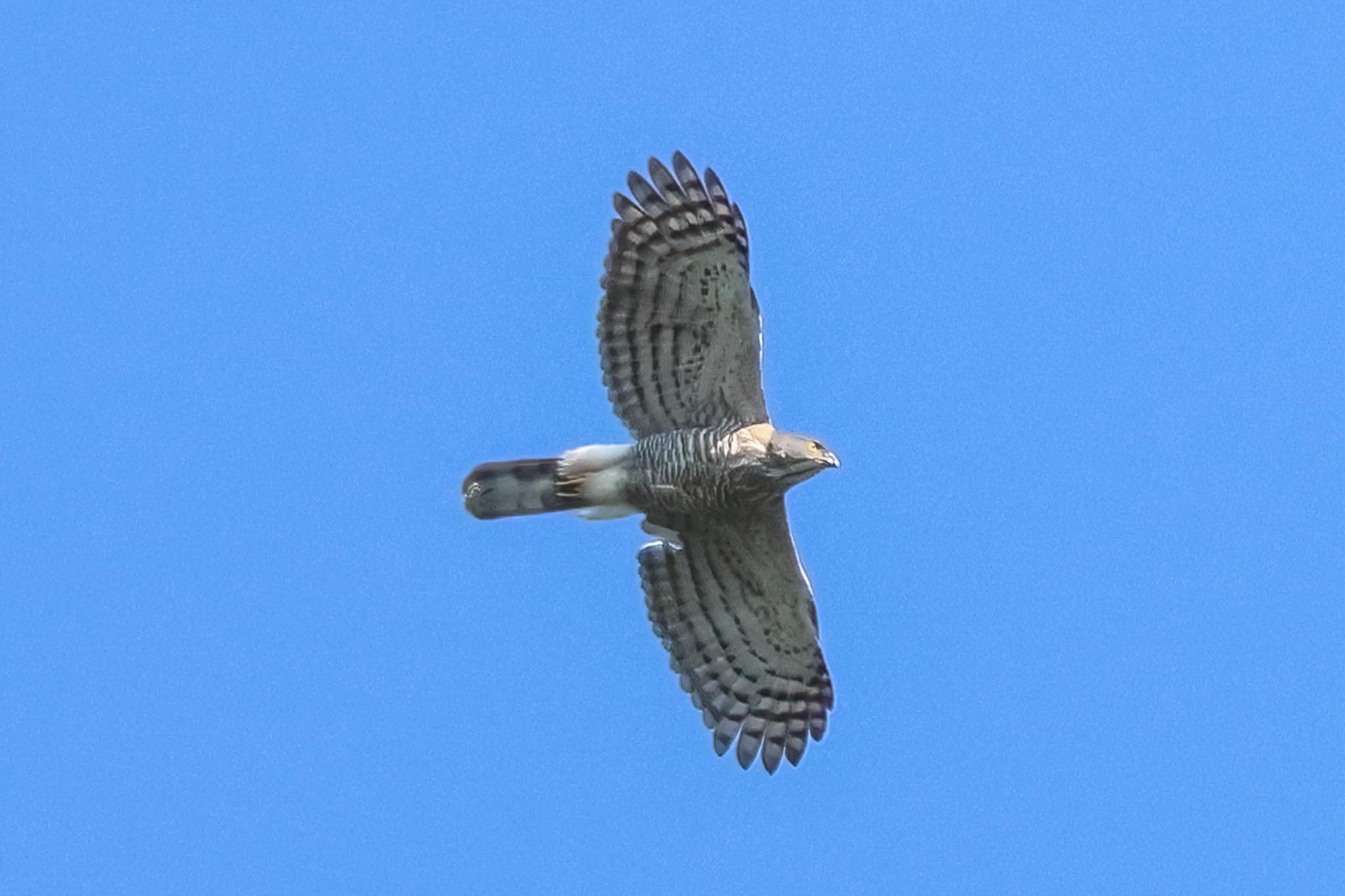
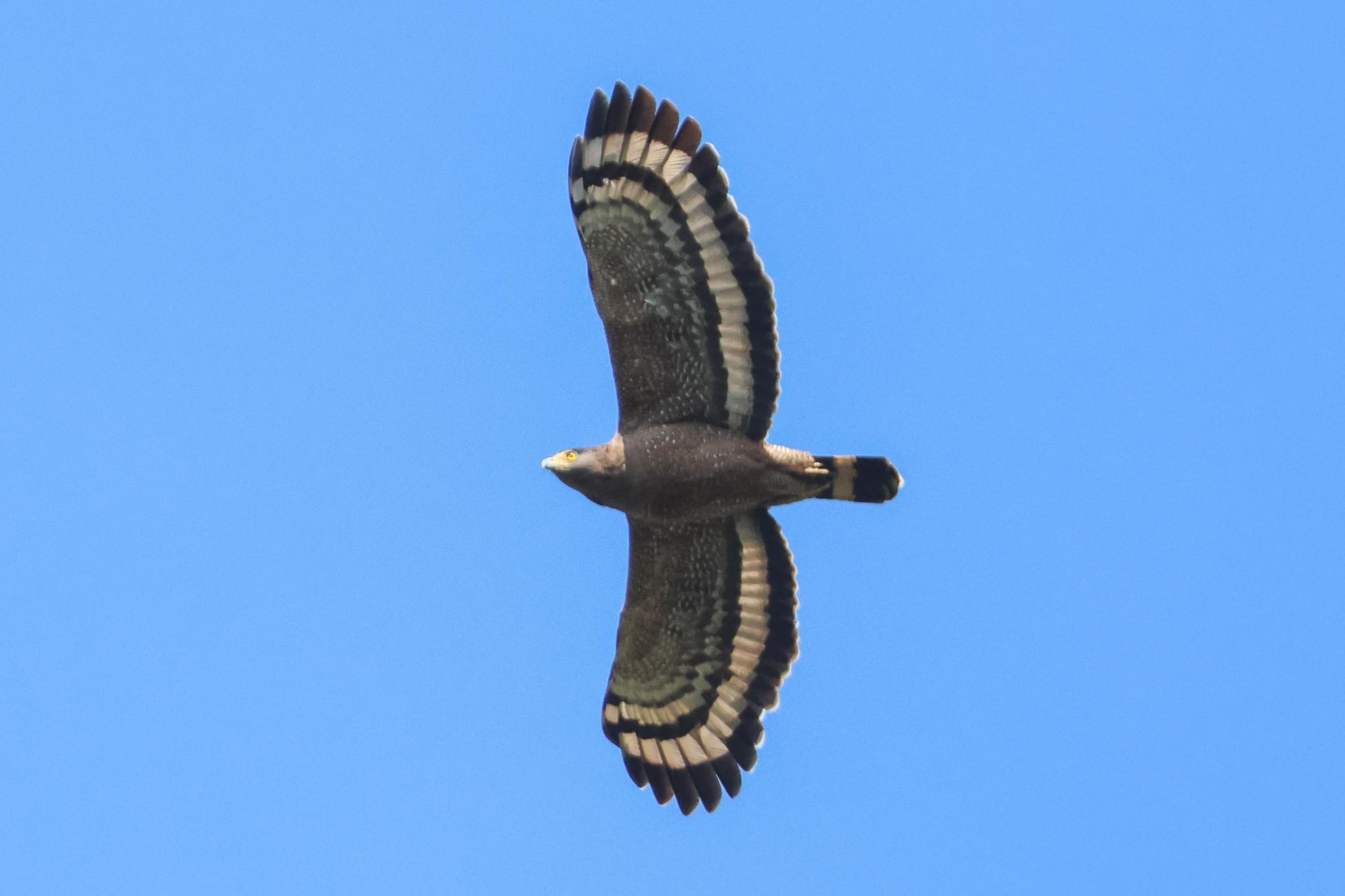
Continuing on to the end of the road, we could hear Striated Bulbuls calling from further down the slope but couldn’t see them at first through the trees. A Grey-backed Shrike was perched in a tree just inside the edge of the military camp, and lots of Flavescent Bulbuls and a male Slaty-blue Flycatcher were waiting to be fed at a feeding station under the bamboo nearby. We heard Crested Finchbills calling now and found several feeding on a fruiting bush down below the road, and lots of butterflies and Gould’s Sunbirds were feeding around a flowering cherry tree by the gate. Walking down the road a short way, we found two Dark-backed Sibias feeding on another berry bush on the verge, then as we came back, a Striated Bulbul finally perched up a couple of times in the trees.
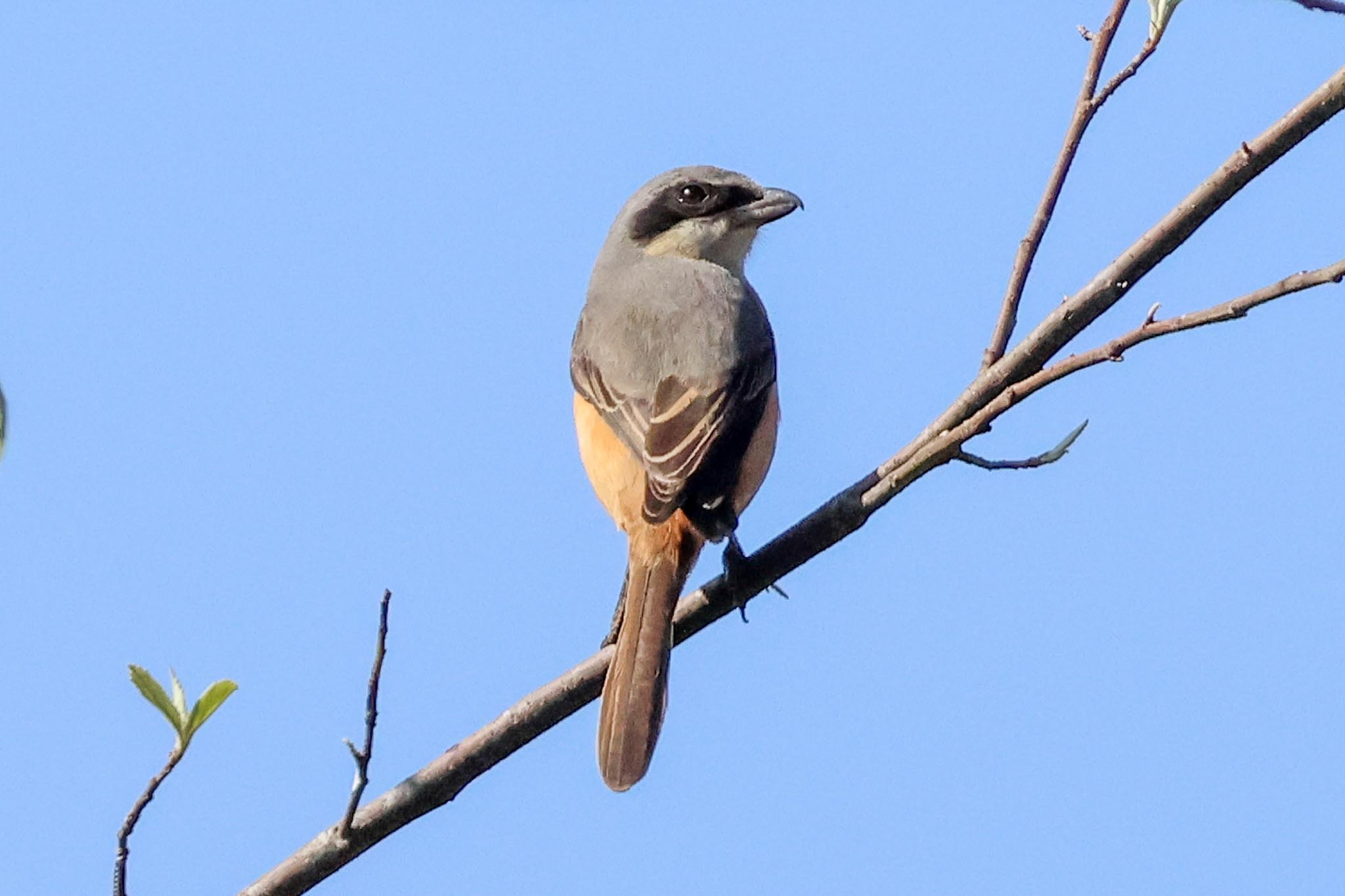
Back to the shady area where we had spent some time on our first afternoon here, we walked up and down along the road and a succession of different birds appeared. When we stopped to look at a pair of Grey-chinned Minivets, we found a mixed flock in the trees – lots of Claudia’s Leaf Warblers and Pallas’s Warbers, a pair of Grey-headed Canary Flycatchers, a couple of Hume’s Treecreepers. There were a couple of Cuckooshrikes too – the first Indochinese, then a Black-winged Cuckooshrike.
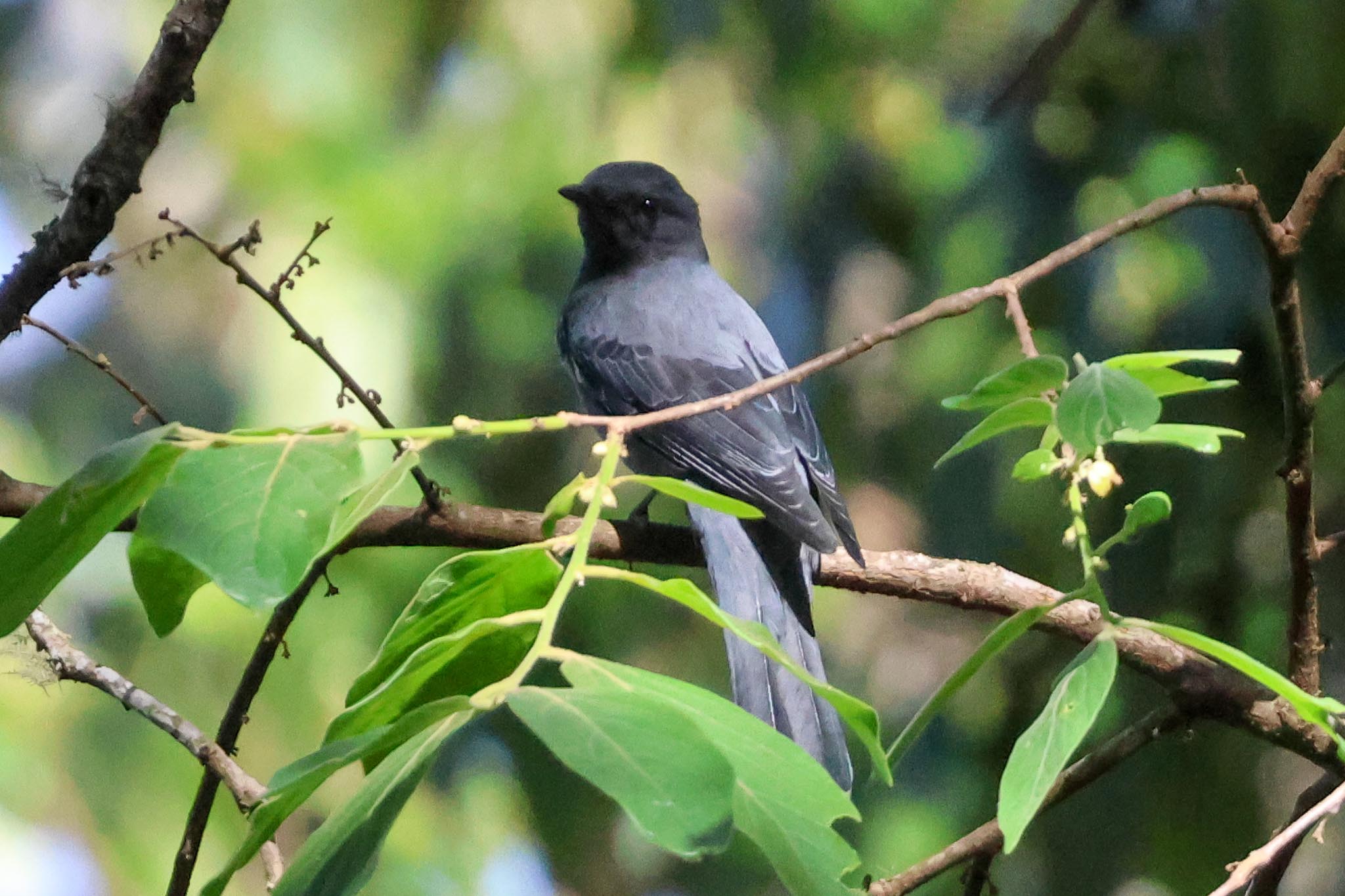
Two Black-throated Bushtits were feeding on catkins right in the top of one of the tallest trees, but eventually dropped down a little so we could get a slightly better view. We found a female Slaty-backed Flycatcher too, the Rufous-gorgeted Flycatcher we had seen a couple of days ago again, and a Golden Babbler calling.

Back at the minibus, we were eating our packed lunches when a Silver-eared Laughingthrush appeared right next to the road. It was obviously coming in to a feeding station set up by the local photographers to look for food, so we put some out and two came back in.

When they had gone, the male Rufous-bellied Niltava reappeared, staying long enough for everyone a chance to get some great views of it this time.
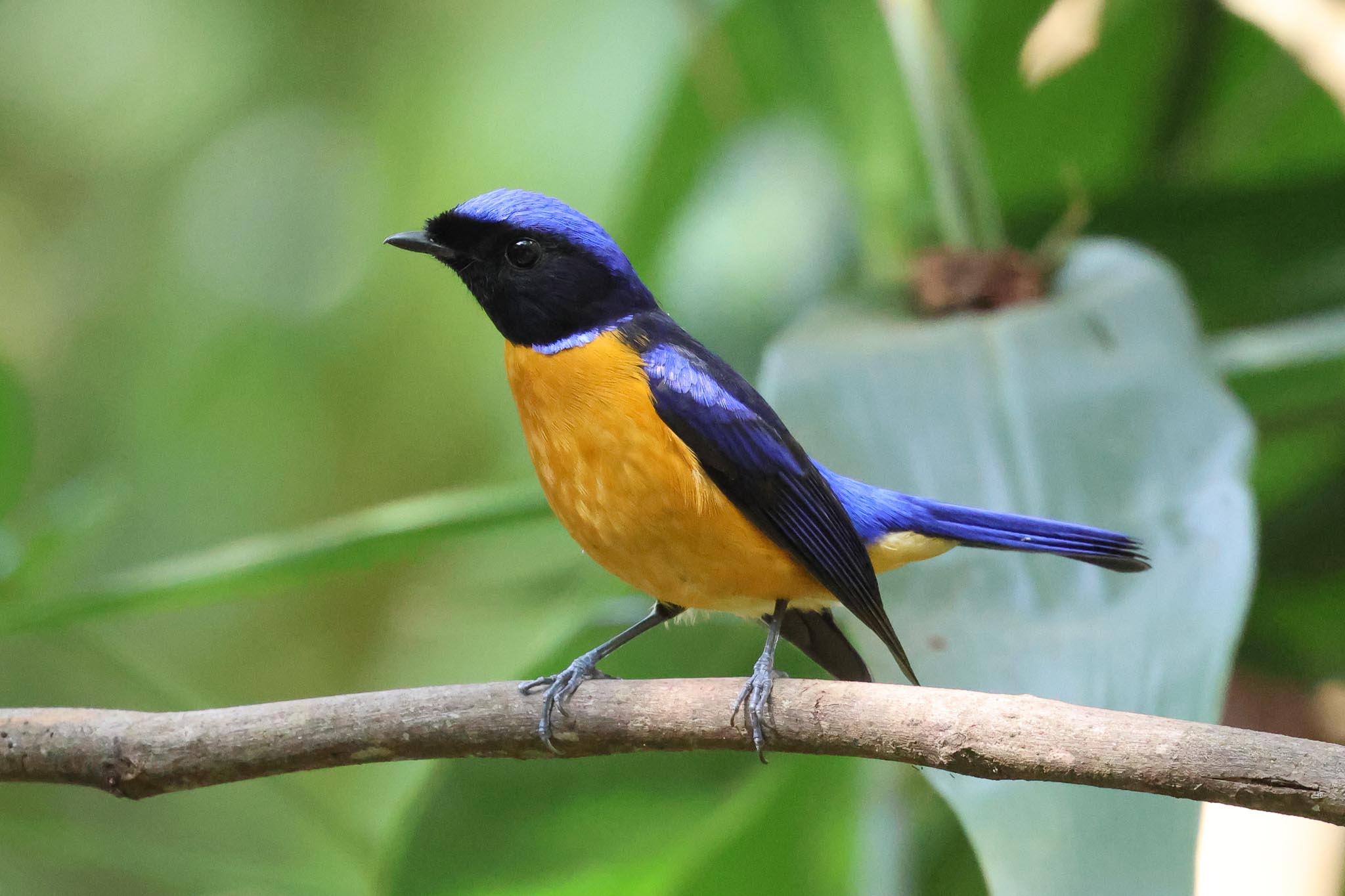
Some Dutch birders mentioned that they had seen White-browed Laughingthrush at another feeding station further up, so after we had finished our fried rice we walked along the road to look – there was no sign of it now, just a female Hill Blue Flycatcher. As we walked back, we could hear Cutias calling again in the trees and found a couple of Long-tailed Minivets. Back beyond the minibus, a Martens’s Warbler was feeding in the bushes by the road.
Although we were still finding some new birds here, it felt like we needed a change of scene, so we headed back down to Fang and took the road north towards Thaton. As we turned into an area of ricefields, we looked down to see a Citrine Wagtail in one of the first wet paddies by the track but it flew as we tried to pull up.
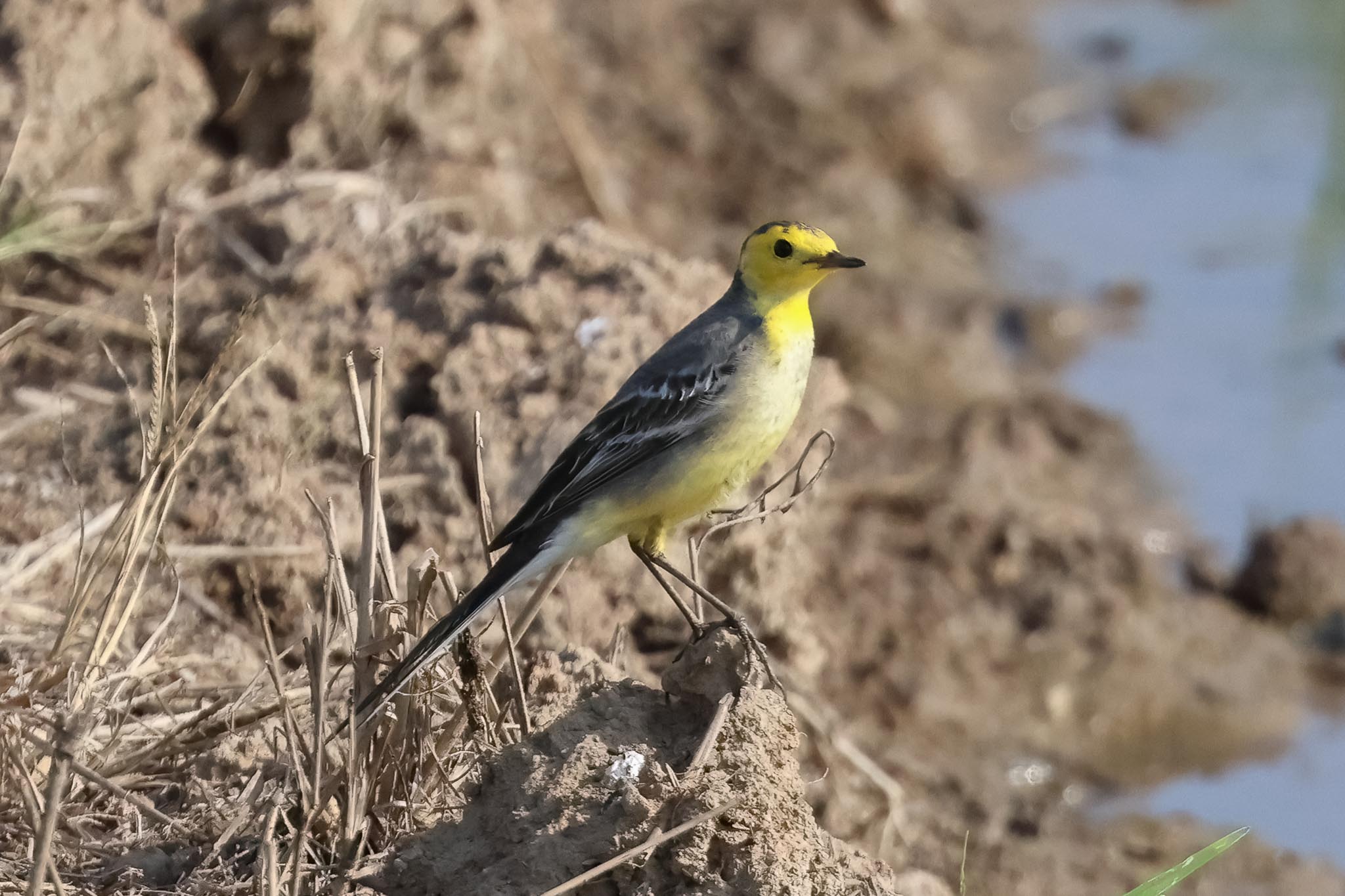
Carrying on, there were lots of Long-tailed and a few Brown Shrikes in the bushes and lots of Cattle and Intermediate Egrets in the wet fields. We stopped by an area of reeds to look for Yellow-breasted Bunting but it looked quiet at first, in the heat of the afternoon. We found some shade and scanned back and forth and after a while a single male flew up briefly but dropped back in, then two flew out but disappeared off, too brief to get everyone onto them, all very frustrating!
Scanning the ricefields the other side, there were lots of Wood Sandpipers and one or two Common Snipe, several Great White Egrets, a couple of Grey Herons and a single Purple Heron. There were lots of wagtails – plenty of White, at least nine Citrine and one or two Eastern Yellow Wagtails – and a female Bluethroat feeding on a bund. An Eastern Marsh Harrier was hunting over the fields further back.
Back in the minibus, we drove a short distance further down the track. There were lots of Baya Weavers in the reeds here, dropping down to feed in the maize crop in front and we started to pick up more Yellow-breasted Buntings further back now – a small flock dropped in, and from time to time one would perch up in view. They were mostly females/immatures and a bit distant but we had OK views in the scopes now and for a species listed as ‘Endangered’ we were just pleased to be able to see some. A further scan of the rice paddies here revealed two Rosy Pipits feeding on a muddy bund out in the middle, along with several Paddyfield Pipits, and a Common Sandpiper.
It was time to head back to the hotel now. As we drove back out along the track, we stopped briefly to look at a Black-crowned Night Heron in a tree. A flock of pipits in a drier field by the river channel turned out to be Olive-backed Pipits when we pulled up to check, and there were lots of Greater Coucals out now that the temperature was dropping and the light was starting to fade.
Tuesday 23rd January
It was another early start, meeting down in the restaurant for coffee again at 5.30am, before we headed back up to Doi Lang West to have another go for Mrs Hume’s Pheasant. When we got to the top, we were very relieved to see there was no one else there this morning, so we were able to get ourselves into a good position, further back than the hides had been yesterday. As it started to get light, the same birds appeared, and came down to feed – several Grey Bushchats, ten Olive-backed Pipits, a pair of Japanese Tits. The Rufous-gorgeted Flycatcher flitted around in the trees again and the male Ultramarine Flycatcher appeared briefly, but without any mealworms it didn’t linger.
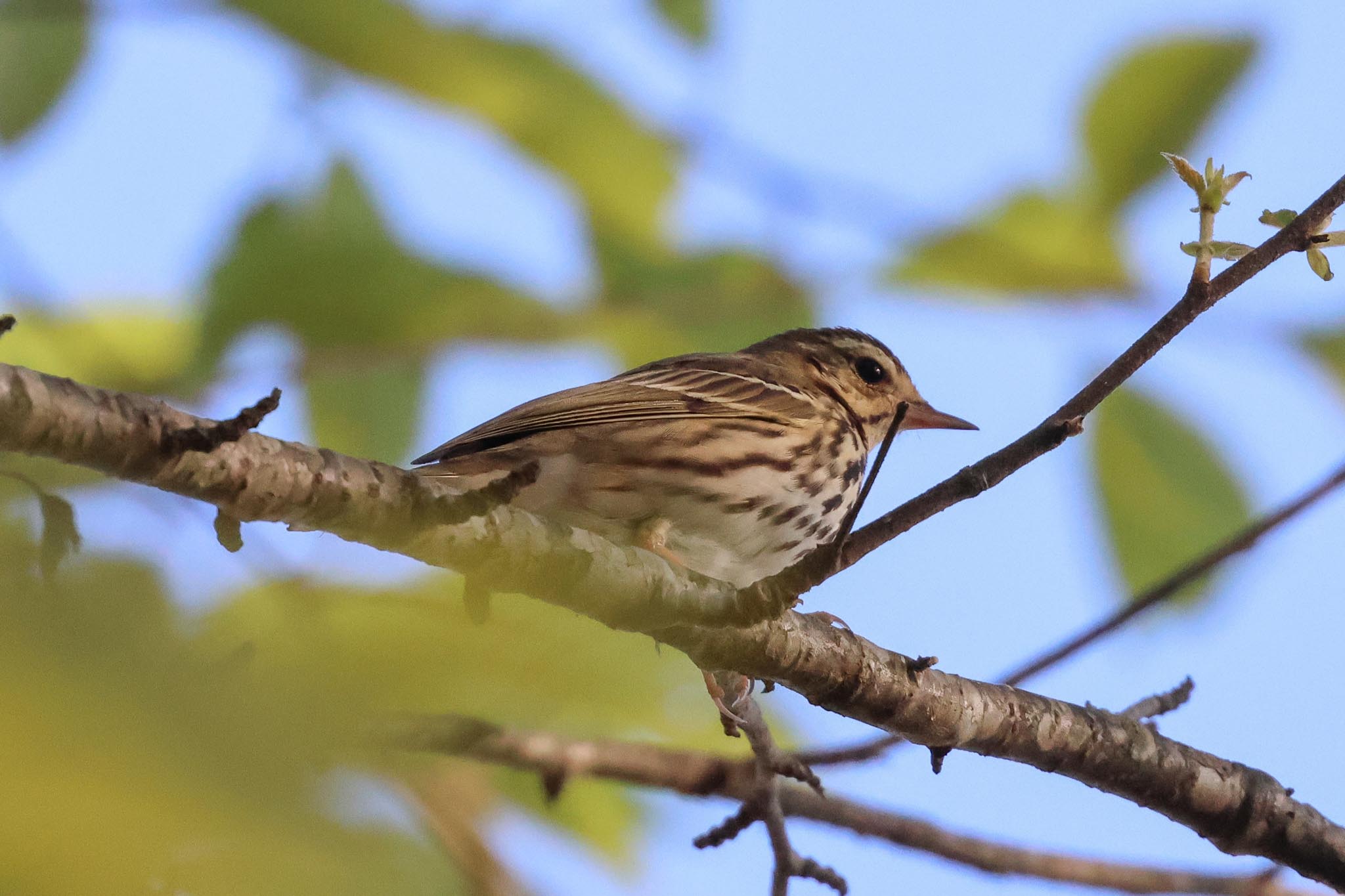
Two Rusty-cheeked Scimitar-babblers flew straight in and landed on the grass today, but four Oriental Turtle Doves flew in to the trees before dropping down to feed on the road further down. A Yellow-streaked Warbler and a Chinese Leaf Warbler flitted around in the gully on the other side of the road. Just at the time the pheasants have been appearing before yesterday, a couple more cars arrived. There was still no sign of the pheasants though – had they been disturbed just as they were planning to come out?
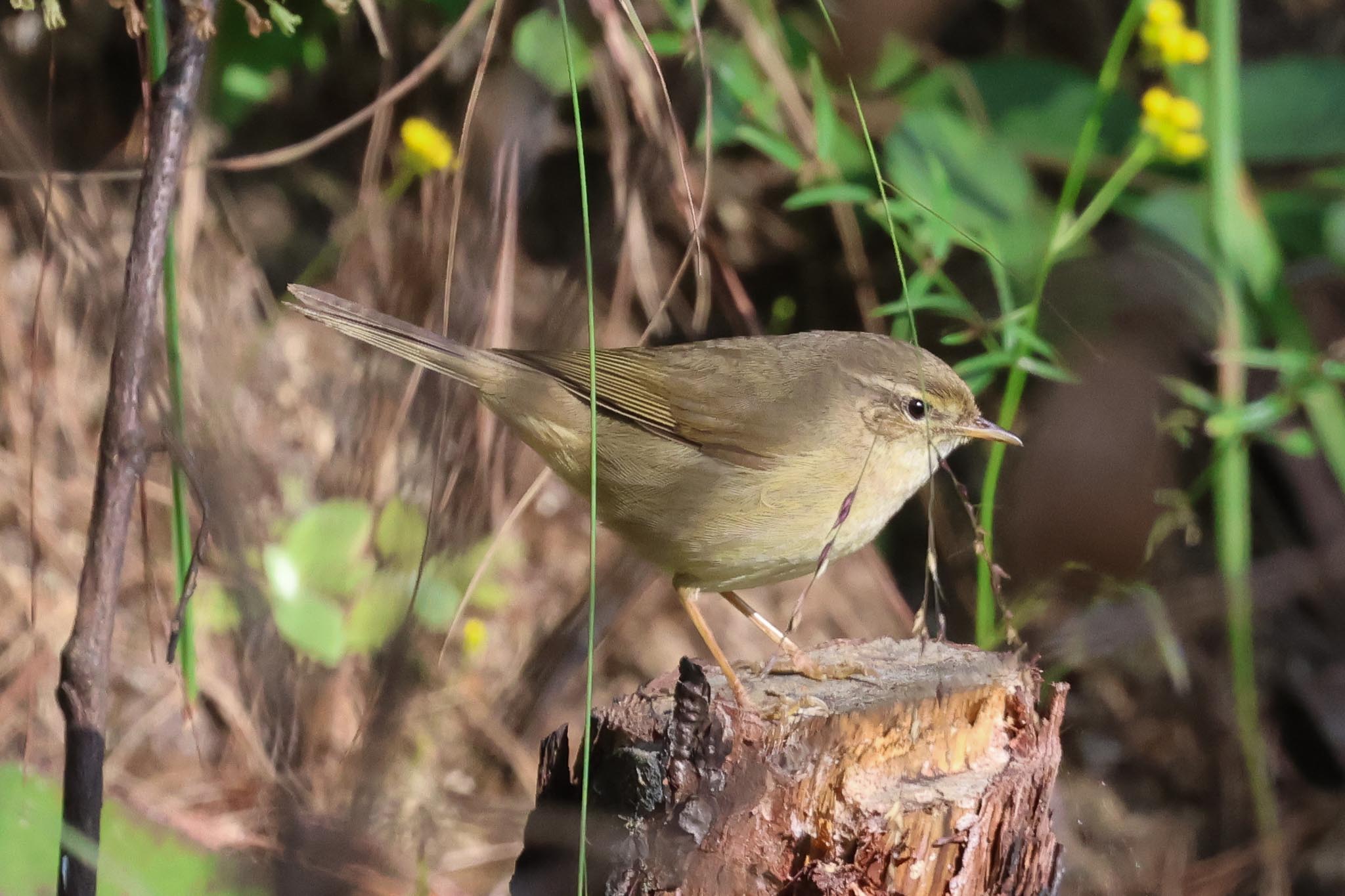
We had said we would only give it until 8am, but Nick spoke to a photographer he knew who was also there now, and he was told that although on most days they come out early, on one day recently the pheasants had not appeared until 8.30am. We waited another 15 minutes and it really felt like we were going to be out of luck again. We were just about to pack up when a female Mrs Hume’s Pheasant appeared out of the undergrowth and walked out onto the verge. Just in time! It was followed by several more females/immatures, five in total, and then finally the male crept out last, nervously. Stunning! We watched them out in the open, in much better light now, as they fed on the verge. After about half an hour, a motorbike came the other way down the road and the pheasants disappeared back in.

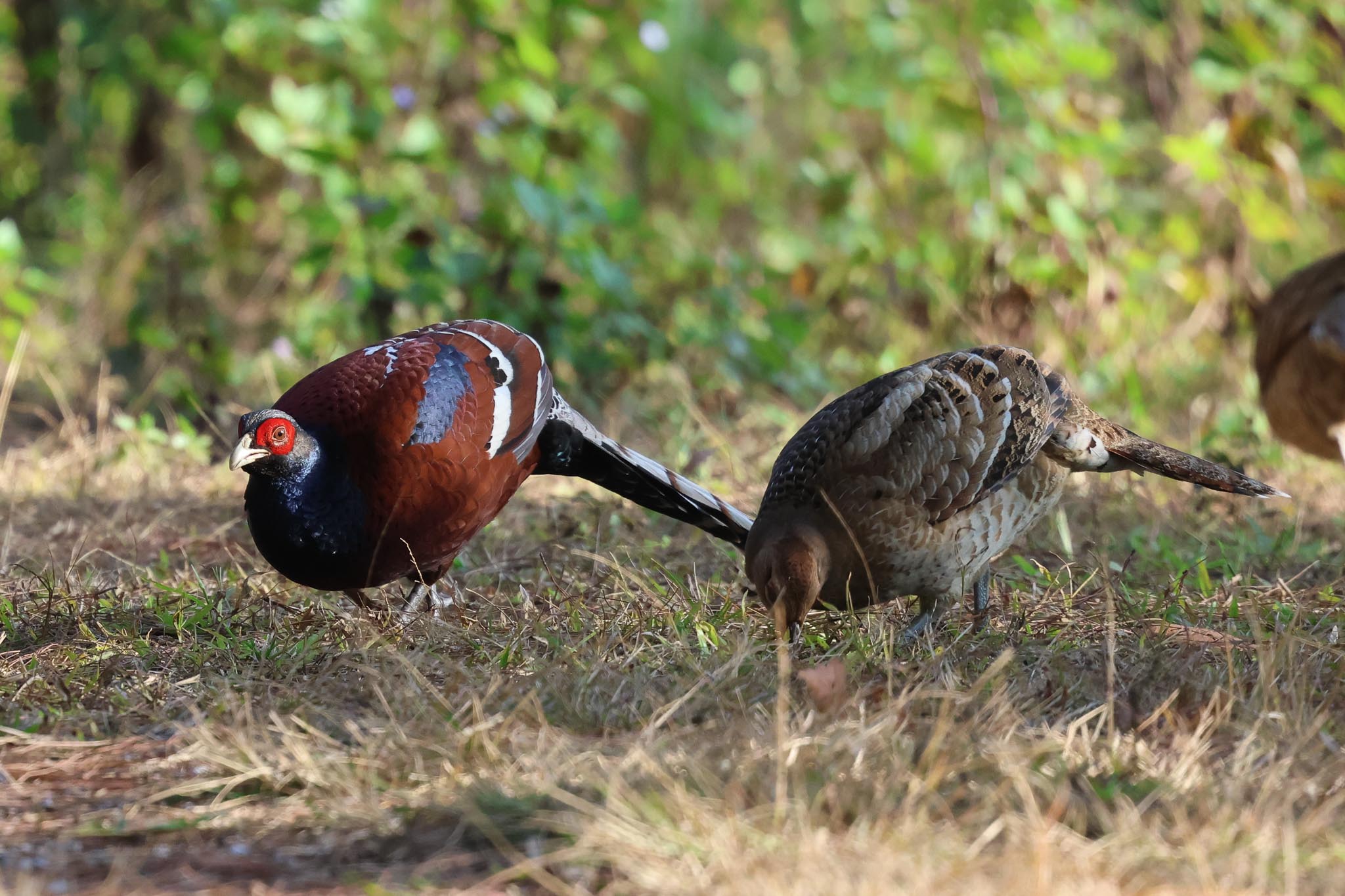
We drove a short way down the hill and stopped where the sun was on the trees. There were lots of birds flitting around above where we parked, lots of leaf warblers including several Pallas’s Warblers, a Little Pied Flycatcher calling, a couple of Blue-winged Minlas, and a Giant Nuthatch calling on a bare pine trunk. A little further down the road we found a pair of Black-backed Sibias in the bushes and watched a Chestnut-vented Nuthatch at its nest hole, trying to reduce the size of the entrance by plastering it with mud. An oriole was calling across the other side, but it was too deep in to see, and then a flock of Long-tailed Broadbills started calling, so we turned to finding them. Eventually they came into the trees nearer the road. A large flock of Chestnut-flanked White-eyes landed in the treetops further along.
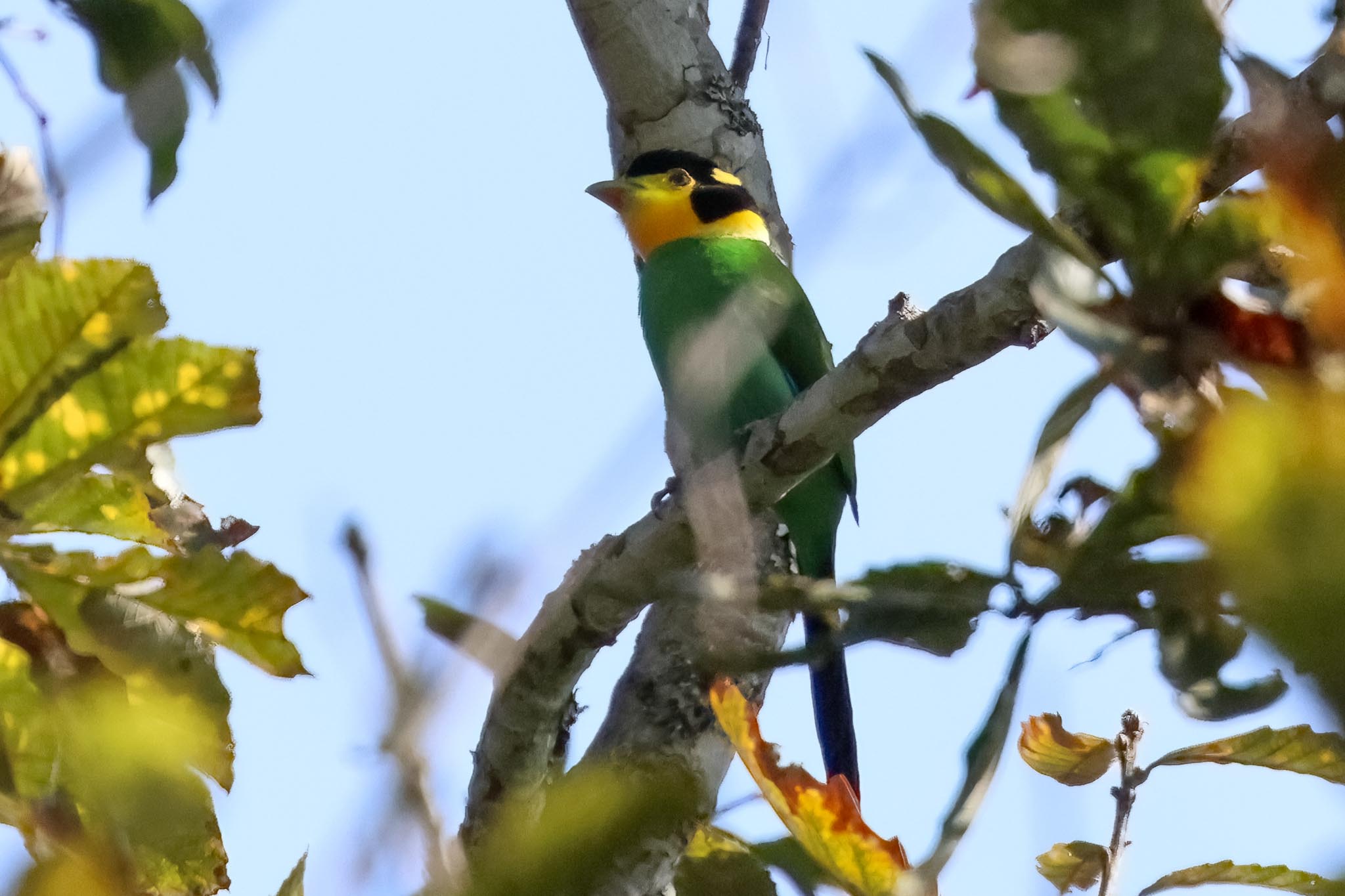
After about 10am, it seemed to go quiet here, so we drove back up to the regular shady spot. The flock of Yunnan Fulvettas had a Grey-throated Babbler with them now. The wintering White-spectacled Warbler had been seen again yesterday and apparently it often follows the fulvettas too, so we kept checking through the flock and before long it appeared right beside the road. A Martens’s Warbler was with it initially, just to cause confusion as they are rather similar, but eventually everyone got on the right bird, the White-spectacled Warbler sporting a much wider pale eye-ring which is noticeably broken at the top.

Walking back past the minibus, we found another large mixed flock in the trees – lots of minivets including Grey-chinned, Scarlet and Long-tailed Minivets, a pair of Grey-headed Flycatchers, a couple of Hume’s Treecreepers and lots of leaf warblers, mainly Claudia’s, Hume’s and Pallas’s, with a Davison’s Leaf Warbler singing right next to the road.
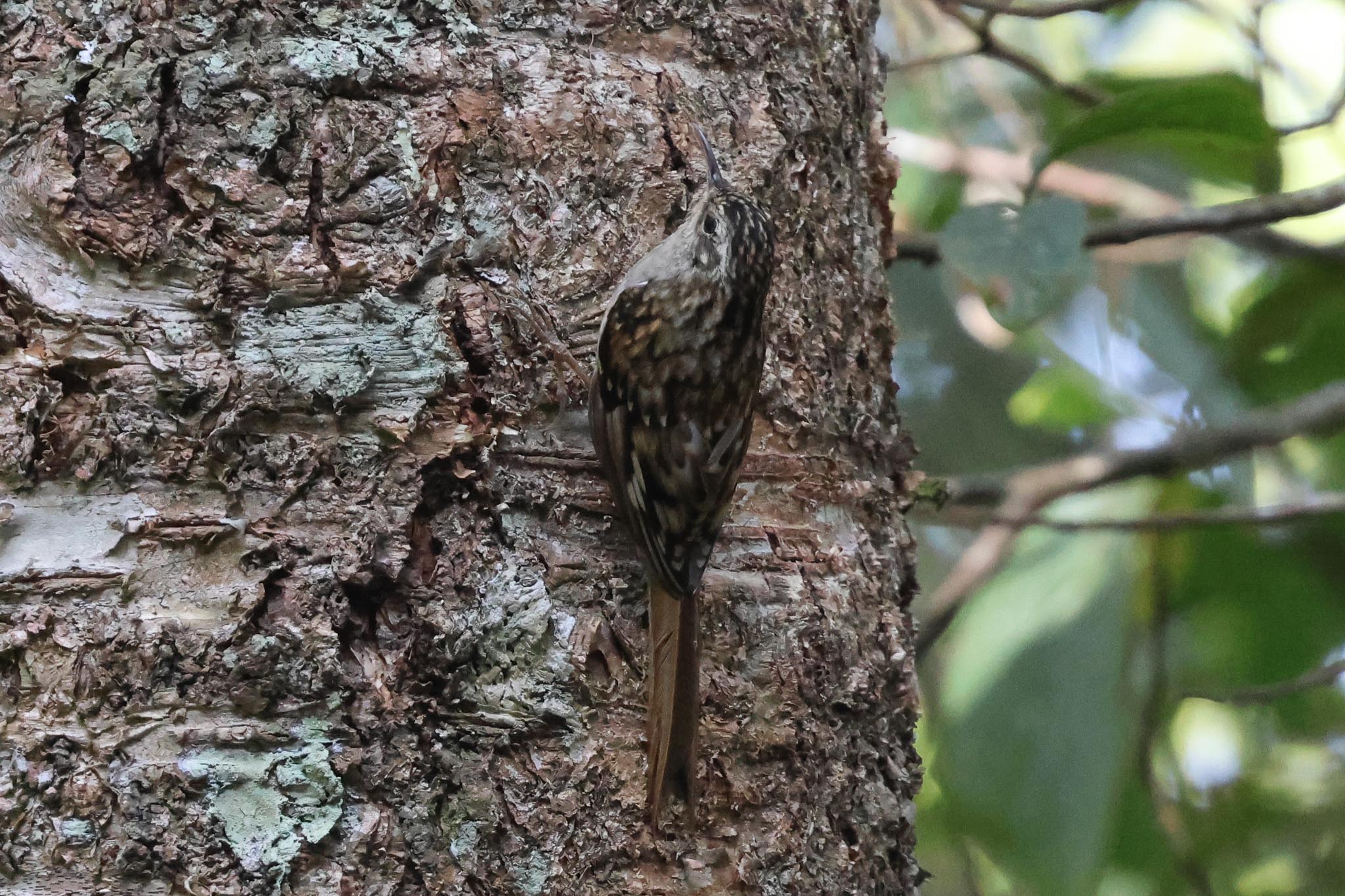
A male Hill Blue Flycatcher dropped down to feed on the tarmac, the male Rufous-bellied Niltava and the Indochinese Cuckooshrike appeared again, and the Sapphire Flycatcher flitted around over the road. When a White-throated Fantail started singing, we looked up to see it above our heads with its tail fanned. A Stripe-breasted Woodpecker appeared in the top of a tree above the road and a Yellow-browed Warbler called nearby.

A Maroon Oriole called initially from further in, but gradually started to make its way closer to the road, and now we could see the pair, the male singing and displaying to female.

We walked back to the minibus for an early packed lunch, and as we had been on our feet most of the morning a chance to so sit down. As we finished our fried rice, the flock of Fulvettas came back through – the White-spectacled Warbler was still with them and a Golden Babbler as well this time, and as we followed them along the road, we had brief views of a White-browed Scimitar-babbler in the undergrowth too.
We had spent quite a bit of time here, so we decided we needed a change of scene, and drove a little further on before we stopped in another different shady area of trees, towards the bottom of quite a steep hill. We walked up a short way and could hear birds alarm calling in the trees. Scanning above our heads, we found a Crimson-breasted Woodpecker up in the branches, now treated as a separate species, Necklaced Woodpecker, by some authorities, rare here and confined to the extreme NW of Thailand so a good bird to see.

As we walked back down past minibus, we could hear more woodpeckers calling and found a pair of Stripe-breasted in one bare tree, then a Grey-capped in another close by.

A group of Large Woodshrikes appeared, along with a couple of Crested Finchbills, and we could hear a Grey Treepie calling.

We returned to the spot where we had seen the Spot-breasted Parrotbill next. It was early afternoon now, so not an ideal time, but we scanned the tops of the trees and picked up a Banded Bay Cuckoo which flew in and landed high up, behind a tangle of branches. It flew again, and came much closer, landing right above the road briefly where it was much easier to get on. A Crested Serpent Eagle circled up again overhead before drifting out of view, and when a raptor appeared again in the same place it turned out to be a Mountain Hawk Eagle, before it disappeared behind the trees on the top of the hill.
We were heading back to the ricefields this afternoon, so it was time to drive down now. On our way, we stopped briefly at the hotel in Fang to drop off those who preferred a couple of hours to rest and relax, then carried on north towards Thaton again. We drove in along a different track and parked, getting out to scan the wet paddies on one side – we quickly located a female Citrine Wagtail, and a Green Sandpiper flew up calling. The other side of the track, by the river, a Richard’s Pipit was running around in a nearby field which was being irrigated, along with a Little Ringed Plover. We picked up a distant male Pied Harrier quartering the back of the ricefields before it dropped down out of view.

Walking down along the track, a pair of Zebra Doves flew up ahead of us, a flock of Chestnut-tailed Starlings was in some nearby trees and the prize for the most bizarre sighting went to a white Cockatiel which flew in and landed above the track. Very strange to see out here, but as an escapee, it doesn’t count! Two female Long-tailed Minivets flew over too, a large flock of Red Collared Doves was feeding in the grass nearby and a pair of Plain Prinias flitted around in the vegetation in the ditch below the track. Scanning the vegetation along the side of the river, we found a single rather distant Yellow-breasted Bunting in some low mimosa trees.
We carried on a bit further, until we could see over to the reeds where we had looked from the other side of the river yesterday and where we had seen the Yellow-breasted Buntings distantly. It was better light from here, we were a bit closer too and we could see several perched up now. We were just scanning across, trying to count them, when we picked up a bushchat in the reeds. We had discussed yesterday that this looked like ideal habitat for Jerdon’s Bushchat and now we were indeed looking at one, a female. This is a very scarce and localised species in Thailand, so a great find here.
When it dropped down out of view, we walked on and turned onto a track down through the fields to get closer to the edge of the river. Unfortunately, we had gone too far on now to see the reeds where the bushchat had been, but we were closer to the Yellow-breasted Buntings and had great views of them through the scopes in the scrubby bushes on the opposite bank, admiring the variety of different plumages, including one or two smarter winter males. We could see twenty in view together at one point, but then they started to fly out in groups and we counted at least fifty, and there were still several perched in the bushes. Given that they are classified as ‘Endangered’, it was really great to see good numbers here.
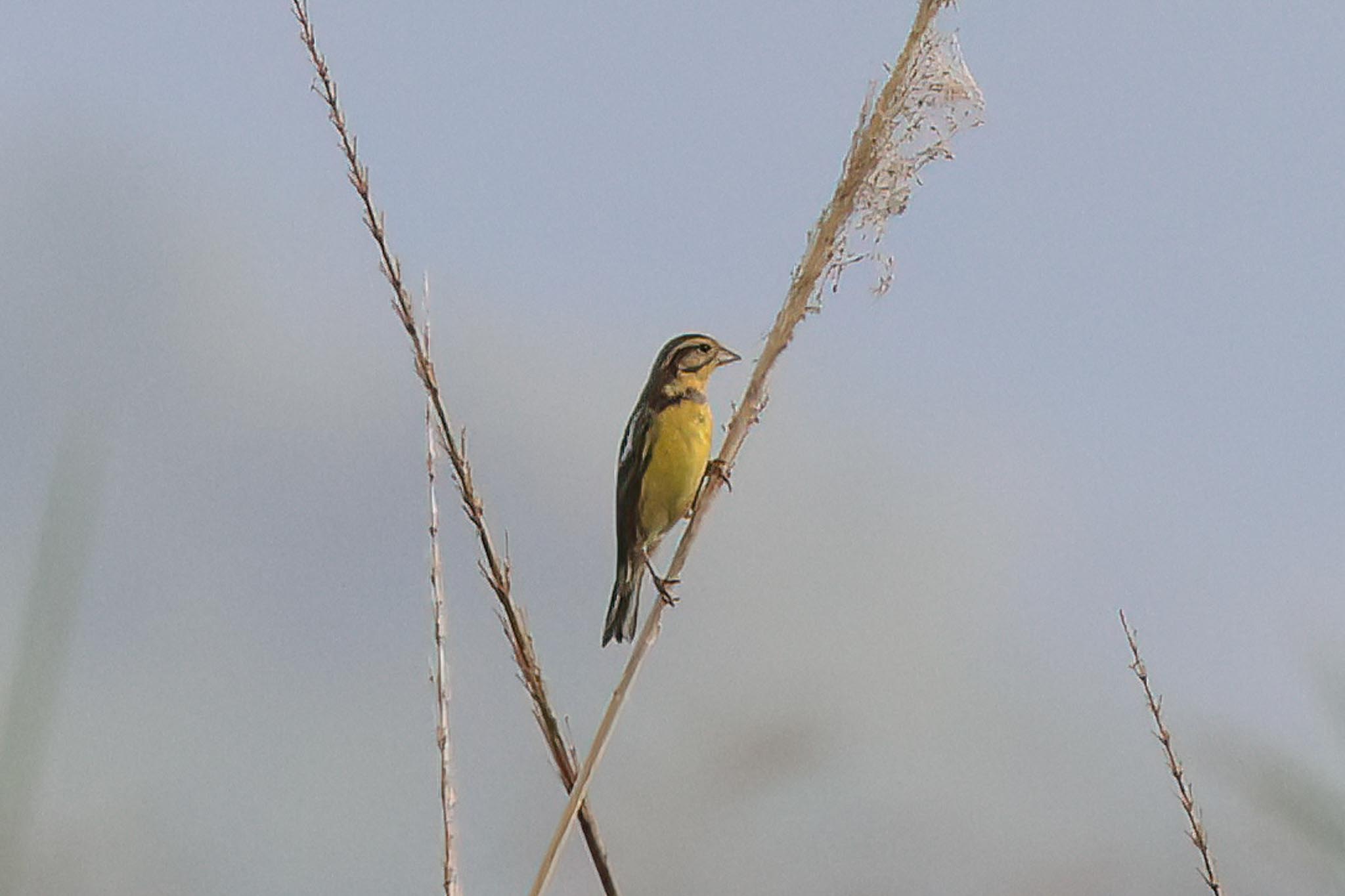
There was a Long-tailed Shrike in the reeds opposite too, and four Common Snipe bathing on a mudbank down in the river along with a Common Sandpiper. Several swallows were flying round over the fields – including Barn, Asian Red-rumped and Striated – and a few Germain’s Swiftlets flew overhead. Two Black-crowned Night Herons flew past over the fields the other side.

As we walked back towards the minibus, a Racket-tailed Treepie was in the trees by the track now, where the starling flock was still feeding. An Oriental Reed Warbler appeared briefly in the reeds in the ditch, along with a Taiga Flycatcher. We walked past the bus and up onto the riverbank behind, past a small herd of cows which were just being gathered and tethered for the night. As we got up onto the bank, a Striated Grassbird flew back away over the river and landed out of view in some reeds the other side. It then flew again but disappeared down along the river, before flying back, giving us all some nice flight views now, but dropping down behind a strip of maize on the far bank out of view. We stopped and scanned but it didn’t come out again. A constant stream of egrets was flying past now, heading in to roost, landing in a large copse of trees beyond. Back at the minibus again, a Coppersmith Barbet was calling, and we looked over to see it perched in the top of some bamboo. Back to the hotel, we had time for a short break before dinner.
Wednesday 24th January
It was going to be mainly a travel day today, so we packed up and met for breakfast in the restaurant at the hotel at 6am. We had some time for birding this morning before we moved on, so we drove the short distance over to Fang Hot Springs. There were several Coppersmith Barbets and a single Lineated Barbet in the trees above the car park when we arrived, along with an Ashy Drongo. A Greater Racket-tailed Drongo was calling, and as we walked out across the grass opposite we found two perched in the treetops there. An Asian Barred Owlet was calling too, and we located it up in a nearby tree.
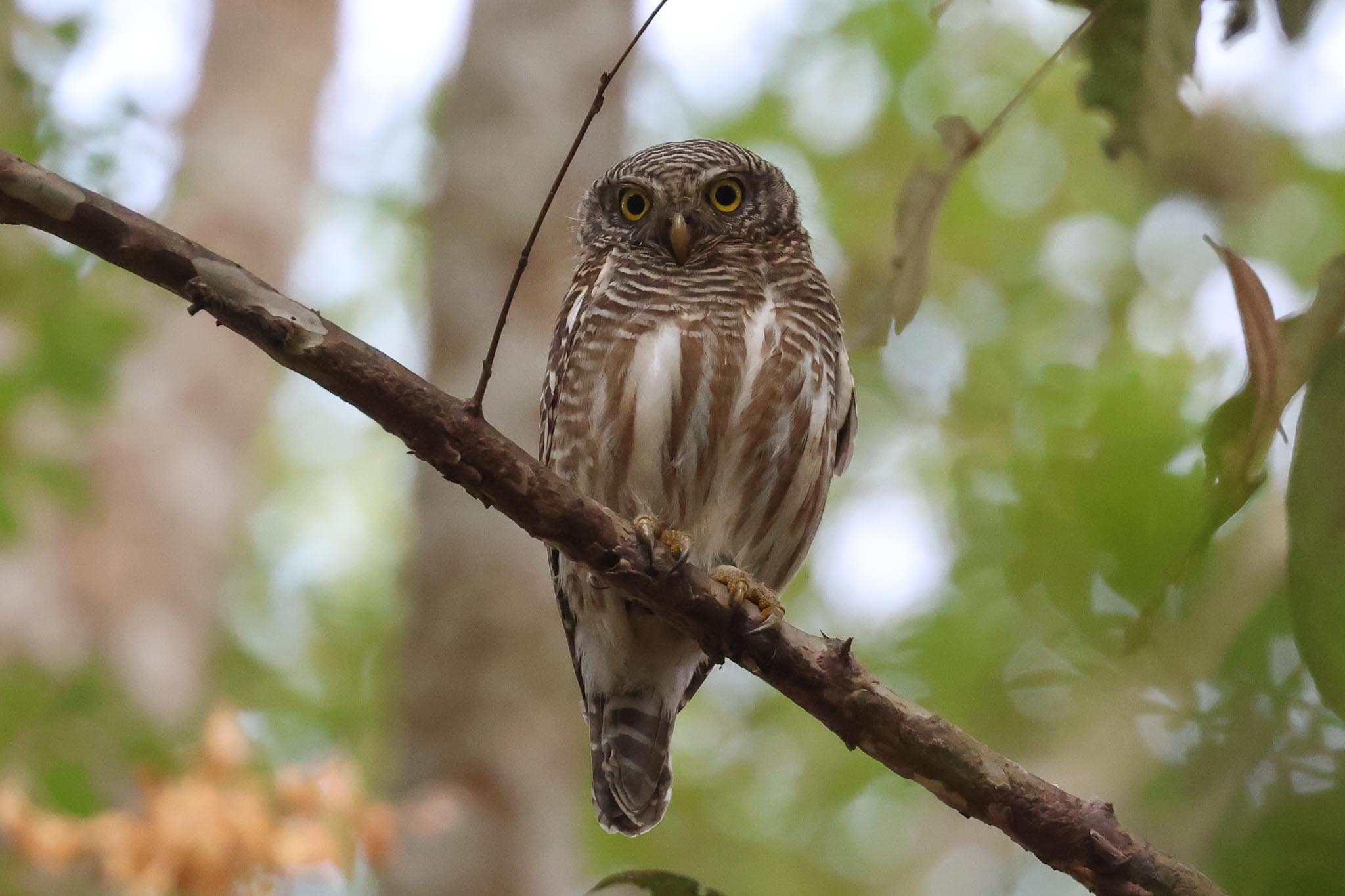
One of the group had wandered down to the nearby pool and saw a Great Barbet flying across in the distance beyond, so when it flew again and landed in the top of a tree, we got it in the scopes, where it was joined by several more Lineated Barbets. A few Thick-billed Pigeons and Hair-crested Drongos were even more distantly in the trees behind. Then we found more Thick-billed Pigeons in a fruiting tree a bit closer, along with a selection of more barbets which included a Blue-throated Barbet, and lots of Black-crested Bulbuls. A White-breasted Waterhen walked up the far bank of the pool.
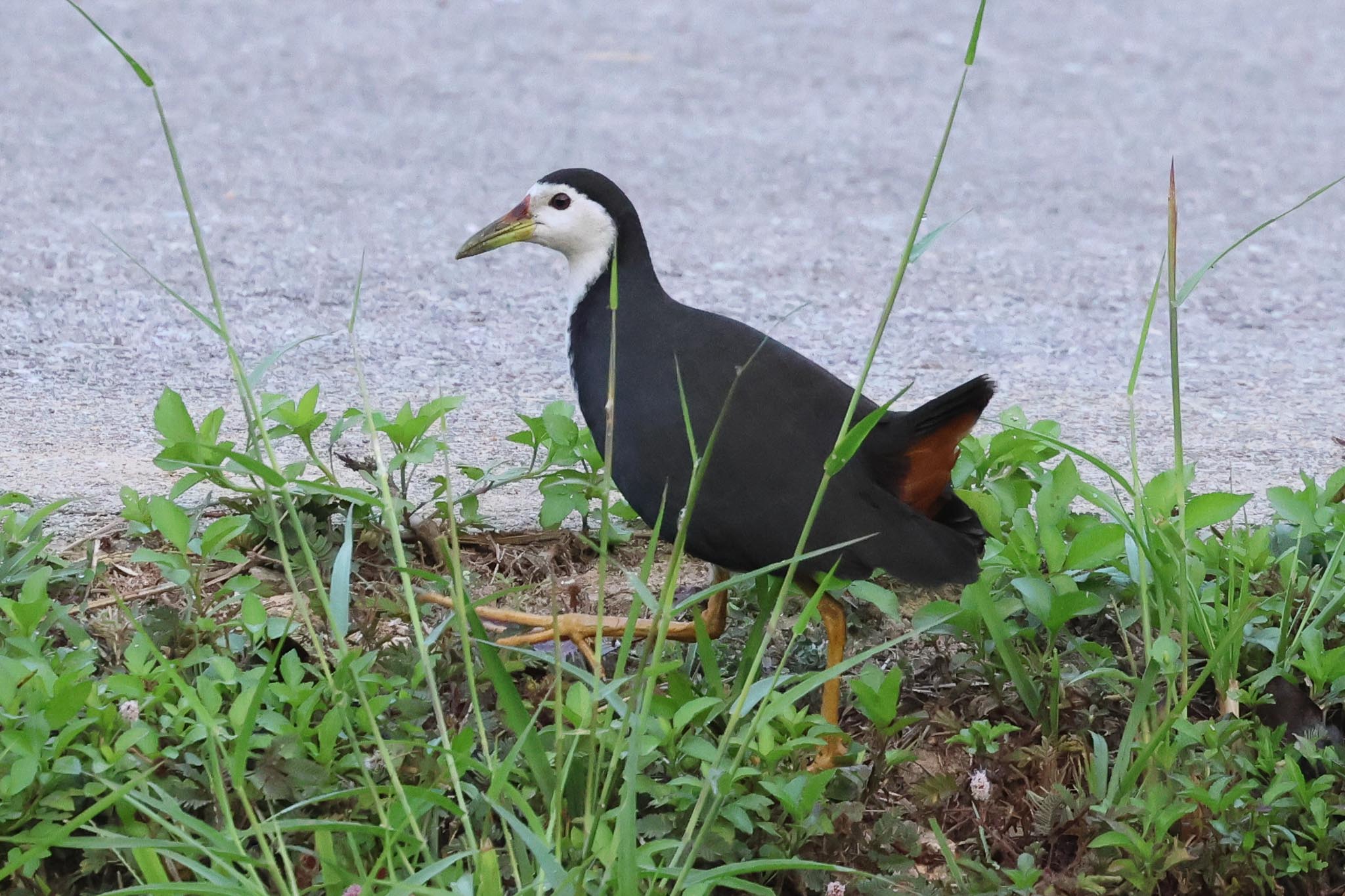
Back to the road, we walked down through the avenue of trees, finding a flock of Long-tailed Minivets, and with them several Rosy Minivets and a single Brown-rumped Minivet too. A couple of Eurasian (or White-faced) Jays flew off ahead of us and a Pallas’s Squirrel was feeding on a pine cone up in the branches. Down to the springs themselves, we had been hoping to find the regular flock of Spot-winged Grosbeaks in the trees here but there was no sign of them.
We waited to see if they might come in and scanned the trees hillside above to see if they had gathered there. There were lots of Barn Swallows hawking over the grass and a small flock of Himalayan Swiftlets came in overhead. A female Shikra landed in a tree beyond, followed by a Black-naped Oriole. A couple of Grey Wagtails were feeding around the small pools. There was no sign of the grosbeaks though – perhaps, given the unseasonably warm weather this year, they had dispersed already. We took the path across through the middle of the springs and looking back, Nick picked up a flock of about twenty finches very high over the hillside now. We hoped for a second that they might be the grosbeaks coming in, but when they landed in the trees we could see they were actually Common Rosefinches. A distant Black-hooded Oriole appeared too.

A Blue Whistling Thrush had been whistling all the time we had been here but we hadn’t been able to see it until now, when came it flew into the trees right in front of us, and gave good views. An Olive-backed Pipit flew up into the trees too, along with a singing Oriental Magpie Robin. Back out onto the road, as we walked back up towards the parking area there were lots of bulbuls in the trees, along with a couple of Taiga Flycatchers and a Common Tailorbird, and a White-rumped Shama was on some rocks nearby. Back at the minibus, a Blue-eared Barbet appeared in the trees beyond.
We set off now on the long journey to our next stop at Doi Inthanon, but before we got out of Fang we had a quick stop to look round one of the local temples, Wat Si Mongkol. We admired the painted and gilded buildings and what is claimed to be the oldest teak buddha in Thailand. A couple of the group tried the fortune sticks in the temple – worryingly we had very mixed fortunes predicted! We stopped again for lunch at a roadside restaurant near Chiang Mai, where most of us tried a delicious local noodle dish – so much better than roadside food back home. It was then mid-afternoon when we finally arrived at our hotel just outside Doi Inthanon National Park.
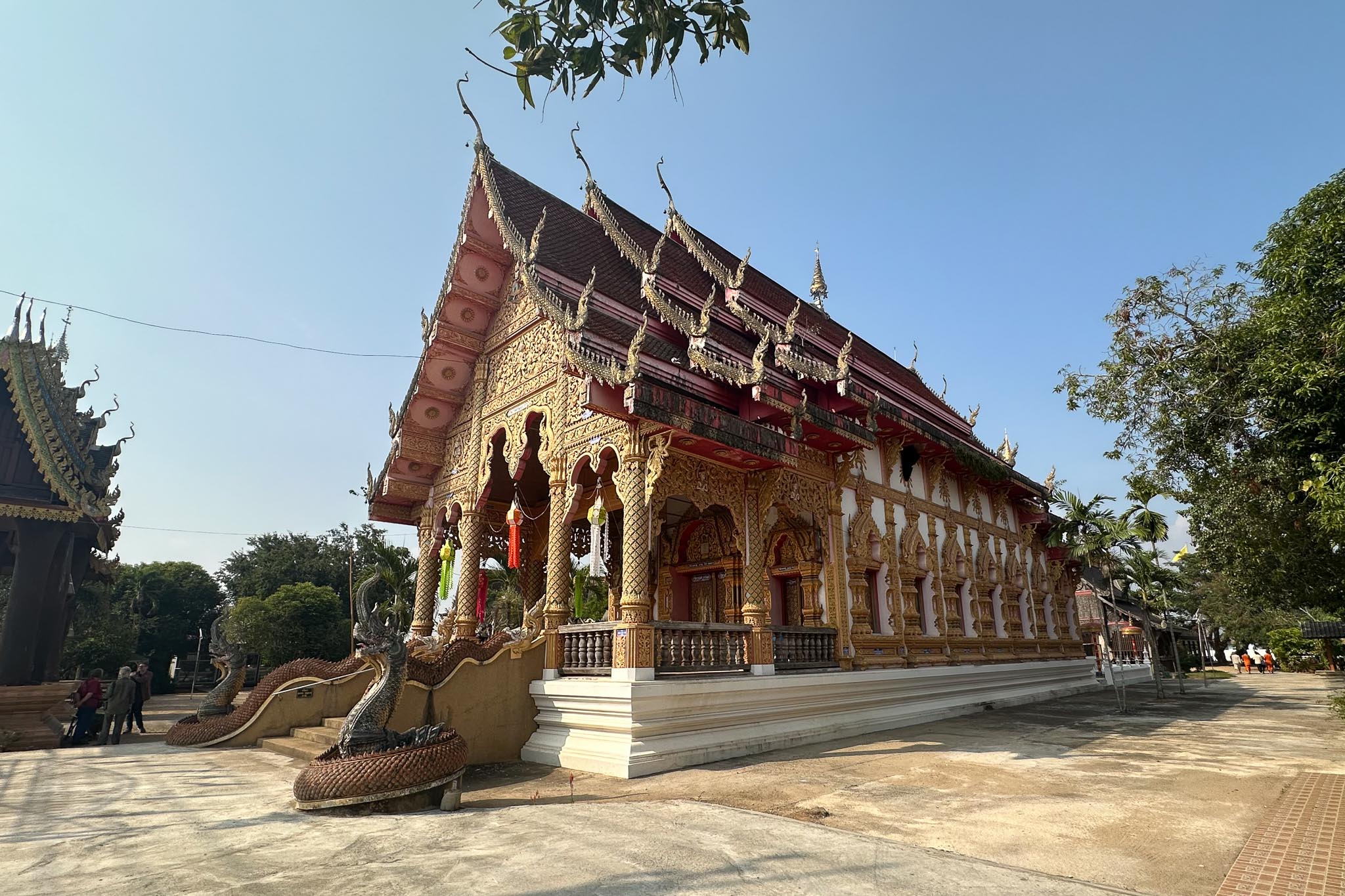
After a short break to get settled in, we got back in the minibus for a very short drive to a nearby site to look for Blossom-headed Parakeets. We parked on the edge of a track, where the flowering tree above had several Purple Sunbirds coming and going, and as we walked down, we heard Blossom-headed Parakeet call and looked up to see one shoot past over the treetops.
There was a viewing tower in front of the house at the end of the track and the owner came out with his young daughter and led us up to top. We had an excellent view over the surrounding trees from here and it was not long before the Blossom-headed Parakeets started to come in – first a grey-headed female, then a pink-headed male landed closer briefly, then several perched up further back and stayed long enough for us to get them in the scopes. Several more parakeets zipped through without stopping.
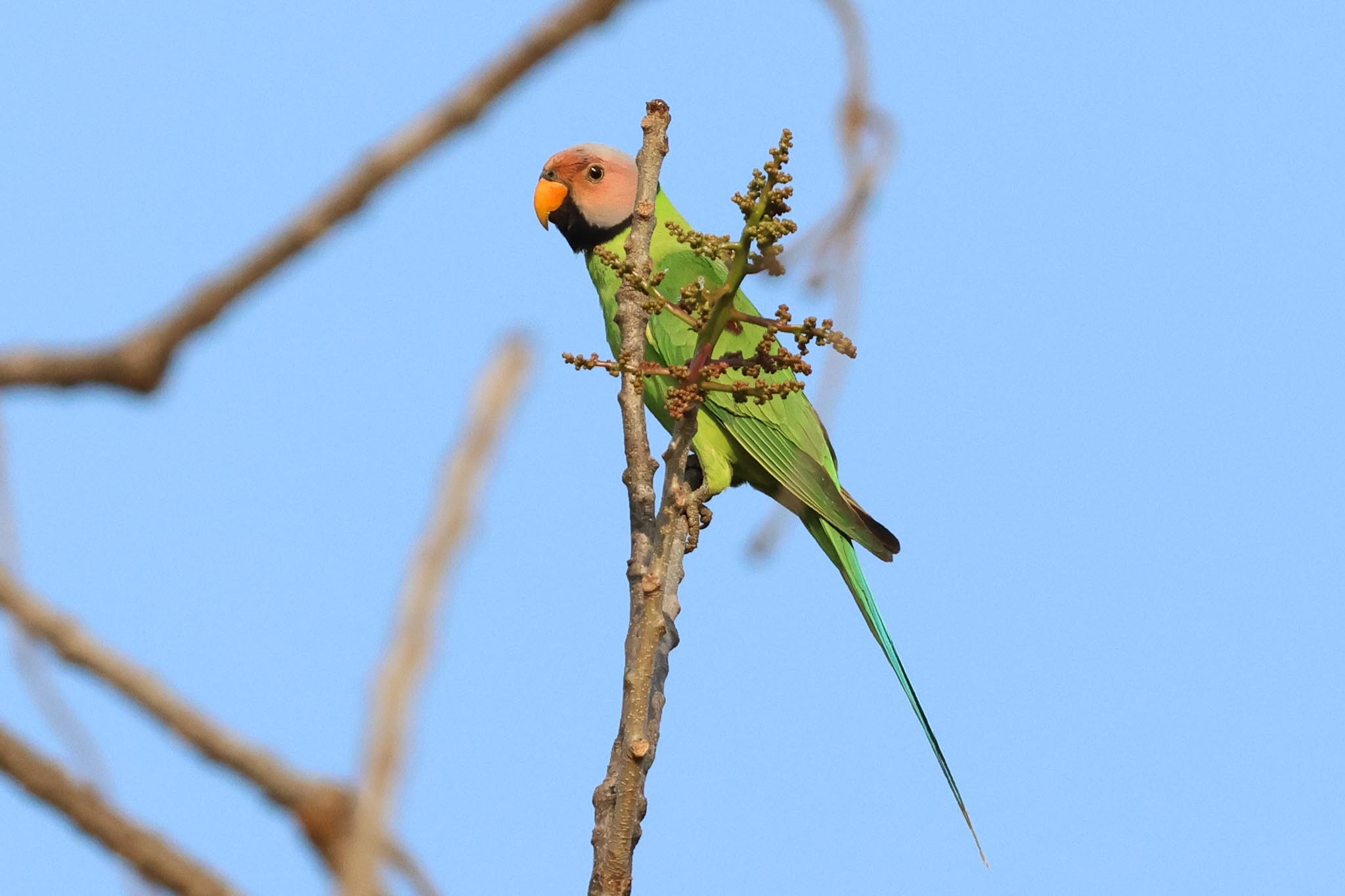
There was an Asian Brown Flycatcher flitting around in the branches nearby too, and Green-billed Malkoha and Asian Koel in the trees behind us. A couple of the group had a glimpse of a male Green Peafowl through the trees walking down through the thick undergrowth on the slope, but it disappeared behind some bamboo. We climbed down from the tower and walked further down, but there was no further sign of it and it seemed like it had probably gone back up the slope.
Back to our hotel, we walked into the grounds of the former resort opposite as dusk was just starting to descend. We were looking for Spotted Owlet and heard one call a couple of times, but it was still too light at first. An Indochinese Roller was perched on the wires briefly, a Grey-headed Canary-Flycatcher was in the trees and a flock of White-crested Laughingthrushes flew across the road. As it was starting to get dark, the Spotted Owlet finally emerged from under the roof of an abandoned house. It flew straight back into the trees at first, but then thankfully reappeared above the road where we had good views of it in the scopes. A Brown Boobook had been calling deeper in the trees and now it flew out and landed nearby where we could get it in the scopes too. We could see its tail and head dipping as it called, it was obviously needing lots of effort. We walked quickly back across the road to our hotel now, and there was only time for a short break before we met for dinner.
Thursday 25th January
We met for breakfast at 6am again and then drove the short distance up into the National Park. After getting our tickets at the entrance, we stopped again a bit further on at the junction with a small side road. There was a bridge over the river here where we were hoping to find Black-backed Forktail, so we walked over very quietly to scan up- and downstream but there was no sign of them, perhaps because there was a constant stream of vehicles passing over the bridge this morning. We did find a Black-capped Kingfisher perched further up, and a couple of Grey Wagtails, and as we walked back to the minibus a couple of Brown-rumped Minivets and a Rosy Minivet were in the trees on the other side of the road.
We drove on higher and stopped again at the start of a small track. A Mountain Tailorbird was flitting around in the bushes next to where we parked and although we could head Spectacled Barwing we couldn’t see it. There were lots of birds in the trees higher up, a mixed flock including our first Rufous-backed Sibias, White-bellied Epornis, Yellow-bellied Fairy-Fantail and Yellow-cheeked Tits, plus Black-throated Sunbird, Grey-chinned Minivet, Speckled Piculet, Silver-eared Mesias and Blue-winged Minlas. We could hear Clicking Shrike-Babbler calling now and as it moved through the trees and back further down the track we tried to follow it. The Spectacled Barwings were easy to see in the bushes by the track now, and we had nice views of them moving through the low vegetation, and the Clicking Shrike-Babbler eventually showed itself in the tops of the trees opposite.
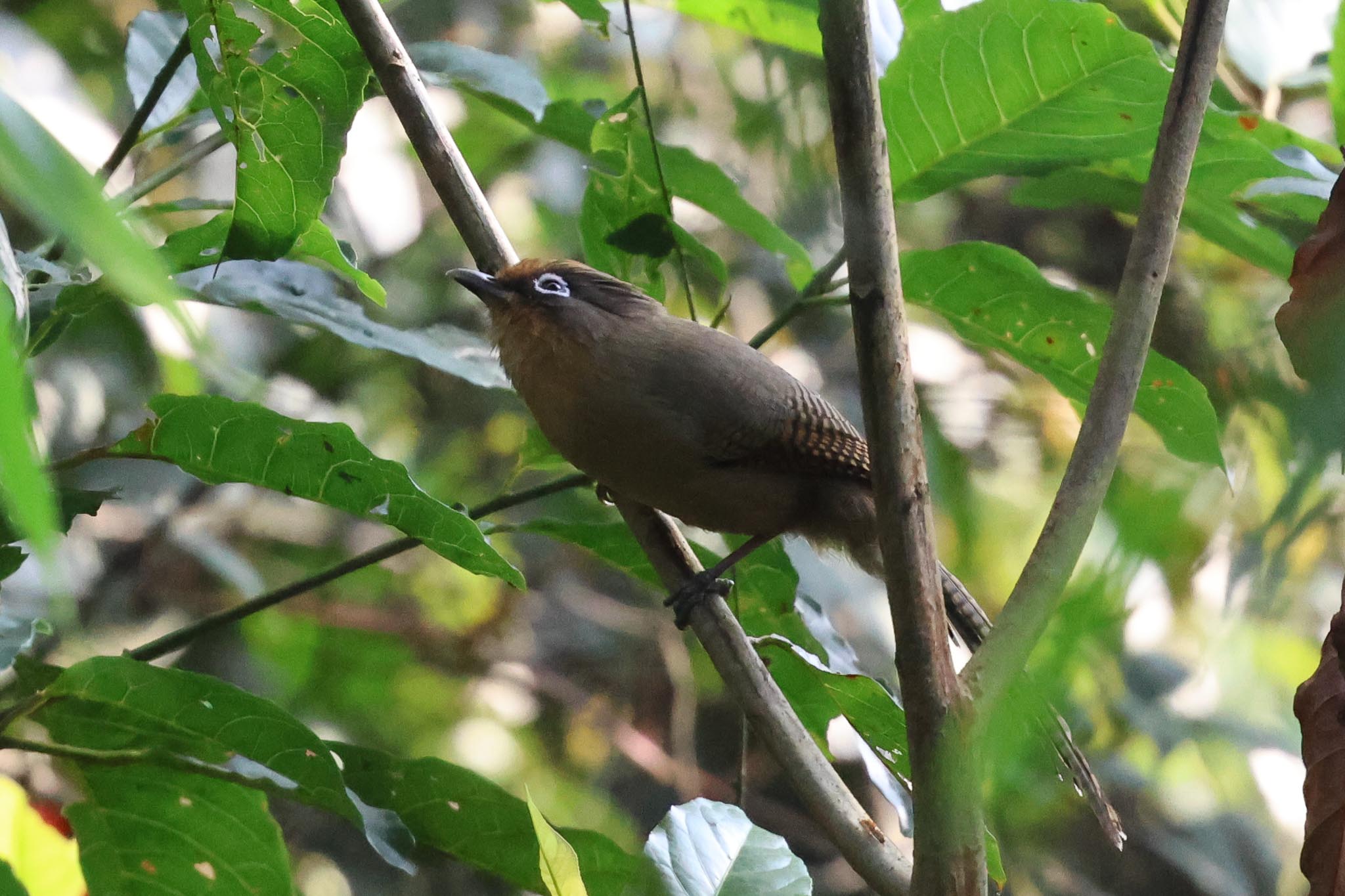
As the flock moved deeper in, we walked on further up the track. It was much quieter along here now – the birds are often all or nothing here – until we found a mixed flock of bulbuls in the trees, including several Ashy Bulbuls. We turned onto a narrow side path, which dropped down a steep slope into a damp gully. We could hear Slaty-bellied Tesias calling, but they were hard to see in the dark undergrowth at first before they eventually showed well, hopping up and down on the vertical stems of the plants on the forest floor opposite. A White-gorgeted Flycatcher was flicking round low in the bushes below us and two Himalayan Shortwings appeared on the ground nearby, first a female and then a young male with a small white brow.
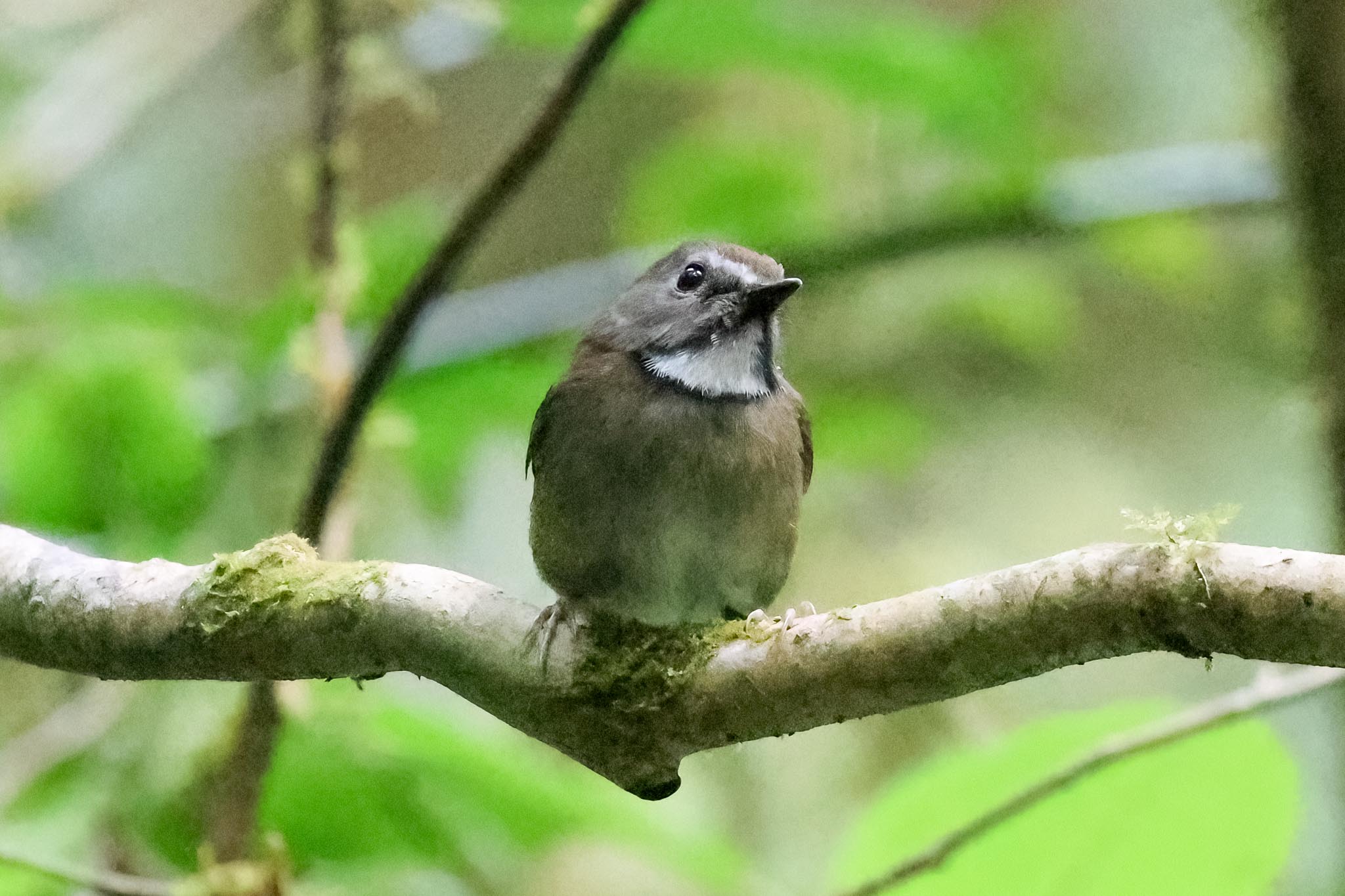
A male Large Niltava called several times from higher up the valley behind and eventually dropped down into trees right above us. Back on the main track, we carried on further. A Crested Goshawk flew low through the tops of the trees displaying, its white undertail coverts flagged. When we got to a barrier and couldn’t go further, we turned to head back, getting better views of a pair of Yellow-cheeked Tits on the way.

We drove on higher and stopped again. As we walked down the road, we could hear Grey-headed Parrotbills calling and they flew across ahead of us, landing in the top of a tree the other side where we could just see them in leaves. Unfortunately they flew again before they showed themselves properly and disappeared off downhill. There were lots more birds in the trees here now, lots of Claudia’s Leaf Warblers, a White-throated Fantail, Gould’s Sunbirds and a single Fire-breasted Flowerpecker above our heads.
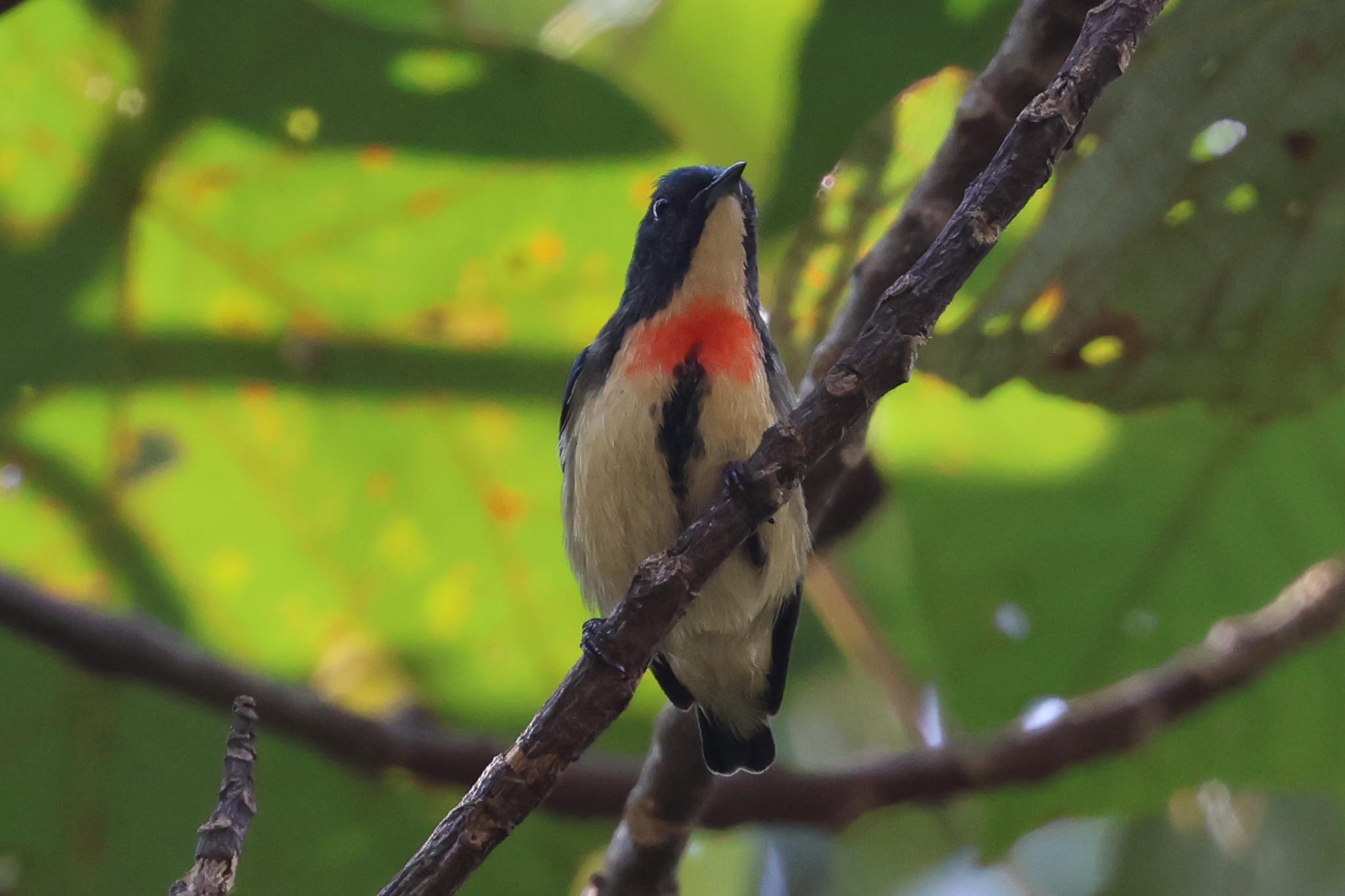
Then further along, as Nick whistled Collared Owlet, one responded from somewhere in the trees above the road. It flew in closer and we could see a big group of birds mobbing it, but the owl had landed in the thickest leaves it could find, out of view. Then it flew again, across the road and continued much further down the slope where we had no chance of seeing it. It appeared our opportunity had gone, but then it seemed to move back up towards the road again. We found a gap in the trees where we could see further down but all we found was an Asian Emerald Cuckoo and two Black-winged Cuckooshrikes. When the Collared Owlet flew again, this time it landed close to the road, and finally we found a place from where we could see it perched calling. Eventually it flew and disappeared again and a Streaked Spiderhunter, which had been mobbing it, flew out past us.

We moved on to a café where we would be having lunch now, situated by a small stream. There were several cars already in the small parking area directly in front, so we had to park higher up and walk down, which turned out to be a good thing. As we got out, we noticed lots of bulbuls feeding in some fruiting trees on the hillside a little further up and two Black Bulbuls in the top of a dead tree nearby. We figured we would come back and have a longer explore here afterwards.
We had a look at the stream behind the café first, where we found a very obliging White-capped Redstart perched on the rocks, and a female Plumbeous Redstart which was a bit more nervous, only flying out onto the rocks briefly and flashing its white tail, before darting back in. There was no sign of the Slaty-backed Forktail we were hoping to find here though – there had been a few other people looking up and down the stream too when we arrived, and it had probably been disturbed.
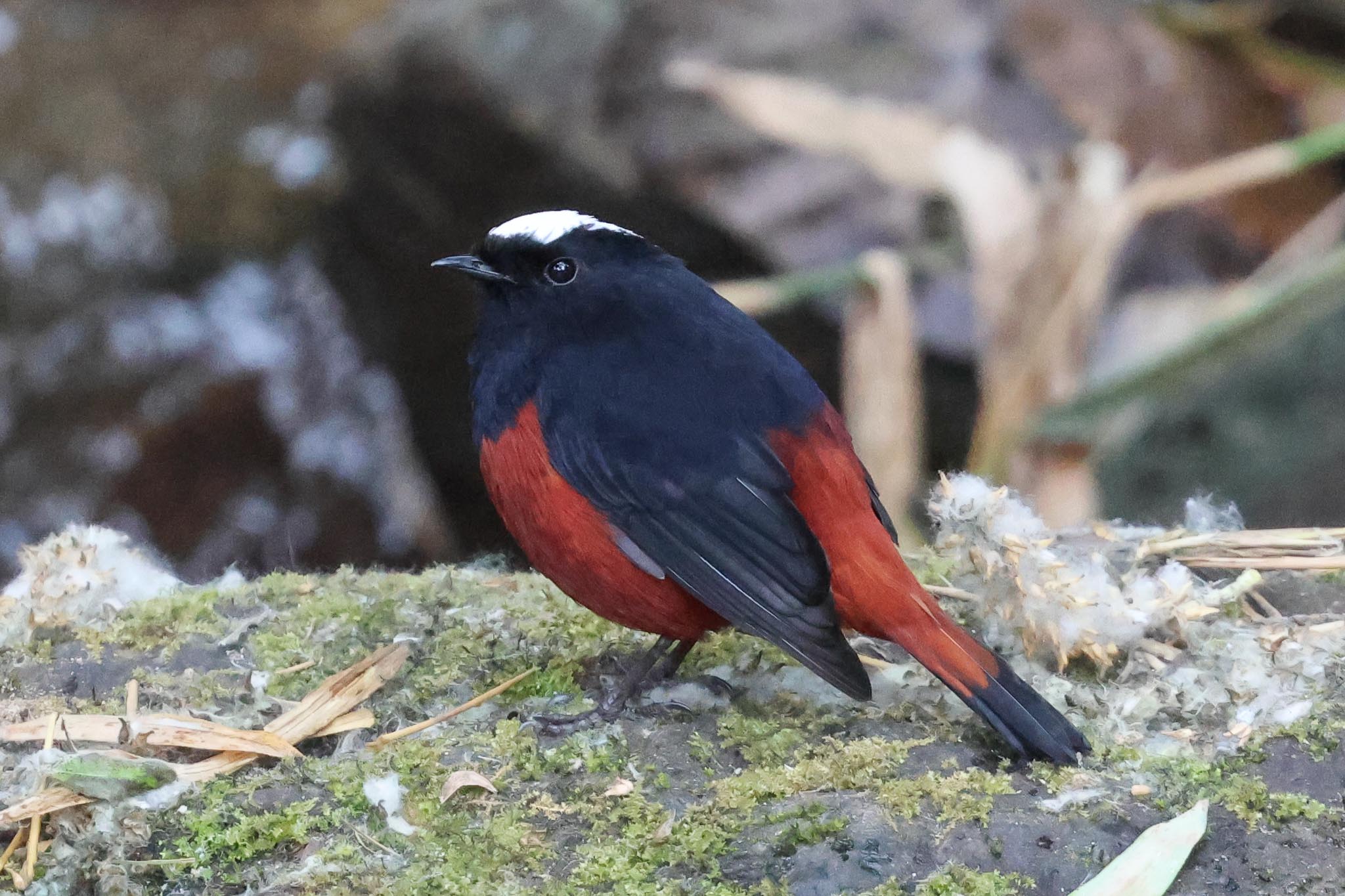
Once the other people had left, and while the group ordered lunch, the Slaty-backed Forktail reappeared back along the stream. It was still very nervous though and before everyone could gather, it flew off again. We had some more brief views before lunch, but it would fly off as soon as it saw people and not all the group had seen it before the food arrived. After lunch, it was much quieter, and we managed to track it down to a shady part of the stream where we could view from a distance without disturbing it. We all had some nice views of it here now.
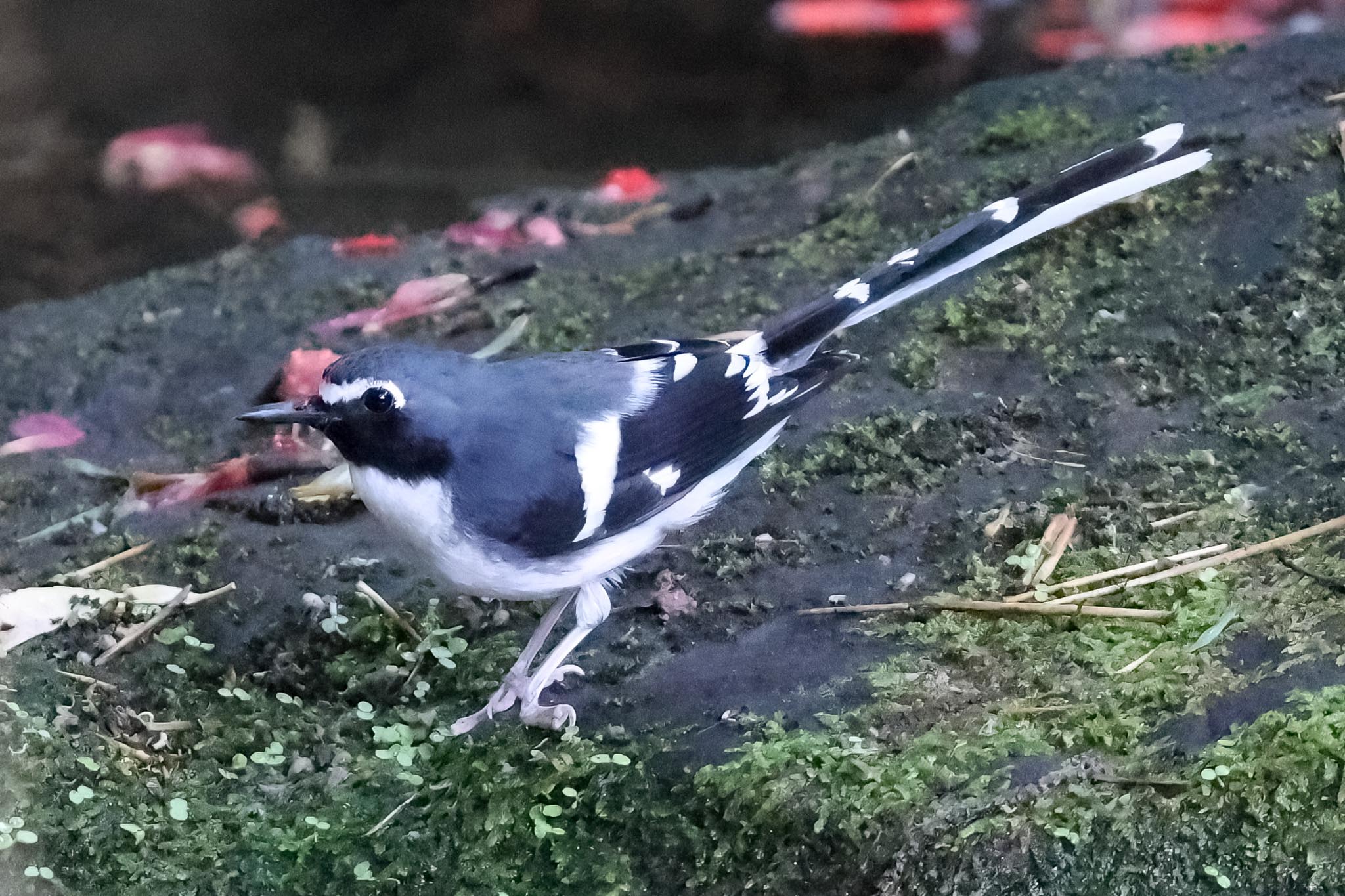
As we walked back up towards where we had parked, there were lots of Common Rosefinches in the flowering trees now, including some smart rosy-pink males, and a Blue-bearded Bee-eater was perched in the top of a bare tree beyond the minibus, with a Blue-throated Barbet too. There were still lots of bulbuls in the fruiting trees beyond, so we walked on up for closer look. While we were scanning, we got a brief glimpse of a male Spot-winged Grosbeak in the top of a leafy tree just behind, and then we managed to get the scope on a female nearby. Suddenly they flew up and we could see there was actually a flock of at least ten Spot-winged Grosbeaks here. They flew across to the top of a nearby fruiting tree, where we watched them feeding – great to find some here, after missing them at their regular spot yesterday. We had nice views of an Orange-bellied Leafbird in the fruit trees here too.
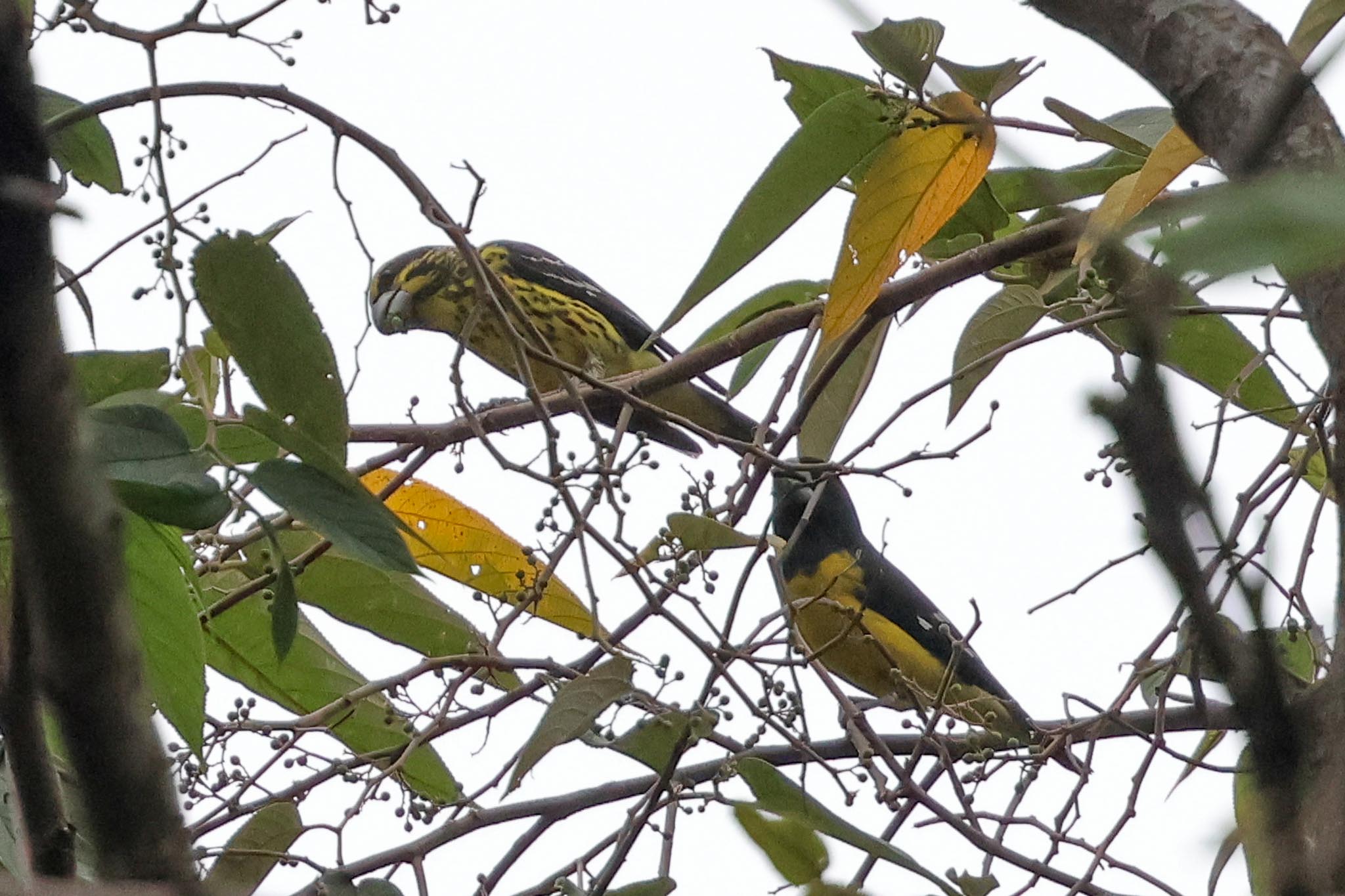
We drove on up to the summit now. It had looked to have been cloudy over the top all day, but when we got up there the cloud was not thick and the visibility was fine. As we got out of the minibus, a mixed flock of Chestnut-tailed Minlas and Rufous-winged Fulvettas was in the trees right in front of where we had parked, along with an Ashy-throated Warbler. Walking up to the buildings, there were several Grey-sided Thrushes in the fruiting tree in front, but they moved higher up through the branches just as we arrived and then disappeared off through the trees.

There were several sunbirds in the small trees nearby, so we turned our attention to those, with several Gould’s Sunbirds at first and then a nice male Green-tailed Sunbird of the race angkanensis, also known as Doi Inthanon Sunbird and only found here, so the one we were hoping to see. There were a couple of Ashy-throated and Buff-barred Warblers in the same trees too, along with three tame Black-backed Sibias. Then the Grey-sided Thrushes reappeared and we had nice views of them feeding on the berries – one bit off more than it could chew, and kept trying to swallow a berry that was just a bit too big for it, before it eventually had to spit it out.
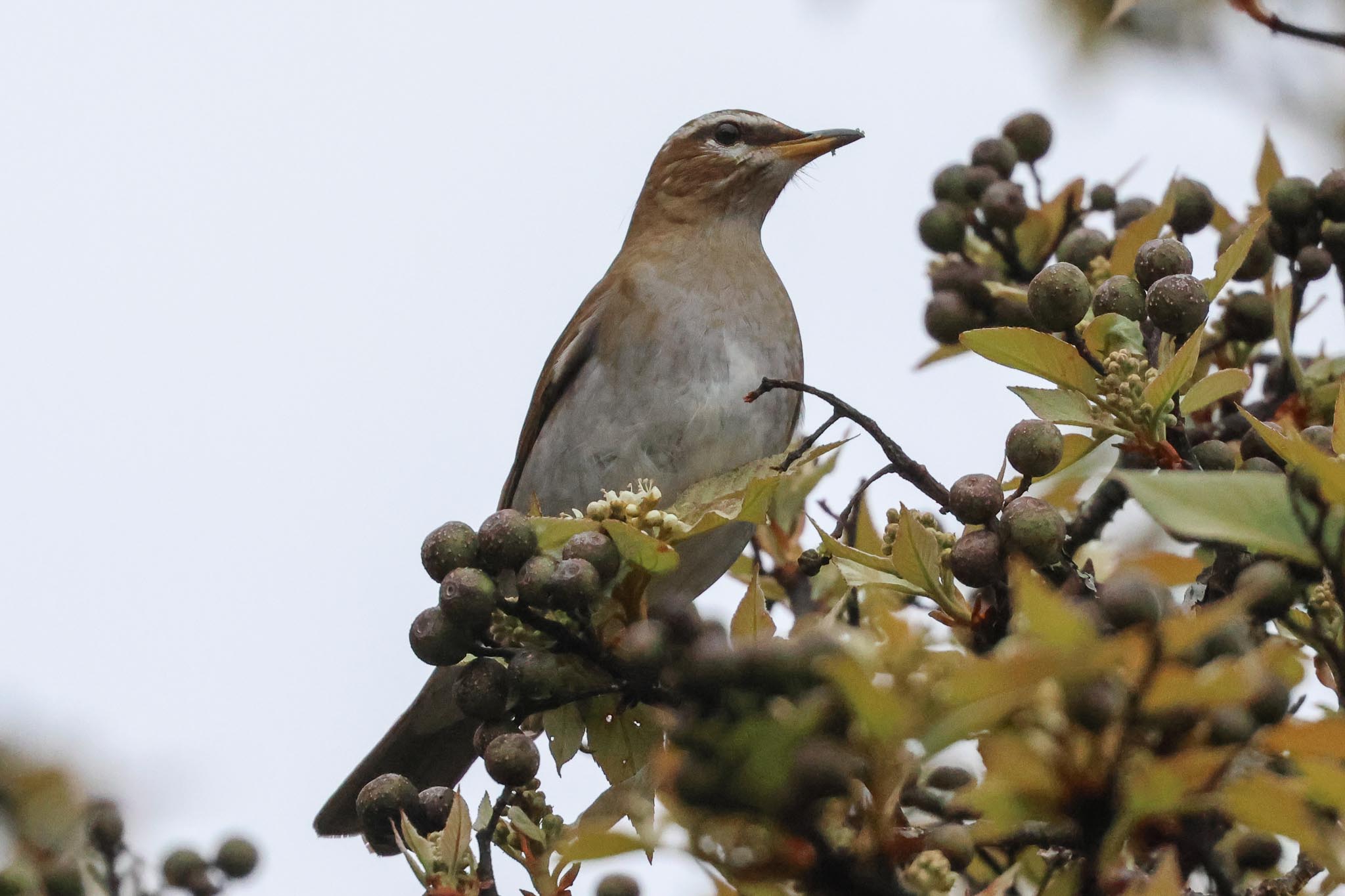
There were few birds along the boardwalk from here up to the summit, but when we got out into the car park beyond there was a little bit of sunshine breaking through and a very tame Doi Inthanon Sunbird in the bushes now looked particularly stunning.

We walked down the road a short way and down the steps to the summit marsh boardwalk. A Yellow-bellied Fairy-fantail was flycatching from the bushes which were full of Minlas and Fulvettas, with a Silver-eared Laughingthrush on the ground almost under the boardwalk below us. Round from the platform overlooking the marsh, there were several warblers flicking around in the undergrowth, including our first Blyth’s Leaf Warblers.
Nick could hear a White-crowned Forktail calling further on now, so we walked round very slowly and quietly until we found it under the bushes – it was hard to pick up but we could see it feeding in puddle in leaf litter. A Blue Whistling Thrush in damp shady area too. There were not many people on the boardwalk now, so as we walked on quietly we could hear scratching in the undergrowth. We crouched down low and looked up underneath the bushes to find three Rufous-throated Partridges on the ground below. We watched them feeding in the leaf litter, kicking up leaves.
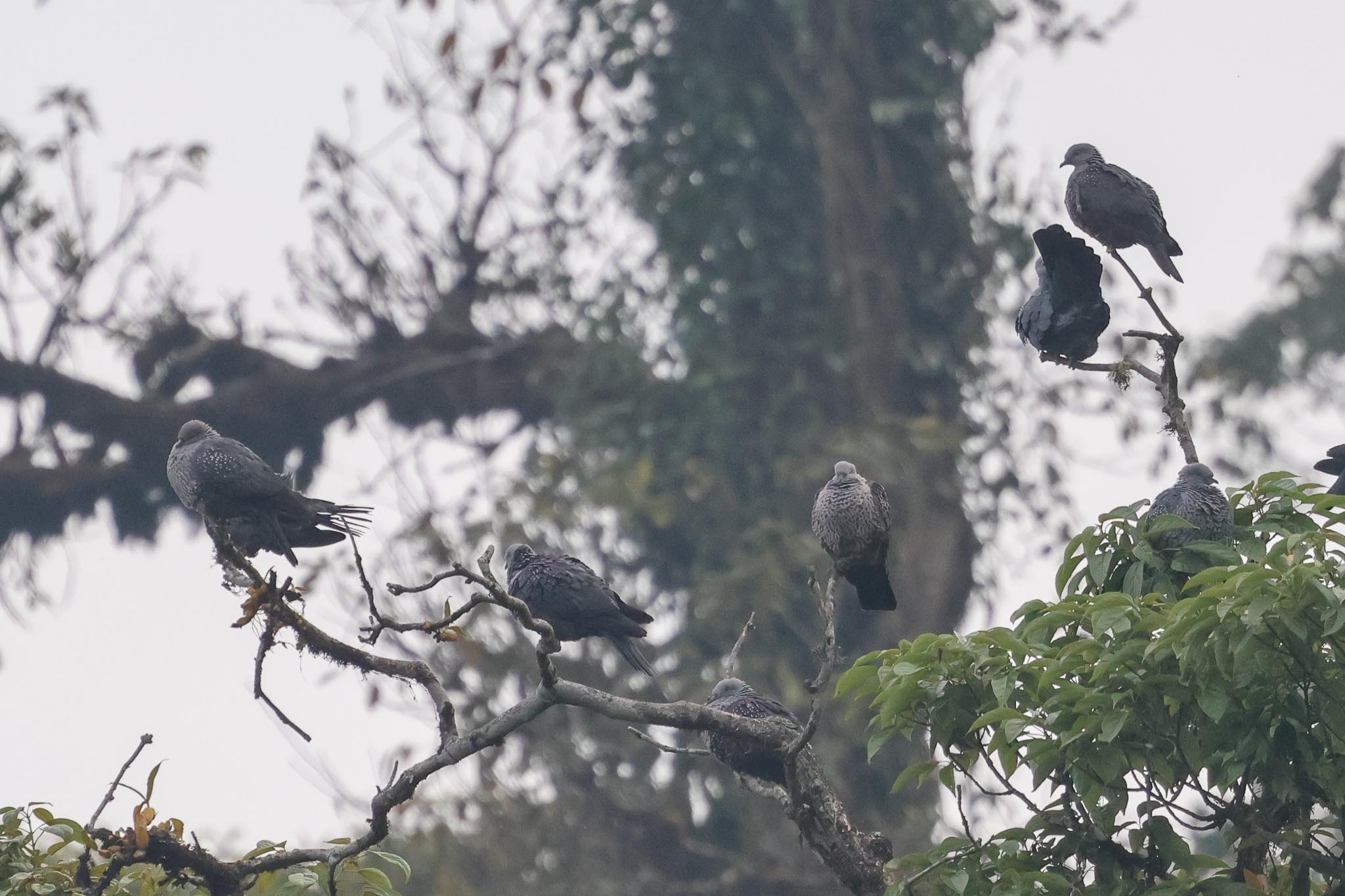
It was time to head back down. We normally look for Speckled Woodpigeon in the early morning, in their favoured tree by the road, but Nick looked up now as we approached and could see some perched there. We stopped and got the scope on them, at least sixteen, very smart birds and neatly patterned, very attractive for a woodpigeon! A couple of Striated Bulbuls were perched on a bare branch way up on the slope beyond. It was already getting dark by the time we got back to the hotel, in time for a quick freshen up before dinner. Again, Nick had ordered a selection of food for us to try and we enjoyed a delicious variety of spring rolls, red curry and fried tilapia. The Yum dipping sauce for the latter is normally served on the fish but was provided separately for us – very tasty but a bit too spicy for many of the group!
Friday 26th January
Having seen the Woodpigeons yesterday, we didn’t need to have an extra early start this morning. After breakfast at 6.15am (a lie in!), we drove back up into the National Park and had the chance for another quick stop to try to see the Black-backed Forktail. We walked down quietly to the bridge from the parking area again and scanned the rocks, and this time we found them further upstream. They were not close, but we all got good views in the scopes before they worked their way over the rocks, round the next bend in the river and out of view.
We carried on straight up to the summit now, into the cloud. We could hear Pygmy Cupwing singing form the parking area so we went straight down to the summit boardwalk to see if we could find it, but it was another large birding group playing a recording! We walked on past where they were standing and further round onto the boardwalk but it was cooler here in the trees with the low cloud today, and fewer birds. Round the far side, where it was wetter, we found a couple of male Himalayan Shortwings below the boardwalk, but a flock of birds high in the trees moved quickly out towards the road, so we went back up the steps and out into the open to see if we could find them.

We only had to walk a short way down the road before we located the flock again on the edge of the trees, lots of Chestnut-tailed Minlas and Rufous-winged Fulvettas, great views of a pair of Yellow-cheeked Tits feeding on the lower branches, Ashy-throated Warblers, Gould’s Sunbirds and several Swinhoe’s White-eyes. A Yellow-browed Tit flitted through too quickly at first, but then we picked it up again in the top of a tree further along where it sat still for a few seconds so we could all get on it. As the flock passed through a fruiting tree by the road, we could see several Grey-sided Thrushes feeding in the branches and a single Eye-browed Thrush was with them. Three Ashy Woodpigeons flew over.
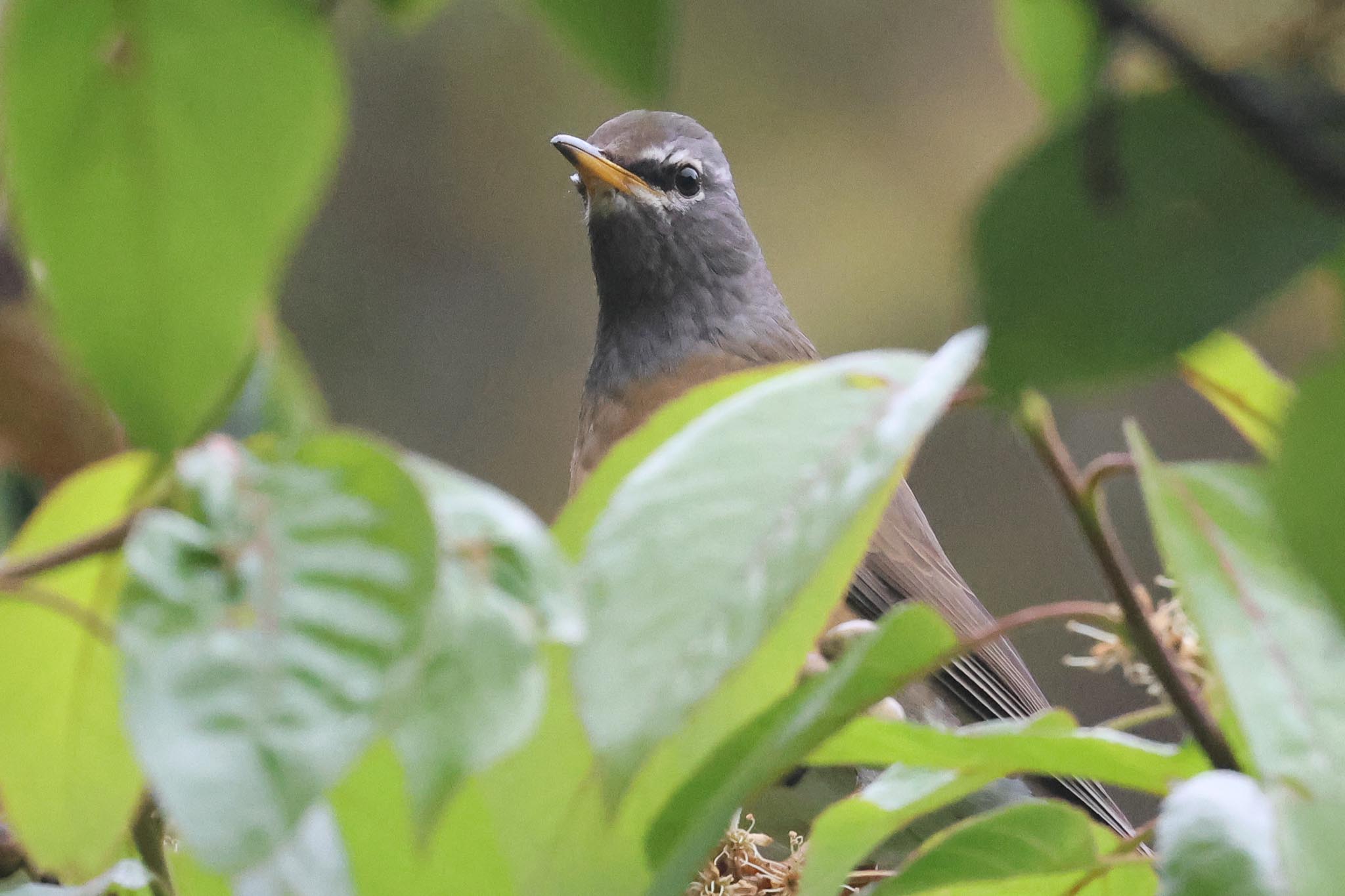
Up at the buildings, the coffee shop was open so we stopped for a hot drink – the hot chocolate and delicious almond brownies were particularly recommended – while Nick kept checking the spot for Ashy Woodpigeon in the trees nearby. Another Thai birder came up and told us that one had just flown in, and now we found it perched on a branch. The cloud was swirling through the trees up here, so it was a bit dark and misty, but thankfully it was fairly close so not bad views.
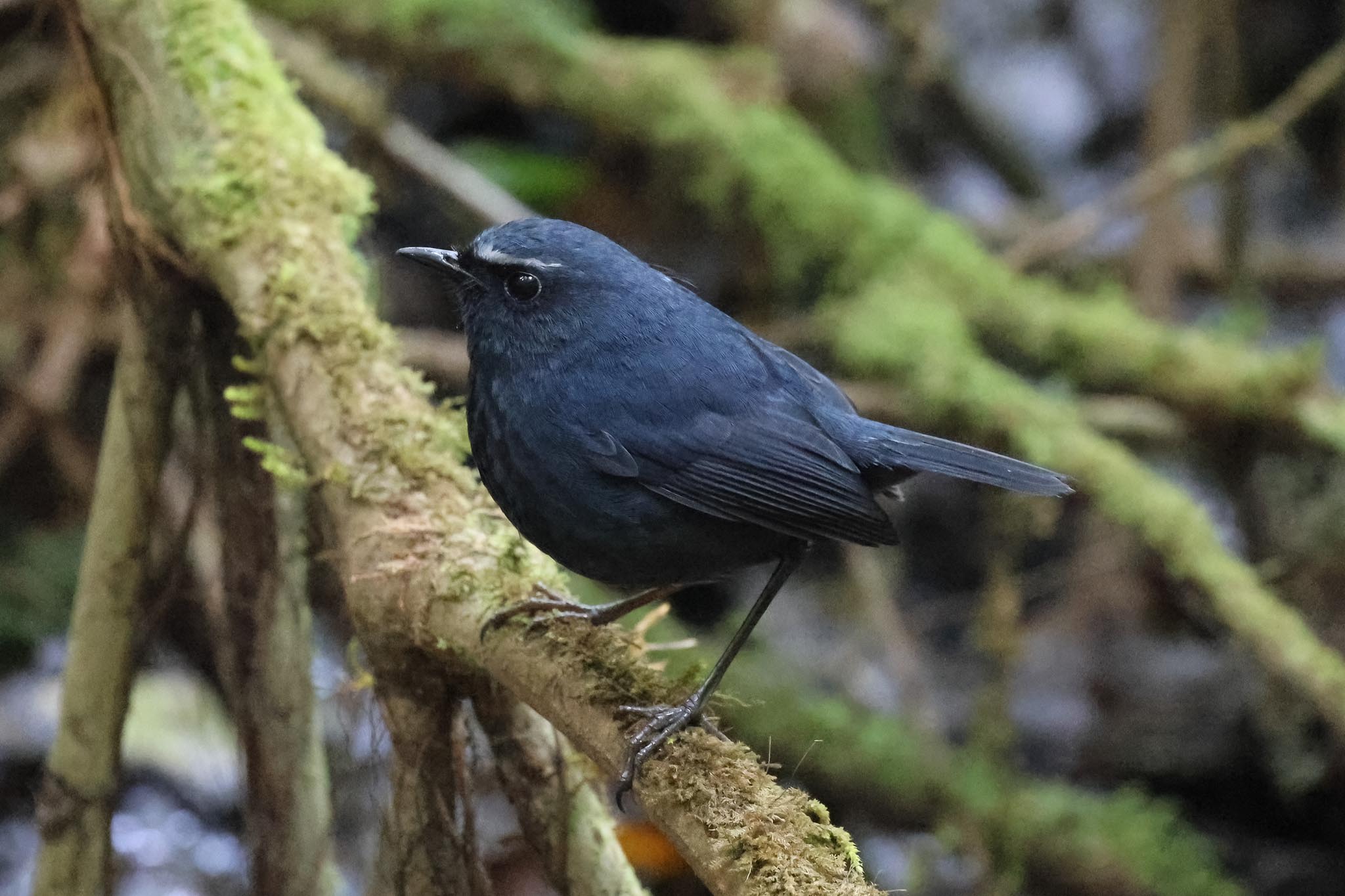
After our coffee break, we went back down to the summit marsh to try again for Pygmy Cupwing. A Slaty-bellied Tesia was calling in the undergrowth at the bottom of the steps right next to the path, and we enjoyed very close views of it when it came out onto the edge. The other group had moved on and a very tame Blue Whistling Thrush was waiting where they had been earlier. We scanned under the trees around the edge of the water, finding a pair of Himalayan Shortwings, the male showing particularly well now, and a pair of Silver-eared Laughingthrushes. After a patient wait, the Pygmy Cupwing finally appeared too and we had very good views of it now climbing around the branches.
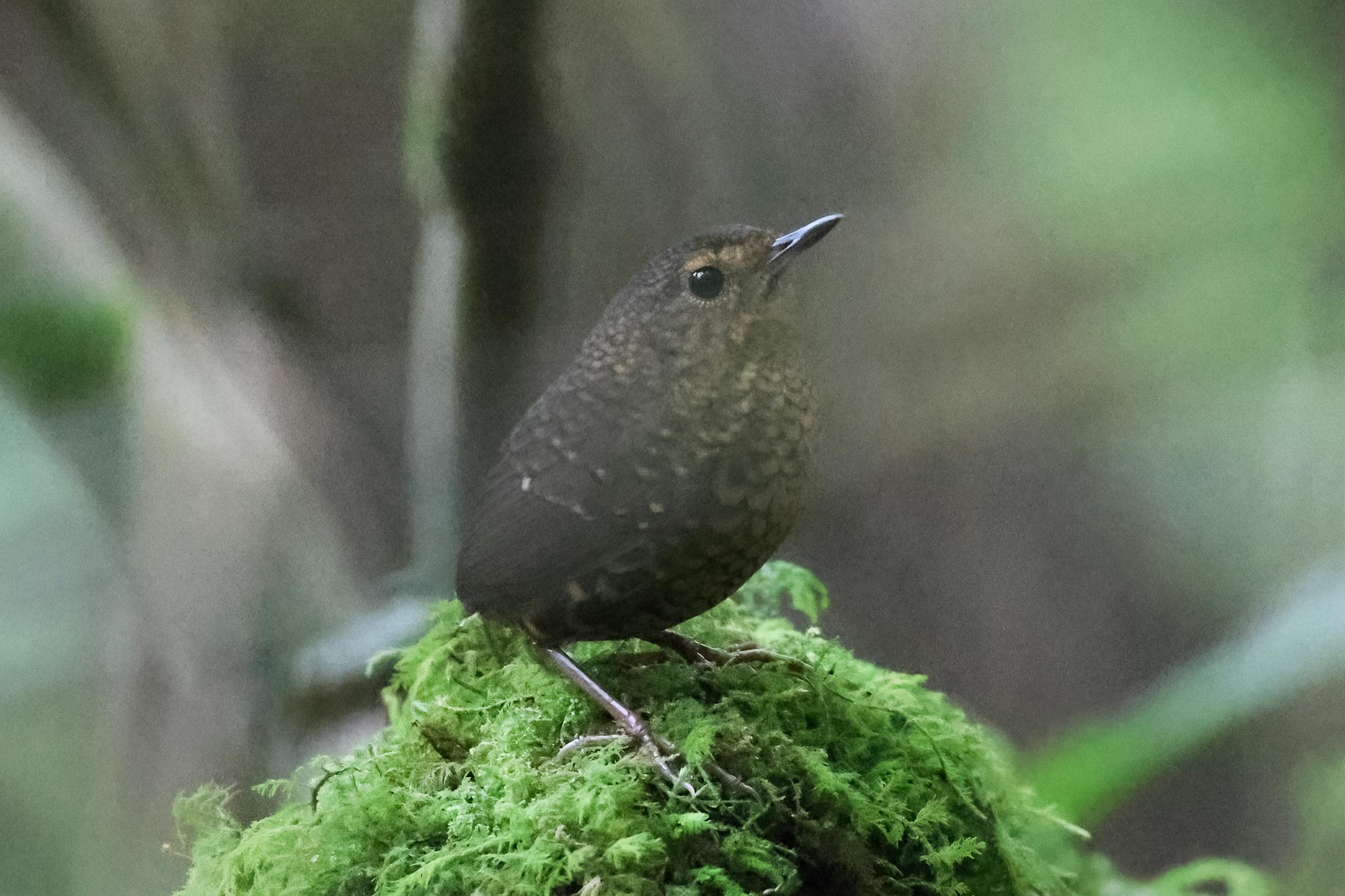
Back up to the minibus, we drove back down from the summit, taking a side turning and stopping again in front of some buildings which were surrounded by flowering cherry trees. Only a few of the group had seen the Asian Emerald Cuckoo yesterday, so it was our main target here. As we walked in under the trees, Nick whistled Collared Owlet again and birds started to appear. First the usual Gould’s Sunbirds and Japanese Tits, a pair of Oriental White-eyes, and a couple of Scarlet Minivets. An Asian Emerald Cuckoo called and a female flew up into the trees above us. Then a Maroon Oriole flew in and perched on the top of some nearby pines.
We were booked into a hide this afternoon and wanted to get there in good time, so we drove further down now to Mr Daeng’s for an early lunch. While our food was prepared, we admired the Spiny Orbweaver spiders on their webs along the boardwalk to the toilet block and a couple of Pallas’s Squirrels feeding in the banana trees just outside. The cloud had been hanging low all day and now it started to rain, though thankfully it was only light.
After lunch, we drove over to the hide and walked in through the trees, followed by the owner who came in singing and whistling to the birds and put out fruit, water and mealworms. Instantly, there were birds everywhere, coming in and out to feed – Grey-throated and Buff-breasted Babblers around his feet as he was putting out the food, several Brown-cheeked Fulvettas, a pair of White-tailed Robins with the female even coming into the hide behind us, a female Hill Blue Flycatcher, White-rumped Shama, Puff-throated and Grey-eyed Bulbuls.
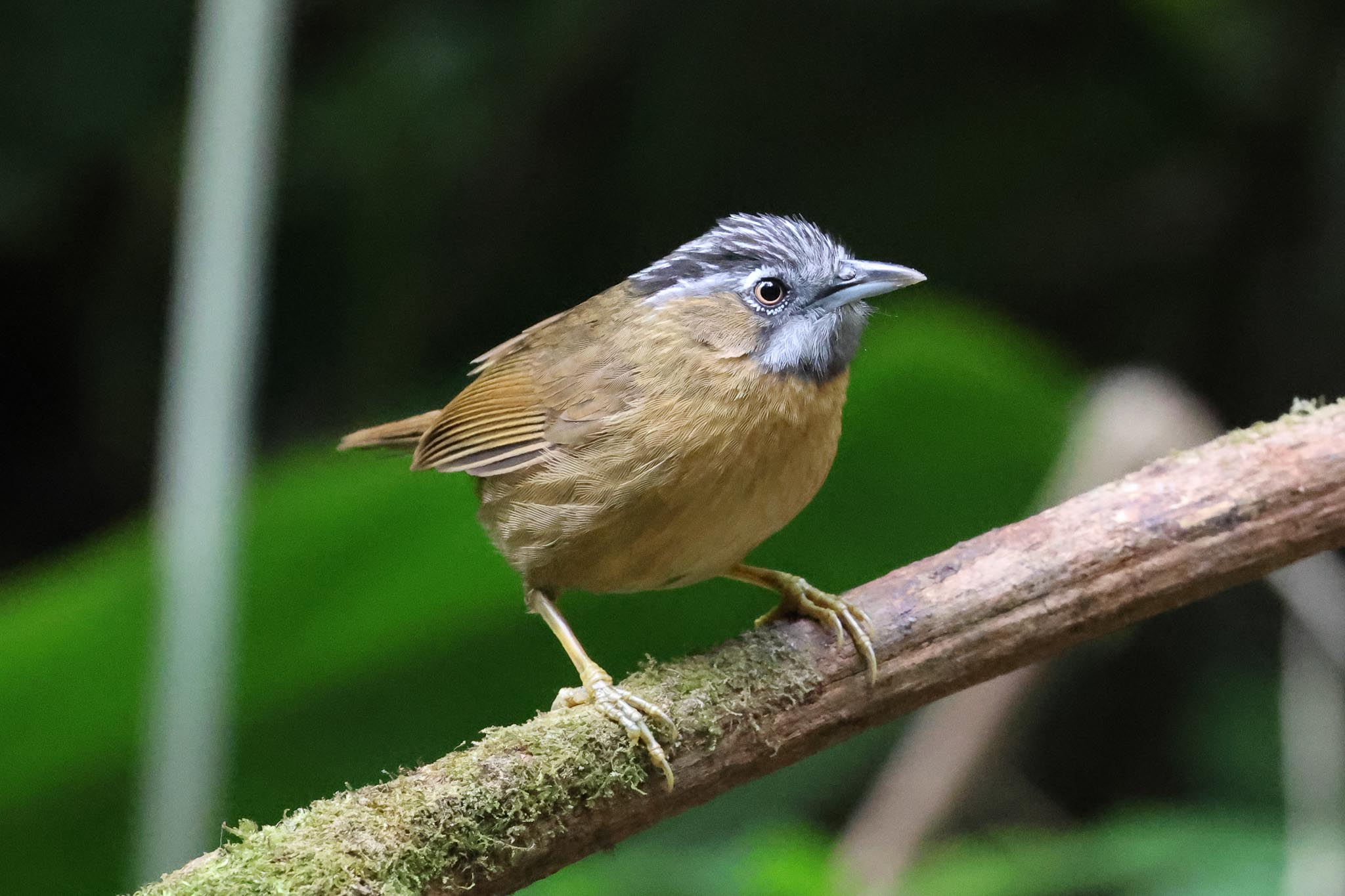

A young male Siberian Blue Robin and a brief Lesser Shortwing put in appearances on the ground in front of us.
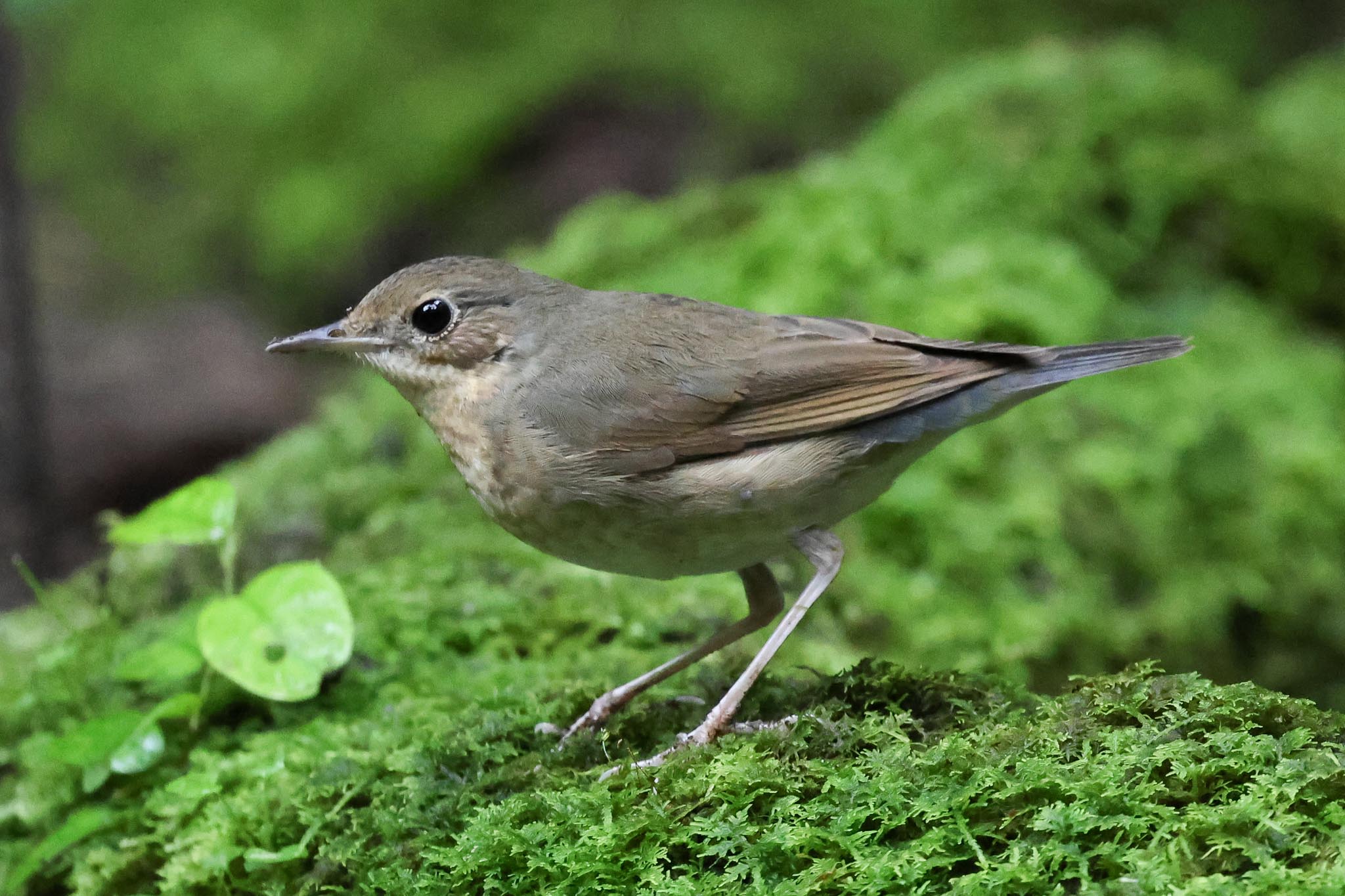
We had only had brief flight views of Streaked Spiderhunter flashing past before, but now we enjoyed great views of both Streaked and Lesser Spiderhunter coming in to feed.
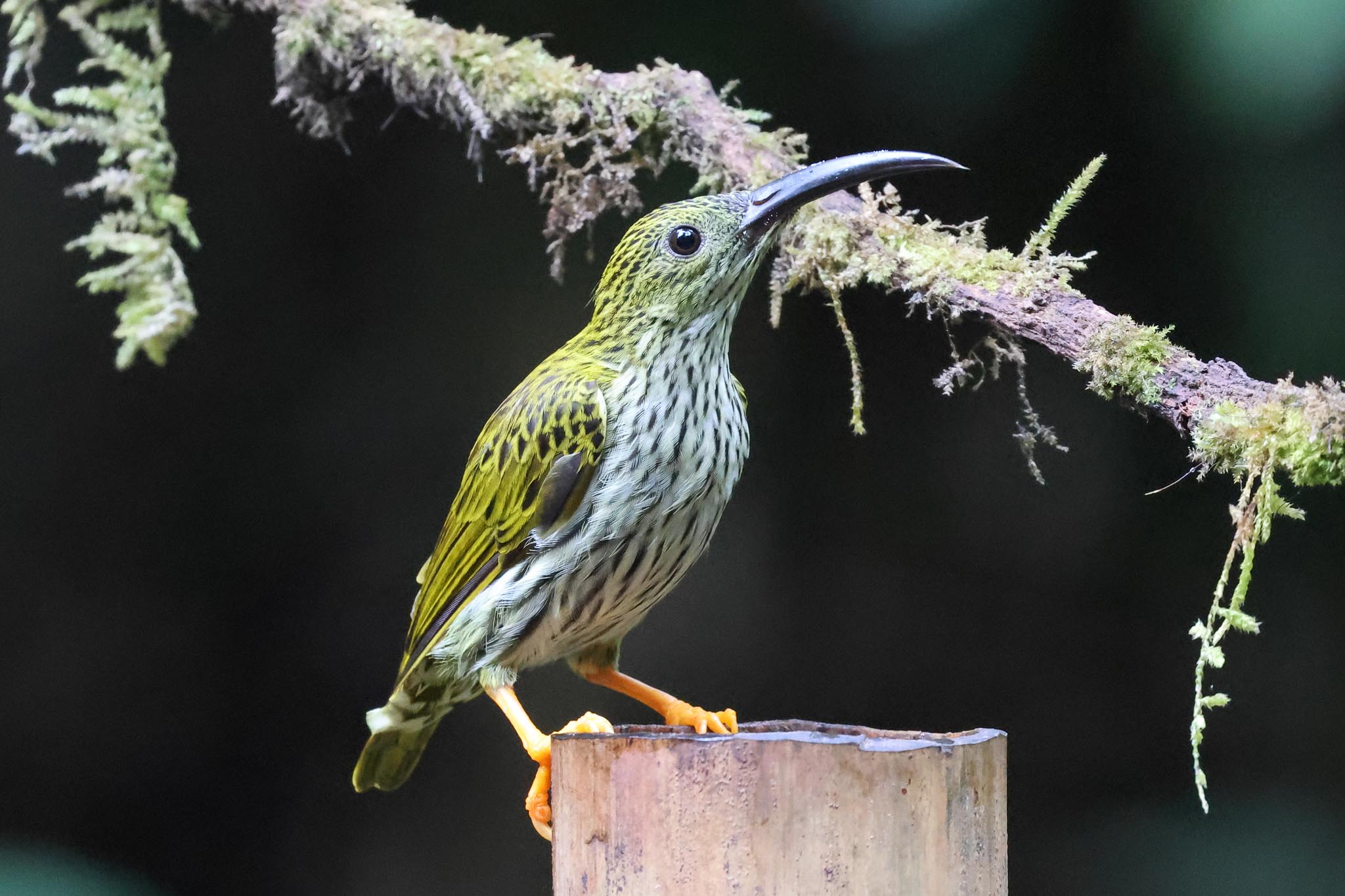
Three Asian Emerald Doves flew in but mostly stayed further back under the trees beyond. A male Snowy-browed Flycatcher came in a couple of times too, as did a Rufous-bellied Niltava, and pair of Yellow-bellied Warblers were in the trees above.
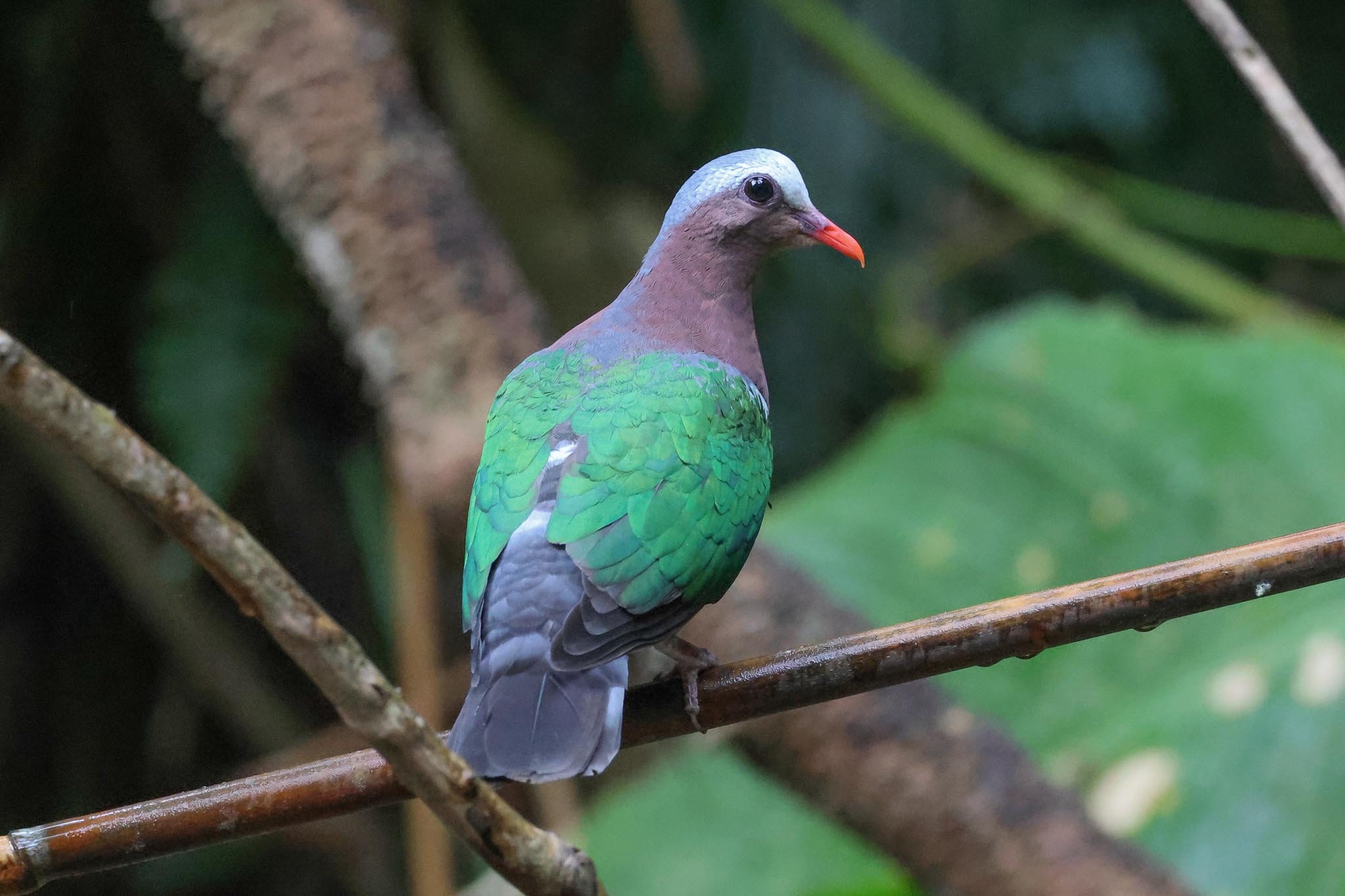
As it was damp outside, and there were so many things to see, we stayed in the hide for a while. The rain sounded worse than it was on the fabric roof, and when we went out, it seemed to have pretty much stopped. As we walked back down to the minibus, a Common Green Magpie was in the trees but flew off before we could all see it and despite trying a short way along the track we couldn’t find it again. A pair of Greater Racket-tailed Drongos were mimicking its call instead, and a Streaked Spiderhunter and a Blue-throated Barbet were perched in the top of the trees.
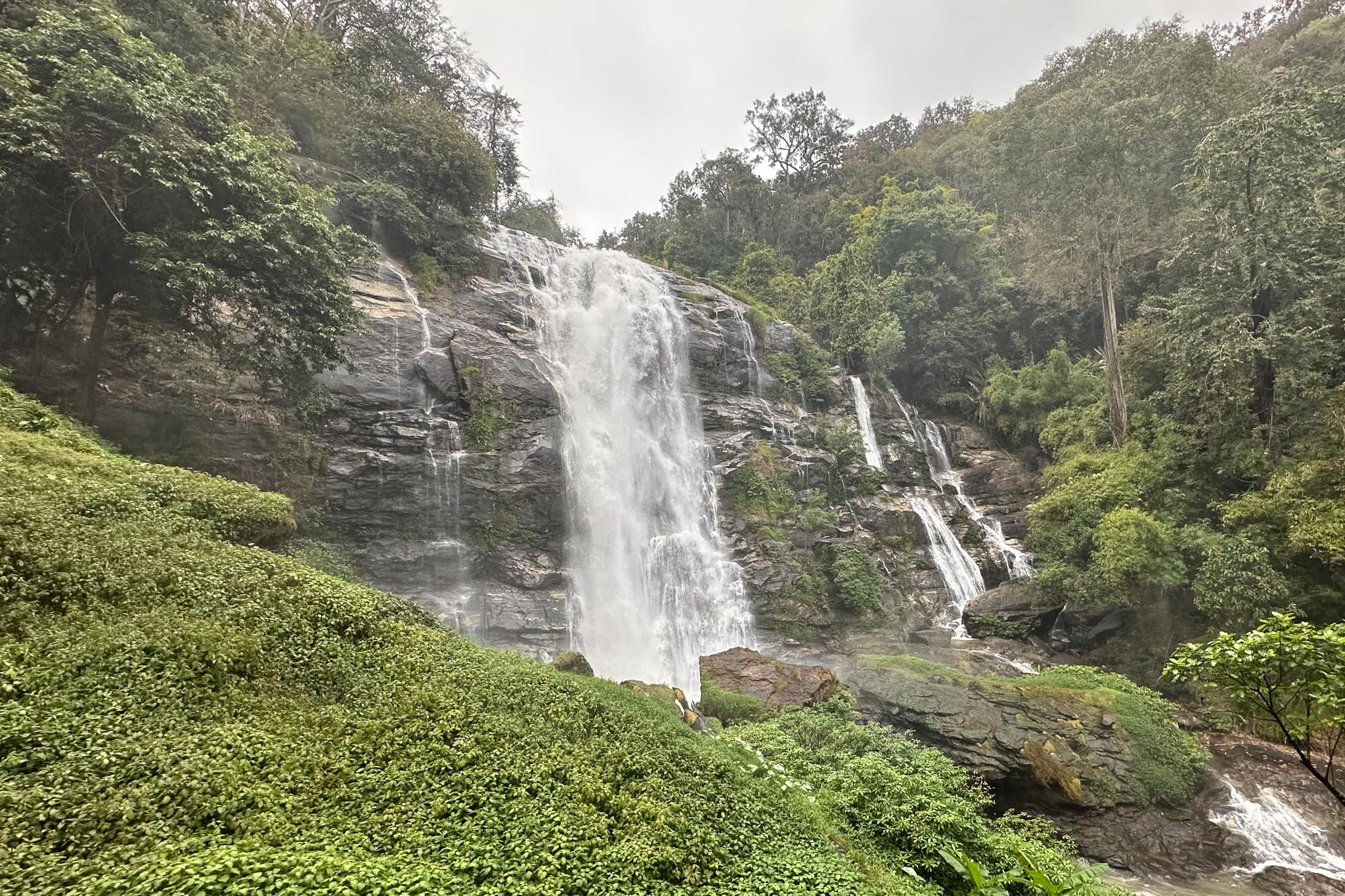
On our way back down through the park, we had a quick stop to look at the Wachirathan waterfall. There was an impressive volume of water coming over the falls, despite it being the dry season – we wondered what it would be like in the wet season! We were flying south tomorrow, so we got back to the hotel earlier this afternoon to have more time to pack up. There were a few bulbuls in the trees by reception, along with Yellow-browed Warbler and an Asian Brown Flycatcher.
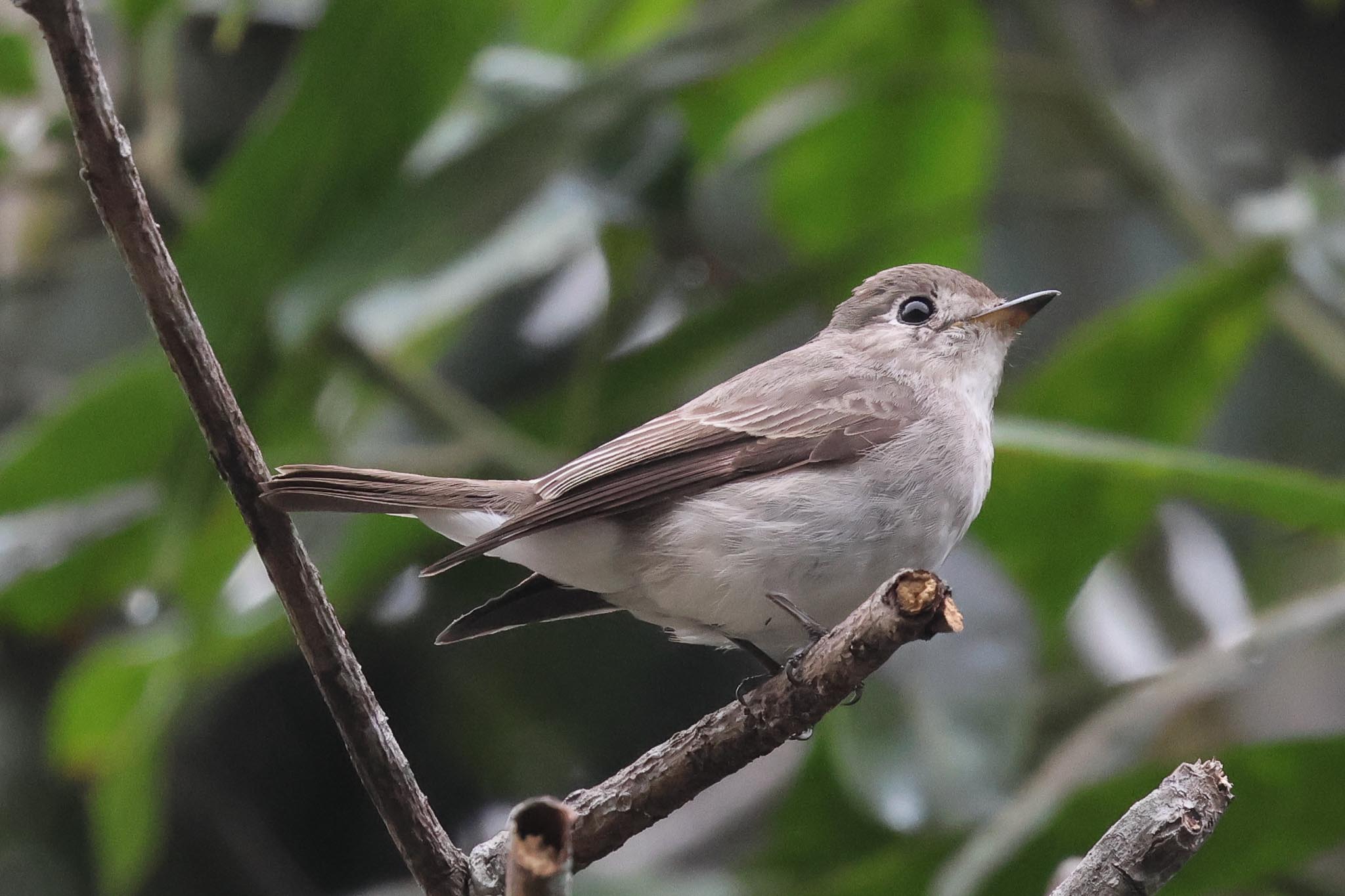
Saturday 27th January
It was a travelling day today, so we met for breakfast at 6am with all our bags packed, which meant we had time for a couple of hours in the National Park again before we had to head for the airport. When we got to the first Park gate, the guard asked his superior, and Nick was told he needed to buy new tickets, despite explaining that the ones we had bought on our first morning were valid for five days. The guards were insistent though and were making all the vehicles turn round and go back to the visitor centre. So we had to comply too and it was not a great surprise when Nick showed the staff at the Centre our tickets and they confirmed we didn’t actually need to buy new ones, they were still valid. Back out onto the road, we drove on quickly through the first gate now so the guards didn’t have a chance to check again!
We were planning to head higher up the main road to a spot to try for Small Niltava but it was still very cloudy and we drove into thick fog now. Change of plan, we turned off and went back to where we had stopped the other day, and on our way we drove up out of the cloud and there was even some sun trying to break through when we parked and got out. We could hear a mixed flock coming through the trees, and looked up into the pines to see several Yellow-cheeked Tits and Gould’s Sunbirds, and a Fire-breasted Flowerpecker. We were about to set off along the road when Nick thought he heard a Small Niltava singing, so we walked into the trees on a narrow path in front of where we were parked and there it was, singing in the branches ahead of us.
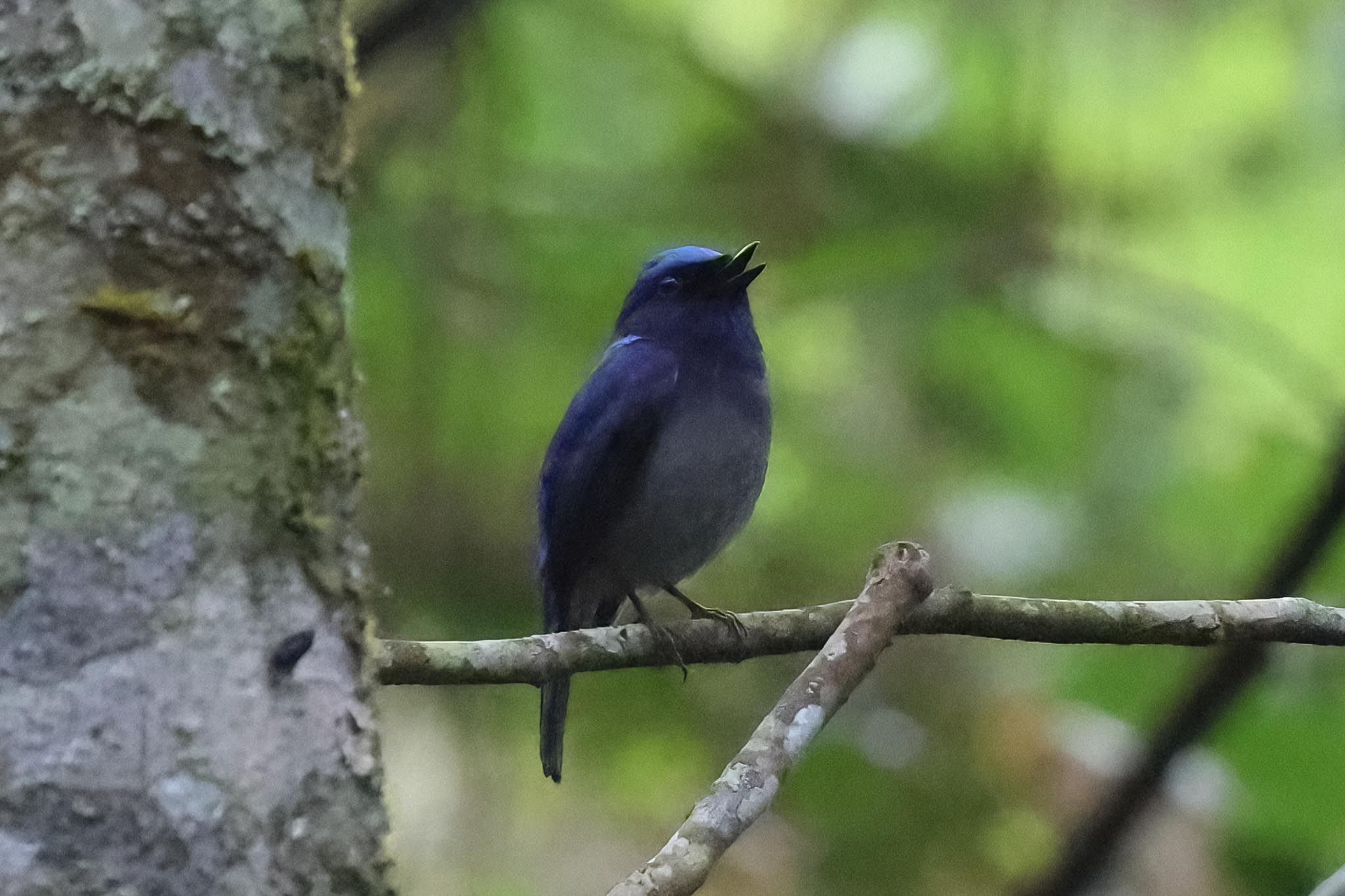
Back out onto the road, a Collared Owlet started calling – we could see lots of birds mobbing it high in the pines deeper in, but the Owlet itself was out of view. A Bay Woodpecker started calling in the trees too, but we couldn’t see it either. It gradually worked its way closer, before flying out over the road, landing in the pines too far in to see again, then shortly after it flew out again and back across the road – we had some nice flight views, but again it disappeared in too far through the trees. It would continue to taunt us, as we could still hear it calling. A succession of Cook’s Swifts were flying uphill over the trees and Nick caught sight of a Pacific Swift in with them, with its larger white rump, but it was too brief for everyone to see as it flew across over a gap in the trees. The Collared Owlet flew in to some deciduous trees closer to the road now, where we could see it perched in the leaves, and several White-browed Scimitar-Babblers were calling from the undergrowth below, but although we could see movement, they never came out into view.
We walked down the road a short distance, to where the sun was catching the trees. A Spectacled Barwing was in the tangled vegetation below before it disappeared off downhill, an Ashy Bulbul landed in the sunshine in the tops, and lots of leaf warblers were flitting around high in the trees above the road, along with a Yellow-bellied Fairy-Fantail. A Clicking Shrike-Babbler was singing, and we had nice views of it even if it kept high up in the trees again and several Silver-eared Mesias flew across the road in front of us. There was an open farmed area beyond, so we turned round and continued on back past the minibus this time.
A couple of Asian Emerald Doves were feeding in the undergrowth on the bank above and flew up noisily as we walked past and a group of Dark-backed Sibias and Blue-winged Minlas were feeding in the trees. As we got to the edge of another open farmed area a small group of Flavescent Bulbuls were feeding on the tarmac ahead, two Green Pigeons flew over and a Grey-backed Shrike and singing Oriental Magpie Robin were perched on the wires above the verge. We walked out into the clear and scanned the trees looking for the pigeons. Nick had a brief glimpse of two Wedge-tailed Pigeons as they flew deeper in, but we couldn’t refind them.
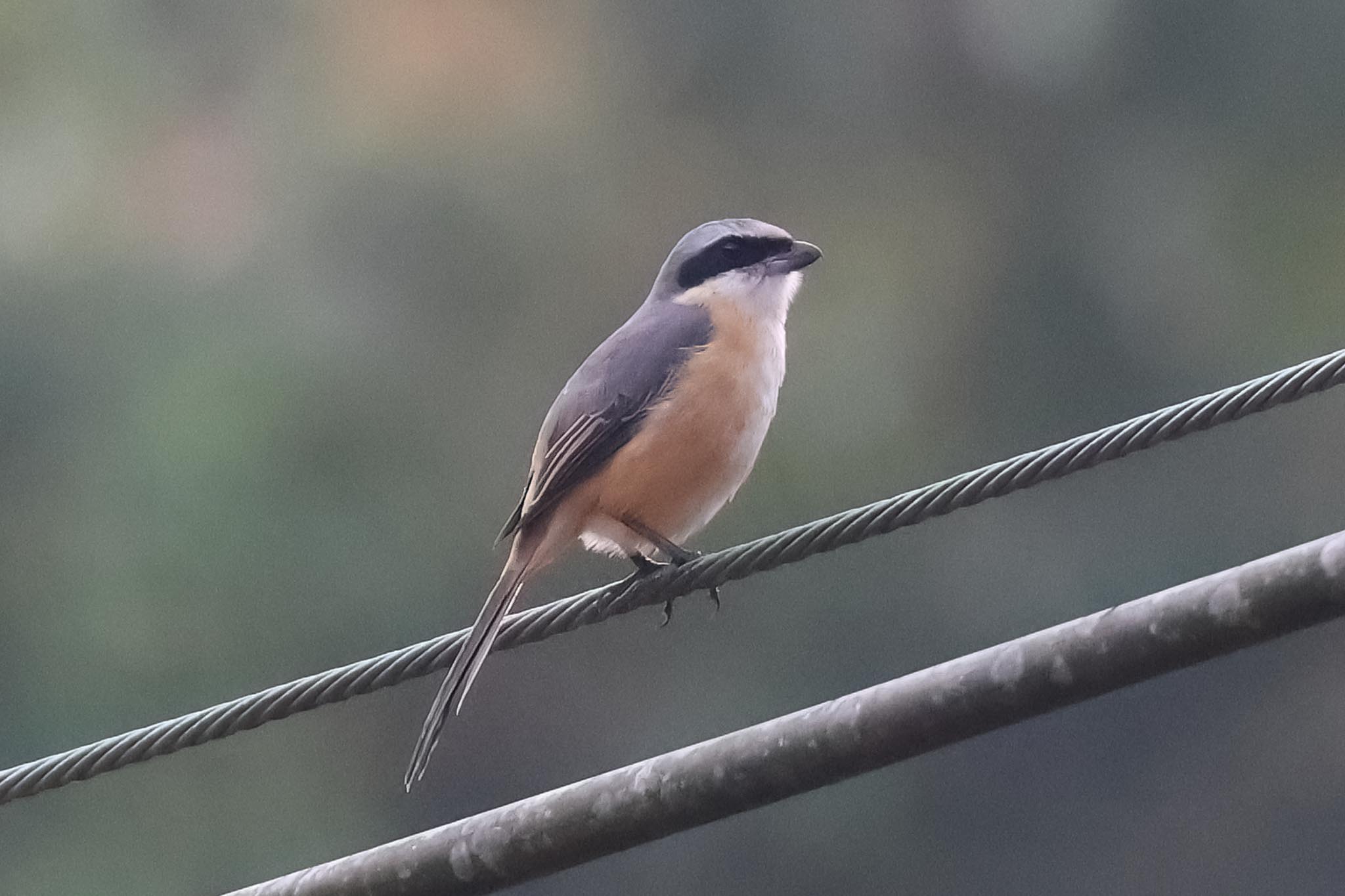
Unfortunately our time at Doi Inthanon was at an end now and we had to start heading back to Chiang Mai. It took an hour and three quarters to get to the airport, and we arrived in what we thought was already very good time for our 14.05 flight. We said our goodbyes to Nick outside but unfortunately, when we went to check in, we discovered first that our plane had been rescheduled for 15.05 and second that we had only been given a 15kg baggage allowance rather than the 20kg for all our other flights. The excess baggage charge was typically excessive, but at the request of the check-in agent we tried to pile all the group’s bags onto the scales to weigh them together. Needless to say, they wouldn’t all fit and some were resting on the edges. The agent seemed to rapidly lose interest at the prospect of having to weigh all the bags separately and add them up, so he very kindly said he wouldn’t charge us this time and the rest of the check-in process was pretty seamless.
We had plenty of time to kill now, so we found some seats where we could make camp and some people wandered off to check out the shops and buy souvenirs to take home. Then we went up to the restaurant on the departures floor above for lunch. There was just time for some more quick shopping before we had to be at the gate. The plane was then late boarding, but thankfully we were only twenty minutes behind schedule by the time it pushed back off the stand and after an hour we landed back in Bangkok. Our bags were out promptly and we met our bus and driver outside the terminal as arranged for the long drive down to our hotel for the next couple of nights in Petchaburi. The traffic wasn’t as bad as it could have been but with all the delays we still didn’t get there until 7.30pm and Games who would be guiding us for the next part of the trip was waiting for us outside. After dropping our bags in our rooms, we headed straight over to the neighbouring small hotel for dinner.
Sunday 28th January
After an early breakfast at 5.30am, we headed over to Pak Thale, arriving as it was just starting to get light. We started to see our first waders in the gloom, several Black-winged Stilts, a Common Greenshank, a couple of Grey Plovers. It quickly got light enough to see more and we found lots of Tibetan (Lesser) Sandplovers, some nice close Broad-billed Sandpipers and Red-necked Stints, one or two Curlew Sandpipers and a Common Sandpiper.
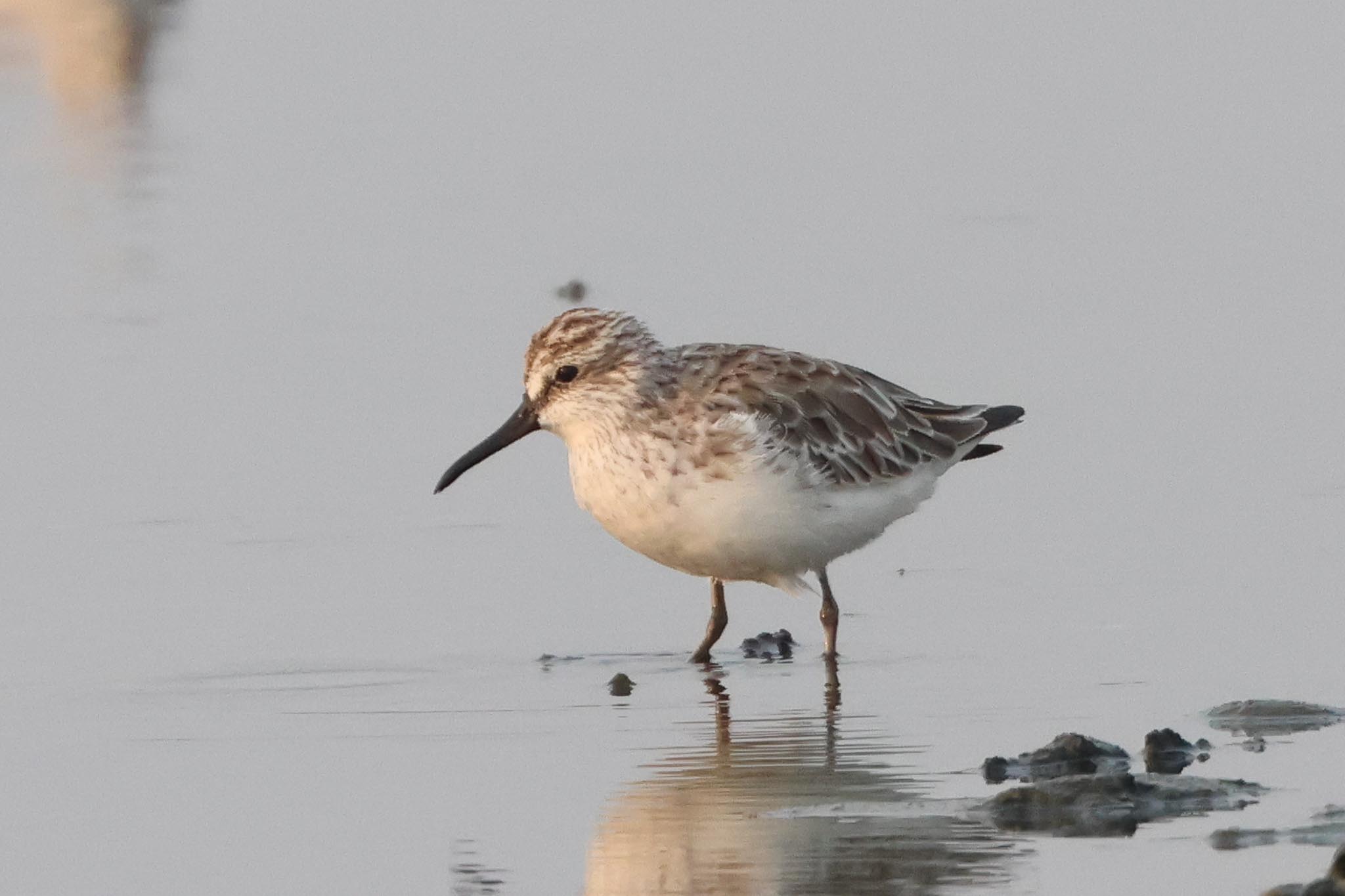
A big flock of larger waders was off to one side, and as we turned the scopes on it we could see a very large number of Asian Dowitchers mixed with Black-tailed Godwits. Given that Asian Dowitcher is listed as ‘Near Threatened’, it was particularly nice to see so many here. We picked out a single Bar-tailed Godwit with them, a couple of Marsh Sandpipers and a few Common Redshanks, and a flock of Red Knot dropped in. A couple of Gull-billed Terns landed on the back of the same pool and some distant Blue-tailed Bee-eaters were flying around the trees beyond.
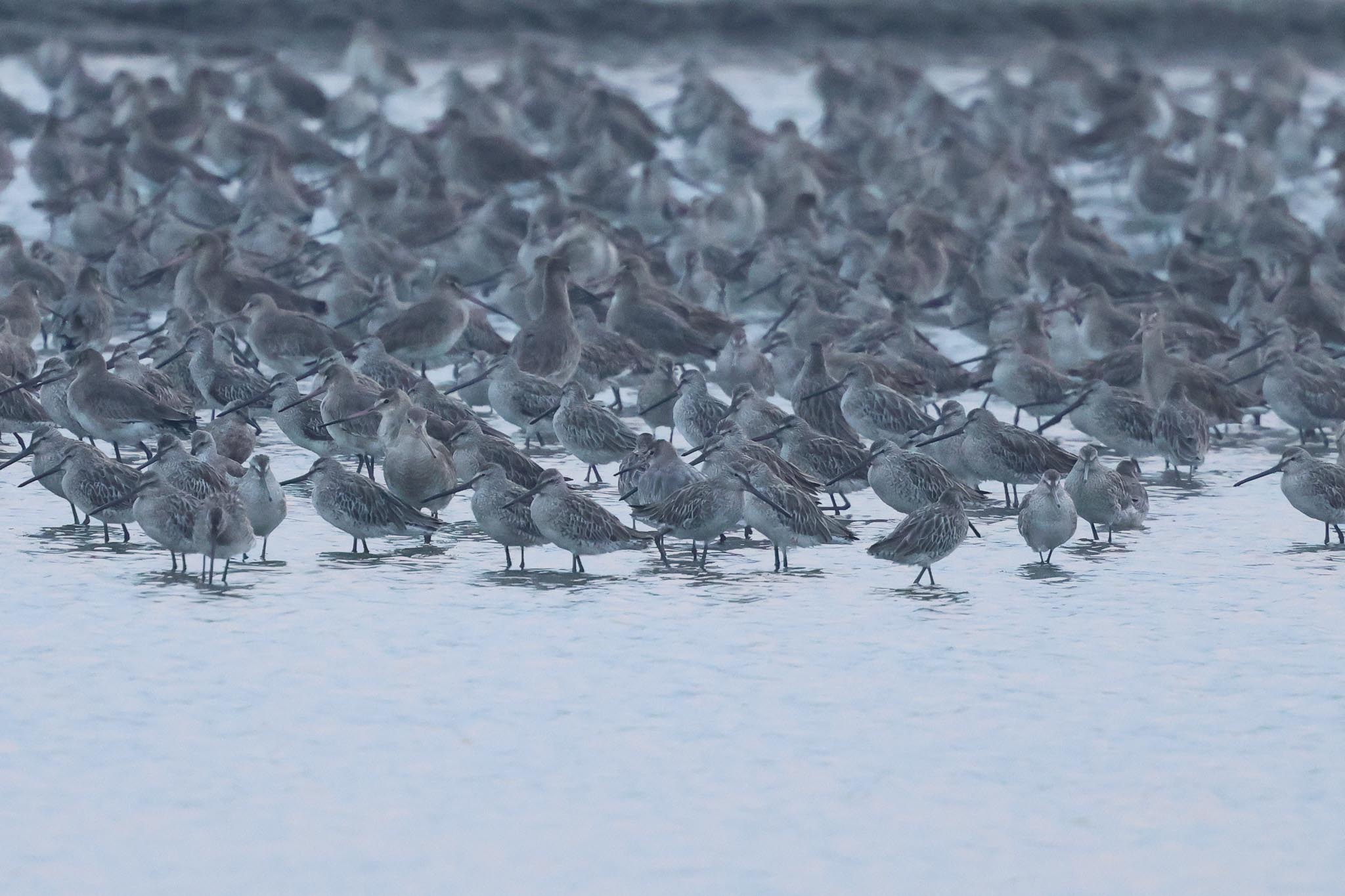
We were joined by local guide Mr Daeng, who was going to help us by trying to find a Spoon-billed Sandpiper, our most wanted target here, allowing us to spend more time looking through the other species. The sun was coming up now over the saltpans as we walked down towards the main track which heads out through the middle of the complex. There were waders everywhere. The next compartment down held lots of Tibetan Sandplovers and Greater Sandplovers in with them, nice to see the two species side by side, along with a few Kentish Plovers.
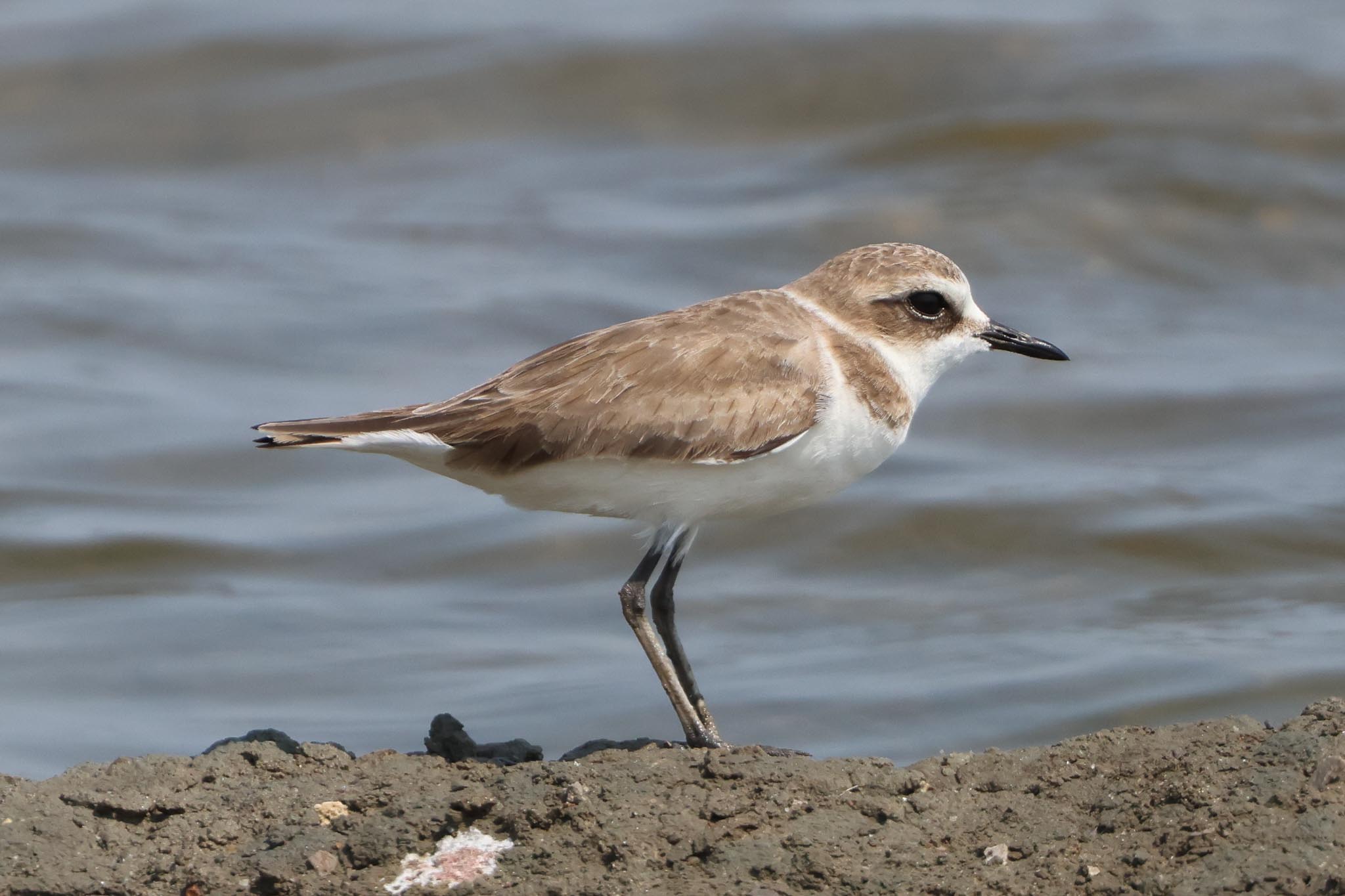
There were good numbers of Great Knot too, together with a few more Red Knot, another good comparison.
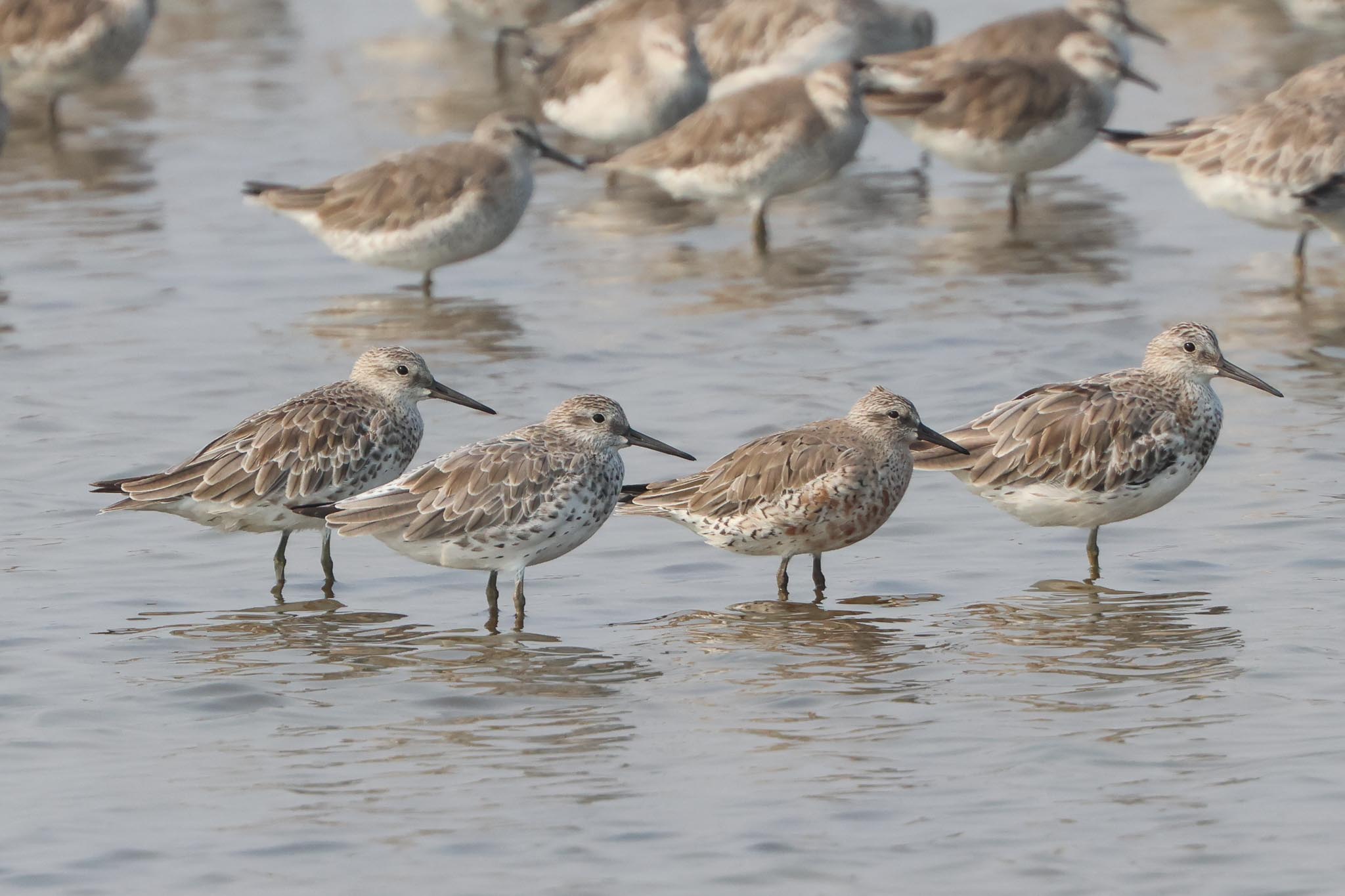
As we got to the main track, we had great views of some Red-necked Stints on another pool, very close, but unfortunately there was no sign of a Spoon-billed Sandpiper with them.
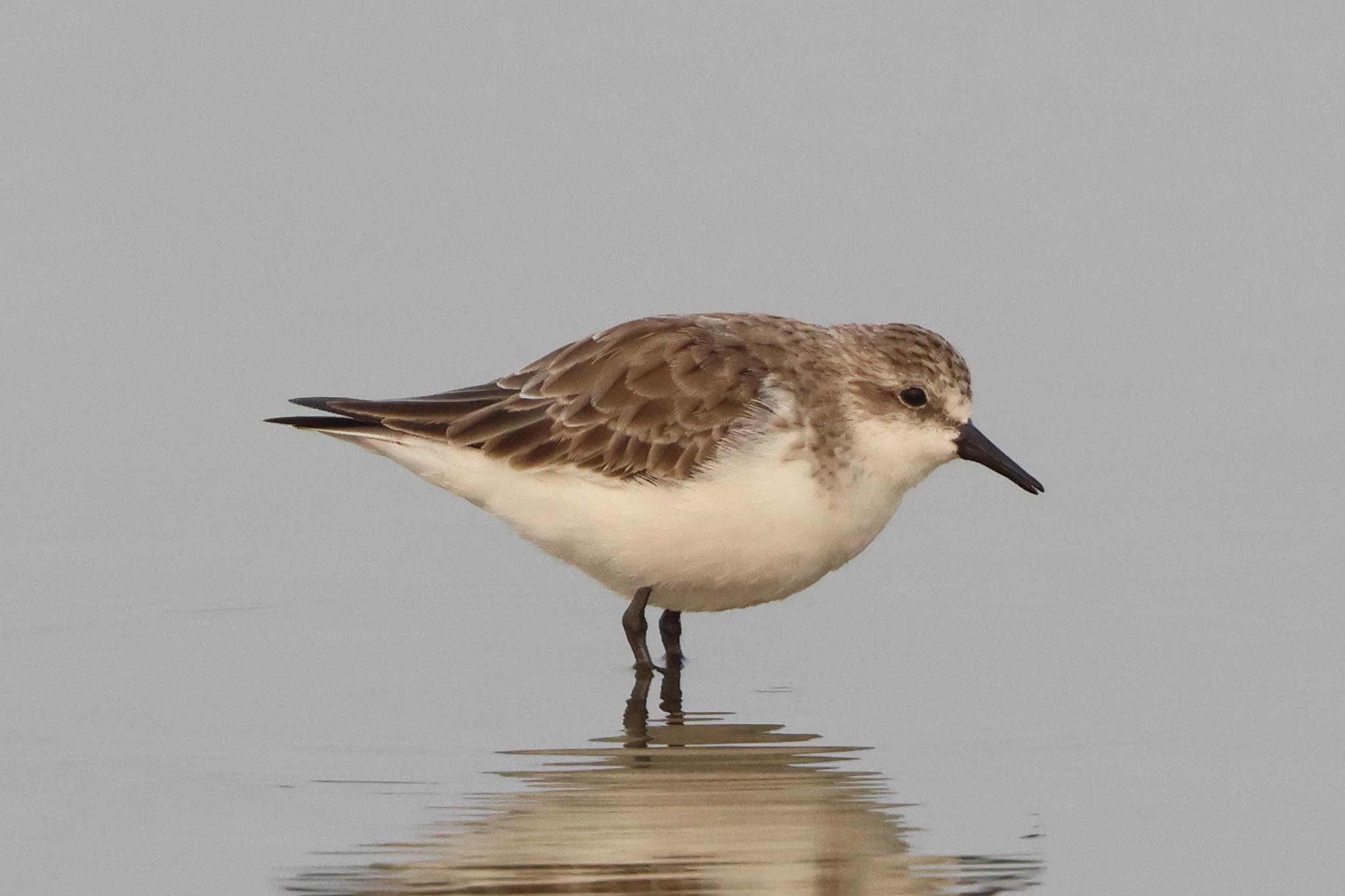
The huge flocks on the compartments further out got up and whirled round as a Brahminy Kite drifted over, impressive numbers of Great Knot in particular, another species in danger and now listed as ‘Endangered’, but still possible to see large flocks here, for now at least. A few Germain’s Swiftlets flew low overhead and a couple of Pacific Swallows were hawking around the buildings, lines of Indian Cormorants were flying out from roost, overhead towards the coast, with a few Little Cormorants and Painted Storks too.

Turning up the main track, a Sanderling was on a small pool in front of us with another group of Tibetan Sandplovers. There were lots of terns on the banks now – Eastern Common Terns of the subspecies longipennis and Little Terns, some flying round, with one or two Whiskered Terns patrolling up and down the channels. We counted at least 65 Nordmann’s Greenshanks in a single flock on one compartment now, another ‘Endangered’ species – amazing to see all these different threatened waders in one place and in such impressive numbers. Then we found more Nordmann’s Greenshanks on another pool further on where scanning through we found a Red-necked Phalarope too. There had apparently been one in with the Asian Dowitchers earlier, but now we all got onto a single Ruff, another addition to the ever expanding wader species list, albeit one we can also see in Europe now. Several Whimbrel were on the next pool over too, as we got out further towards the sea.

We turned left now, and Mr Daeng headed off the other way to check the pools further over. It was warming up but thankfully there was a nice fresh breeze in off the Gulf of Thailand, so even though it was the middle of the morning already, it was not too hot and the heat haze was not building up. We found several large roosts of Terek Sandpipers on the banks here, with their yellow-orange legs and upturned bills, and a couple of Spotted Redshanks flew up calling. A single Long-toed Stint was feeding along the muddy edge of one of the banks, along with a couple of Dunlin (one of the scarcer waders here today, unlike at home!) and there were a few Pacific Golden Plovers too. We cut back across on the bunds towards where we had parked – more great views of the different waders but despite checking everywhere this morning, we had not found any sign of a Spoon-billed Sandpiper. A tschutsensis Eastern Yellow Wagtail dropped in behind us on the bund as we got back to the birdwatching shelter for a drink and a banana.
Just when we had started to think we might have to come back and try again, and before we had even finished our drinks, Mr Daeng rang Games to say he had found a Spoon-billed Sandpiper. Drinks and bananas abandoned, we had a quick walk back out to where it was roosting on a stony spit. It was hard to see at first among the larger Sandplovers, Sanderlings and Turnstones, but then it stood up preening, and everyone could see its distinctive bill. We spent some time watching it – it went to sleep behind a stone for a bit, then woke up and walked down to the water, then back up onto the spit and back to sleep. ‘Critically Endangered’ and possibly close to extinction, the total global population of Spoon-billed Sandpiper was estimated at only around 490 mature individuals by Birdlife in 2014-19, with ongoing population declines. Only a very small number of individuals winter in Thailand, perhaps the easiest place in the world to find one, so it is a real privilege to see.
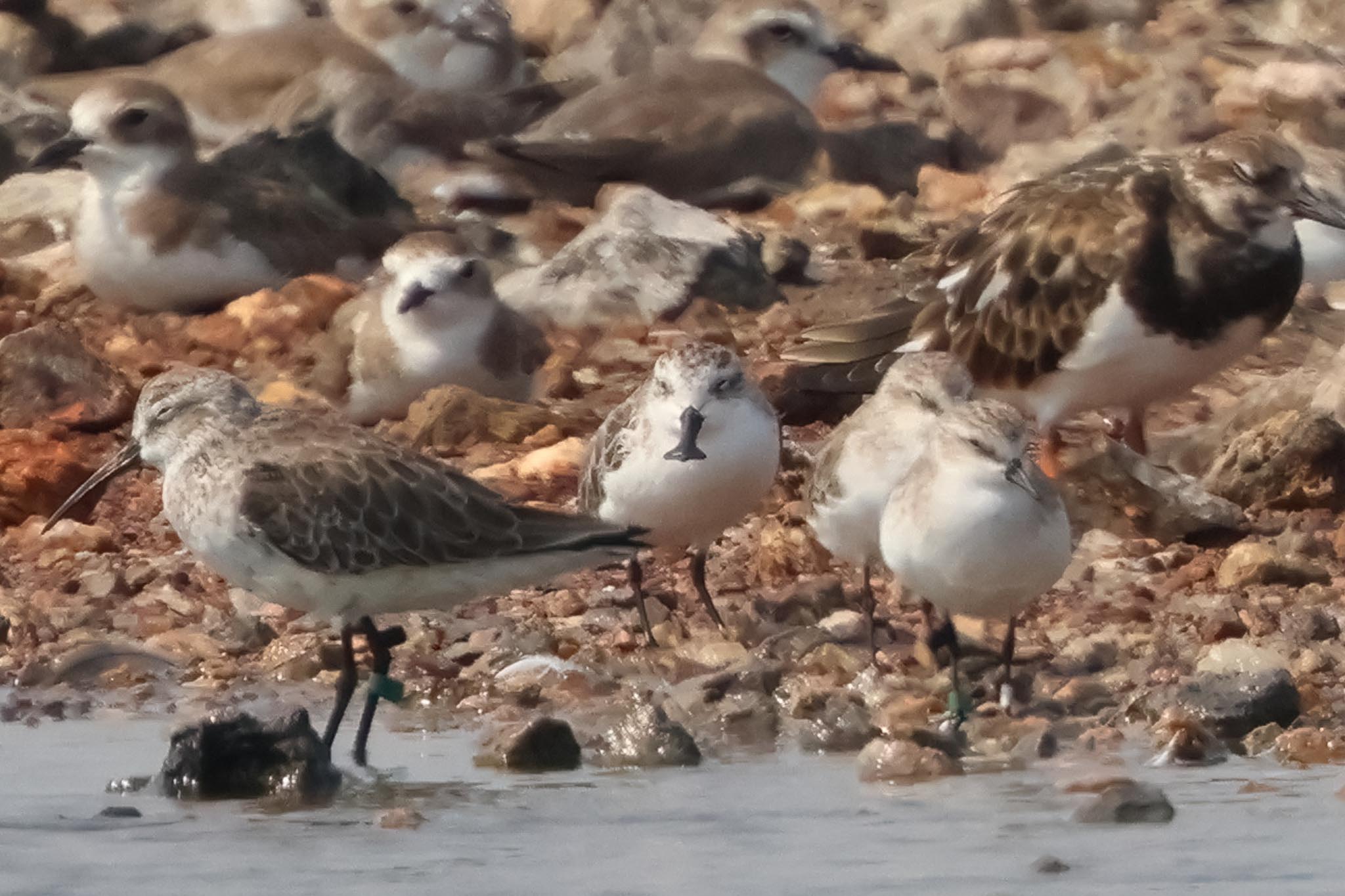
Walking a bit further up, there were a few Caspian Terns in with a larger roost of Brown-headed Gulls, with several more Nordmann’s Greenshanks roosting closer here and in perfect light and lots of egrets in the deeper pools beyond. A close Marsh Sandpiper was strutting up and down behind us. The Spoon-billed Sandpiper was still asleep and had positioned itself behind a small rock now so we couldn’t even see its bill! It was time to walk back, but everyone was happy with our success.
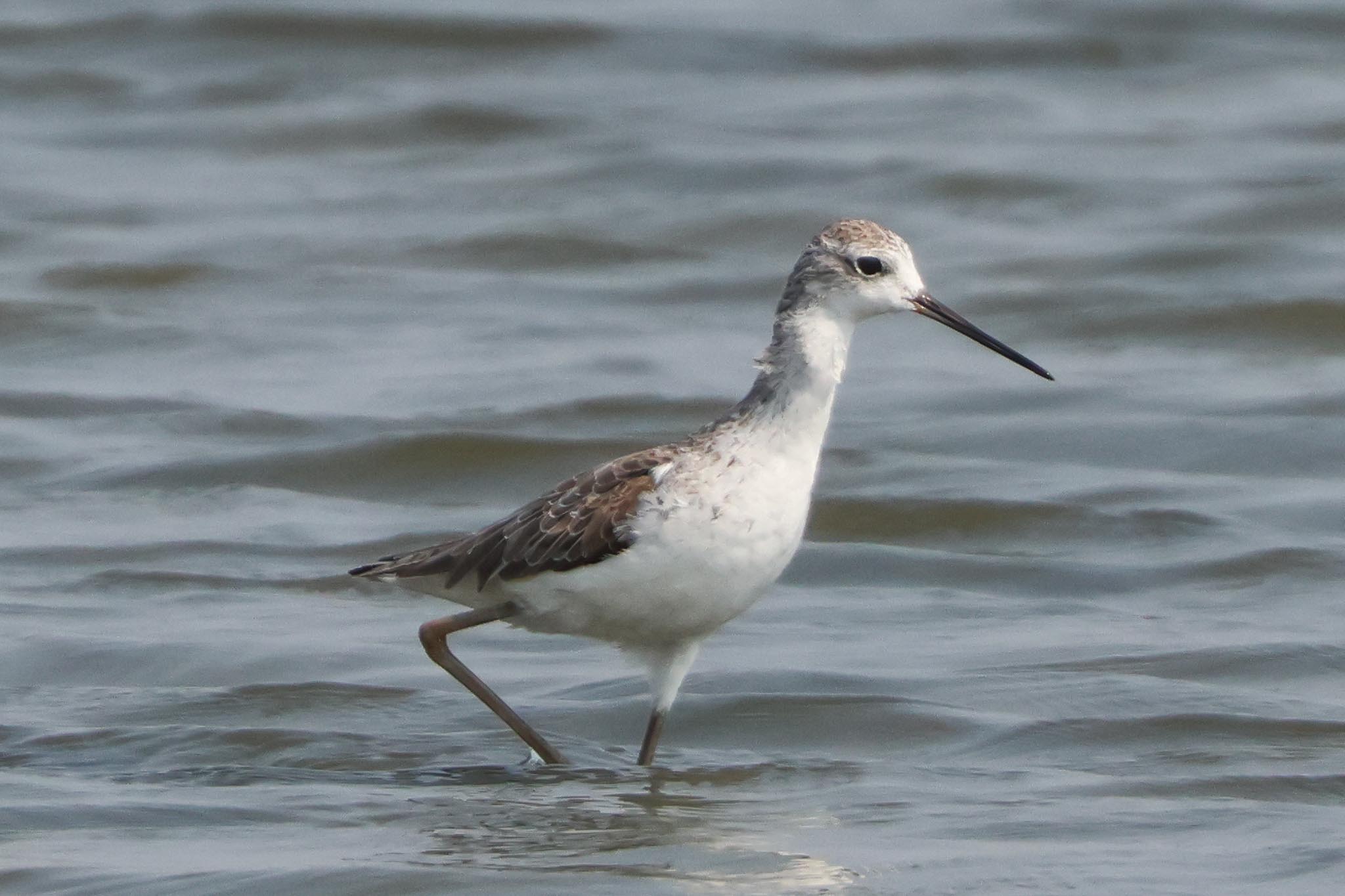
We drove back to the hotel for lunch and than had a couple of hours through the heat of the early afternoon before we had to go out again, so some downtime. A walk round the neighbouring shrimp ponds for those who weren’t resting produced more waders – several Long-toed Stints and a single Temminck’s Stint, a few Little Ringed Plovers, as well as Javan Pond Herons and some Asian Green Bee-eaters.

We met again at 2.15pm, and drove over to Mr Daeng’s for our boat trip out to Laem Pak Bia sand spit. We climbed aboard two boats, the first piloted by Mr Daeng, and motored out through the mangroves. Mr Daeng’s boat kept stopping for birds, Collared and Black-capped Kingfishers in the trees, Little Cormorants on the boardwalk posts, but we got the distinct impression the second boatman didn’t quite know what he was doing.
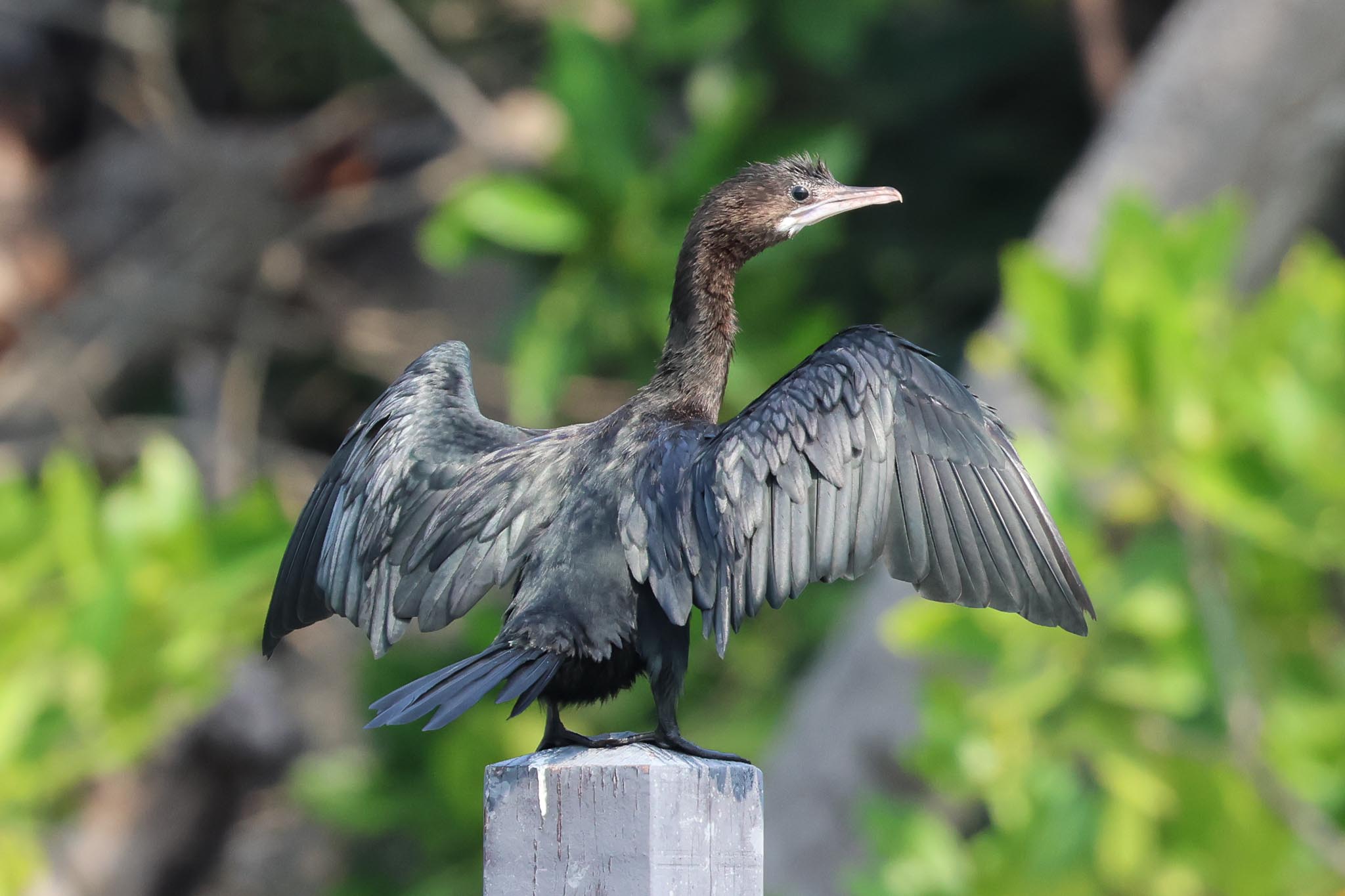
Then out at the sand spit, the second boatman managed to get stuck on an underwater sandbar, while Mr Daeng knew where the deeper channel was and sailed straight past and up to the sandspit. Thankfully, the boatman managed to get his boat off and this time followed the path Mr Daeng had taken in, and we all got out onto the sandpit without having to get our feet wet.
There were no birds on the beach at first, but there were a few people fishing off the rocks at the end, so we walked on round and further down the beach the other side. First we found several Kentish Plovers on the sand, then a pair of Malaysian Plovers and a single White-faced (Swinhoe’s) Plover, which were the main things we wanted to see here. We had good views of them all through the scopes.
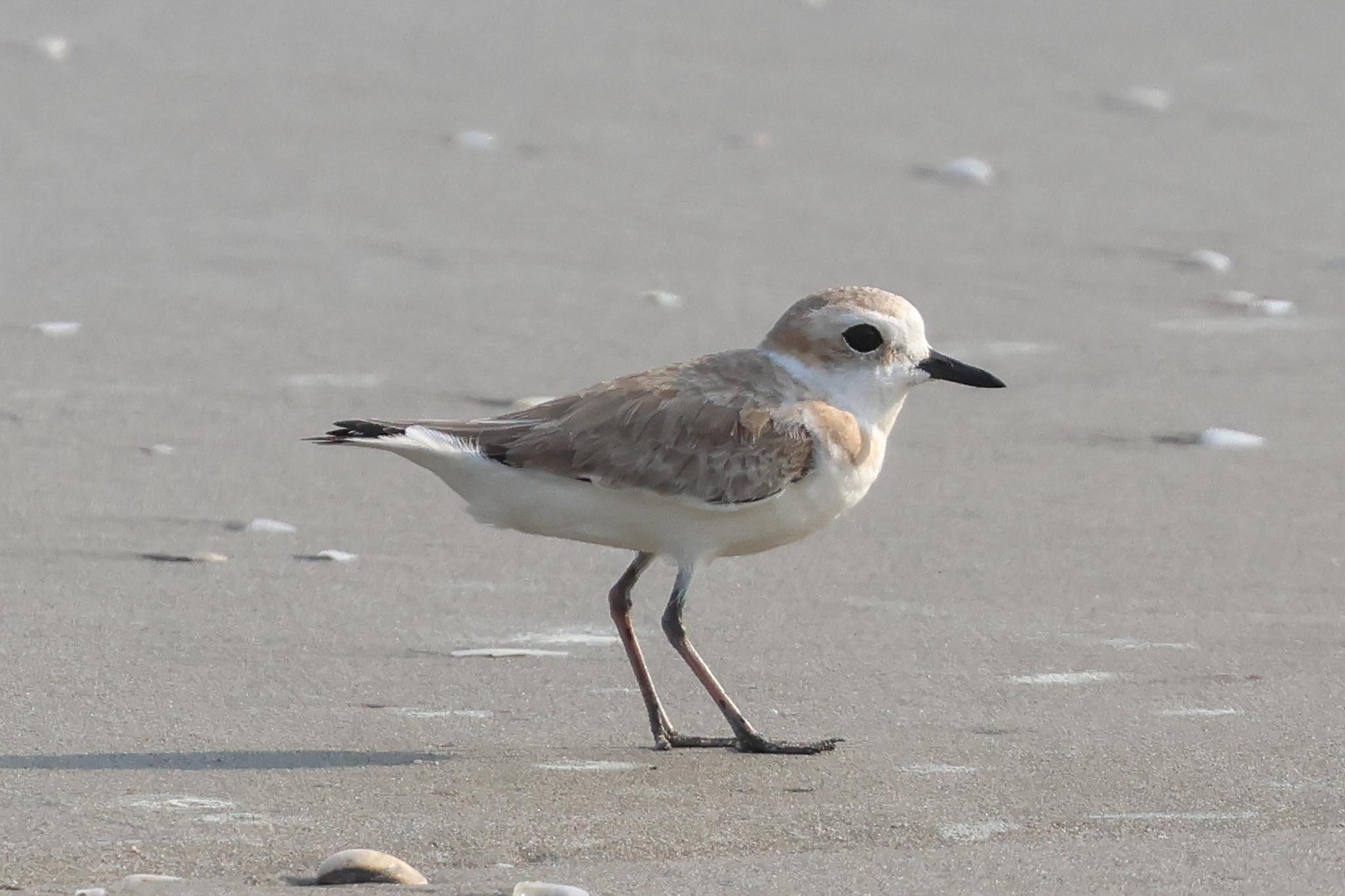
Several Whiskered Terns patrolled up and down the beach, and a White-winged Black Tern flew past further offshore. Two Western Reef Herons flew in and landed with a couple of Great White Egrets on the rocky reefs just offshore, but apparently there have been no Chinese Egrets here this year, another target species which we normally see here. We walked a little further down the beach, from where we were not looking into the sun as much and had better light on the plovers now. The male Malaysian Plover ran past in front of us and sheltered behind a plastic bottle – they get everywhere! The tide was coming in, so we turned to walk back.
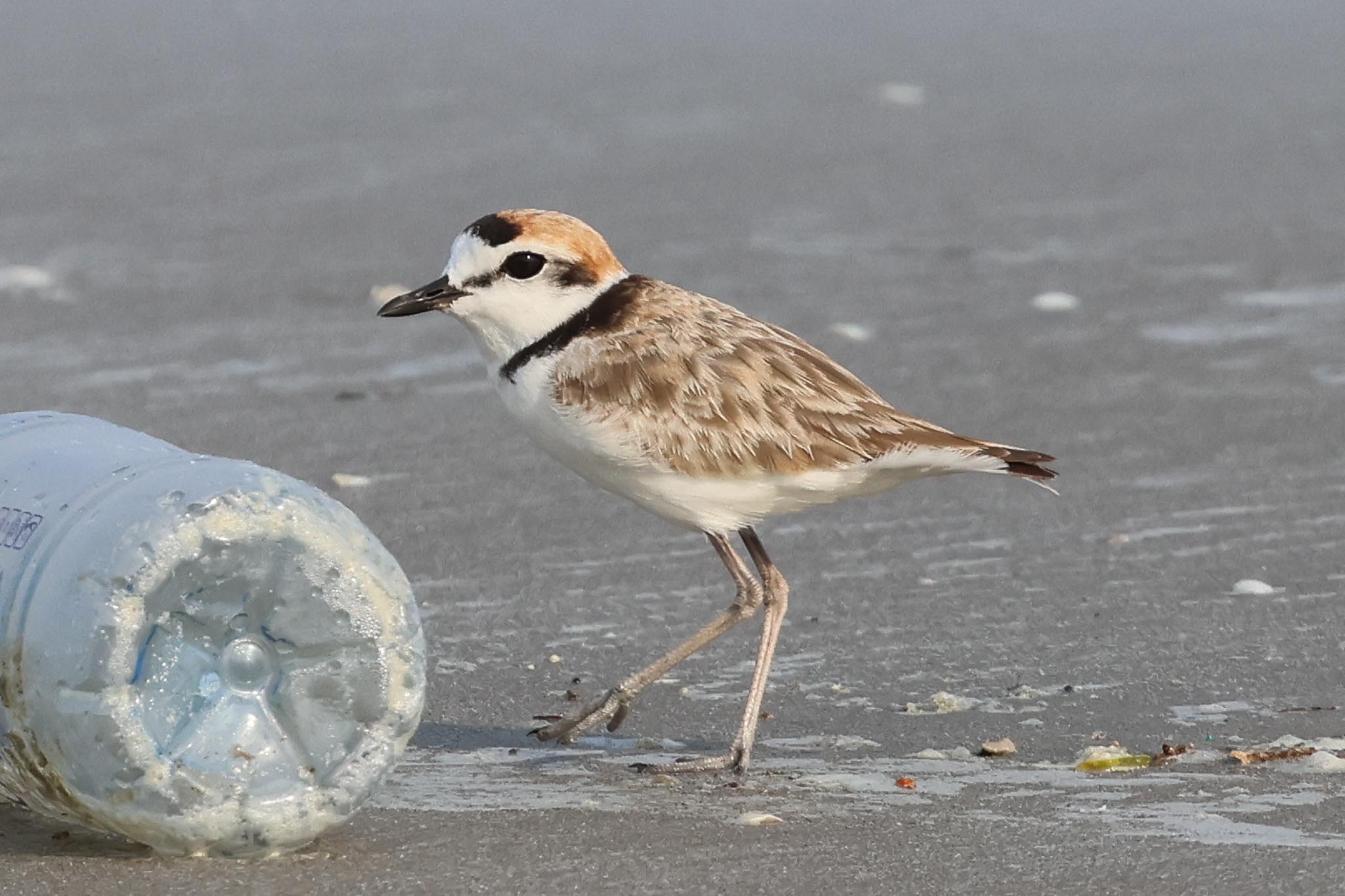
Back on the end of the spit, we stopped to see if we could find a Golden-bellied Gerygone in the mangroves. We could hear one singing, but it was hard to see in the dense vegetation before we eventually picked up one moving through the tops. An Oriental Magpie Robin and a Collared Kingfisher were perched in a dead tree on the edge of the mangroves, and Games noticed a Freckle-breasted Woodpecker very low down on one of trunks – you had to be in just the right place to see it, but we got it in the scope. A couple of Malaysian Pied Fantails were flicking around underneath and a Striated Heron was stalking through the edge of mangroves too.
It was time to head back. On the way, Mr Daeng pulled in under the mangroves which were full of Lyle’s Flying Foxes, while the second boat carried on past. Two Water Monitors were swimming across the channel just beyond and the second boatman ploughed straight over one – he seemed to be in a hurry to get home! Back on dry land, we stopped for several of the group to buy their souvenir Spoon-billed Sandpiper t-shirts, then said goodbye and our thanks to Mr Daeng and his family, before heading back to the hotel.
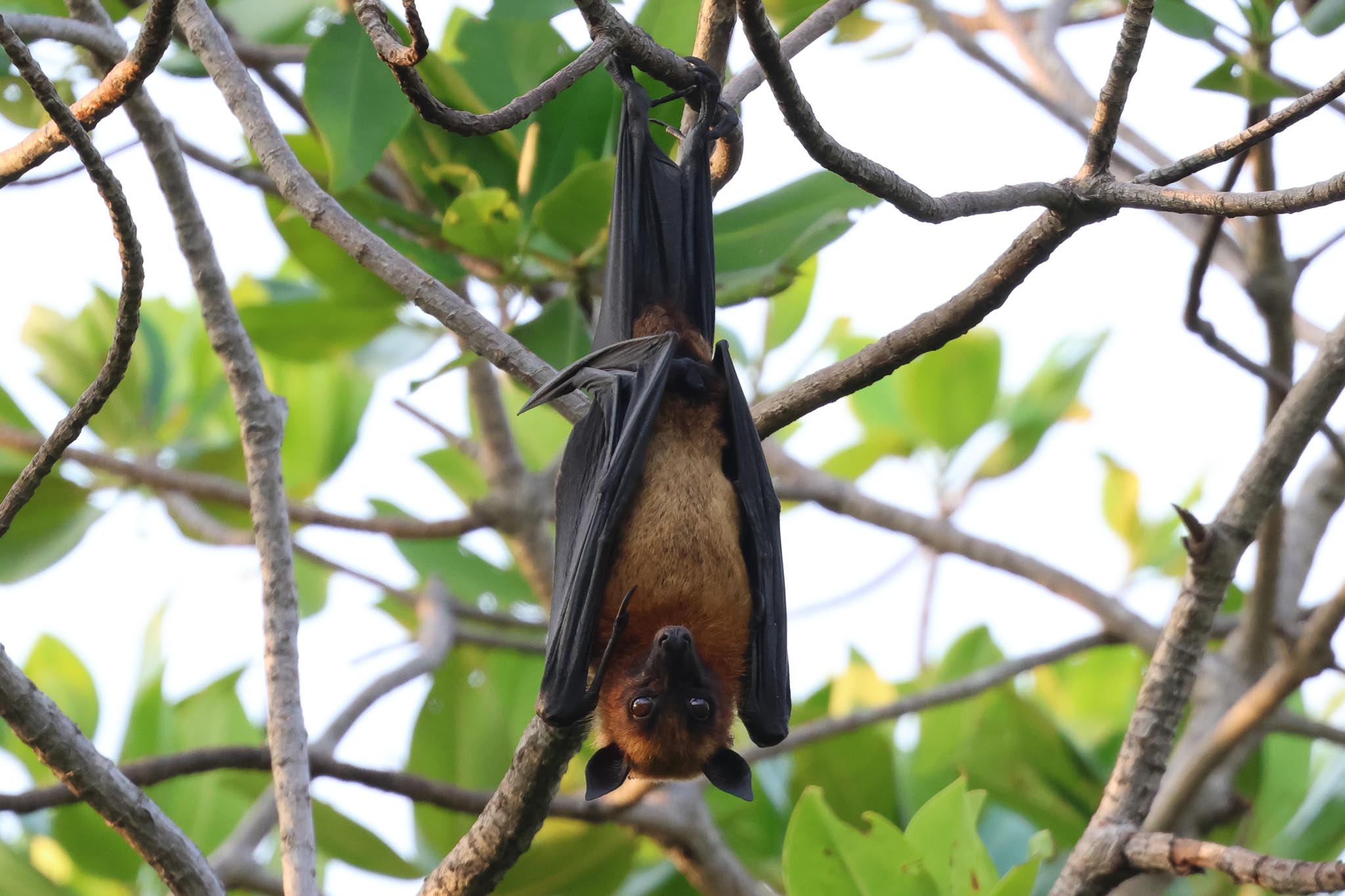
It was still light when we arrived, so we had a quick walk round the shrimp pools beside the hotel. There were several Blue-tailed and Asian Green Bee-eaters on the wires and Streak-eared Bulbuls in the bushes. A Yellow Bittern was mostly hidden in a channel, but further along another flew out and perched up in the reeds, then a third came out of the back of a bush right in front of us. Several Black-browed Reed Warblers and Oriental Reed Warblers flicked around in the reeds too. We had nice views of several Pond Herons, apparently all Javan here on the coast but mostly impossible to identify in non-breeding plumage at this time of year, and a Purple Heron and a Night Heron flew over. A Common Kingfisher flew in and landed at the back of one of the pools.
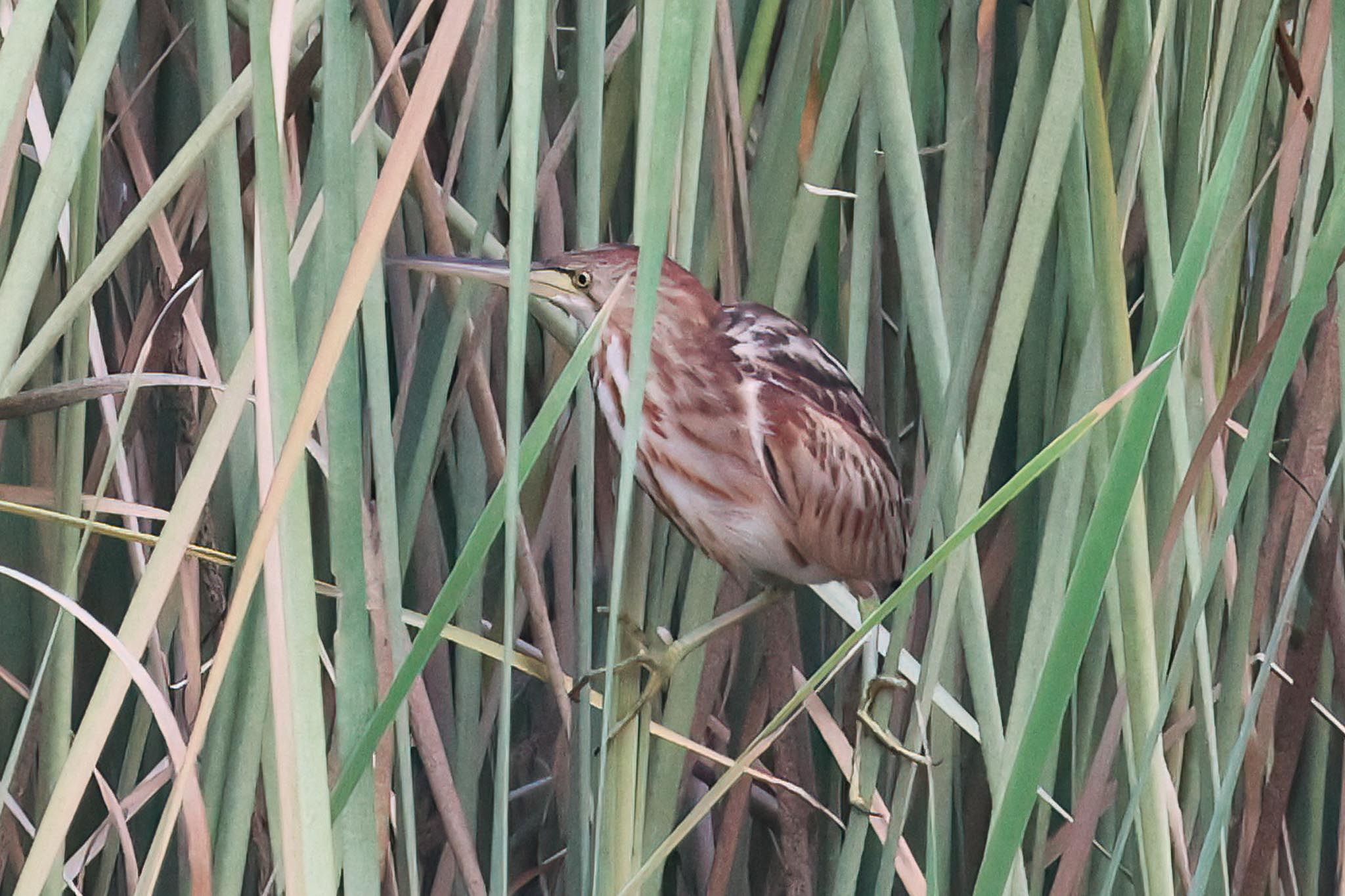
There were not so many waders on the pool further back now, where they had been earlier, so we cut in through the gate at the back of the hotel, with time still for a welcome shower before dinner. We walked over to the neighbouring resort for dinner and while we were eating a Barn Owl called several times behind us. What a great day!
Monday 29th January
Over breakfast Games had heard an Indian Nightjar in the field opposite reception, but by the time we had finished eating there was no sign of it now. We were heading inland later today, but we would spend the first part of the morning back down towards the coast. We had a quick stop on the road overlooking some pools, which were mostly dry but can be a good area for pratincoles. There were lots of egrets commuting out of their roost, along with Painted Storks, a Night Heron and two distant Oriental Darters which all flew over. A Dusky Warbler was calling from the ditch in front.
Further on, we pulled off the road onto a track through an area of saltpans and drove out towards an abandoned building in the middle. There were some large flocks of Red-necked Stints on the mud, but they kept flying round and wouldn’t settle long enough to see clearly whether there might be anything more interesting with them. Lots of Indian and Little Cormorants flew back and forth over the track, and more were feeding actively in the deeper pools, along with several Painted Storks. A distant line of Lesser Whistling Ducks was standing on a tall bank. At least a dozen Spotted Redshanks were feeding on one of the nearer pools, and an Eastern Yellow Wagtail flew overhead calling buzzily before landing on the track.
We tried another site, where there were more waders out on the saltpans but they were mostly very distant. A couple of Terek Sandpipers were a little closer, a Thick-billed Warbler was calling from the scrub by the track, and then a Golden-bellied Gerygone started singing in a thin line of mangroves, although it was still surprisingly hard to see. We flushed two Ruddy-breasted Crakes while we were looking, but they disappeared straight into thick cover. A Chestnut Munia perched up briefly in the distance and a couple of Eastern Marsh Harriers flew over the back of the saltpans. Driving towards Pak Thale, we stopped to scan some large flocks of waders on the saltpans just before the village – lots of Red-necked Stints, Lesser Sandplovers, flocks of knot whirling round further over and a long line of posts over on the edge of the sea beyond mostly had a Whimbrel on top of each one but surprisingly no curlews. Another 400 or so Lesser Whistling Ducks were on a bank across the middle of the saltpans on the other side of the road.
We had a quick stop at the 7-11 in the village for supplies, then headed back out to Pak Thale saltpans. There had been a Chinese Egret here yesterday, found by Mr Daeng after we had left, so we wanted to make a quick visit to see if we could catch up with that. Games phoned Mr Daeng now and he had just found a Spoon-billed Sandpiper again, not far out along the main track, so as we drove out onto the saltpans we were dropped off and walked straight out. Unfortunately it had just been flushed by an over-excited photographer before we got there – so we gave thanks that we had seen the one yesterday and continued on out towards the beach to look for the egret. It was cloudier today and with a stronger onshore breeze, and there were noticeably fewer waders than there had been yesterday, particularly on the pools further out. Thankfully Games quickly picked up the Chinese Egret further over, and even though it disappeared behind a bank before everyone could see it at first, when we walked over we found lots of Great White and Little Egrets feeding feverishly along the edges of a narrower channel, and the Chinese Egret was with them. We had nice views now, noting its yellow bill, pale greenish legs and shaggy crest. As it moved further away with the throng of egrets, we walked back on the bund through the middle.
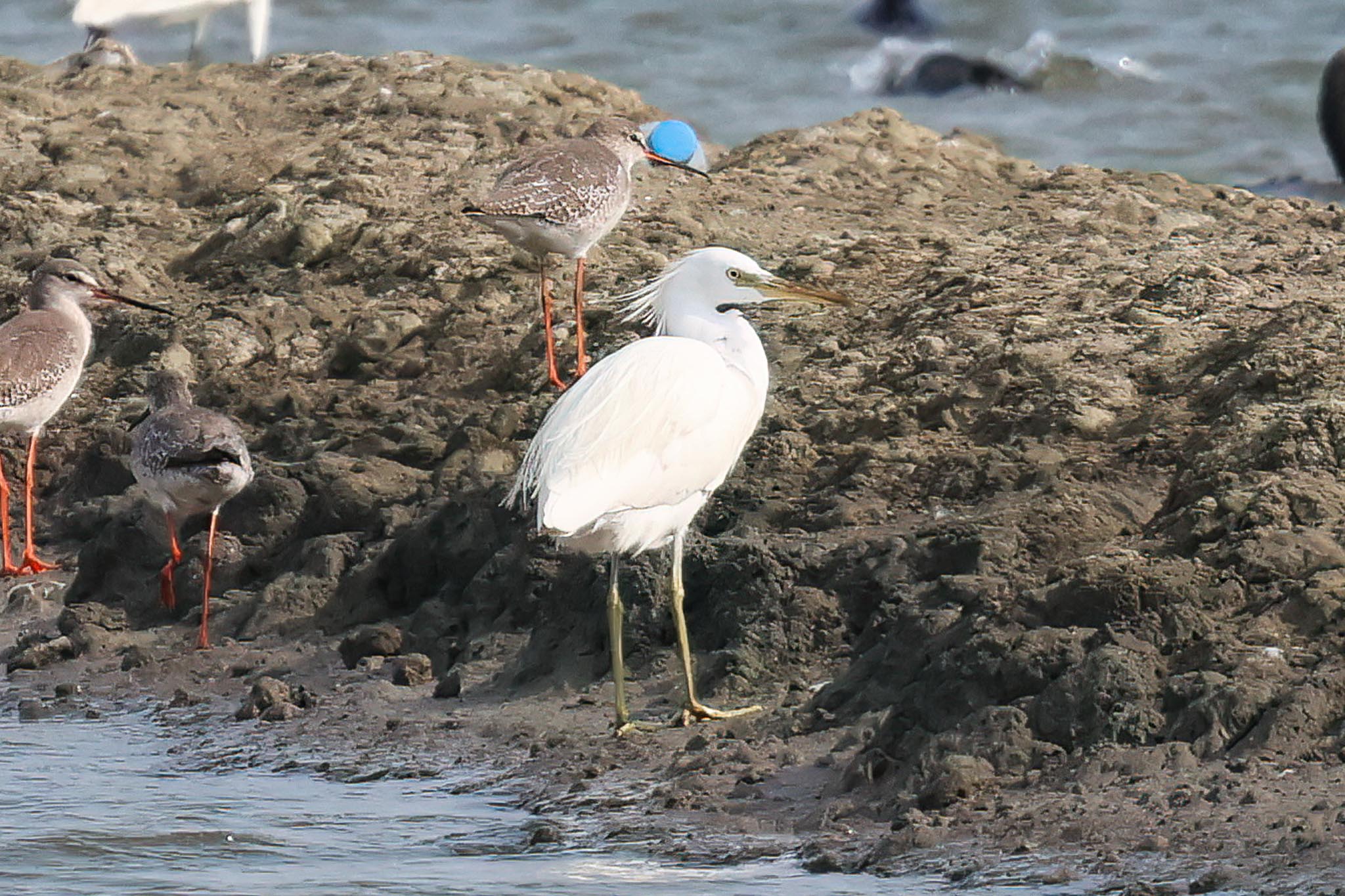
Now we drove inland, to our next stop at Baan Maka resort, just outside Kaeng Krachan National Park. It was almost lunch time when we arrived, so we sat down in the restaurant for a cold drink. The resident tame Blue Whistling Thrush and several Grey-bellied Squirrels were hanging around for scraps. After lunch, we checked in and had some time for a rest or to walk round the extensive grounds. A Black-thighed Falconet was hunting down by the lake and caught a small bird which it carried up into the top of a nearby dead tree to pluck, so as the rest of the group assembled to head out for the afternoon, we walked over to see it.
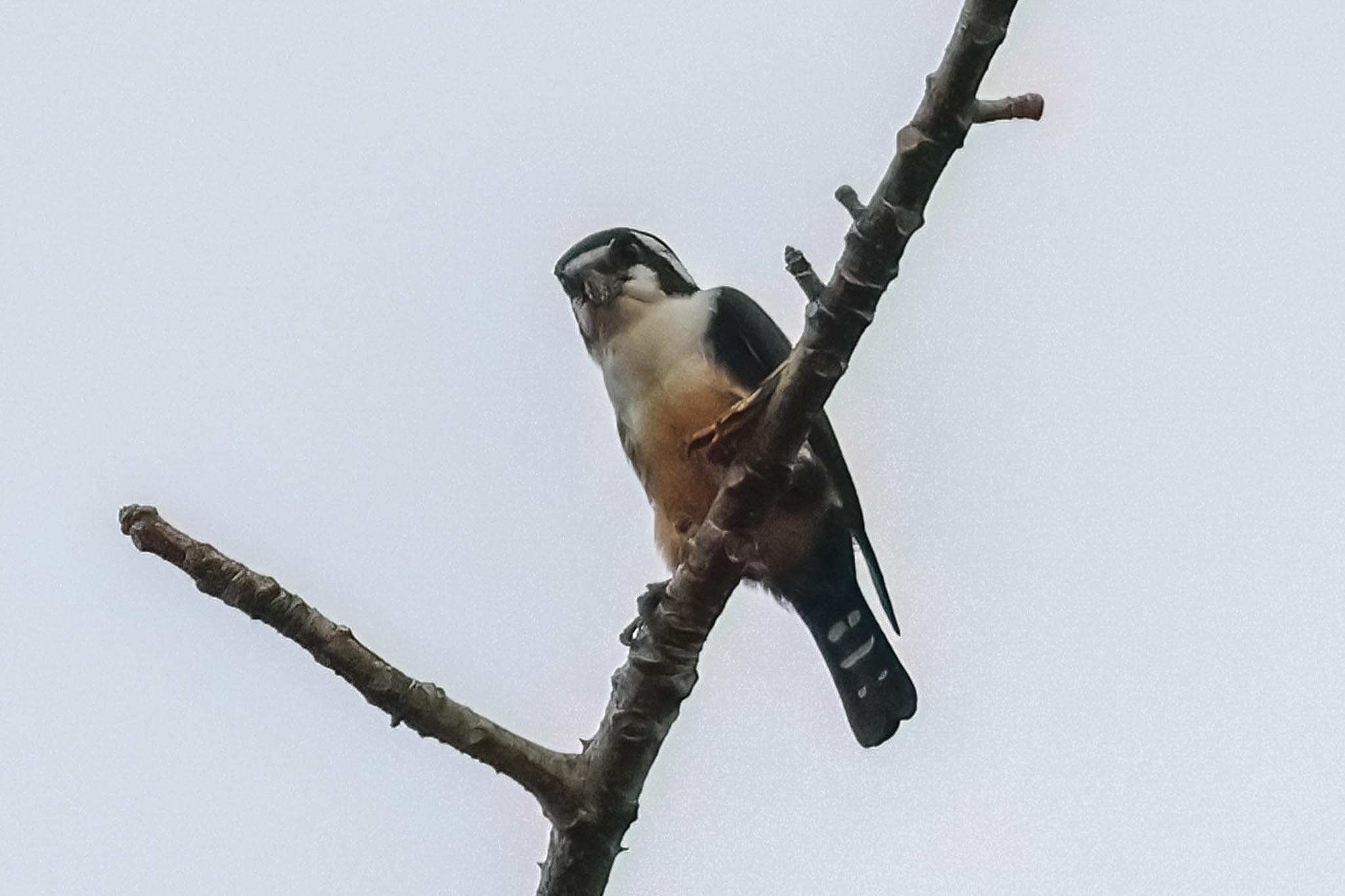
Then we piled into the back of two 4x4s for the journey out to a nearby hide on the edge of the National Park. Several Indochinese Rollers and Chestnut-headed Bee-eaters were perched on the wires by the road and lots of Cattle Egrets were following a tractor which was ploughing in a field. We stopped to look at an Oriental Honey Buzzard which circled over and a group of about a dozen Oriental Pied Hornbills which flew across the track, with one perching up nicely in a dead tree the other side.
On to the hide and we settled in, while Mr Bird put out water and food. At first, it was mainly squirrels which came in – as well as more Grey-bellied and lots of Burmese Striped Squirrels, at least one Indochinese Squirrel appeared, followed by a couple of Northern Treeshrews and then one or two Lesser Mouse Deer. A mixed flock of Greater and Lesser Necklaced Laughingthrushes dropped in quickly too, and would be present pretty much constantly, good to see alongside each other for comparison, and a small noisy group of White-crested Laughingthrushes paid a couple of visits too. A pair of White-rumped Shama lingered in front of the hide along with at least four Asian Emerald Doves, and other birds came and went all the time.

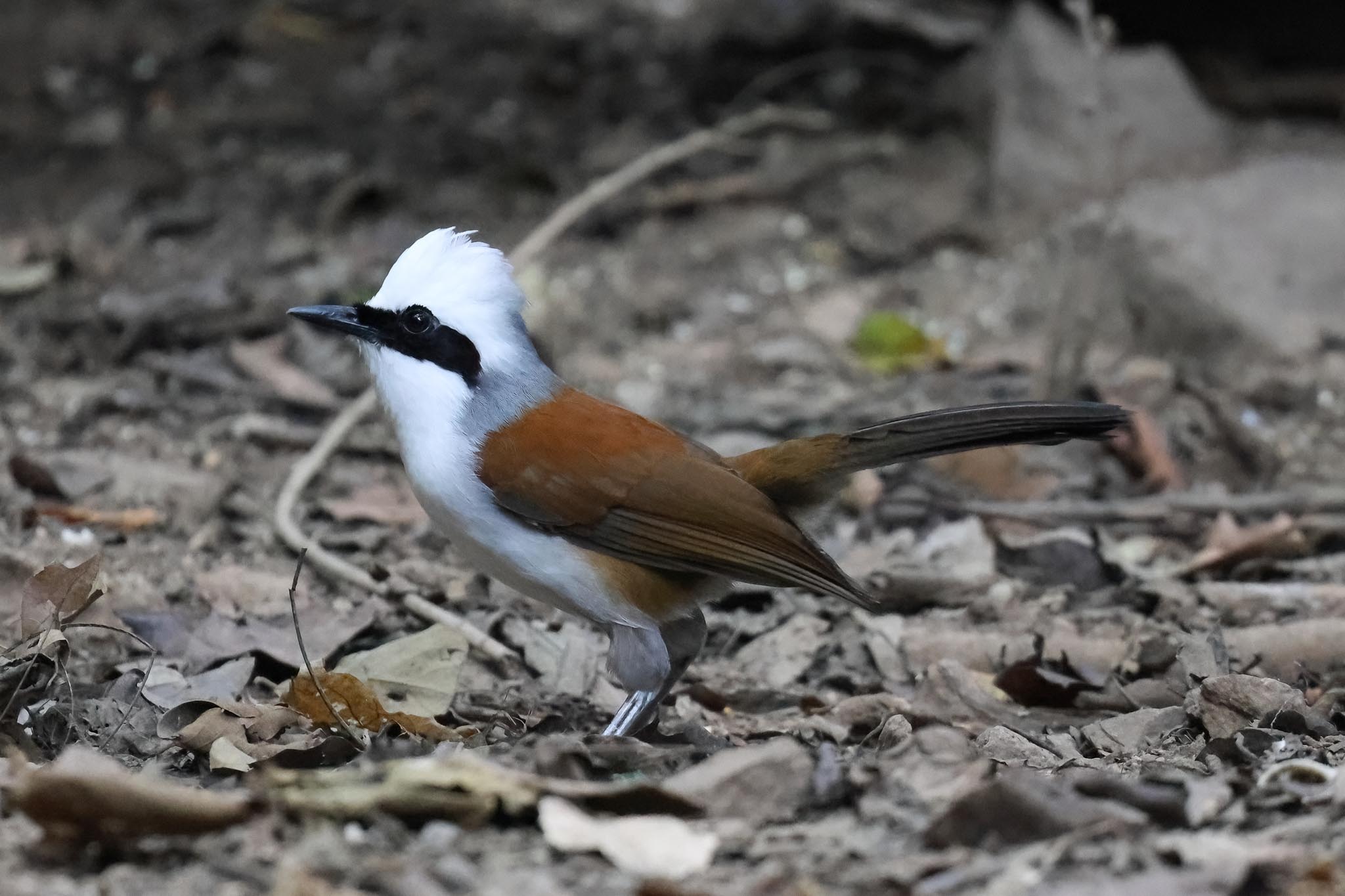
Several Red Junglefowl appeared at the back, the females venturing out first, the male hanging around behind in the trees until it eventually gained the courage too, so by the end we had seen at least four males and seven females. A pair of Scaly-breasted Partridges and later a pair of Bar-backed Partridges came in to feed too.

The woodpeckers came in for the mealworms pushed into a couple of the treetrunks, first a pair of Common Flamebacks allowed great close views, followed by a Greater Yellownape a bit further back. There were Puff-throated Babblers, a brief Large Scimitar-Babbler and later on several Pin-striped Tit-Babblers and two Abbott’s Babblers.
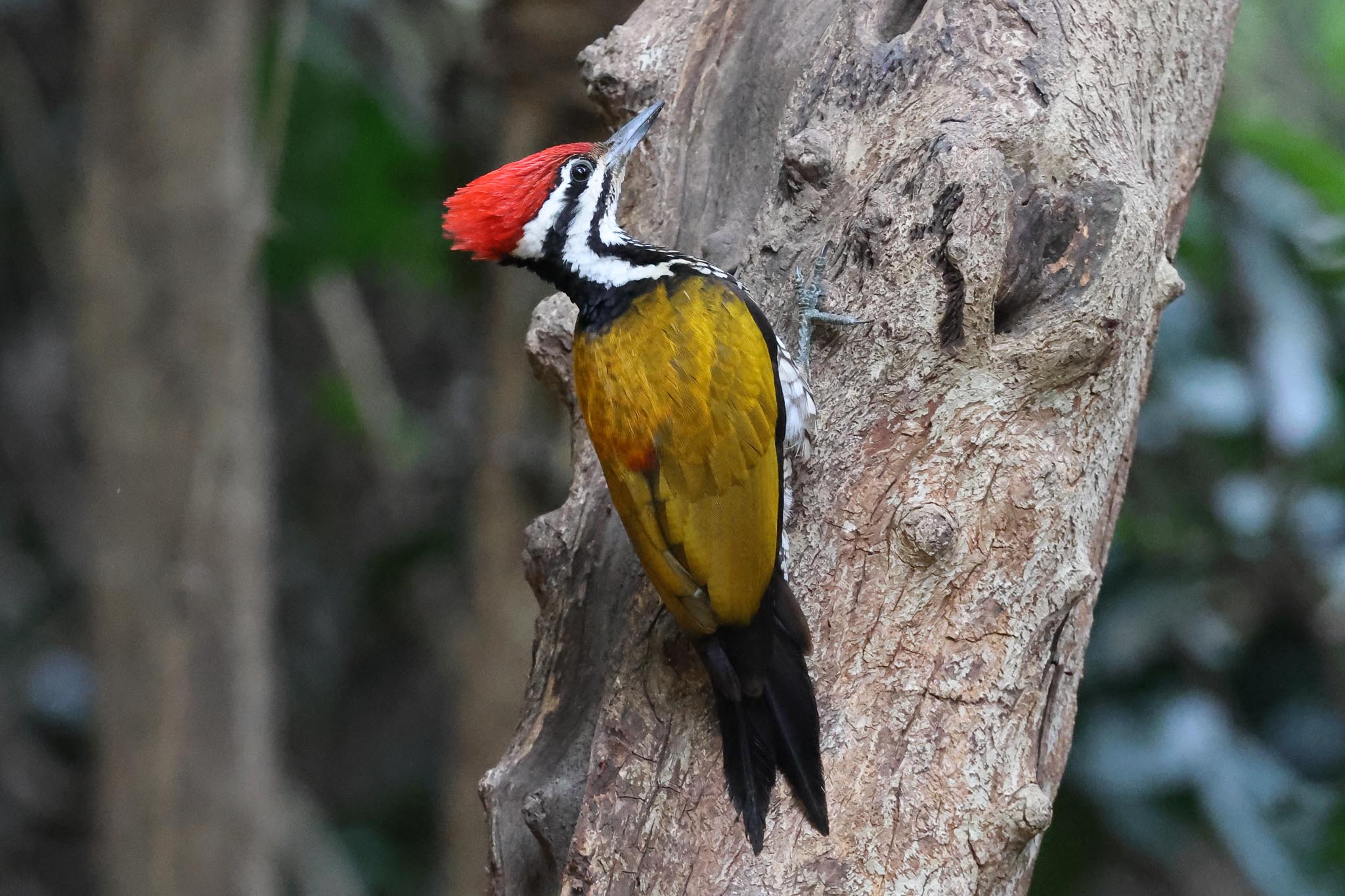
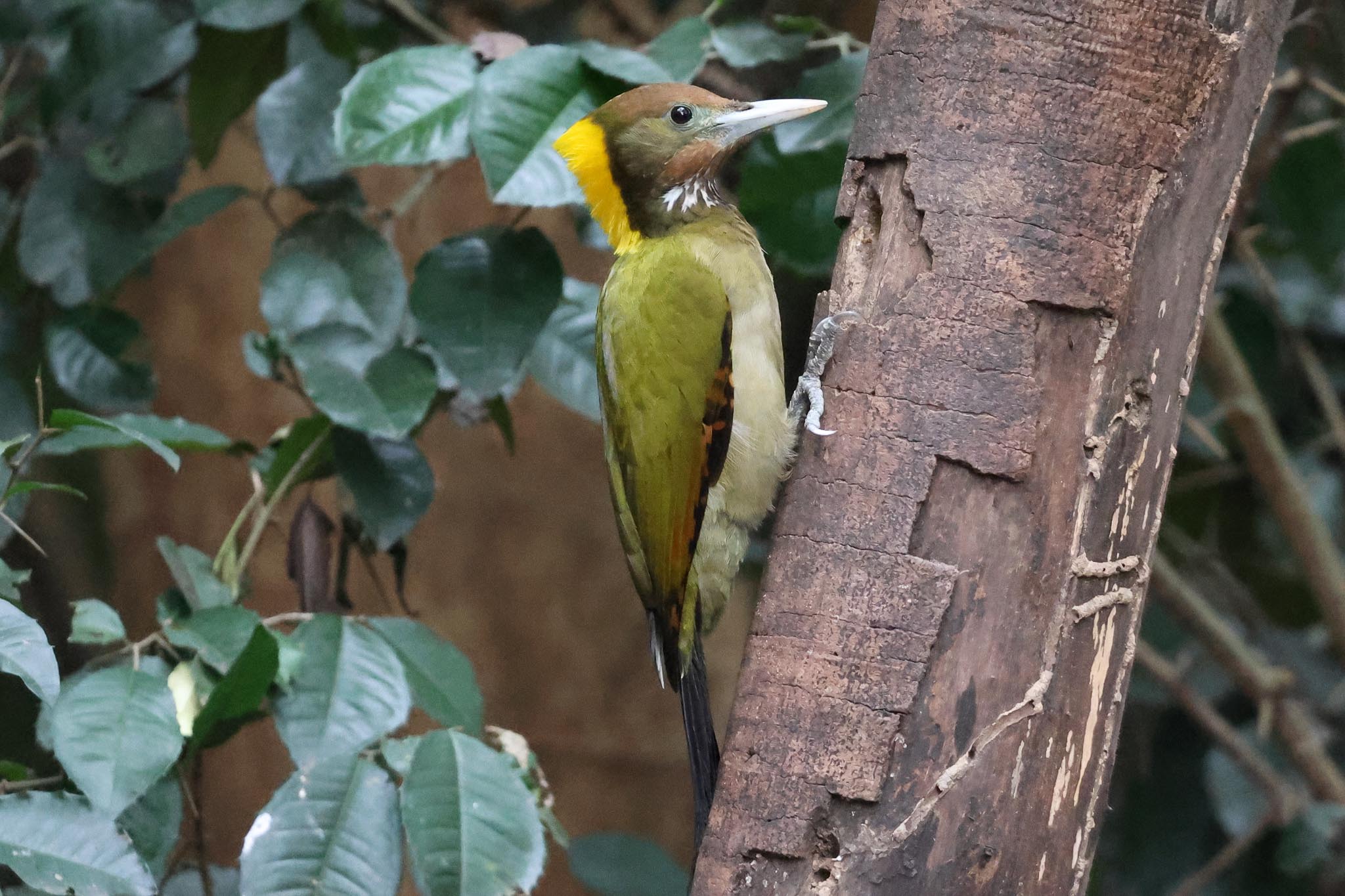
Several Black-naped Monarchs flitted in and out regularly, along with both Indochinese and Chinese Blue Flycatchers giving us a good chance to see the differences between them, and a single Hainan Blue Flycatcher. There was a Greater Racket-tailed Drongo and a flock of Brown-cheeked Fulvettas too.
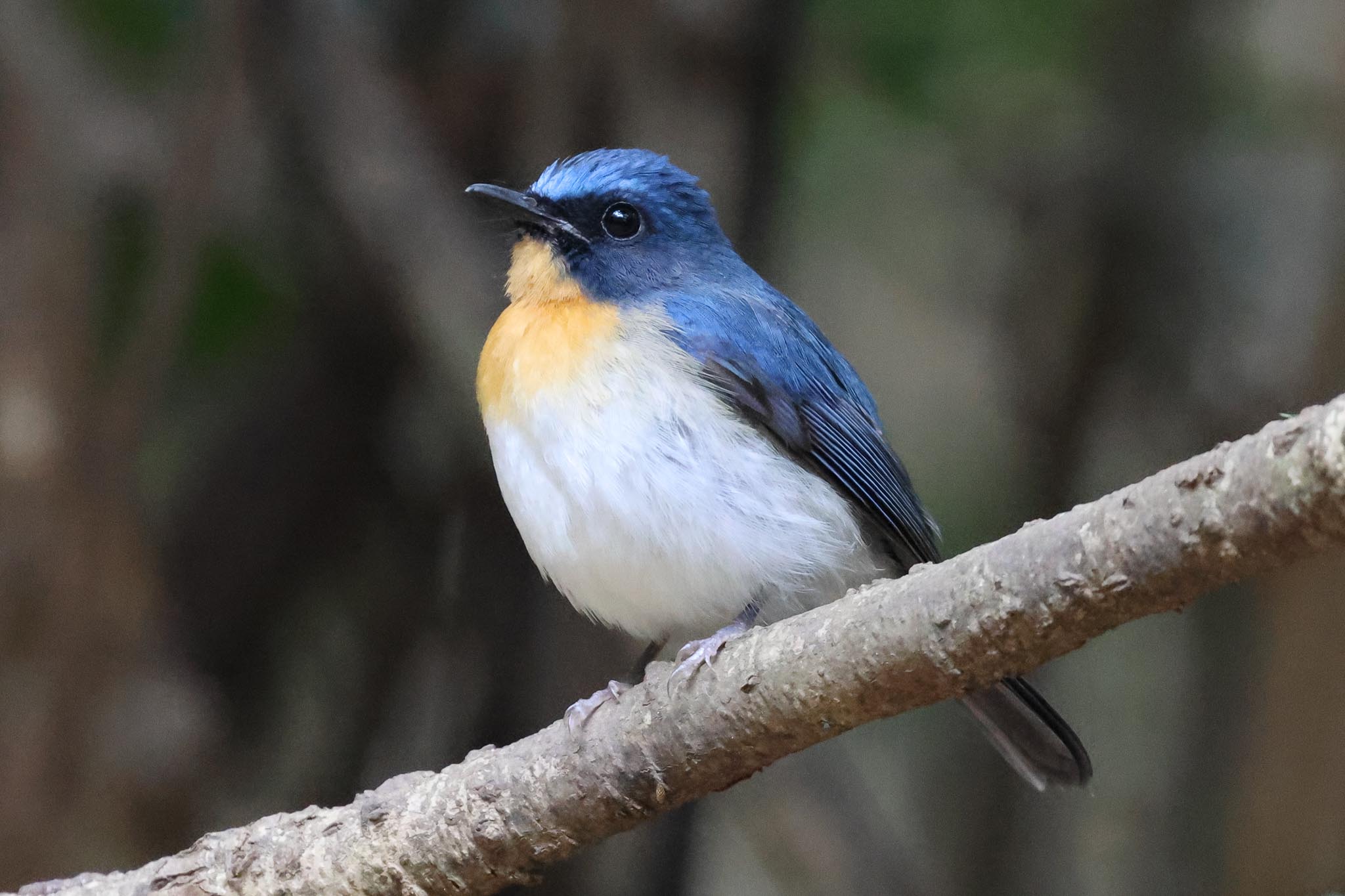
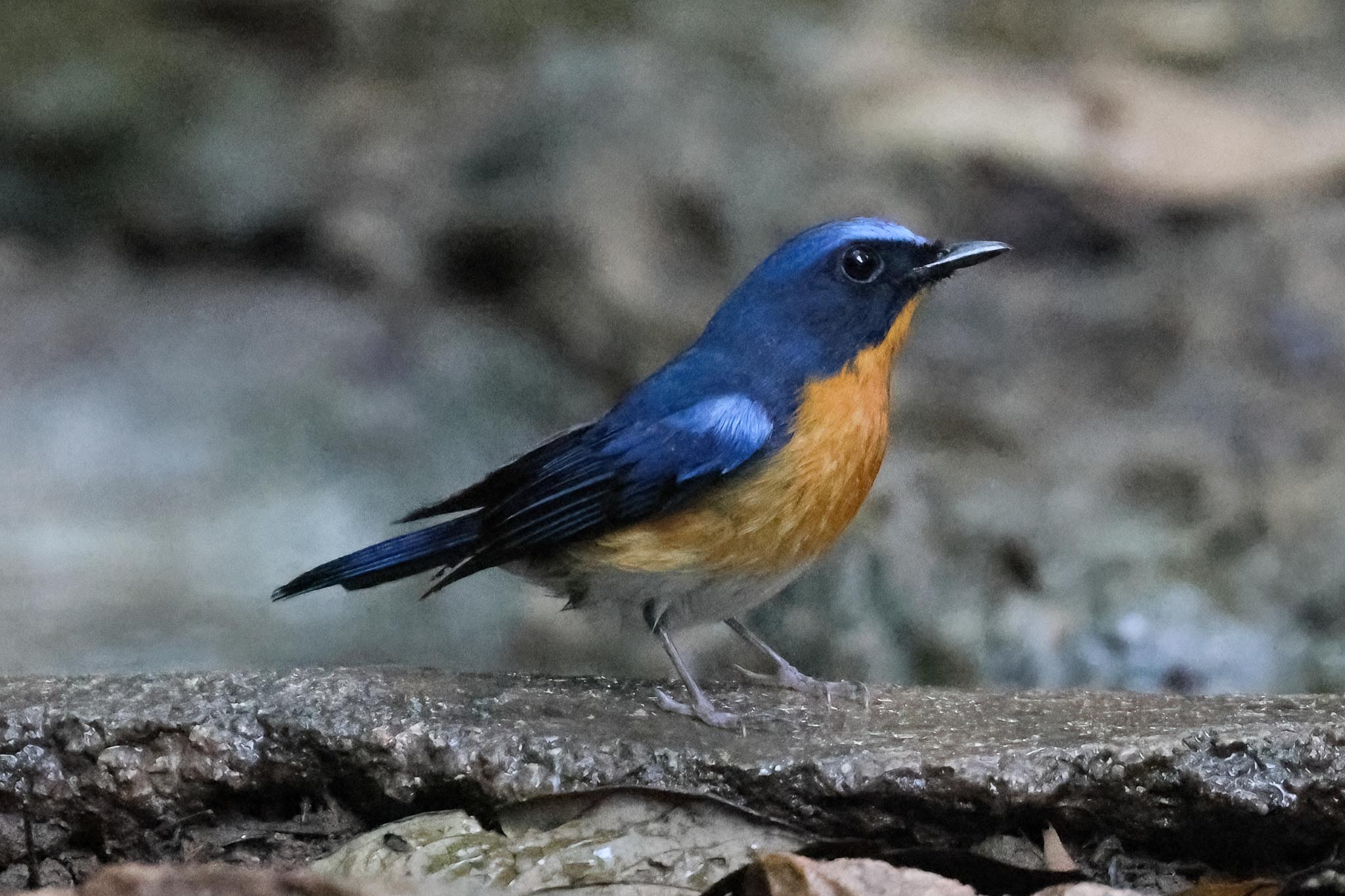
We were planning to leave about 5.30pm, but suddenly the activity level picked up noticeably. A Racket-tailed Treepie dropped in and the numbers of flycatchers and babblers increased, all coming in to bathe before going to roost. Several Siberian Blue Robins appeared, including a very smart adult male and two others which looked like an adult female and a 1st winter male. A Malaysian Pied Fantail appeared just as the light was fading.
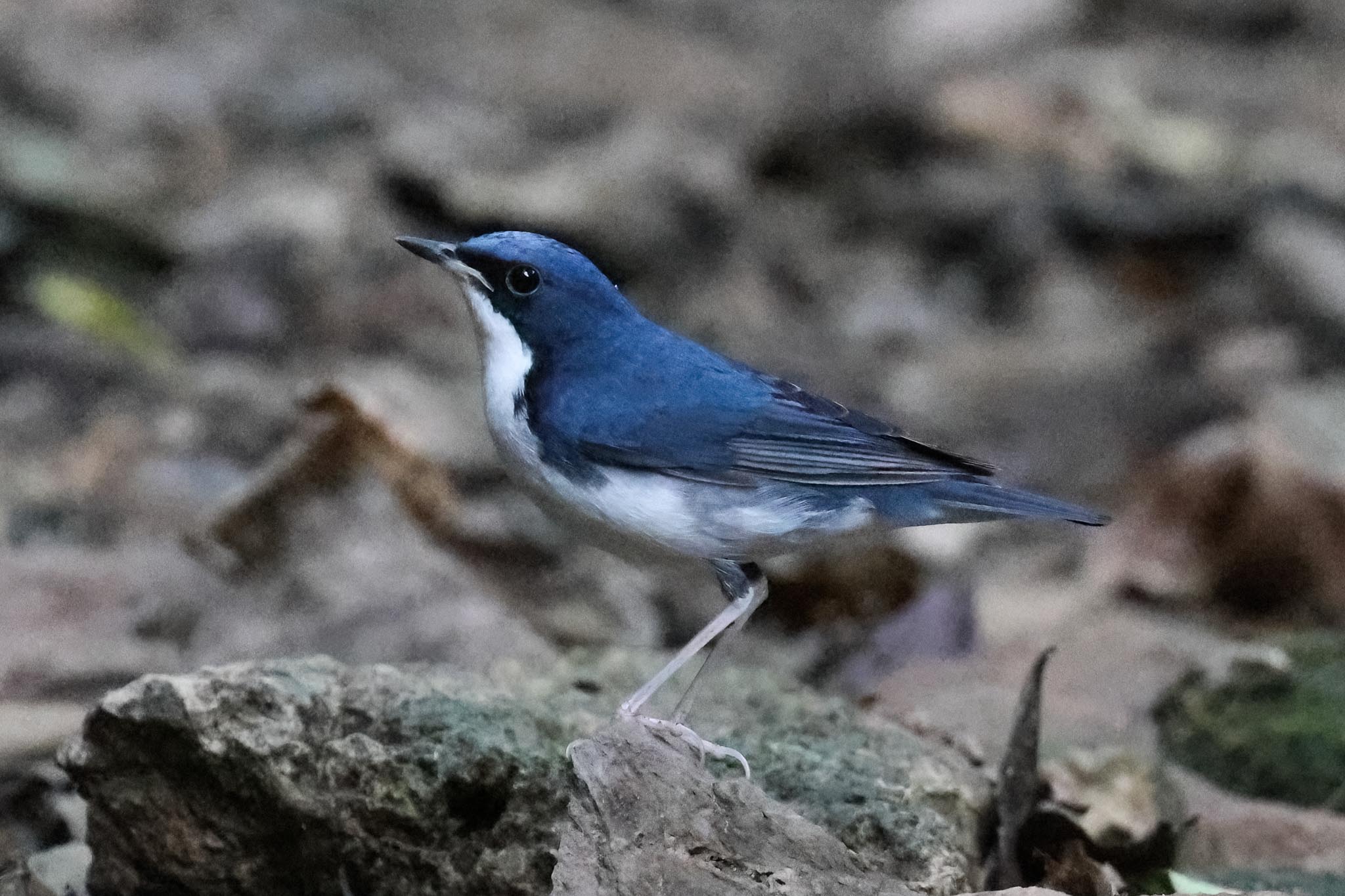
We eventually managed to tear ourselves away and boarded the trucks for the journey back, but we stopped again to look at a small ploughed field where we eventually counted a total of five Indian Thick-knees and thirteen Red-wattled Lapwings.
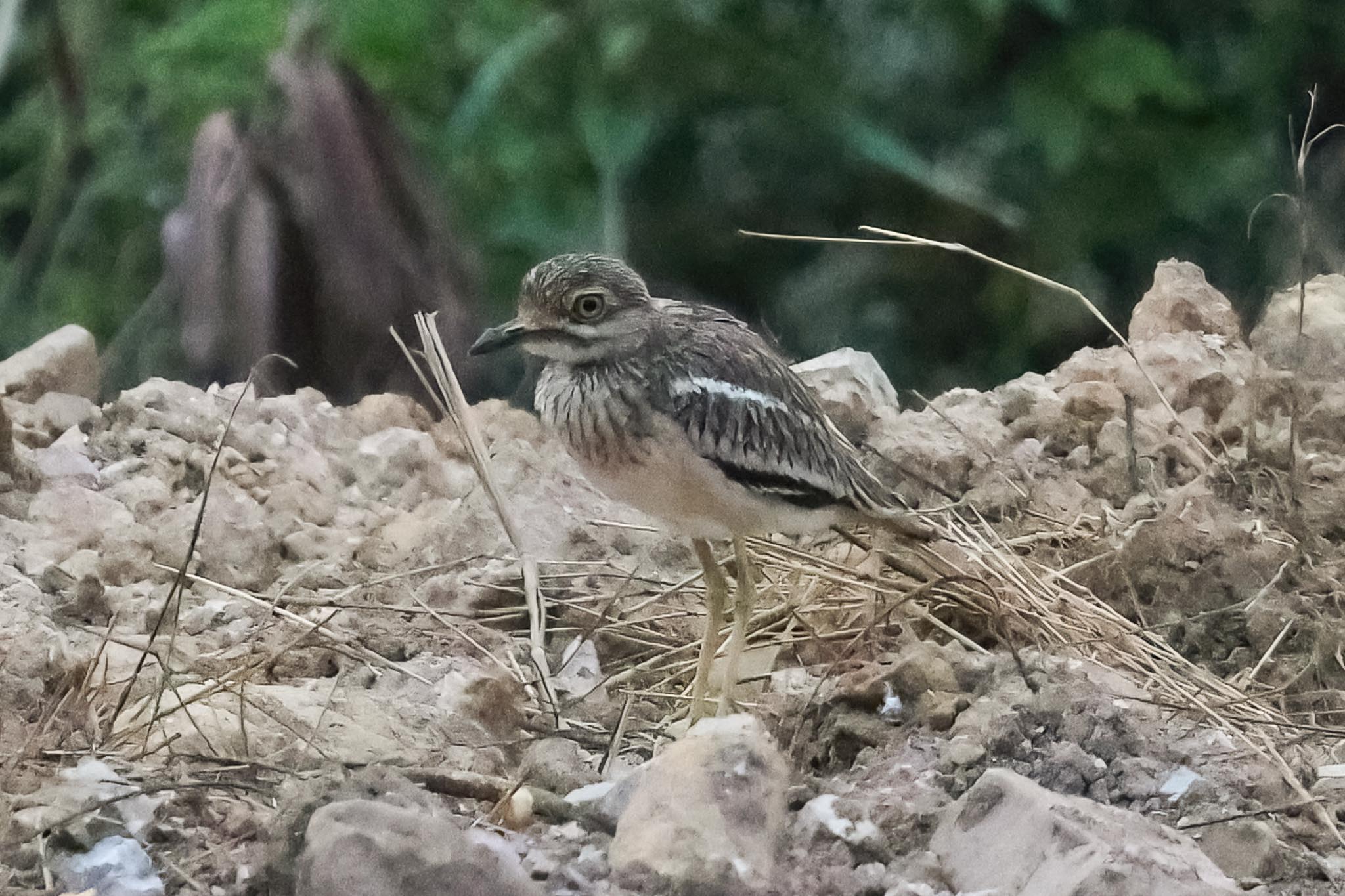
We pulled in again at the bar on the edge of the Baan Maka kitchen garden for a cold beer and to watch the last of the sunset behind the hills. A couple of Large-tailed Nightjars started calling, and we managed to see one flying round in the torchlight, landing at one point but a bit distant so we could just make out its eye glowing, before we headed back for dinner.
Tuesday 30th January
After breakfast, we headed straight up into Kaeng Krachan National Park this morning and after Games got our tickets at the gate, we stopped again at km 9. There were several Black-naped Orioles, Ashy Drongos of one of the white-cheeked Chinese subspecies, an Asian Brown Flycatcher flycatching, and two Thick-billed Pigeons perched in the trees, the first of several. There were Black-crested Bulbuls, Stripe-throated Bulbuls and Olive Bulbuls feeding in the fruiting trees, along with several Blue-winged Leafbirds, Ornate Sunbirds and a Scarlet-backed Flowerpecker. A Green-eared Barbet started calling which we got in the scopes, with Blue-eared Barbet and Coppersmith Barbet here too, and a Black-winged Cuckooshrike. Several small Vernal Hanging Parrots flew over calling.

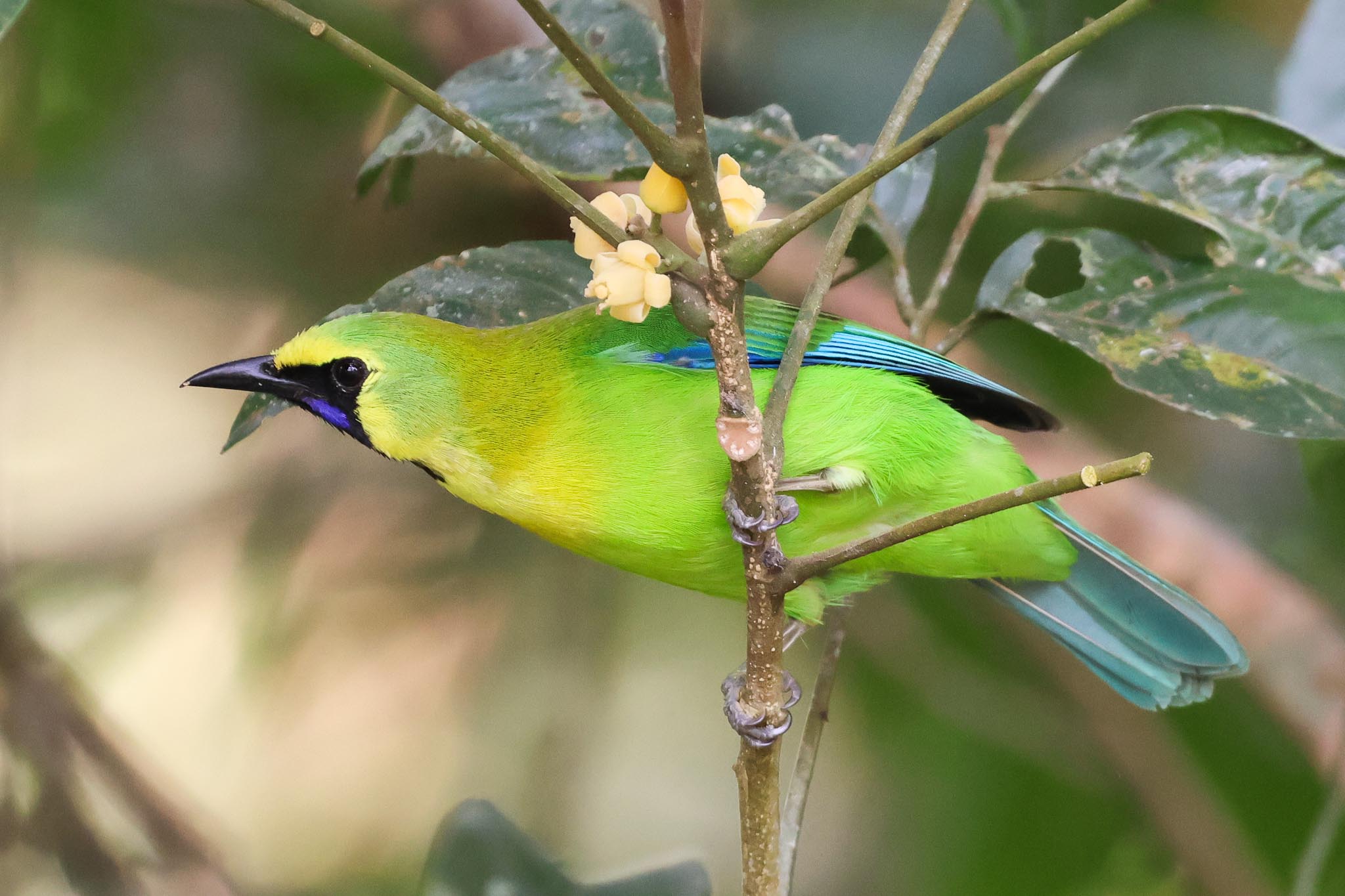
A succession of Oriental Pied Hornbills flew over the road and Games heard a Great Hornbill calling, which she found perched in a very distant tree on the top of a far off hill, we could see its massive bill through the scopes. A couple of Sultan Tits, the largest tit in the world, were rather distant too at first, but gradually worked their way closer until they landed in the tree right above our heads, where a pair of Common Hill Mynas were going in and out of a hole with nest material. Several Germain’s Swiftlets and Asian Red-rumped Swallows were hawking overhead.

We walked along the road down to the bridge, listening for broadbills but we couldn’t hear any this morning. A pair of Black-naped Woodpeckers were chasing each other through the trees behind the pool, where several Black-naped Orioles were perched in the sunshine along with a pair of Golden-crested Mynas. A White-throated Kingfisher was motionless on a branch just behind the pool and a Red-wattled Lapwing was down on the mud.
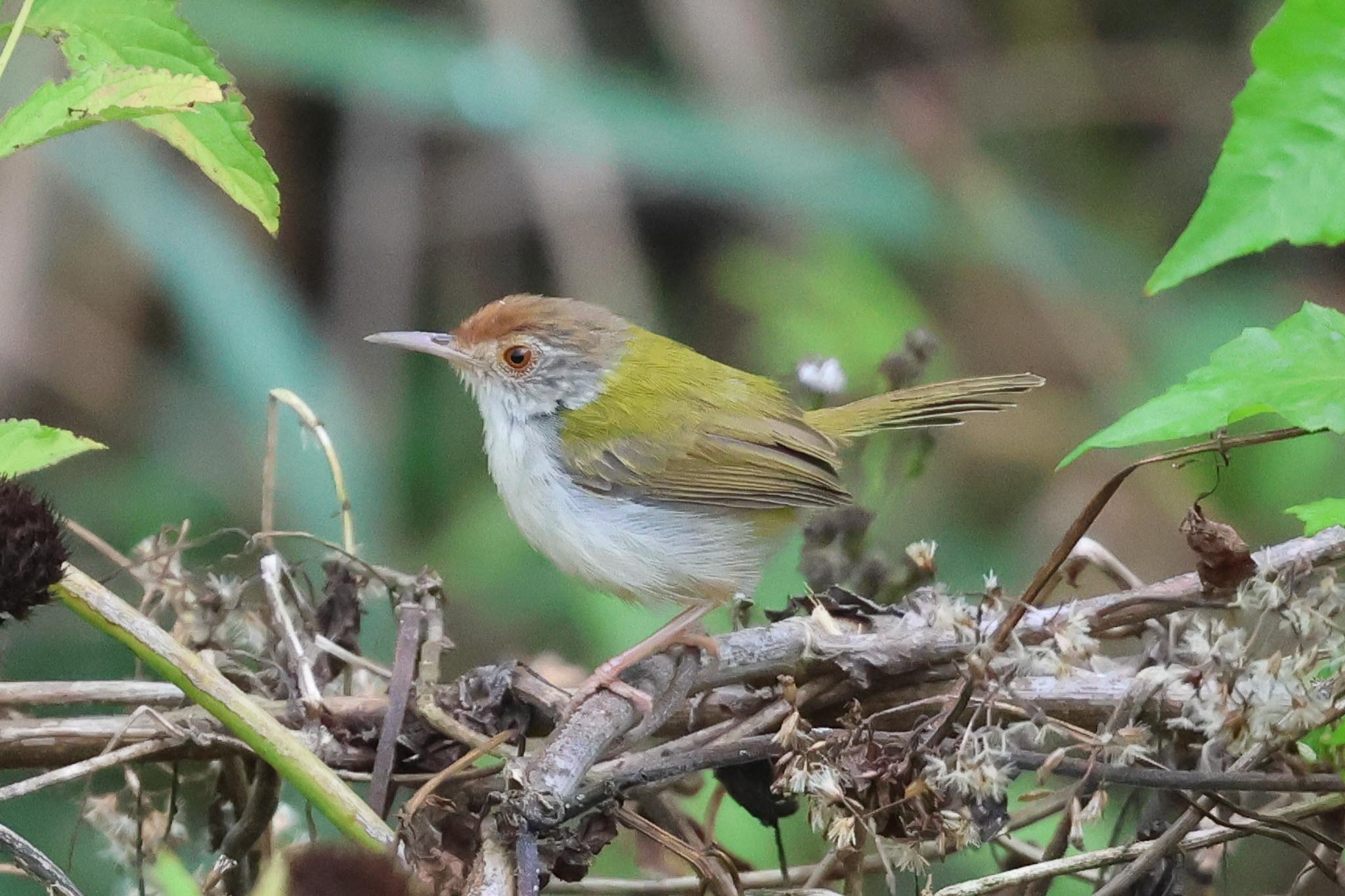
The minibus drove down and picked us up and we continued on to the campsite. A Common Tailorbird was climbing around in the tangled vines in the garden in front of where we parked, and there were a few Bar-winged Flycatcher-Shrikes and Large Woodshrikes in the trees in the car park, along with a couple of Brown-rumped Minivets and a selection of butterflies which we admired while we stopped to use the facilities. A tall fruiting tree was attracting a variety of leafbirds, including a brief Golden-fronted Leafbird, along with a smart male Crimson Sunbird and a rather plainer Thick-billed Flowerpecker. It was warming up now and looking at the hillside beyond we found first a Crested Goshawk and then an Oriental Honey Buzzard circling up.
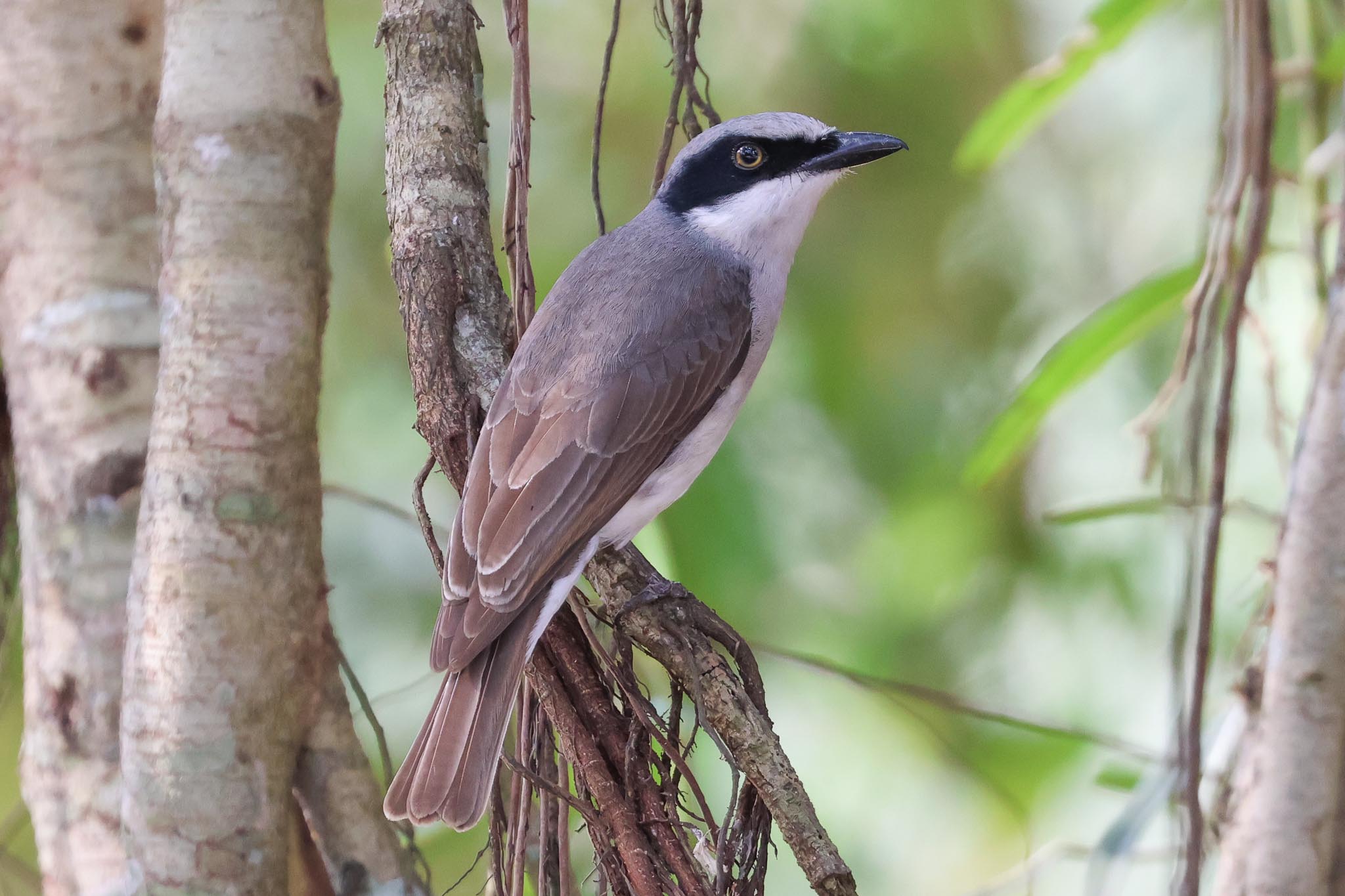
People were apparently watching a Banded Kingfisher in the trees at the back of the campsite, so we hurried over now and were treated to some great fill-the-scope views of a male of what has to be one of the smartest kingfishers around.
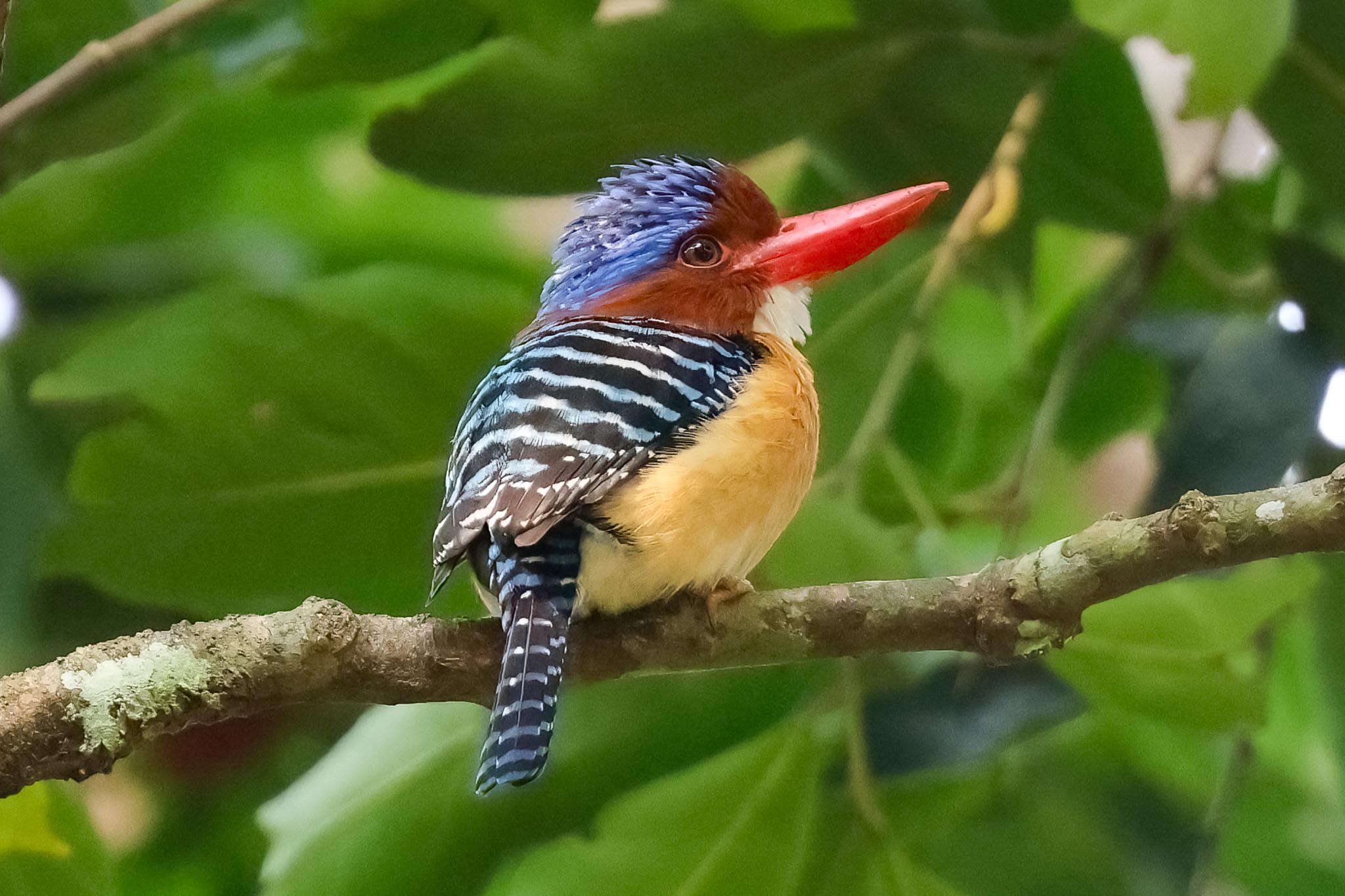
Nearby a pair of Orange-breasted Trogons were in the trees too, the male perched at eye-level right in front of us.

A Green-eared Barbet was busy excavating a nest hole in a tree and a male Asian Fairy-Bluebird swooped around above our heads, but a Paradise-Flycatcher calling beyond the stream remained stubbornly out of view.
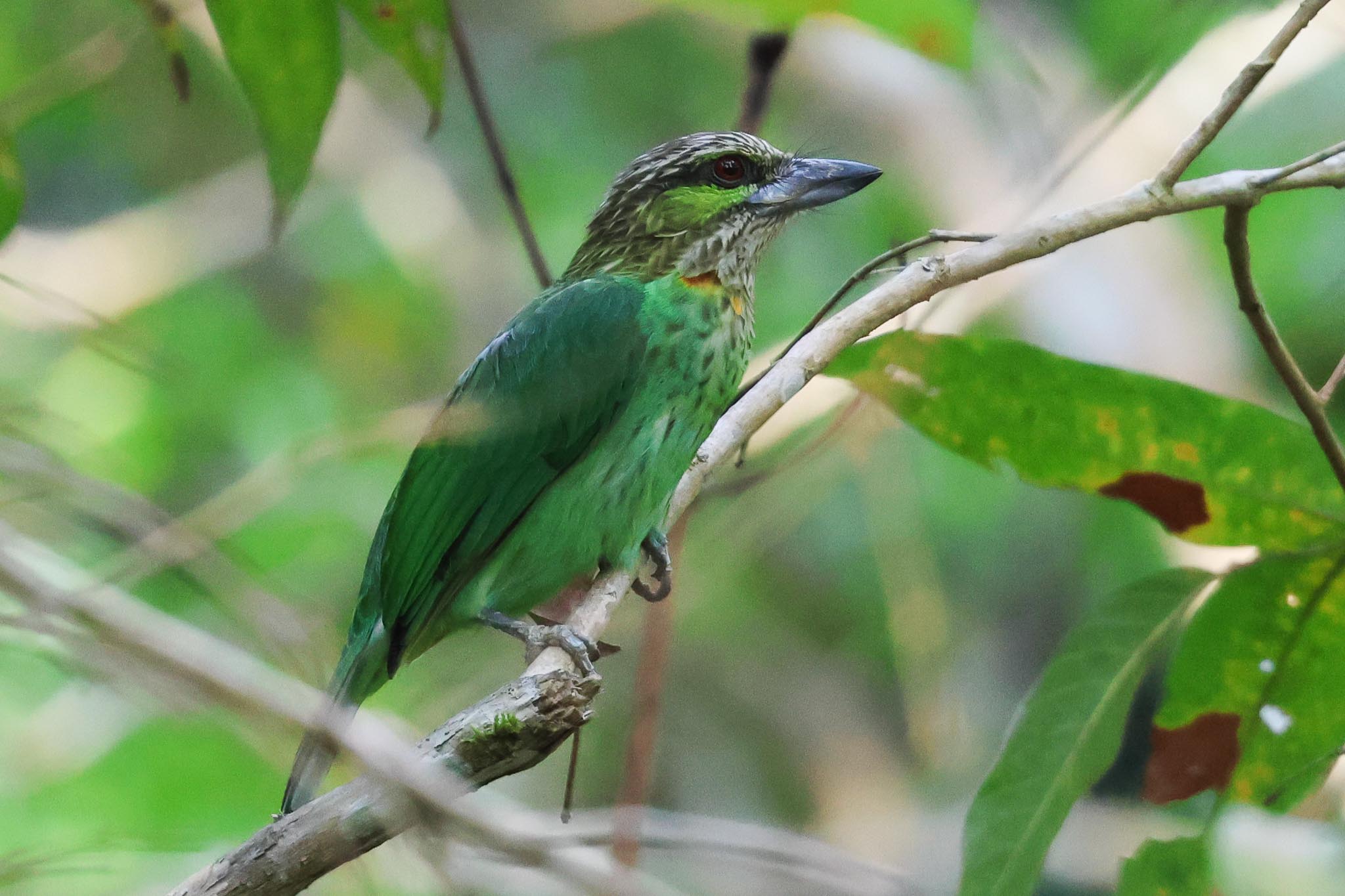
There were mammals in the campsite too, several Dusky Langur monkeys loafing in the trees and a couple of appropriately named Black Giant Squirrels chasing round a tree trunk too. Back out onto the road, while we were waiting for the minibus to come round we found a Crested Goshawk perched nearby and three Crested Serpent Eagles circling high above the hills.
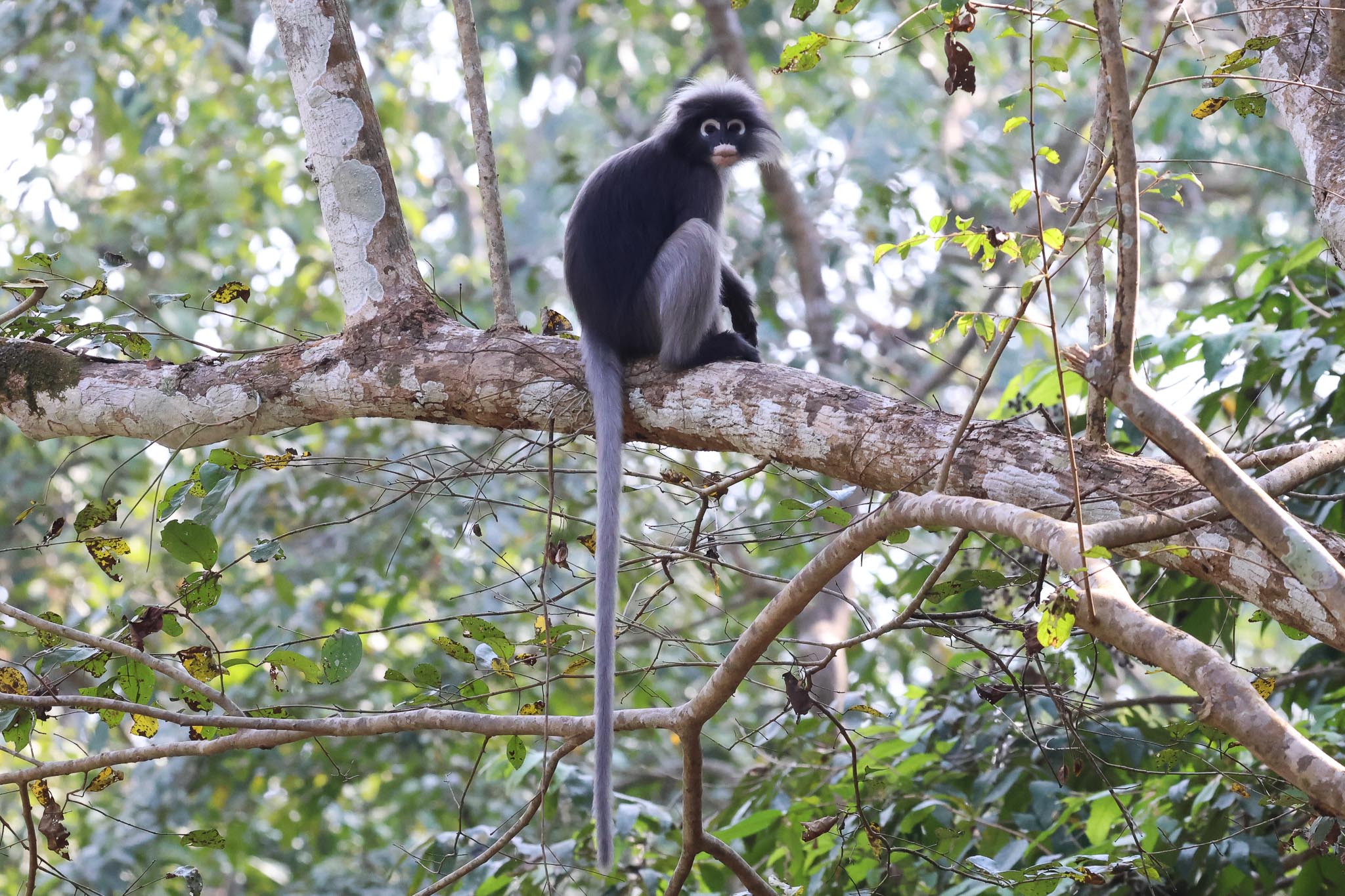
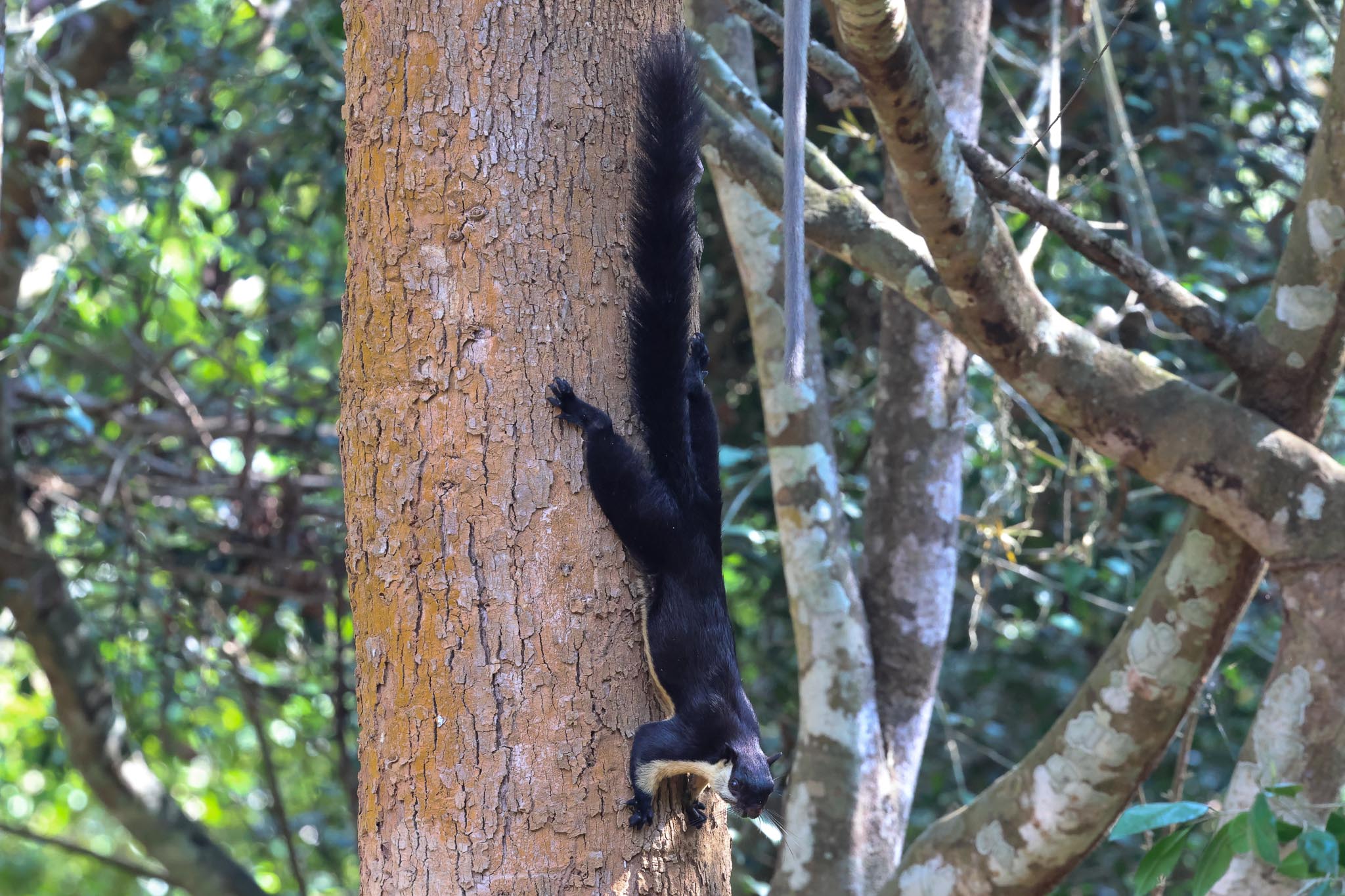
We drove the short distance down to the first stream crossing, where there were lots of butterflies swarming round, settling on the damp ground, a variety of different species. We crossed the stream on some stepping stones and walked a short distance further along the track the other side to where a White-fronted Scops Owl was roosting in the trees. Normally a hard species to catch up with here, this individual has apparently mostly been roosting in the same spot for the last few weeks. It was time to head back to Baan Maka for lunch now, although we had a brief impromptu stop when a troop of Stump-tailed Macaques crossed the road in front of us. We got out and watched the feeding in the trees.

Over lunch, a succession of bulbuls came in to feed on a hand of ripe bananas which had been put out nearby, mainly Streak-eared and Stripe-throated, and a pair of Golden-fronted Leafbirds paid a brief visit too. A Puff-throated Babbler was rustling through the dry leaves on the ground nearby and the resident Blue Whistling Thrush was hanging around by the tables again, eyeing up the spilt rice. After lunch, we had a short break again through the hottest part of the day, a chance to relax or have a short walk round the resort grounds.
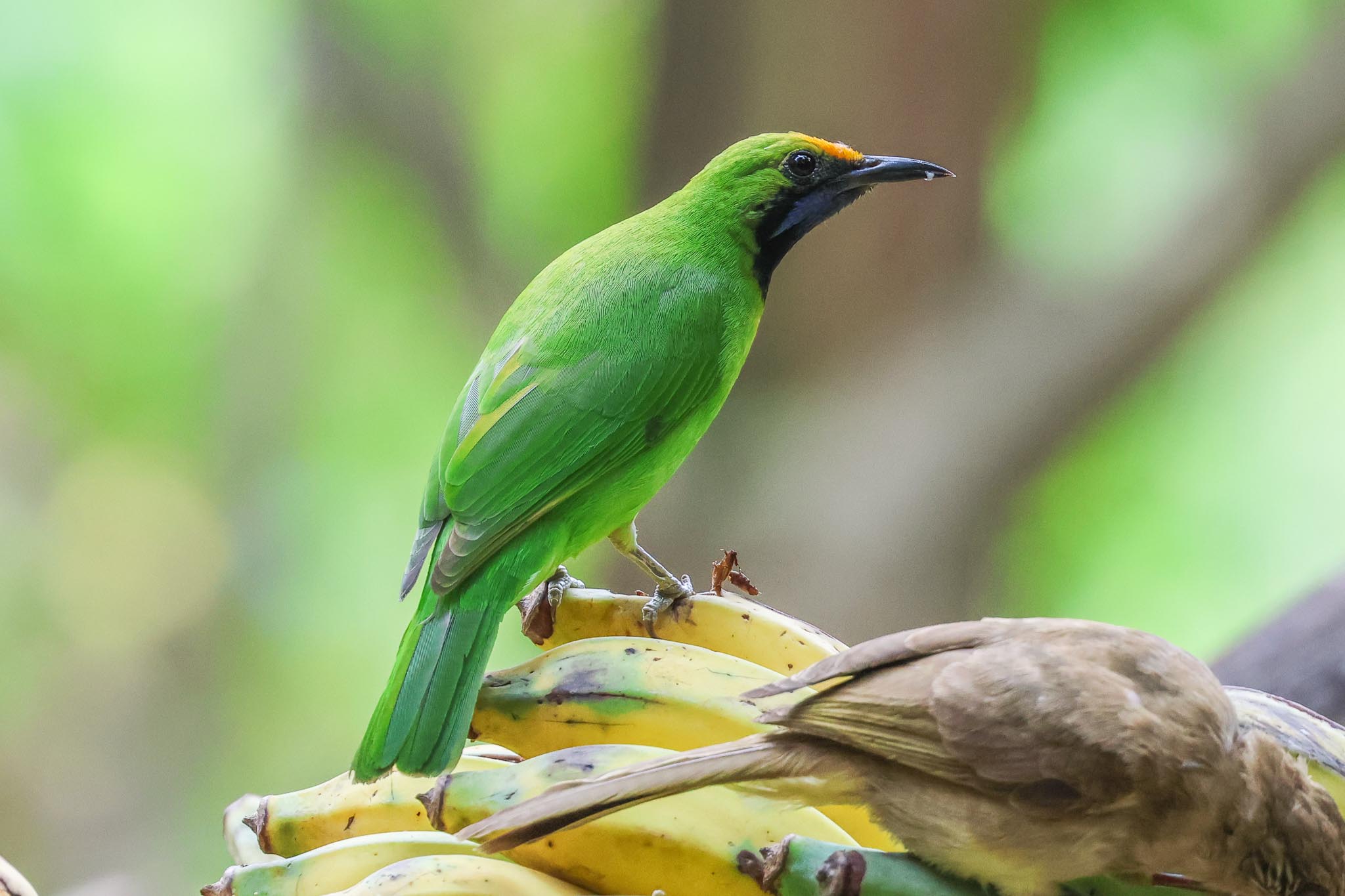
It was back into the 4x4s for the drive out to Dab Toon’s hide in the afternoon. Again, a big mixed group of Greater and Lesser Necklaced Laughingthrushes were quickly in, along with the Grey-bellied Squirrels and a Northern Treeshrew which were attracted by the jackfruit and bananas.
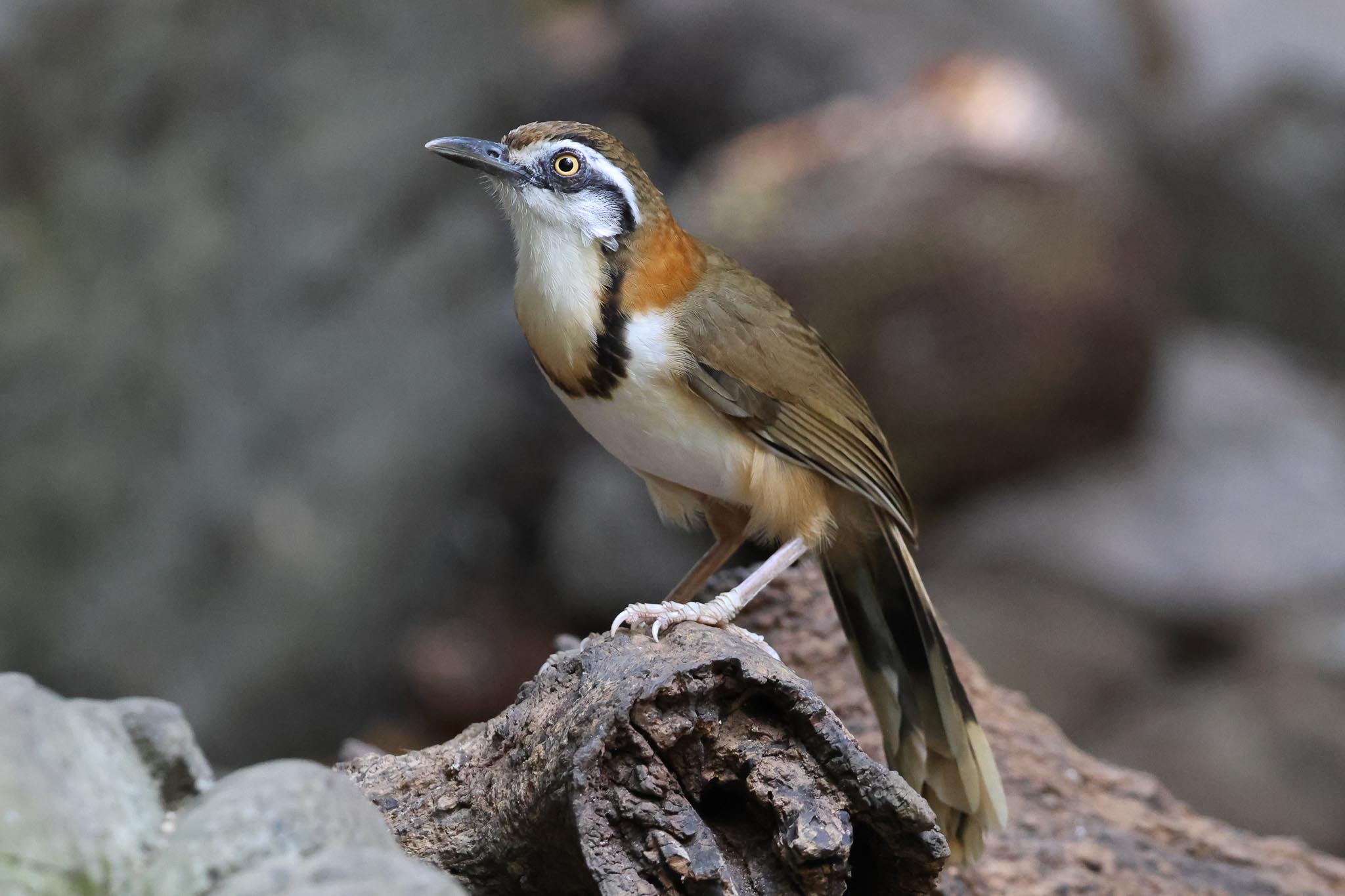
A pair of Red Junglefowl were hanging around in the trees at the back and then a pair of Kalij Pheasant appeared. They were a bit nervous at first, but eventually came out into the open to feed, the male again waiting for the female to check the coast was clear first!
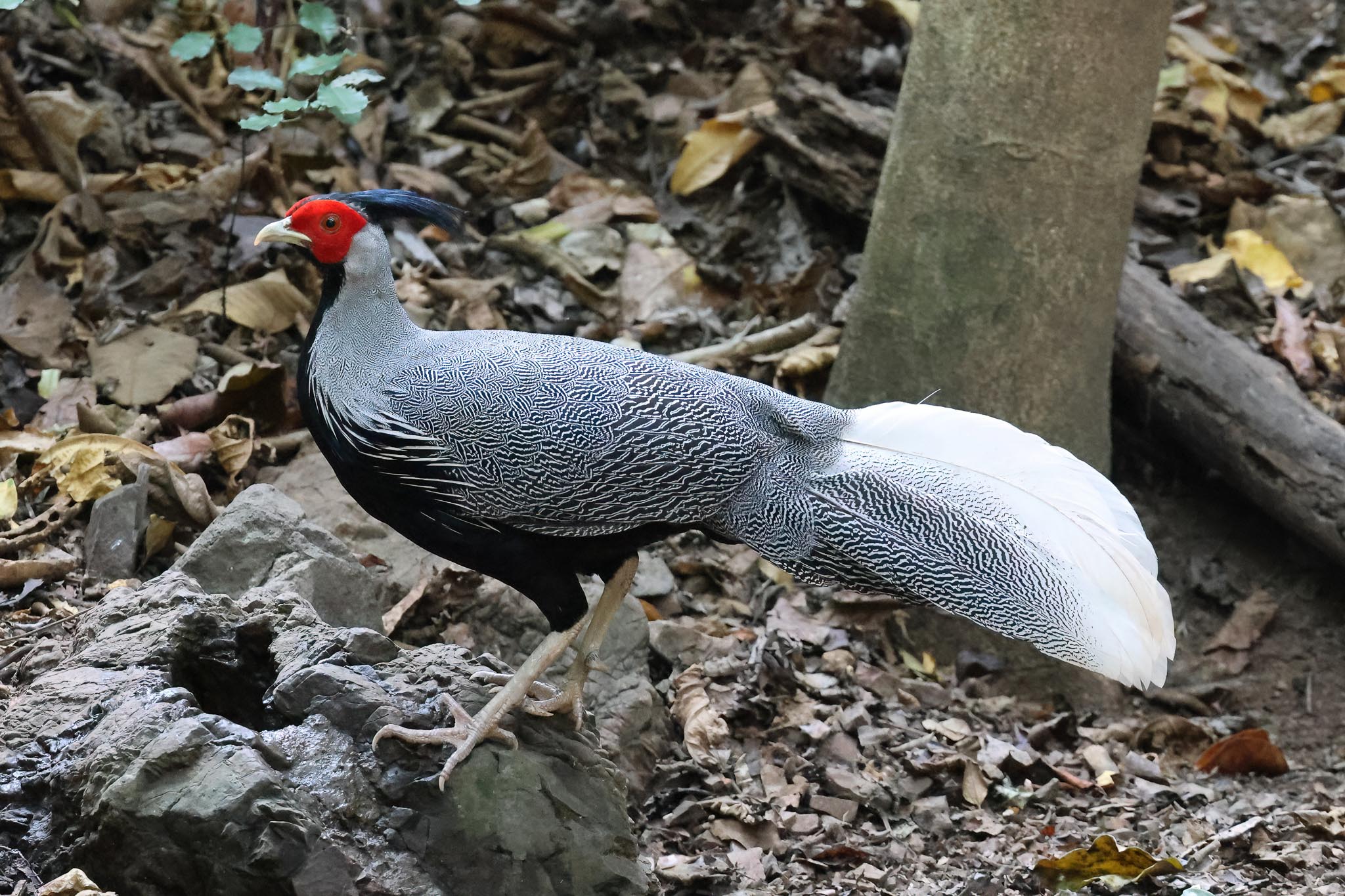
There was a good selection of partridges here again, with three Bar-backed Partridges and three Scaly-breasted Partridges all coming in to feed, but the highlight was the Ferruginous Partridge. It seemed to come out nervously at the back at first, and fed behind a rock for a time when we could only see its head when it lifted it, but then it walked down in front of the hide and proceeded to feed right in front of us, stunning views!
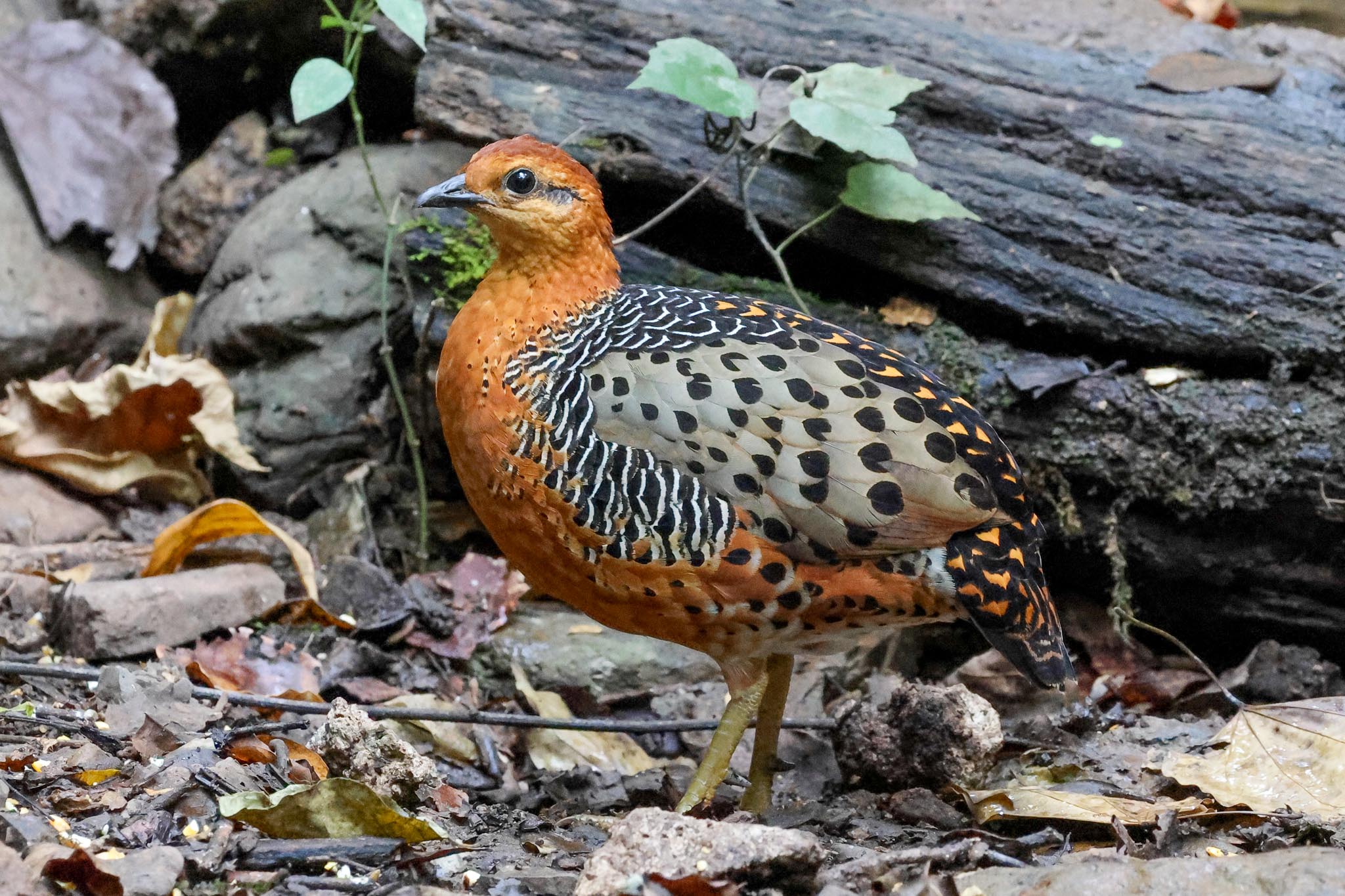
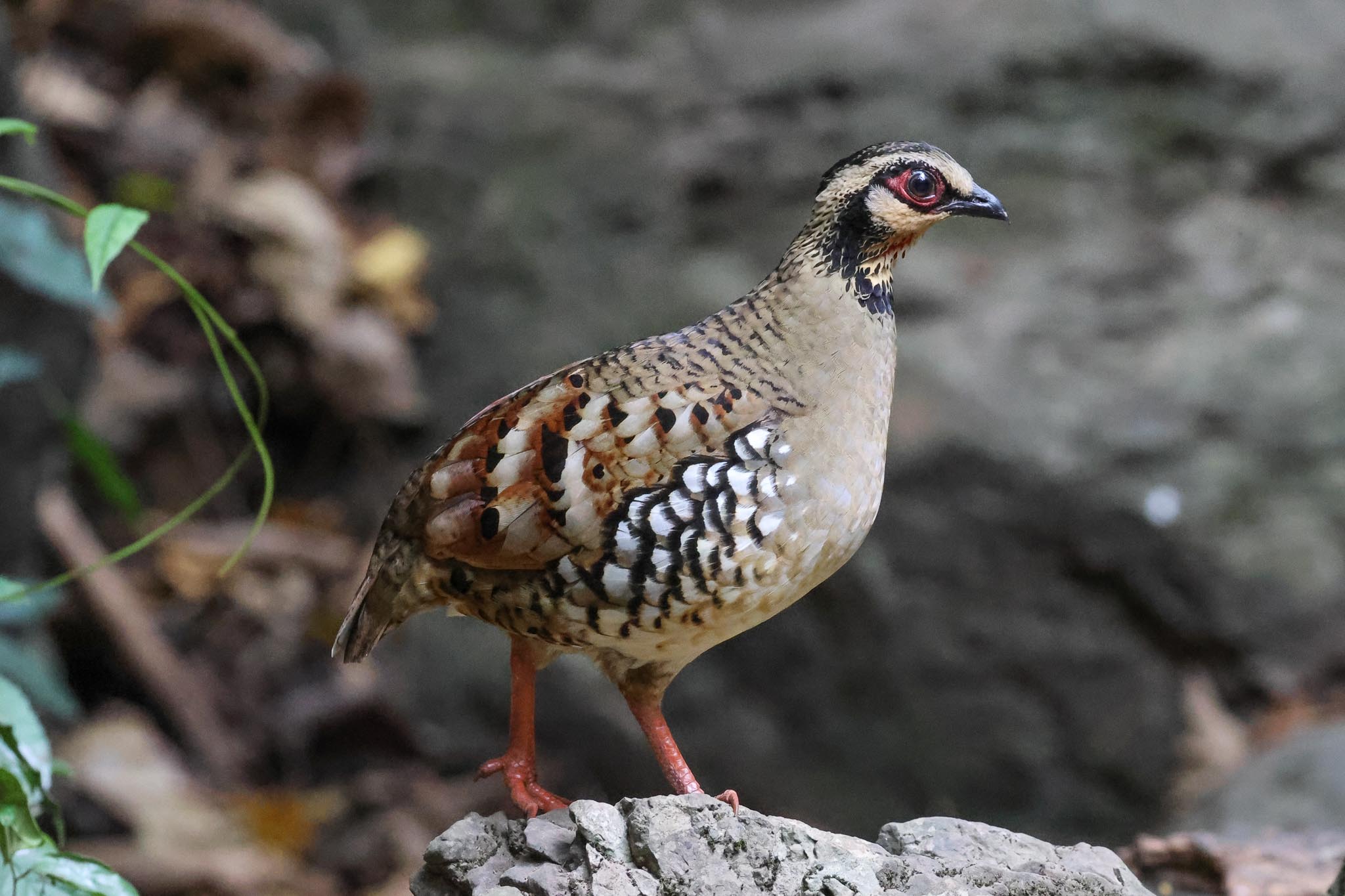
A Greater Racket-tailed Drongo had taken up territory on the branches over the pond and unfortunately insisted on chasing away most of the smaller birds this afternoon.

The highlight of those that did brave it were two Large Scimitar-Babblers which came in to the pool, better views than yesterday’s brief encounter, and a female Oriental Paradise Flycatcher. There were also a couple of White-rumped Shama and Indochinese Flycatcher lingering, Puff-thoated Babbler, Brown-winged Fulvettas and a few Asian Emerald Doves again.

We didn’t stay at the hide until dusk tonight, but headed back to Baan Maka for an earlier dinner. Once it got properly dark, we headed out for a night walk with Games and her nephew. In the torchlight, we found a White-spotted Slug Snake in the undergrowth, a Long-tailed Giant Rat in the bushes, and lots of spiders in the leaves. We could hear an Oriental Bay Owl calling, but it was distant and up the slope through the trees, and by the time we followed the path round it had gone quiet. A roosting Ashy Drongo was on a branch over the path and we disturbed a Dark-necked Tailorbird when we tried to look at a Field Frog. We saw a couple of moths, a bat which flew past surprisingly low through the trees and a Siamese Leaf-toed Gecko. A pair of Slow Loris high in the trees were picked up when their eyes caught the light, and we watched them walking down slowly through the branches.
It was just starting to spit with rain and we could hear a Collared Scops Owl calling now back by the restaurant, so we cut back through. The Scops Owl had gone quiet by the time we got there, but an Asian Barred Owlet was calling now and a bright green White-lipped Pit Viper was trying to hide in a potted plant by the driveway.

We walked back through to the kitchen garden, where the Scops Owl was now calling much further back in the trees. Having just had distant views in the torchlight yesterday, it was nice to find a Large-tailed Nightjar now perched on the corner of the vine trellis, and it didn’t seem to mind all the attention as we gathered round for a closer look. Then as it was starting to rain a little heavier, we decided to call it a night.

Wednesday 31st January
After breakfast, we drove up into Kaeng Krachan National Park again first thing this morning, in the 4x4s this time. We were heading towards the summit and there are time slots for traffic on the track up and down, so we had to get up before 9am before the traffic started coming down. A pair of Oriental Dollarbirds were perched in a tree overhead, so we pulled up underneath briefly, and a small flock of Thick-billed Pigeons close to the road where we saw them yesterday.
Games heard Lar Gibbons calling as we neared the campsite so we diverted in for a look and found a family in the trees at the back, swinging through the branches, hanging on by one arm eating fruit, great to watch. We would hear their haunting calls on and off all day but these were the only ones we saw. Walking back to the trucks, Games heard a Black-and-yellow Broadbill calling and as we looked up a pair flew in and landed in a large tree in the middle of the campsite, where we eventually had nice views in the tops. A Great Iora appeared briefly behind.
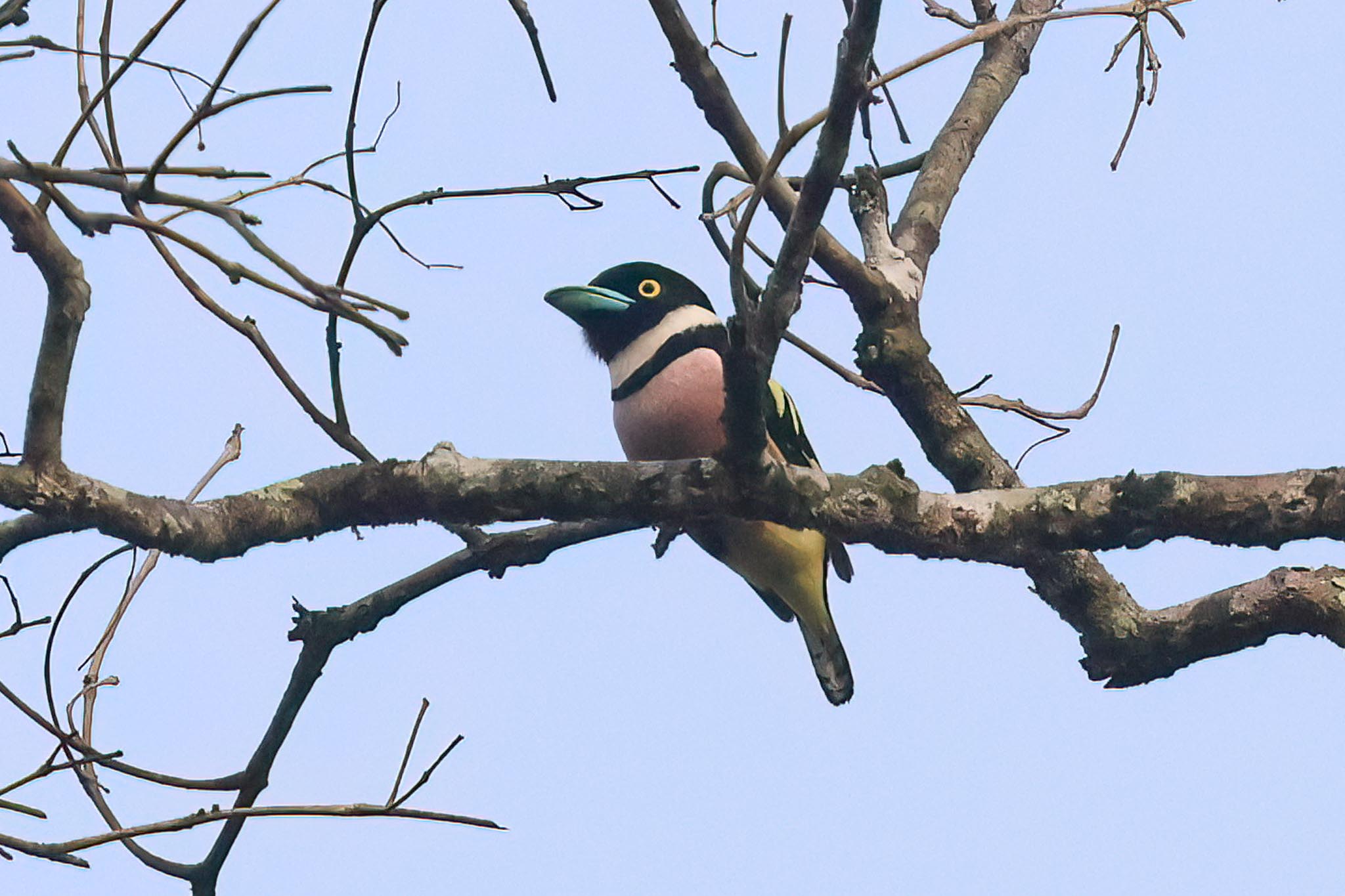
We set off on up the track, and although we were in more of a hurry now, given the traffic restrictions, we managed a couple of brief stops. Two hornbills flew over and landed briefly where the second truck could get onto them, Tickell’s Brown Hornbills. Unfortunately they flew again almost immediately and we heard them disappearing off up the valley. Further up there were various birds in the road, a Grey Wagtail, a Kalij Pheasant, a Red Junglefowl and then a White-throated Rock Thrush flew up from the verge. We stopped and it dropped down again to feed on the road ahead of us, a rare bird here in the National Park.
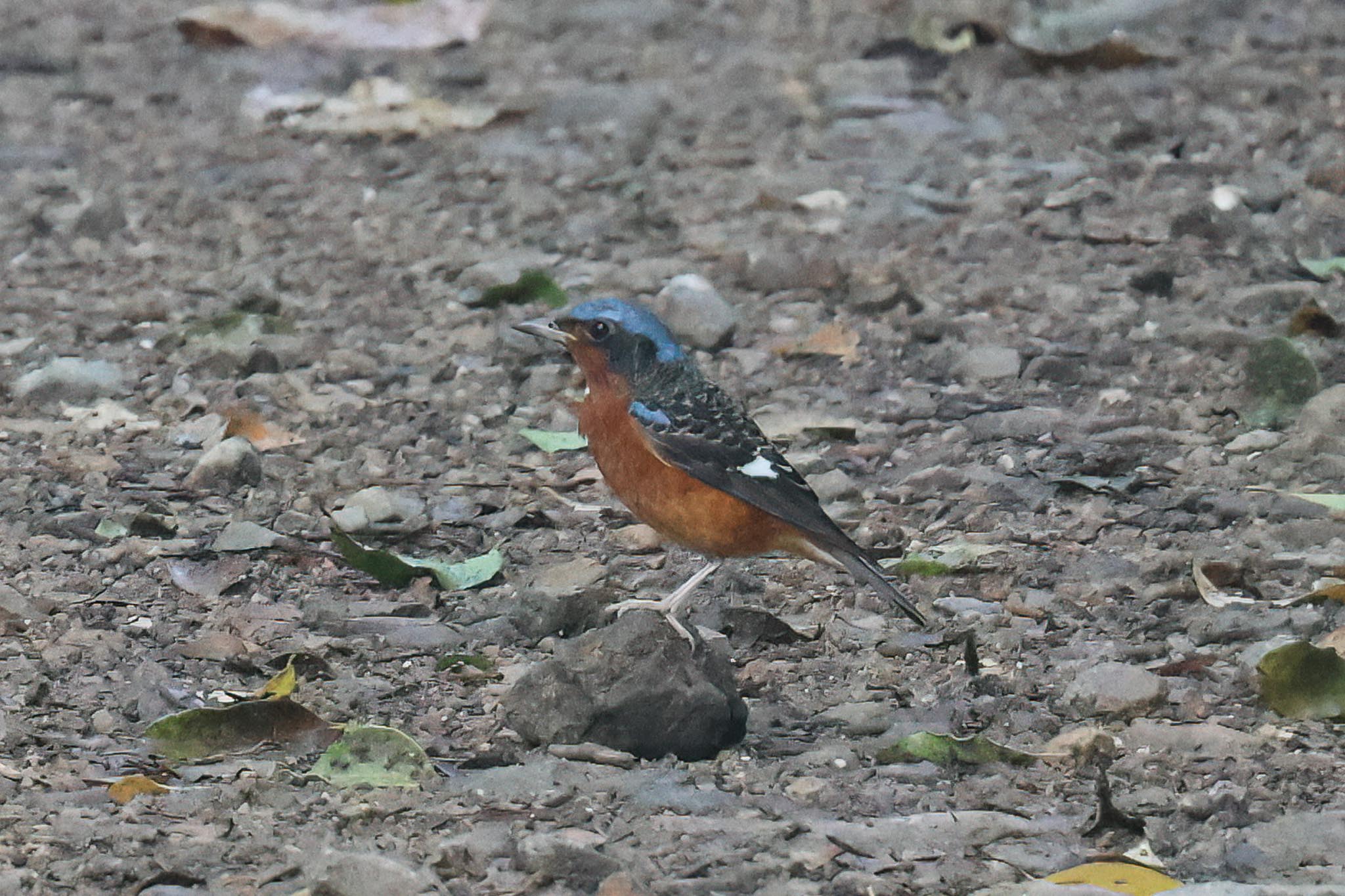
We pressed on, but we were running out of time and still had several km to go to get to the summit, the road starting to get rougher too, the tarmac washed away and steep in places. When Games heard a Grey Peacock Pheasant calling right beside the road we had to stop – we stood for a while and listened and eventually it walked quickly across the road below us. It was after 9am, so we had to stop driving up and explore on foot now. Two Dark-sided Flycatchers were flitting out from the bare trees above the track a little further up, a Collared Babbler in the bushes kept to the tangles at first but eventually gave better views and a White-browed Piculet appeared in some tall bamboo above us.
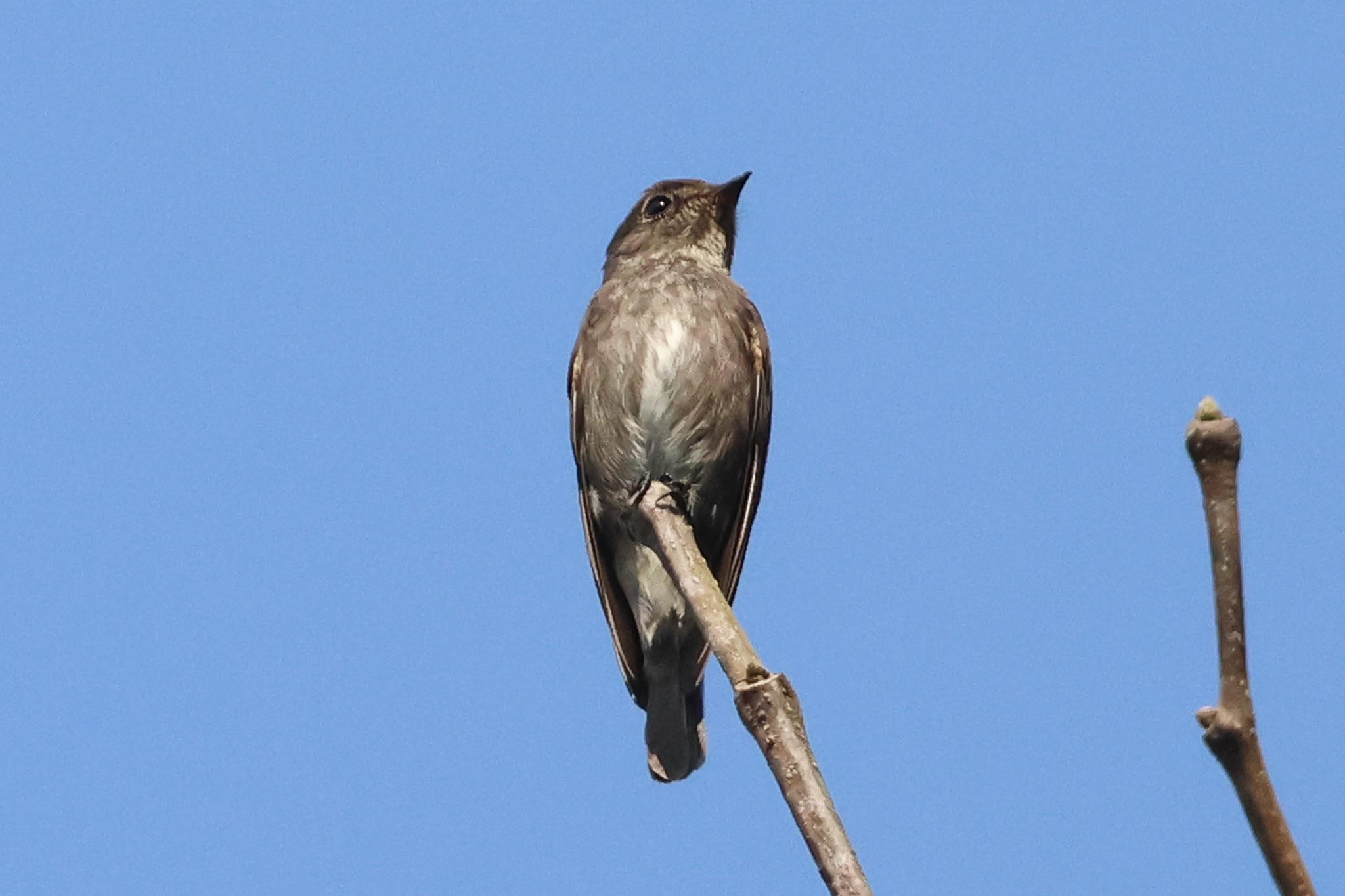
A Rusty-naped Pitta started calling, but from a very dark and dense gully up a steep slope where it was impossible to see and a little further up, we could hear a Red-bearded Bee-eater calling in the trees but couldn’t see that either. Games heard Spot-bellied Eagle Owl here too, and we were just looking for the bee-eater when we heard a whoosh of wings and saw something very large drop through the branches mobbed by two drongos, but unfortunately it disappeared deeper into the trees and out of view! A Collared Owlet was calling now, a flock of Ochraceous Bulbuls moved through deep in the trees, and we managed to see a male Asian Fairy Bluebird which was perched up in the branches singing. A large troop of Grey Langurs crashed around in the branches high up.
A few vehicles had come down the track past us, but there wasn’t a lot of traffic so the 4x4s had managed to catch up with us and now folding chairs were unloaded from the back and we stopped for a snack break on the verge. Walking on a bit further afterwards, a Square-tailed Drongo-Cuckoo was calling and then Games heard an Orange-breasted Trogon. We stopped and listened quietly, there was a flash of red, and a pair of Red-headed Trogons appeared instead, perching nicely over the road where we could get them in the scopes.

We were able to carry on driving up to the summit now. We parked at the top before the gate and took a short walk down along the road to the visitor centre, to use the facilities. A Taiga Flycatcher was flicking around in the trees, a male with a ghost of its red throat now, there were lots of butterflies landing on the tarmac and Games found a moth and a Katydid leaf bug in the bushes. From the small viewpoint behind the centre, we scanned the valley beyond and found three Great Hornbills perched in the distance, which then flew in past us and back beneath us, and a Crested Serpent Eagle circled up.
Games picked up flask of hot water for tea and coffee from the shop and we walked back up to where we had parked for lunch. The folding chairs were set up on the grass in the shade, looking out from the top, a beautiful view and a lovely place to sit and eat. After lunch, we had a chance to rest, and a couple of the group dozed off on the grass. There were lots of bulbuls in the bushes in front of us, Black-crested, Olive and Flavescent Bulbuls, and an Ochraceous Bulbul flew in and landed just below us. A nearby flowering tree attracted several Hume’s White-eyes briefly, and although most flew off, one was left behind and we watched it in the flowers. There was a female Black-headed Sunbird in the trees too, Yellow-browed Warblers and at least one Two-barred Warbler, a small group of Bar-winged Flycatcher-Shrikes and a Black-winged Cuckooshrike.
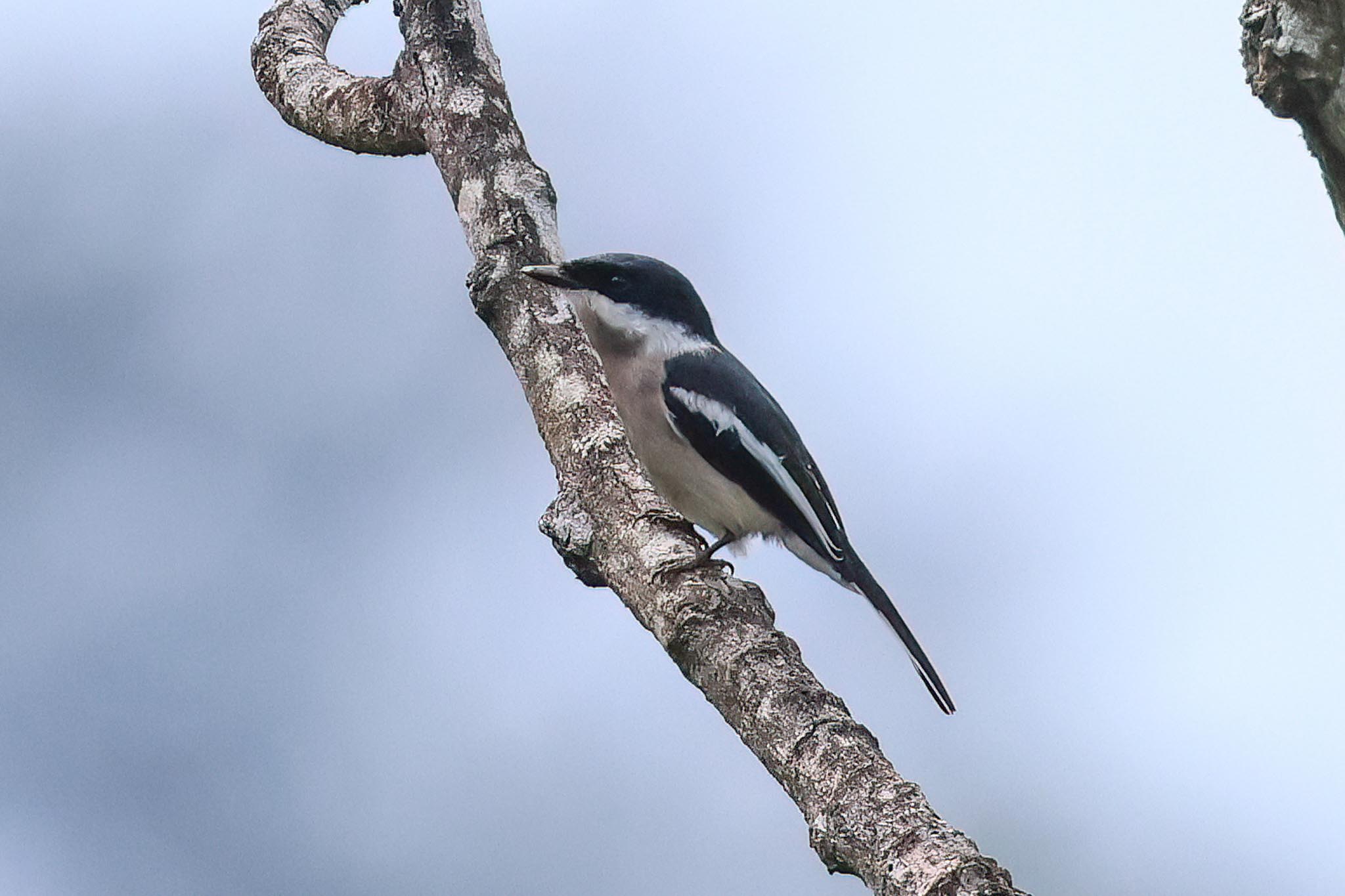
We watched a Blue-eared Barbet hacking at a dead branch and a Blue-throated Barbet calling behind, a Vernal Hanging Parrot flew in and landed in the bamboo close to us but out of view, and several Asian Palm Swifts zoomed back and forth. Down at the toilets, a Radde’s Warbler was calling from the bushes behind the Gents, but it had gone quiet when the others who were awake got down there.
We went for a walk after lunch. A mixed flock of small birds was feeding in the trees just beyond the visitor centre, including a bright yellow Sulphur-breasted Warbler and more Yellow-browed Warblers, a couple of Yellow-bellied Warblers, a Ruby-cheeked Sunbird, Grey-headed Canary-Flycatchers and a Dark-necked Tailorbird. Several Mountain Bulbuls were in the trees as we climbed the steps up to the viewpoint, where we were treated to another great view looking over the hills towards Myanmar. A small group of Grey-rumped Treeswifts was flying round over the trees, we could hear Wreathed Hornbills calling below us in the trees and then had a brief view of three flying as they crossed through an opening, and a Mountain Imperial Pigeon was calling too but remained out of view. There were more Blue-eared and Blue-throated Barbets in the dead trees and we watched pair of Blyth’s Shrike-Babblers nest building.
Games had got permission from the ranger on the gate to allow us to descend a short way along the track earlier than normal, so we drove down a couple of kilometres and got out again for a walk. It was quiet still, the mid-afternoon lull, but we did find several more Collared Babblers, a Martens’s Warbler which was helpfully calling above the track, and we heard a flock of Long-tailed Broadbills a couple of times although they remained out of view. There were Tickell’s Brown Hornbills calling too and we found one perched in the trees above the track briefly. We were hoping for Ratchet-tailed Treepie here but there was no sign today, although a couple of Hair-crested Drongos swooping through trees got us looking until we got a good view of them.

Continuing down in the 4x4s, we saw a group of Great Hornbills fly in to the trees further down so we approached slowly and at least a dozen flew out ahead of us. They landed in the trees again so we stopped and had great views of them now. A Dark-sided Flycatcher was flycatching from the dead branches above our heads.
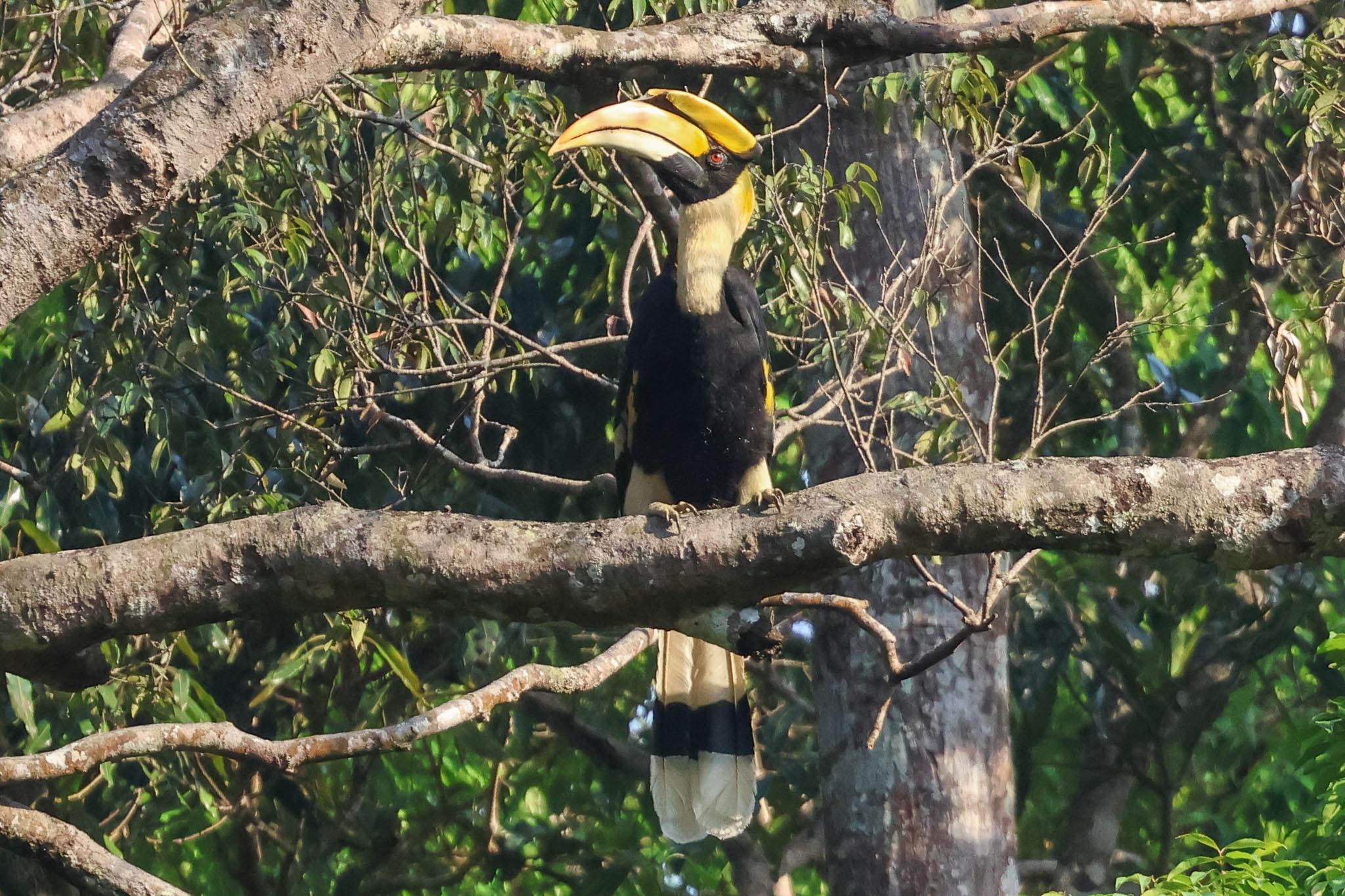
Further down still, Games heard Blue Pitta calling but by the time we had stopped and got out, it had gone quiet. If we hadn’t stopped though we wouldn’t have noticed the pair of Moustached Barbets excavating in a dead tree nearby. A pair of Kalij Pheasants was feeding on the edge of the road nearby and a troop of Pig-tailed Macaques came through the trees. We were in a hurry again now, as we had to get down to the campsite by 6pm, and as we came round a corner of the track, a black Leopard was standing in the middle of the road. It turned to look at us, then ran off a few metres before dropping down the steep slope below the track, but unfortunately the second vehicle had lagged behind, hard to keep together when trying to hurry down a bumpy track, and we couldn’t find any sign of it in the trees now. Pressing on, we flushed a large flock of Chestnut-headed Bee-eaters going to roost in some trees by an open area, and we got down to the campsite just in time. After a quick loo stop, we drove back along the road to Baan Maka in the last of the light.
Thursday 1st February
After breakfast, we headed up into Kaeng Krachan National Park again, back in the minibus this time. We passed a female Red Junglefowl and a couple of Emerald Doves on the verge and then stopped at km 9 again. There were more cars here today and at first the same birds as two days ago – the pair of Common Hill Mynas, the Asian Brown Flycatcher, the Scarlet-backed Flowerpecker, drongos and Indochinese Roller all in same flowering trees. The pair of Dollarbirds flew over and the pair of Golden-crested Mynas landed in the top of a nearby tree. Then five large birds appeared over the low ridge ahead of us and when we looked we could see they were Great Slaty Woodpeckers, the largest living woodpecker in the world. One flew low past us, while the other four turned back.

We thought that was a good view, but Games could still hear them calling so we walked on a little further and found the other four Great Slaty Woodpeckers now perched in a dead tree. Possibly a family party, we watched them flicking their wings and climbing up and down the bare branches, great birds indeed. A Black-thighed Falconet appeared in the top of a distant tree too.

Further along the road, a Two-barred Warbler was calling and we watched it flicking around in the top of a tangle of vines, a Greater Flameback flew through the trees and landed briefly and a pair of Great Ioras picked around in the bushes. Games heard a Banded Broadbill now which flew across and landed out of view, so we scanned the trees as we walked slowly along the road until we found an angle where we could see it perched, great views through the scopes.
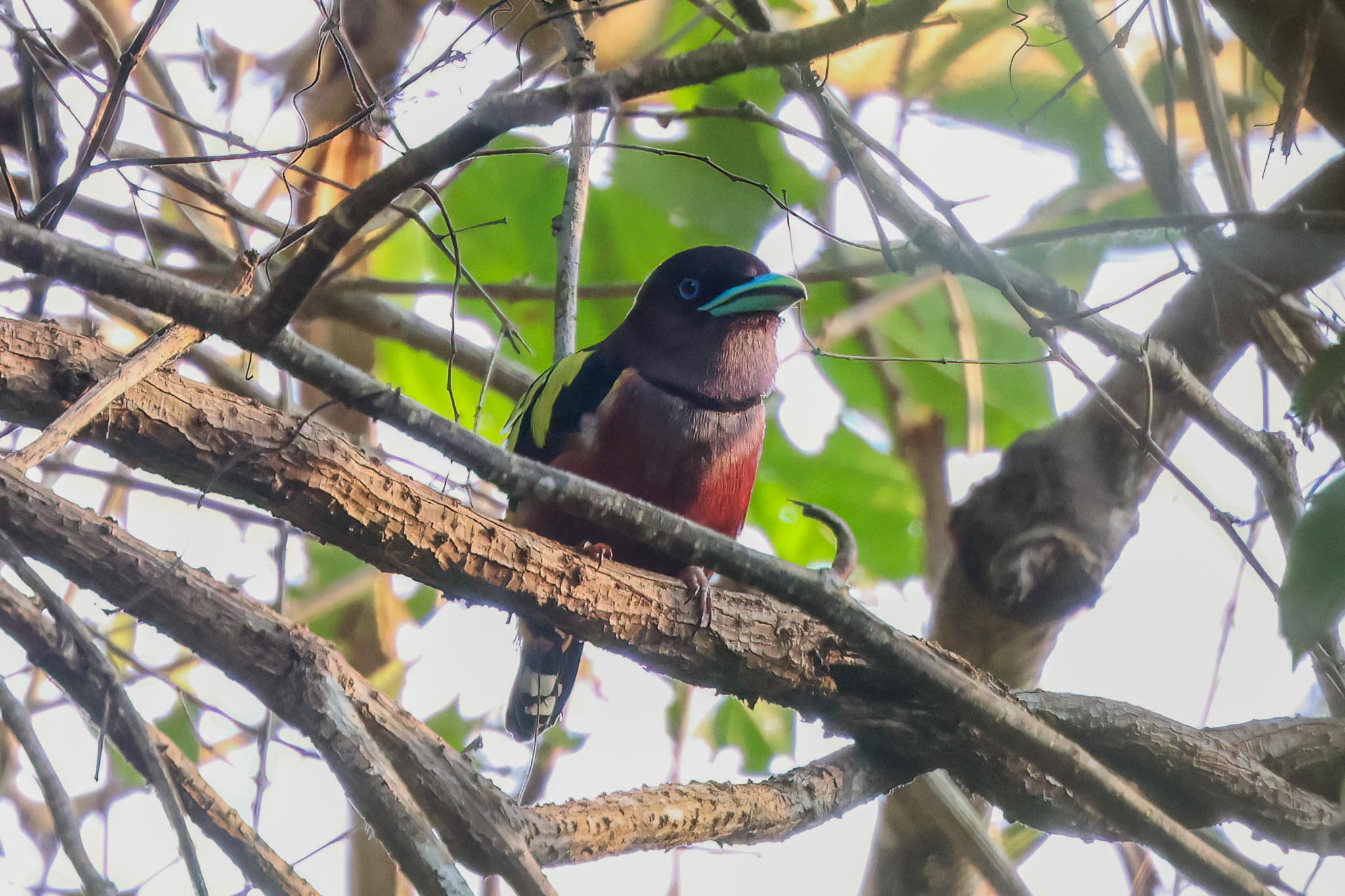
Down to the pond, there were two Red-wattled Lapwings on the mud behind today, the White-throated Kingfisher was in its usual place and a White-breasted Waterhen walked along the back edge. When a small flock of green pigeons flew through the tree tops we thought they would be the usual Thick-billeds, but when they landed further up we could see they were actually Wedge-tailed Pigeons, and we got them in the scopes.
We walked on a little further, finding lots of Oriental Pied Hornbills including a large group of about 15-20 which flew low over the road, Black-headed Bulbuls and a Dark-necked Tailorbird in the bushes, and nice views of a Crested Goshawk perched in a tree looking back at us from further down the road. The minibus picked us up and we drove on, pausing to look at a troop of Stump-tailed Macaques by another small pool, before continuing on to the campsite where we all transferred into one of the 4x4s, which took us over the first two stream crossings, before we got out to walk.
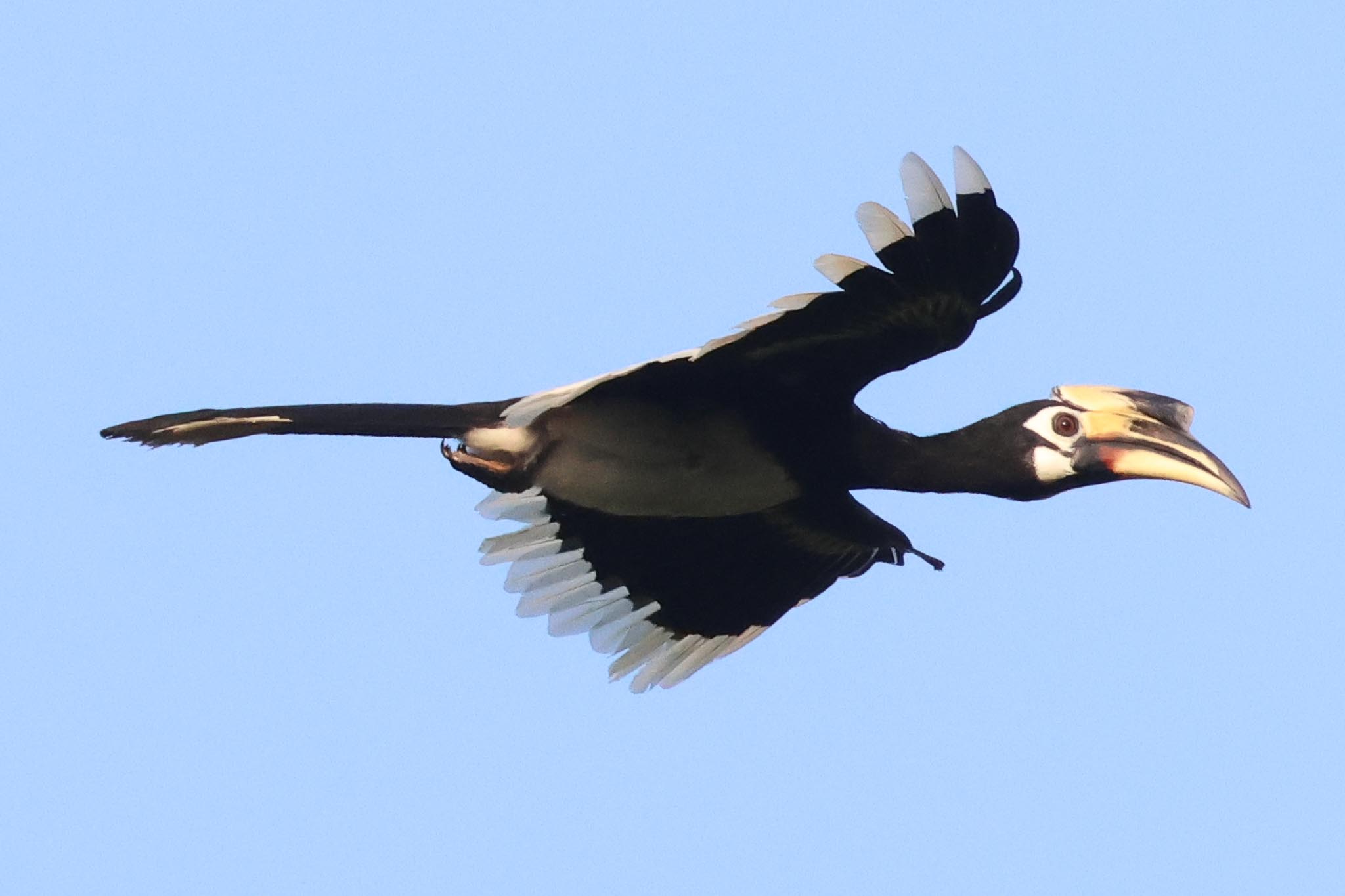
We hadn’t gone far when a larger dark bird flew up from the stream bed and into the trees beyond – it looked a bit like a Night Heron, but despite scanning the trees carefully, frustratingly we couldn’t find it again. We stopped to look at a Rufous-fronted Babbler in the bushes, and an Ochraceous Bulbul above our heads too, then we heard Tickell’s Brown Hornbills calling and when two flew across the road above us, we found them perched in the trees further up the slope beyond briefly. A Heart-spotted Woodpecker called and we found it climbing up a dead tree, but it flew before everyone could get onto it. There was a fresh hole on the trunk so we thought it might be excavating, but despite waiting for a couple of minutes it didn’t come back in.
There was a Clouded Monitor lizard head poking out of a hole in a tree nearby and several interesting bugs on logs, and as we walked on along the track, Games kept checking the cut ends of the bamboo until she found three tiny Hardwick’s Woolly Bats roosting in one. A Dusky Broadbill started calling but out of view, and again by walking along slowly and scanning carefully we managed to locate one in a tree on the slope above. While we were watching it through the scopes, a second Dusky Broadbill flew in and we watched them mating. Down to the next stream, and Orange-breasted Trogon was calling in the bamboo right next to the road and a Crested Goshawk circled over.
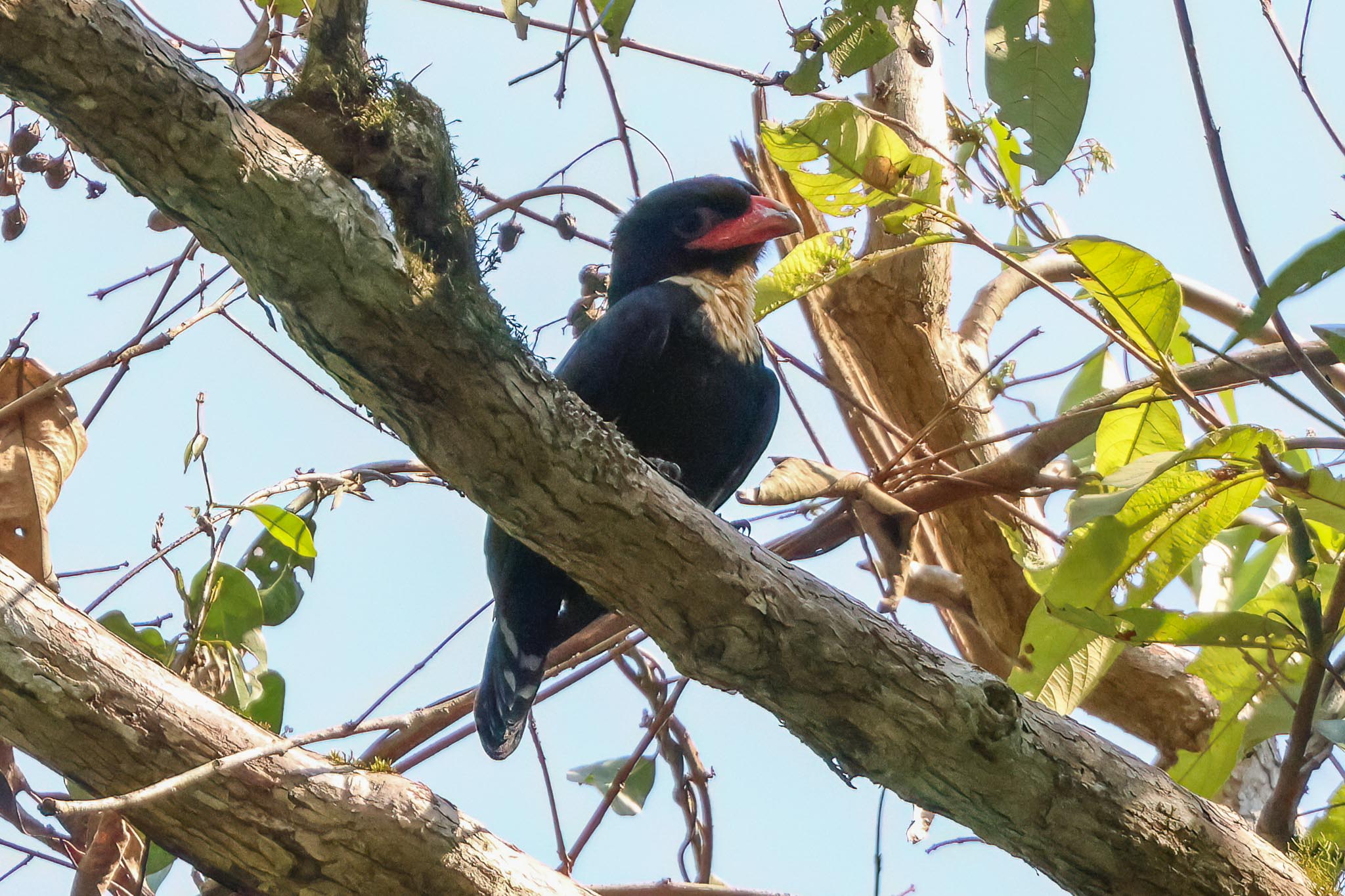
It was late morning now and as it had started to get hot the birds had started to go quiet. We were picked up by the 4×4 and transported back across the streams to the campground, and while we stopped to use the rest rooms, there were lots of Flat-tailed House Geckos in the roof of an open building nearby but despite hearing a Tokay Gecko we couldn’t find it. We transferred back to the minibus and drove back down to Baan Maka. When we got there it was time for lunch and afterwards there was the chance for a bit of a break again. There were more birds coming to the bananas and water by the restaurant – lots of bulbuls and squirrels, a Malaysian Pied Fantail, a pair of Abbott’s Babblers and two Pin-striped Tit-Babblers. Two Black-naped Orioles looked like they might come down but then moved on through. Two Dark-necked Tailorbirds lurked in a low bush nearby.
We had various options for the rest of the afternoon. We hadn’t been to Mr Nui’s hide yet, which is normally good for Blue Pitta but it has only been showing very occasionally so far this year. We decided to give it a go anyway and drove over there in the minibus. Scanning the large flooded quarry opposite as we got out, we could see two Little Cormorants, several Red-wattled Lapwings and a Little Egret on the far shore.
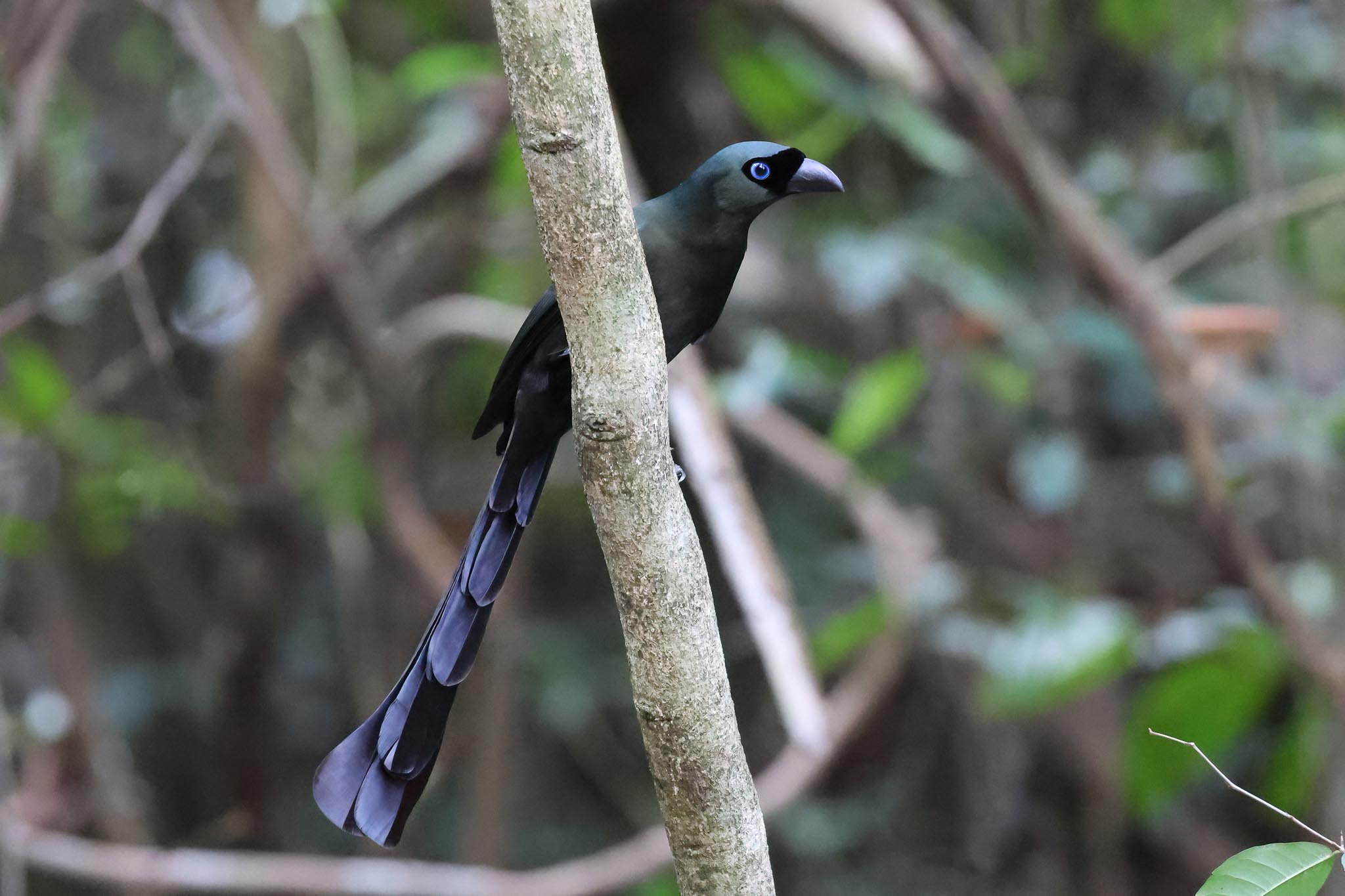
Up to the hide, there was already lots of food put out. A group of at least five Racket-tailed Treepies came in and out, as did two Lesser Necklaced Laughingthrushes, Streak-eared, Stripe-throated and Black-crested Bulbuls, Puff-throated Babbler, Indochinese Flycatcher and couple of White-rumped Shamas. The highlight though was a Common Green Magpie, which is not especially common and often hard to see despite being bright green! It appeared at the back and stayed mostly hidden in the bushes behind at first, then found a big caterpillar and disappeared off with it, but a minute or so later it came in again, landed on a liana in front of the hide, then dropped down to the pool to bathe. A stunning bird, and worth coming out just for that.
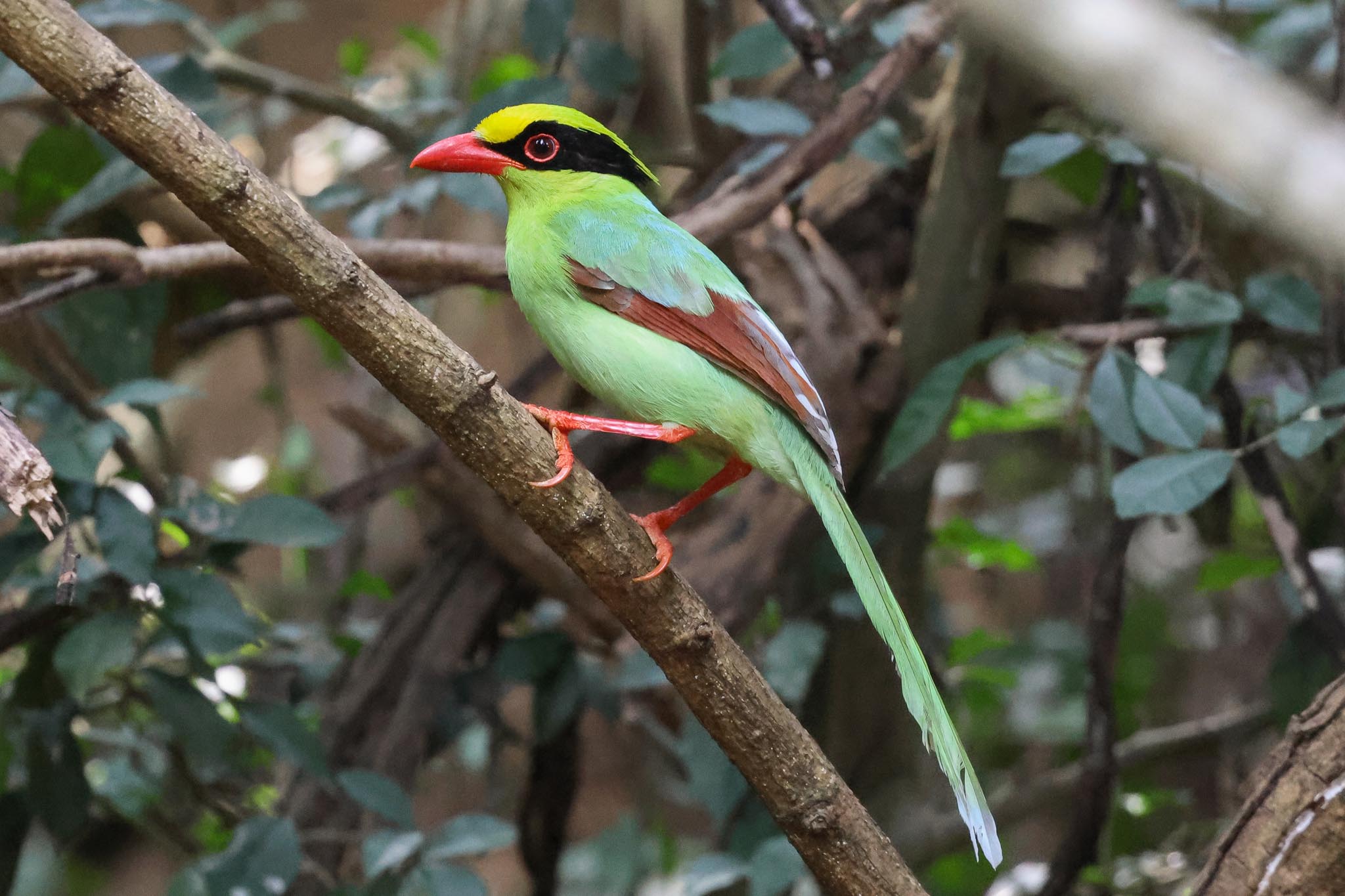
Everything alarm-called and scattered – we couldn’t see why, but possibly a raptor around – and then it went a bit quiet. A group of Brown-cheeked Fulvettas, a Hainan Blue Flycatcher, Malaysian Pied Fantail and a pair of Black-naped Monarchs came in. Games heard Blue Pitta call but apparently it was very distant and unfortunately it didn’t come any closer so we decided to call it a day. One of the group who had gone back out to the minibus had seen a fishing Osprey over the lake but it had moved on, and now we found a Little Grebe on the water and an Oriental Honey Buzzard circling up behind. A large flock of Red-rumped Swallows was dipping down to drink.

On our way back to Baan Maka, we stopped to check out a nearby lake for Bronze-winged Jacanas and quickly found two or three on the floating vegetation on the edge of reeds, along with a couple of Chinese Pond Herons and an Intermediate Egret. Scanning the hills behind, we picked up a large raptor miles off in the distance, short-tailed and with it wings held in distinctive v-shape. As it circled, we could see it was very white below too, so we got it in the scope and could see it was a White-bellied Sea-Eagle very unusual inland here, mainly a coastal species and a nice bonus.
A Common Hill Myna flew in and landed on the wires right above our heads and started singing. Further back, we could see a Coppersmith Barbet on top of a bare tree out in the fields singing and several starlings lower down. They were Chestnut-tailed Starlings but with very rich rufous underparts, very different from the typical ones we had already seen, a different subspecies, malabarica, which is apparently only an occasional visitor here.

Back to Baan Maka, we called in at the kitchen garden bar again for a beer and watched the sun setting over hills. A red-throated Taiga Flycatcher was on the wires behind, along with a Chestnut-headed Bee-eater briefly and an Ashy Woodswallow, and a flock of Scaly-breasted Munias dropped in among the vegetable beds. Then as the light faded we walked back through the trees to the restaurant for dinner.
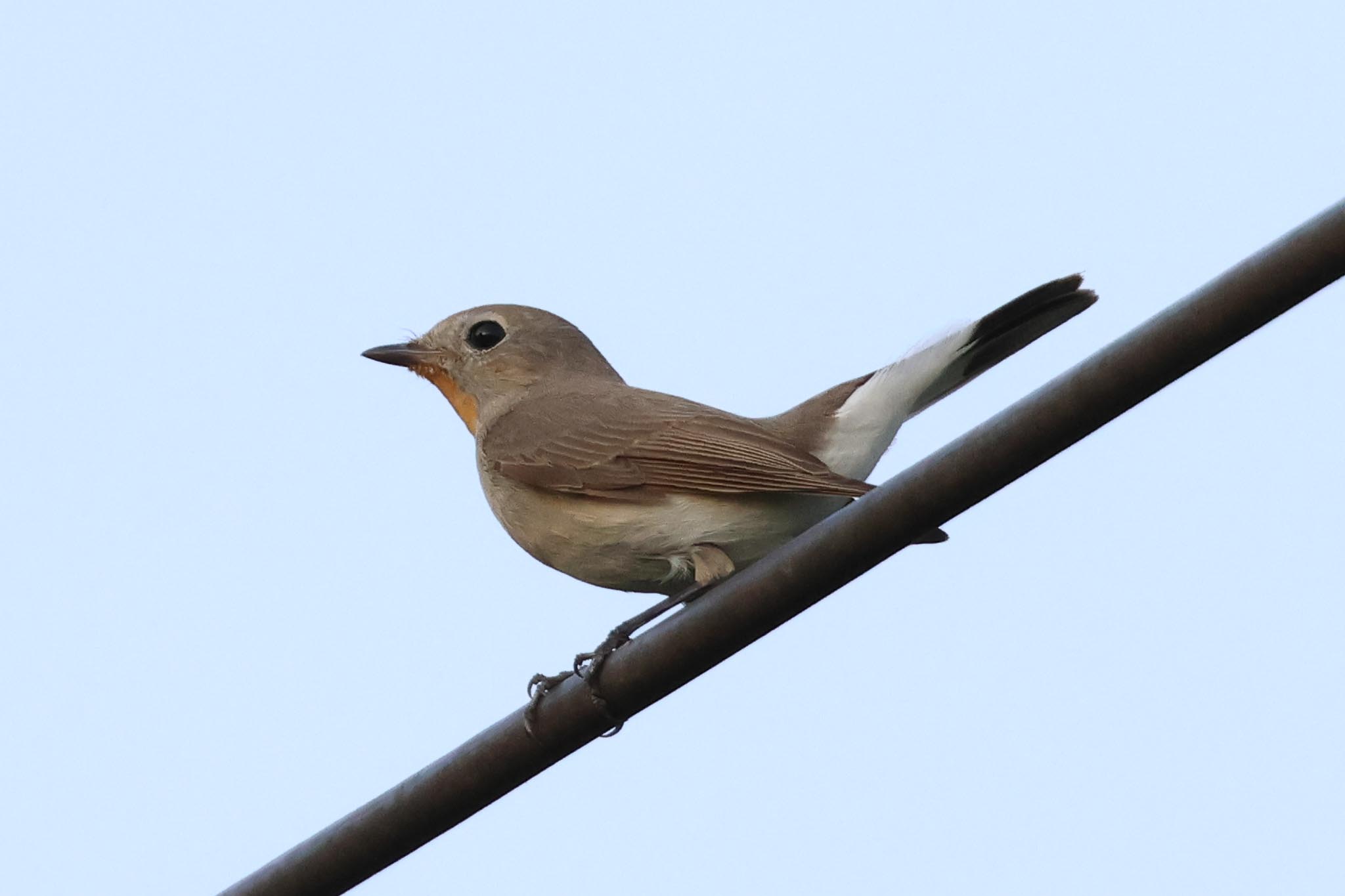
Friday 2nd February
Our last full day already unfortunately, but after breakfast we had a chance for some birding time before we had to start making our way back towards Bangkok. We thought about having a morning at leisure just to explore the resort but there were still a few birds to look for in the National Park so we decided to head back there just for a couple of hours before it got hot, then come back with time to pack. We were very pleased we did!
We drove up in the minibus, passing a couple of Emerald Doves on the verge again, then as we approached km 9 our driver stopped sharply and pointed as an enormous Asian Elephant disappeared into the bushes. Most of the group missed it and our driver was very nervous about driving up to where it had gone in – understandably it turned out, as shortly after it walked back out onto the road again. We all watched it from the safety of the minibus as it walked slowly down the road ahead of us and we followed at a discrete distance. Amazing! We had seen plenty of signs of elephants in our stay here but they are largely crepuscular or nocturnal and rarely actually seen, so we were extremely lucky. We lost sight of it round a bend and when we got to the other side it had presumably walked off into the forest, very close to where we had parked the last few days.
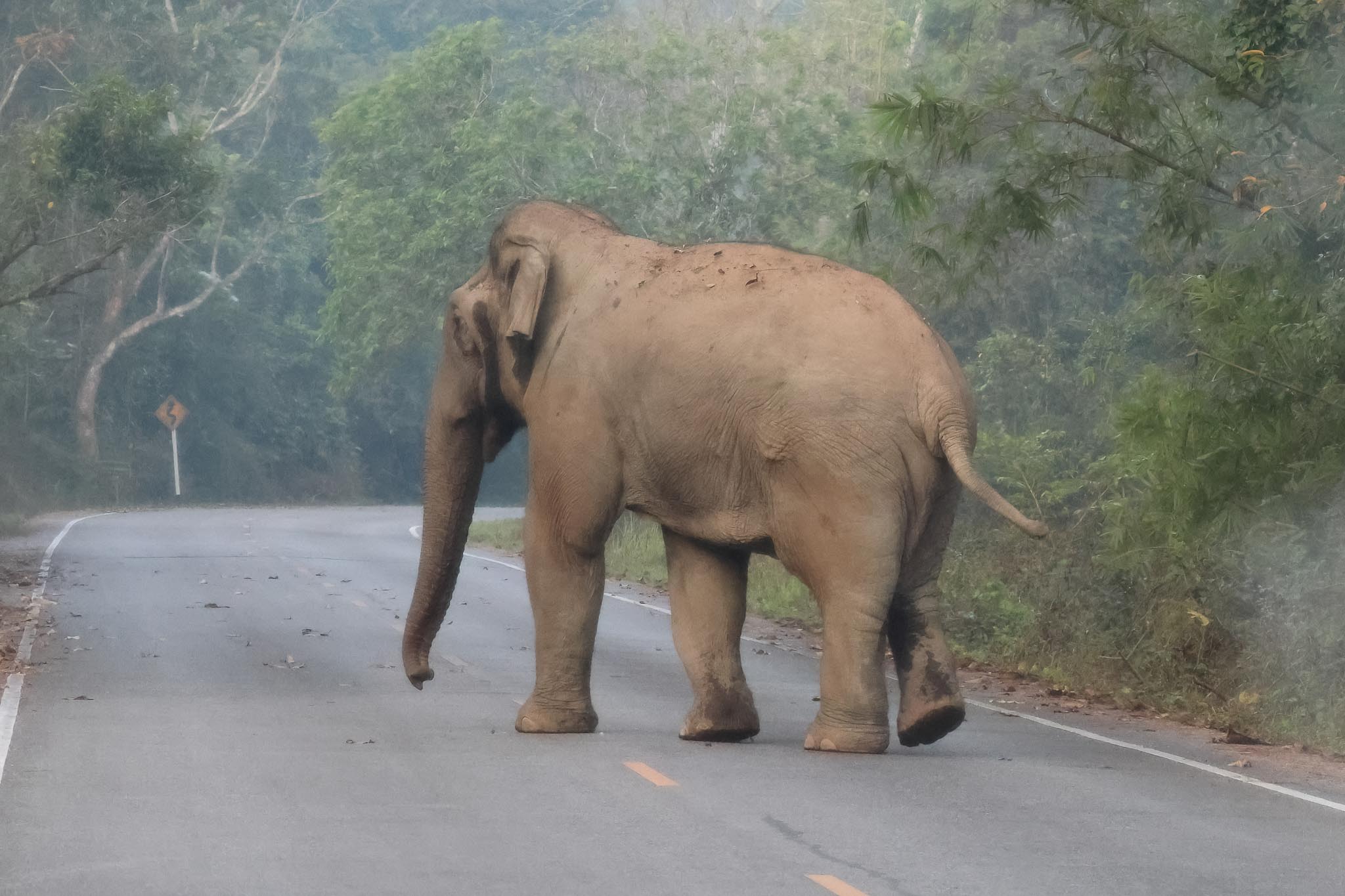
We drove on to the bridge, where it was safer to get out. There were the usual Thick-billed Pigeons, Black-naped Woodpeckers and lots of Black-naped Orioles in the trees around the pool again, two Red-wattled Lapwings in their usual place on the mud, and a Black-crowned Night Heron in the trees behind the shadier pool the other side of the road now. Two Asian Barred Owlets were in a tree right above the tarmac, and we watched as one swooped down and caught a cicada off the trunk before eating it grasped in its talons. Further on, a Crested Serpent Eagle was perched in a tree by the road.

Continuing on to the campsite, a Crested Goshawk was circling over the hillside as we got out. We were going to walk straight up the road, but one of the group spotted a Blue-bearded Bee-eater in a nearby tree which flew to the campsite. We walked to the edge and located it again in the trees, along with another Thick-billed Pigeon and a male Asian Fairy Bluebird. Games heard Silver-breasted Broadbill calling, so we walked down across the grass to the stream beyond and found two in the trees, great views. A mixed flock moved through – Grey-headed Canary Flycatchers, White-bellied Epornis, Pin-striped Tit-Babblers, a couple of Large Woodshrikes, Brown-rumped Minivet. We found the male Banded Kingfisher again, and watched as it caught and ate a large moth.
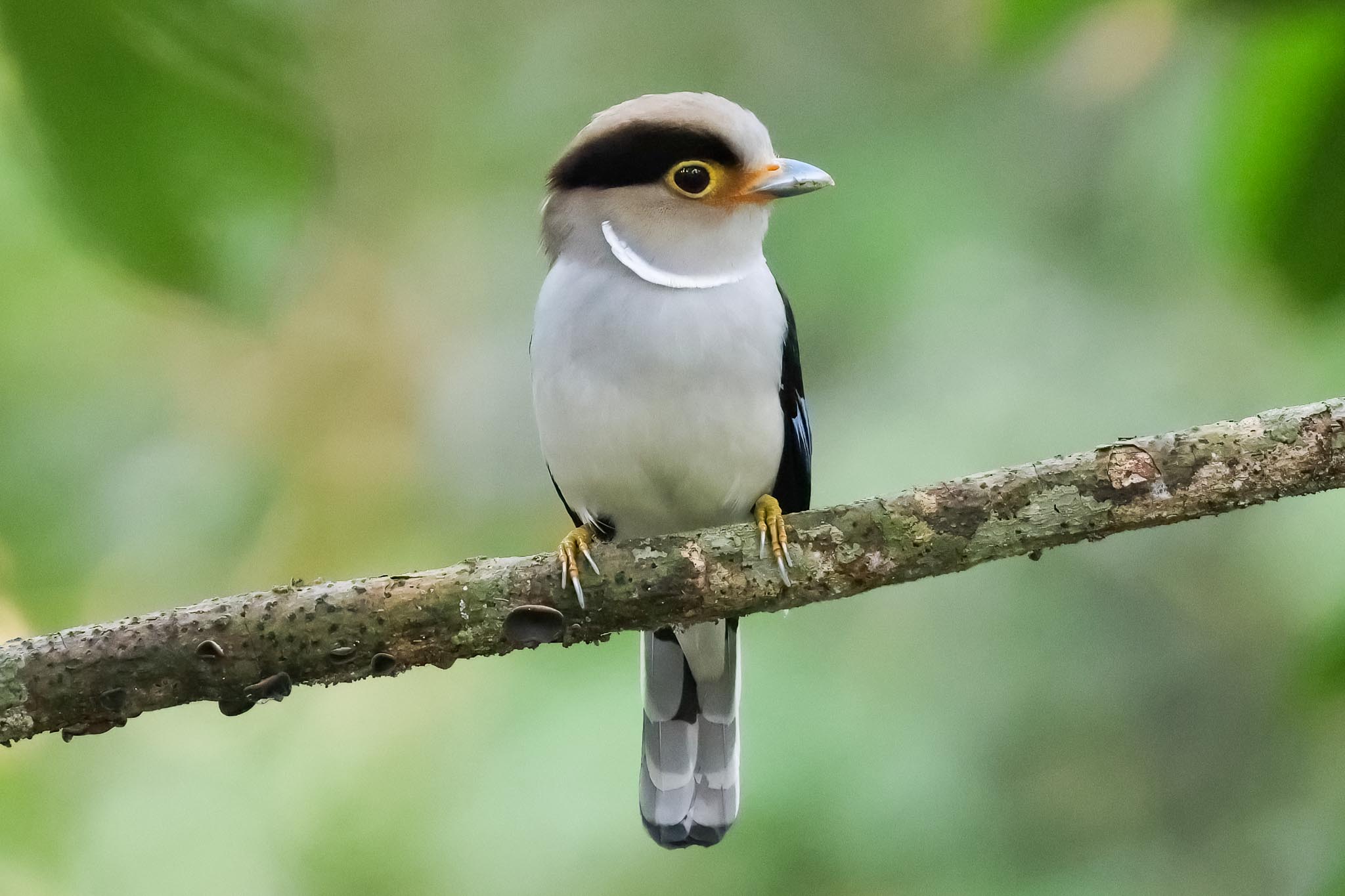
Back up to the road, a Lantern Bug (Pyrops candelaria) was on the trunk of a tree by the steps.

We walked along the track and found another flock, including an Oriental Paradise Flycatcher briefly and a pair of Great Ioras. An Eastern Crowned Warbler and an Arctic Warbler were feeding in the creepers around the trunk of a tree and a pair of Ochraceous Bulbuls appeared overhead briefly. There were lots of butterflies and bugs along here again, including a Forest Spotted Skink in the leaf litter. It was starting to get hot already, but Games heard a Square-tailed Drongo Cuckoo call and when it flew across the road, we found it with a caterpillar in the trees high above our heads.

We were picked up by one of the 4x4s now and taken back to the campsite, then piled into the minibus for the drive back to Baan Maka. We had to pack up and check out now, then had time to relax before lunch, walk round the grounds or sit in the shade, and the same afterwards. There were lots of birds coming to the bananas put out by the restaurant and the nearby small pool – lots of bulbuls, a mixed flock of Greater and Lesser Necklaced Laughhingthrushes, brief Black-naped and Black-hooded Orioles though both too nervous to stay long, Puff-throated Babbler again in the leaves, an Indochinese Blue Flycatcher and the resident Blue Whistling Thrush. A Little Spiderhunter came down to drink.

At 2pm we set off to make our way slowly back towards Bangkok, but we still had time for a few birding stops on the way. We drove into the ricefields and stopped first to see if we could find any more weavers. As we walked along a track by a drainage ditch, we scanned the fields the other side and found lots of Asian Openbills and a flock of 23 Grey-headed Lapwings, our first Amur Stonechats for a few days, and a Plaintive Cuckoo briefly.
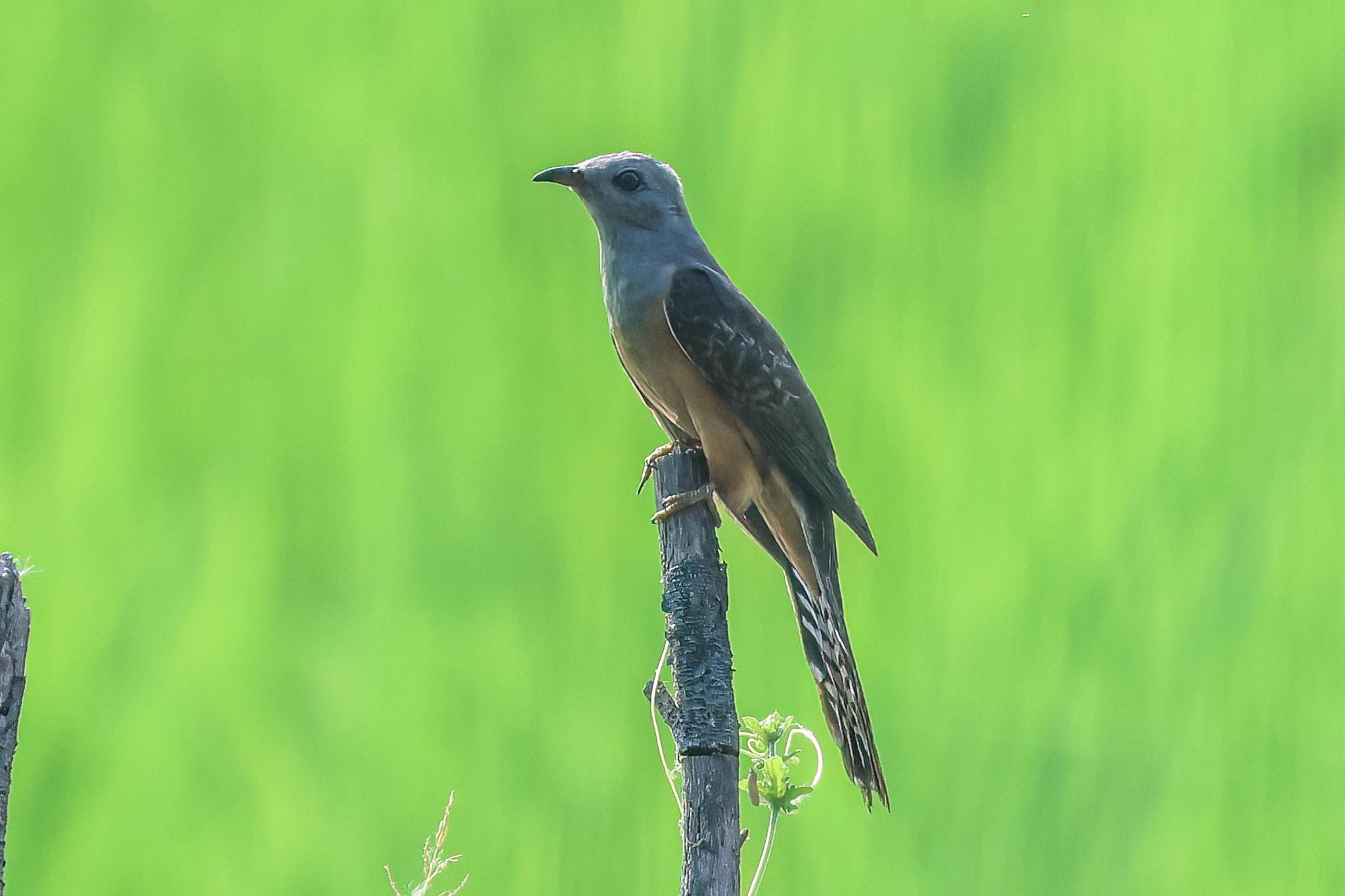
Eventually we found some weavers in the reeds in the ditch, mainly Baya Weaver again at first but then a bit further on we found several Asian Golden Weavers too, though all in non-breeding plumage at this time of year. There were several Brahminy Kites and Eastern Marsh Harriers over the ricefields on the other side of the road where they were harvesting the rice, and a Black-winged Kite flew in and landed on the top of a tree. A huge flock of Feral Pigeons and several Cattle Egrets flew up occasionally ahead of the combine harvester. A Bronze-winged Jacana and a Yellow Bittern flushed from the ditch ahead of us but a skulking bush warbler in the wet grass in the bottom simply wouldn’t give itself up.
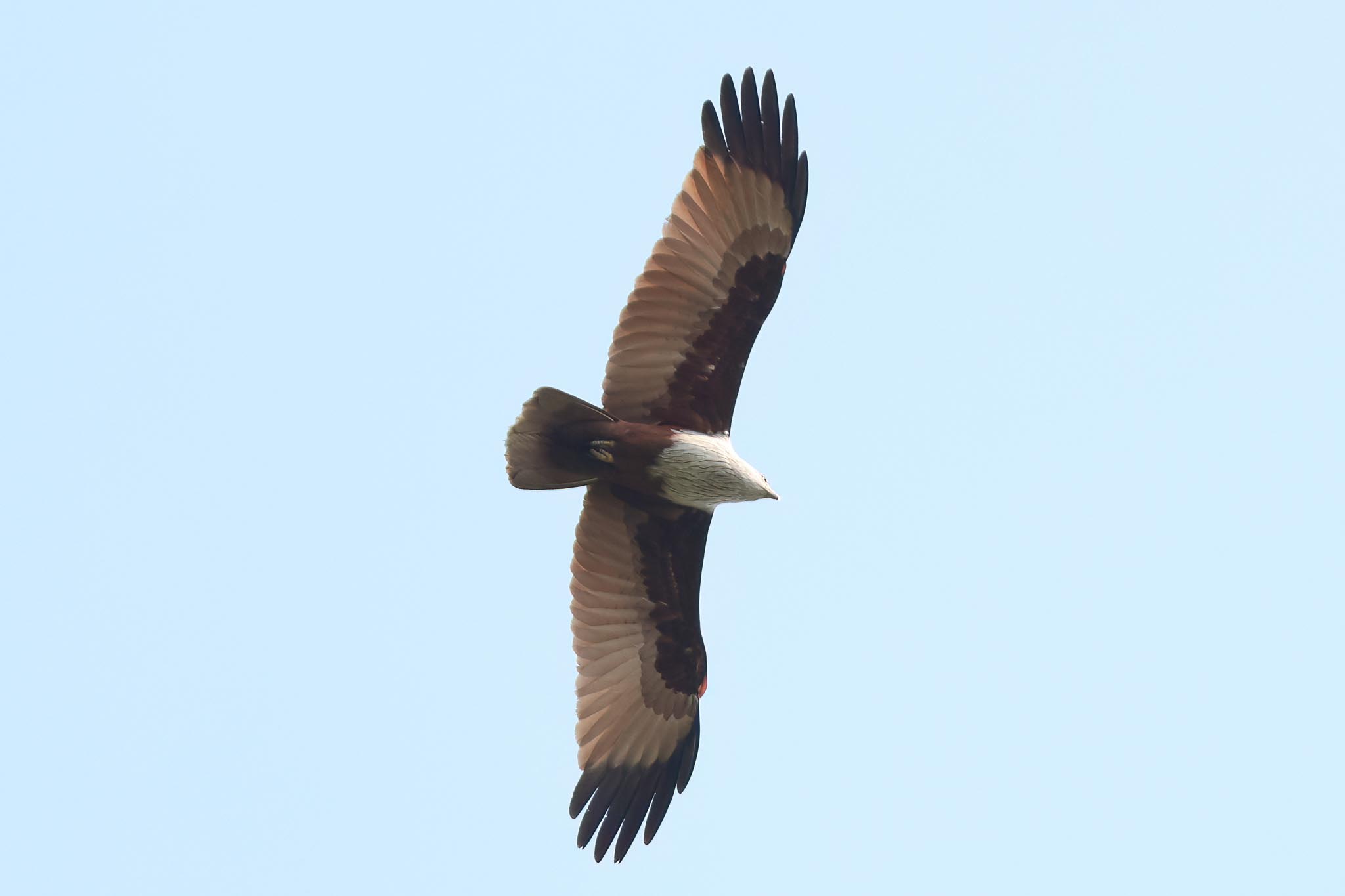
It was time to move on, so we drove the short distance round to Bang Tabun Ok. On the way, as we drove over a bridge over a muddy creek, we spotted a Ruddy-breasted Crake on the mud below from the minibus so we pulled up and watched it as it walked slowly into the vegetation on the bank. A little further, we stopped again by some large ponds and got out. The first birds we saw here were several Black-headed Ibises in with lots of herons and egrets on some of the islands and then we picked up two Spot-billed Pelicans swimming very distantly at the back, with another one or two asleep in with a group of Painted Storks on another island.

There was a nice selection of ducks, large flocks of Pintail, a few Wigeon and Garganey with them, and groups of Lesser Whistling Ducks flying round calling. Several Indian Cormorants were in with the Littles, and a couple of Oriental Darters flew over at the back. Whiskered, Caspian and Little Terns were flying round along with a few Brown-headed Gulls and we could see a few waders too, Black-winged Stilts, a couple of Common Greenshanks, several Wood Sandpipers, a flock of Black-tailed Godwits and a Spotted Redshank which flew over calling.

It was time to head to the airport, so we said our goodbyes and thanks now to Games and her nephew, while our driver would take us on to Bangkok. It took a couple of hours to get to the airport hotel where we were booked in for the night, or so we thought. After we were dropped off outside, we went up to check-in and handed over our booking confirmation and passports to be told that our booking had been cancelled! Nick hastily managed to book us into another hotel and we got the minibus to come back to transfer us over. This hotel was brand new and very comfortable, but it was getting late and there didn’t seem to be many restaurants nearby. The choice appeared to be either KFC or pizza, or a Thai street restaurant on the corner. There were several locals eating at the latter, always a good sign, and everyone voted for that – we had gone properly native now!
Saturday 3rd February
We were booked onto the 10am airport shuttle bus from the hotel this morning, so we had time for a leisurely breakfast and an opportunity to repack properly beforehand. From the restaurant on the 6th floor of the hotel we could see Germain’s Swiftlets and Asian Red-rumped Swallows hawking around the building, and a few Asian Openbills, egrets and cormorants flying past. We got to Bangkok’s Suvarnabhumi Airport in good time and checked in for our 1.20pm Thai Air flight back to Heathrow. We were a few minutes late taking off and there were some strong headwinds on the journey but we still touched down at 8pm, only 25 minutes later than scheduled. Our bags were out quite quickly and we said our goodbyes at the carousel, before heading off into the decidedly chilly London night, quite a shock after the warmth of Thailand. It had been a great trip – we are looking forward to going back in 2025 already.
















